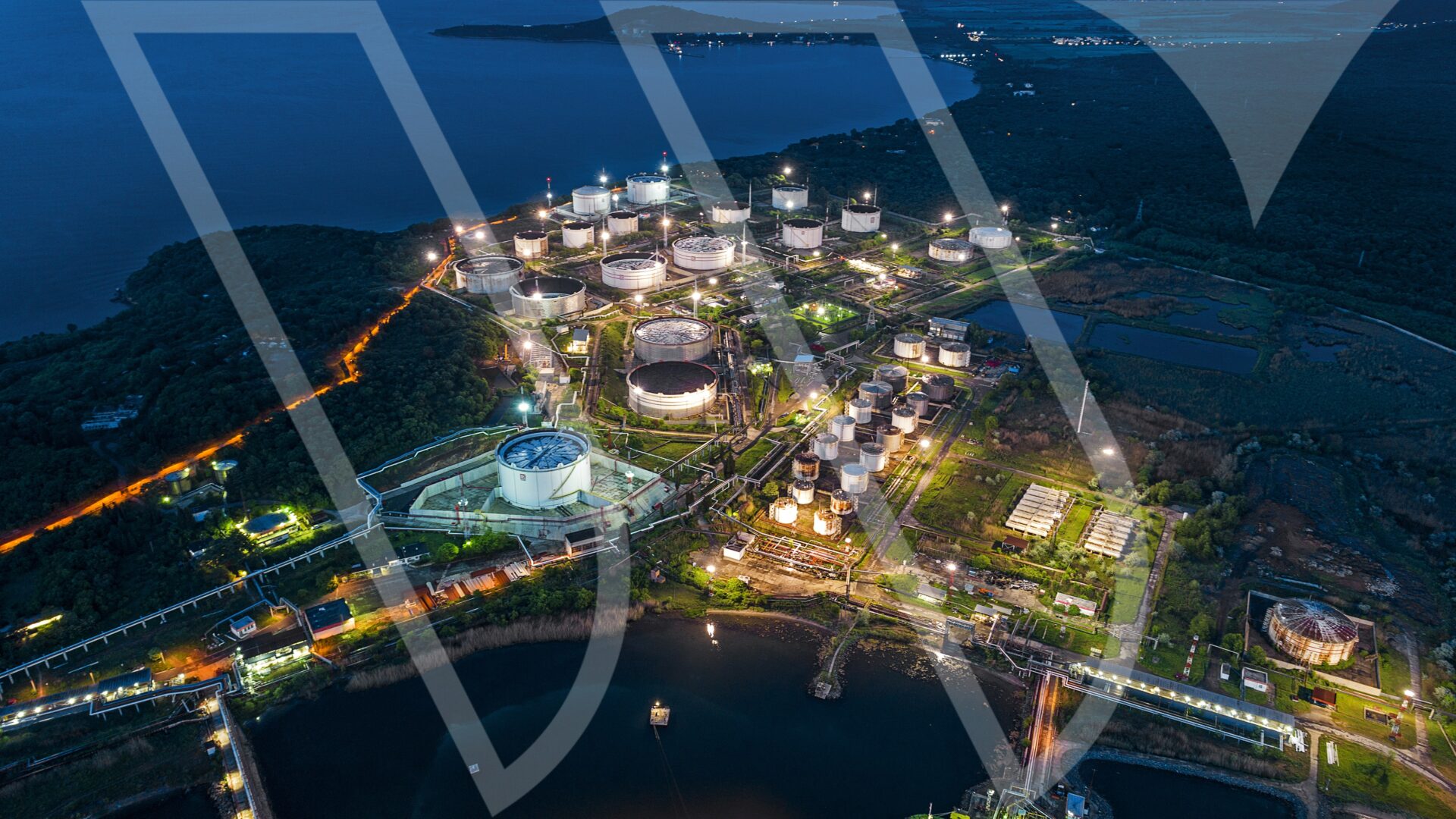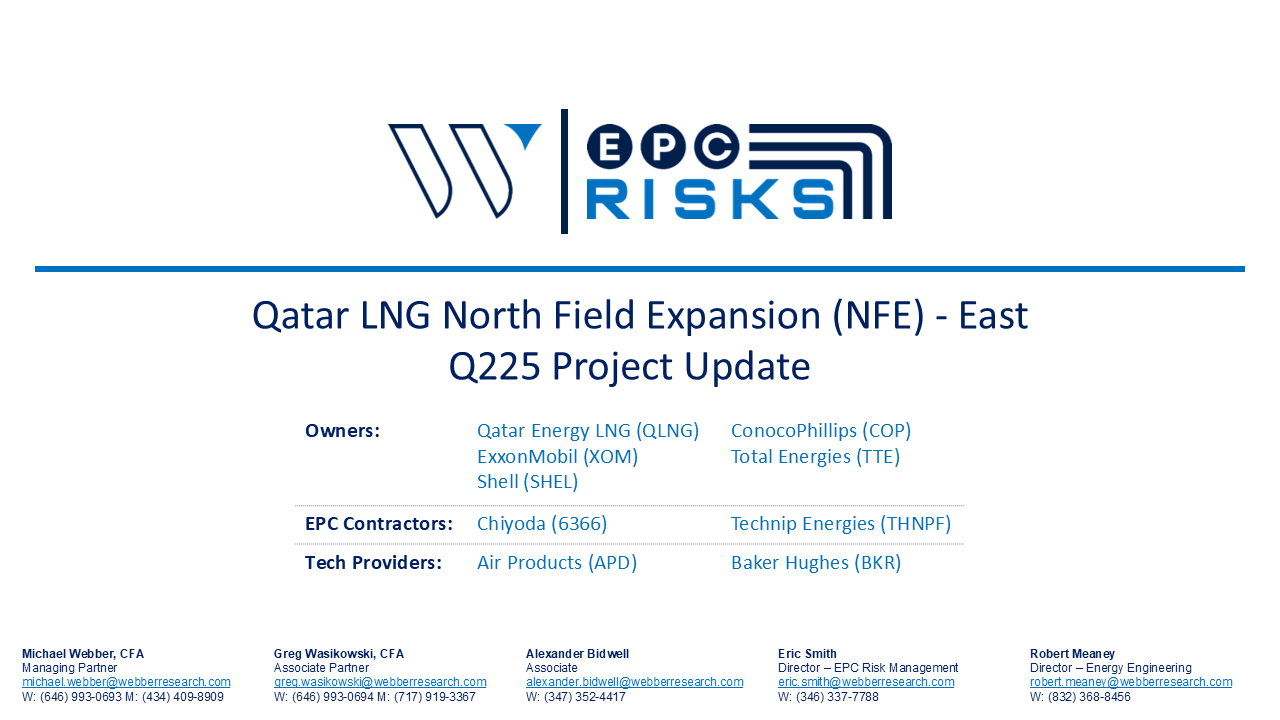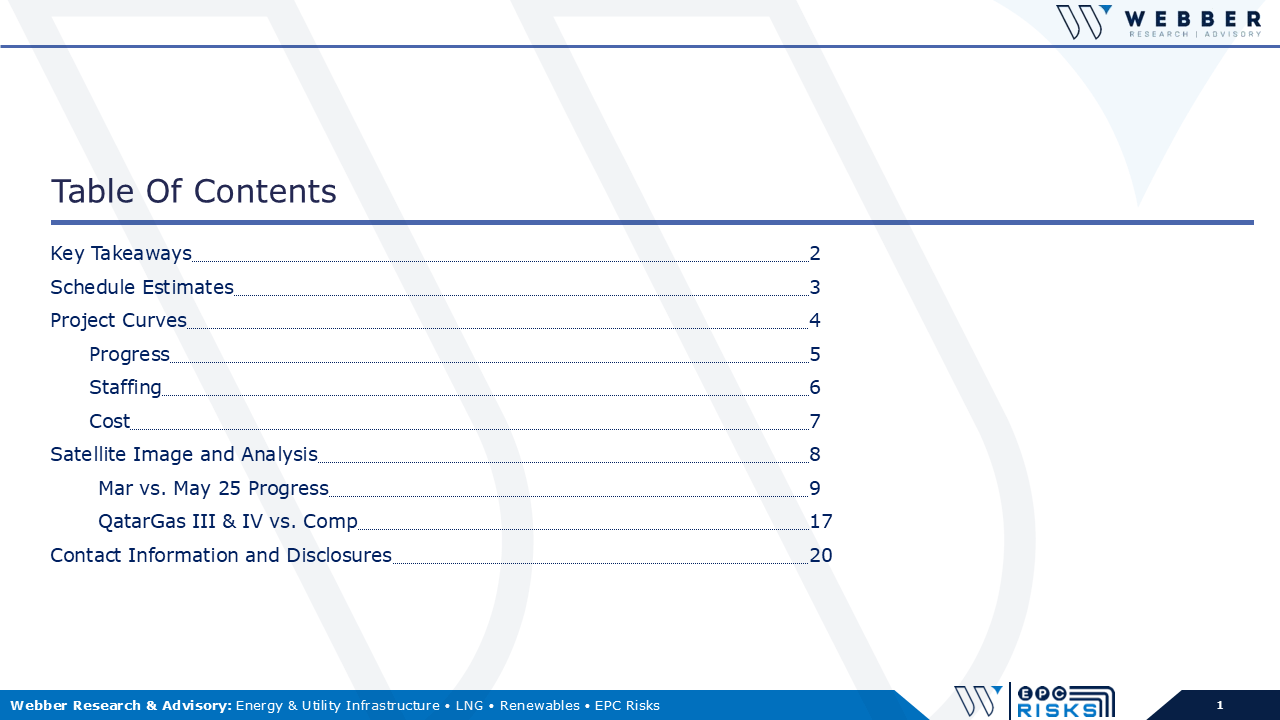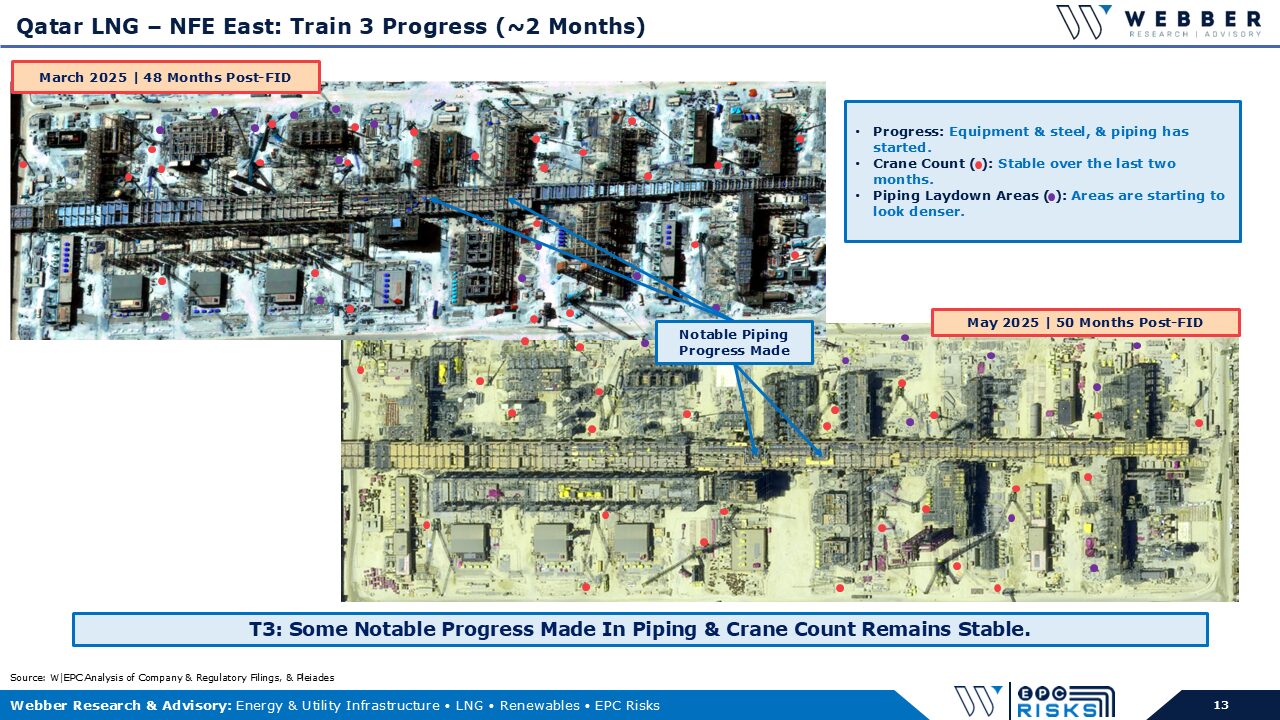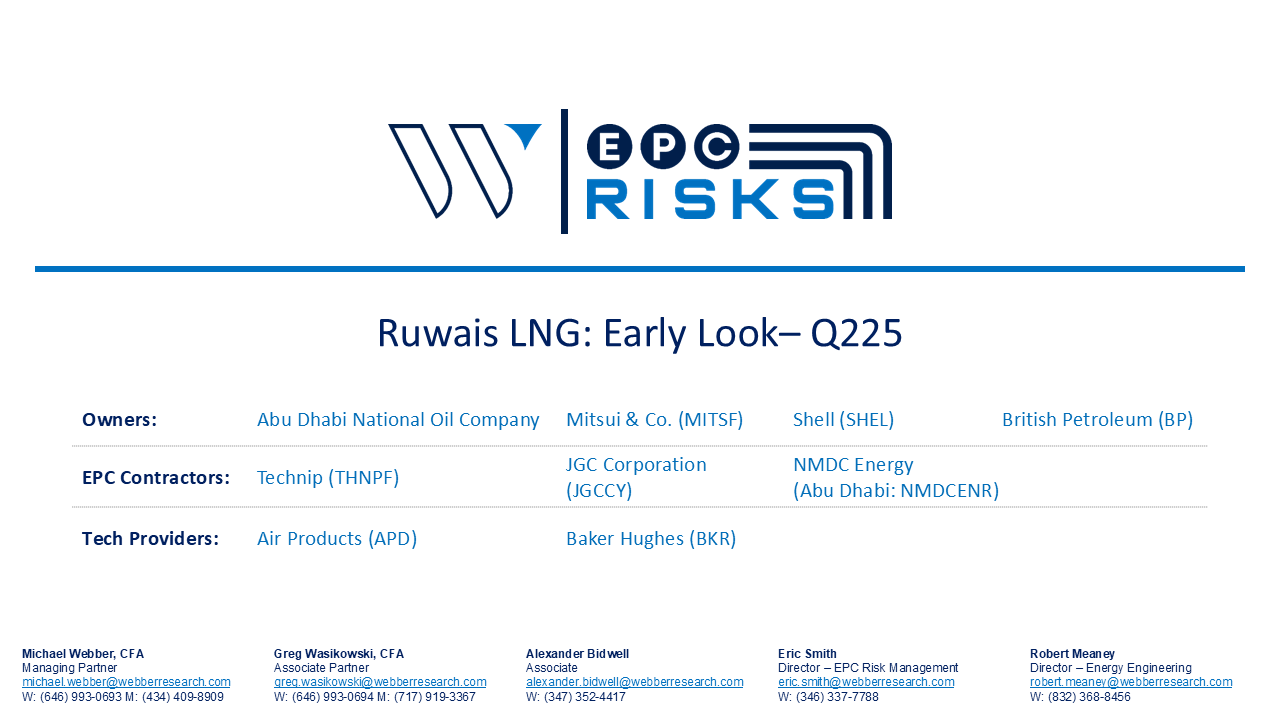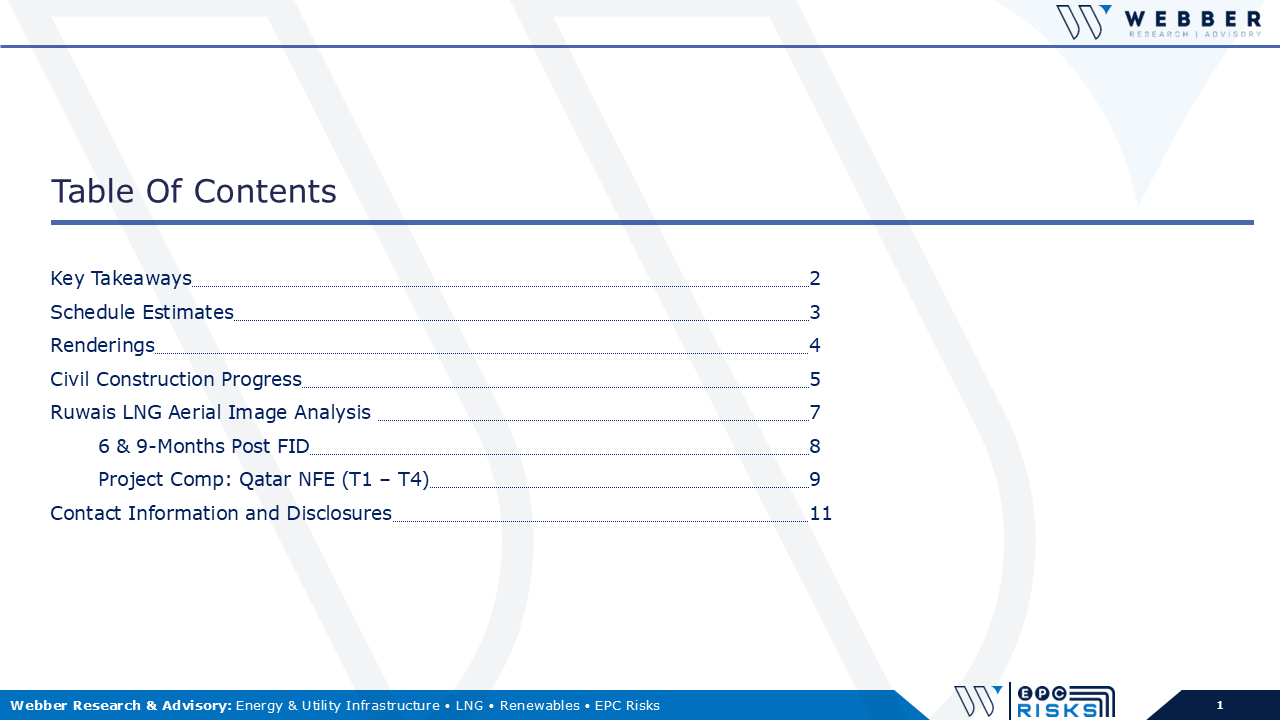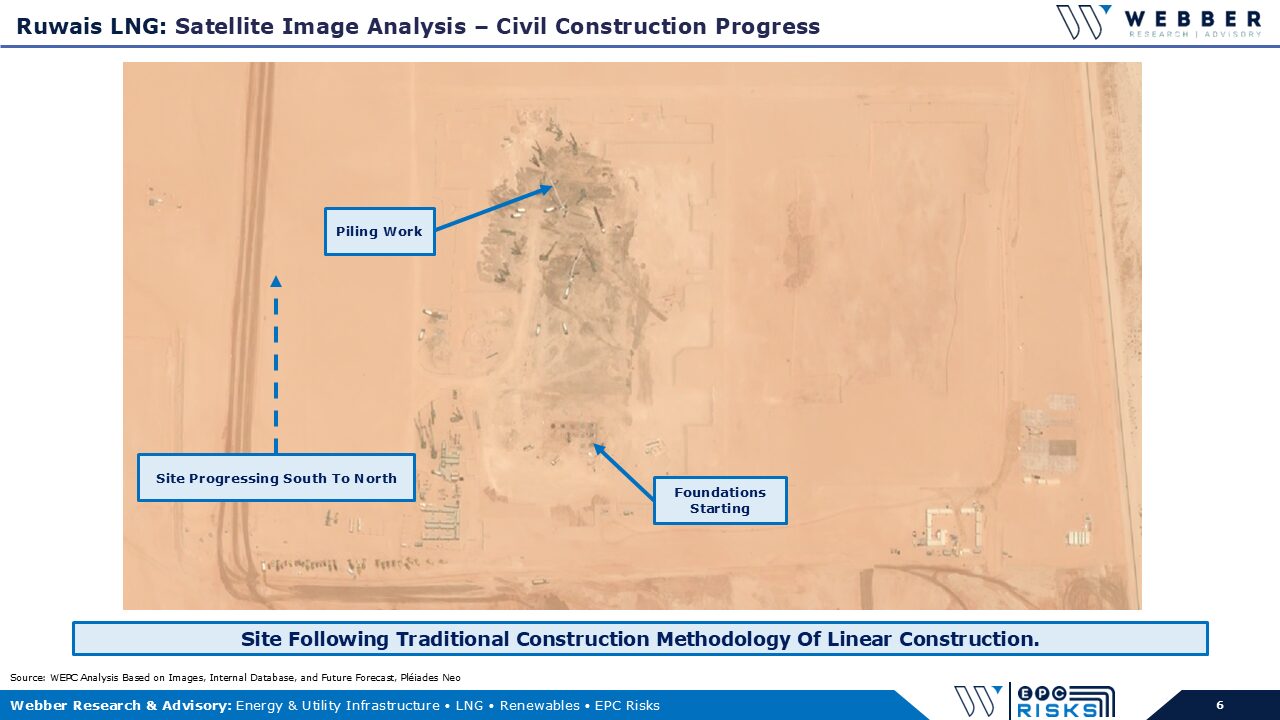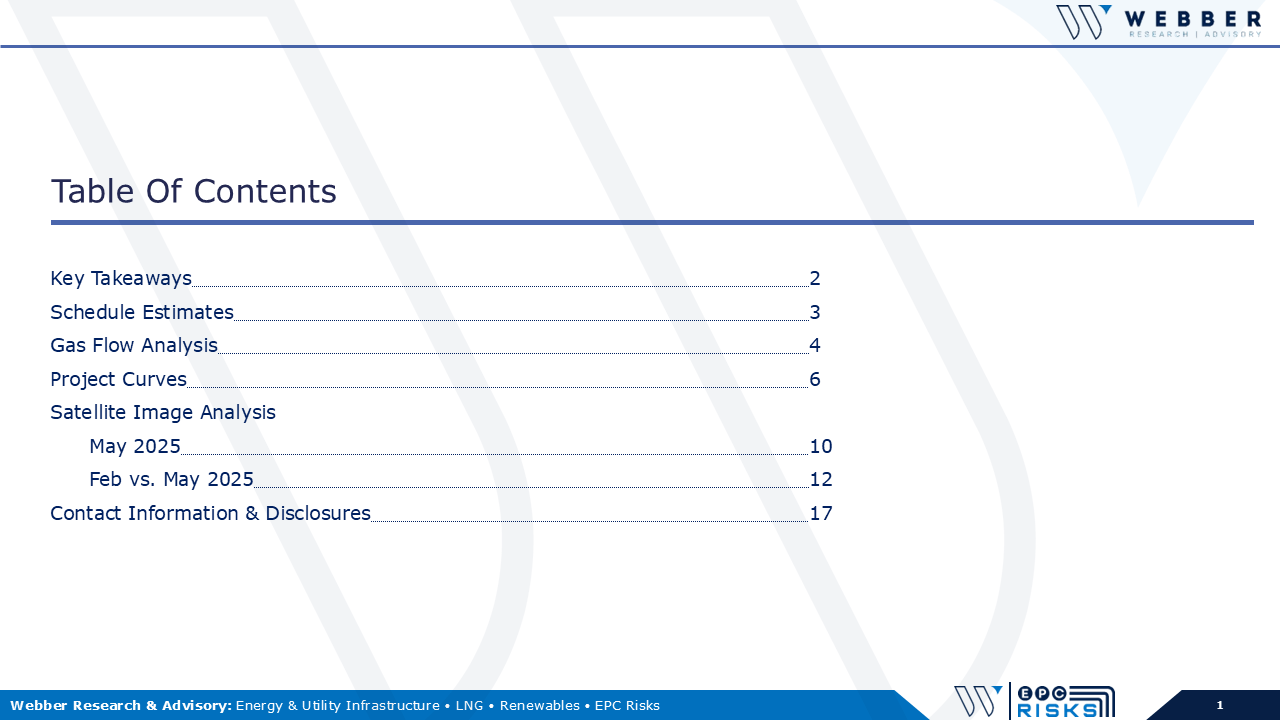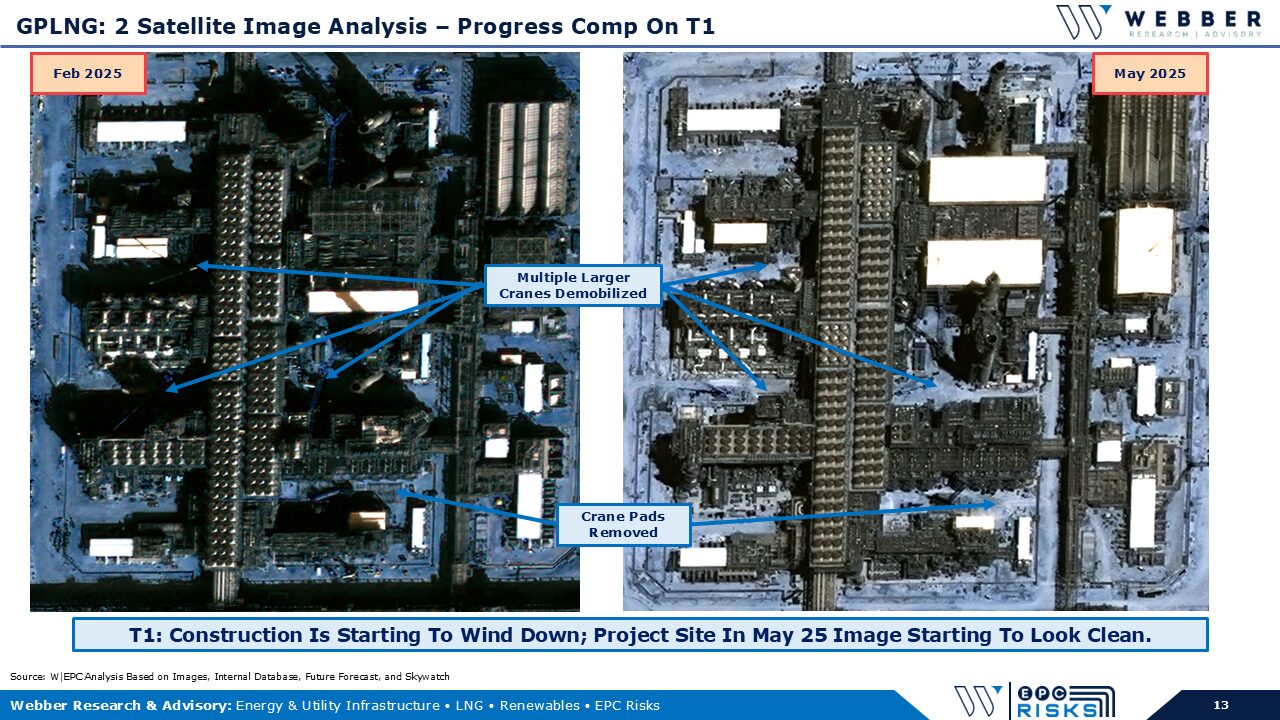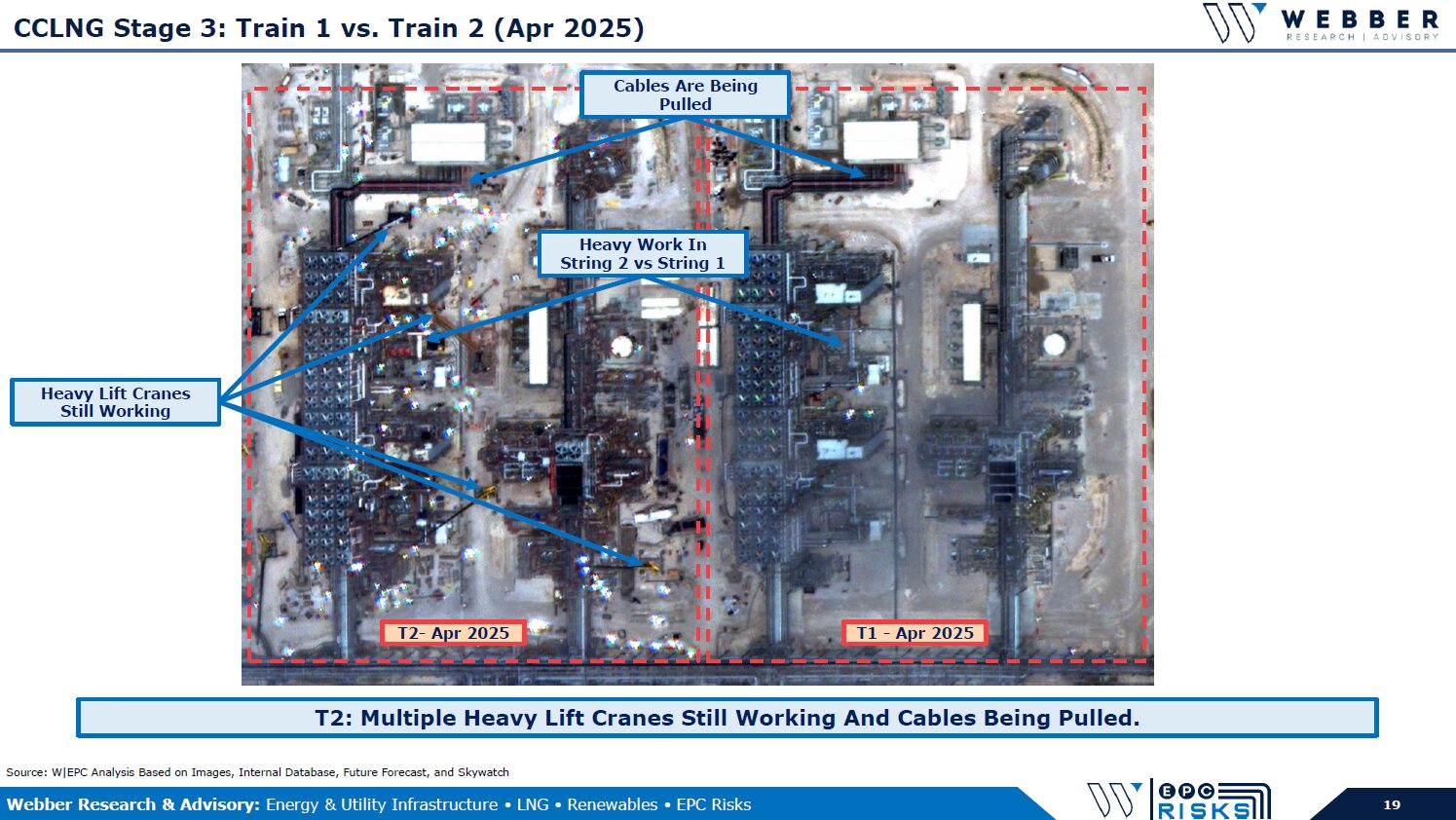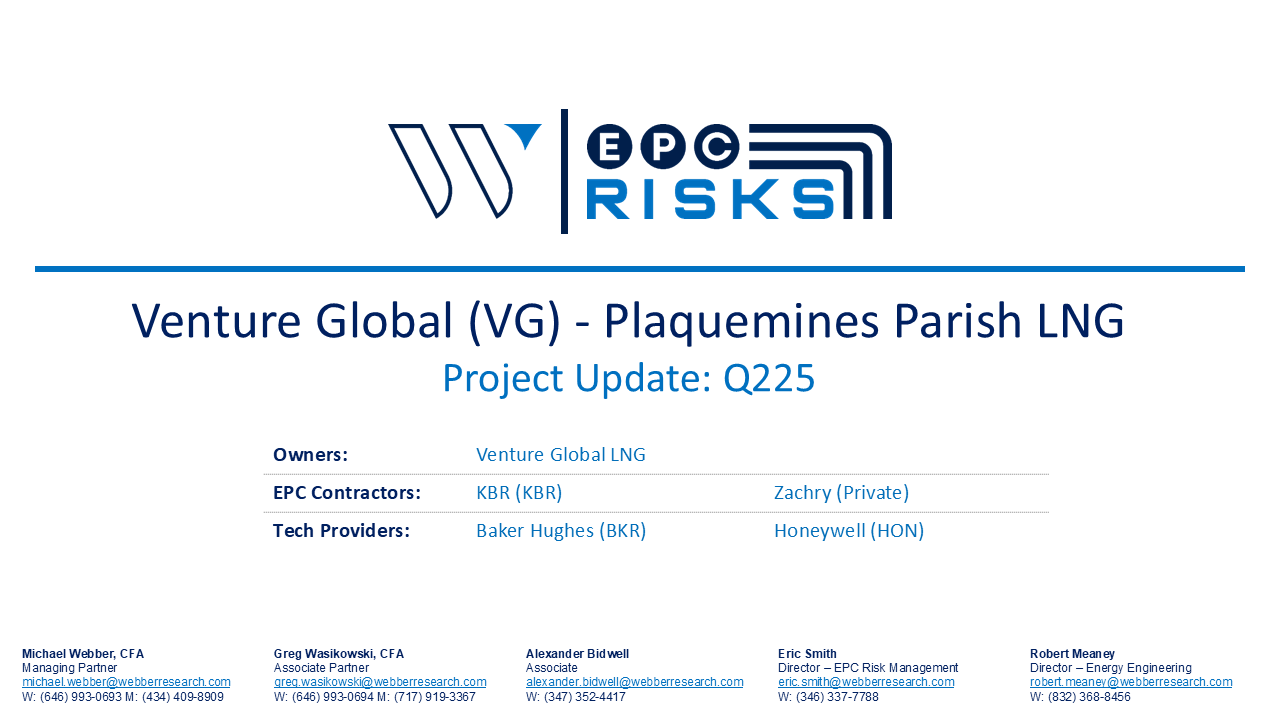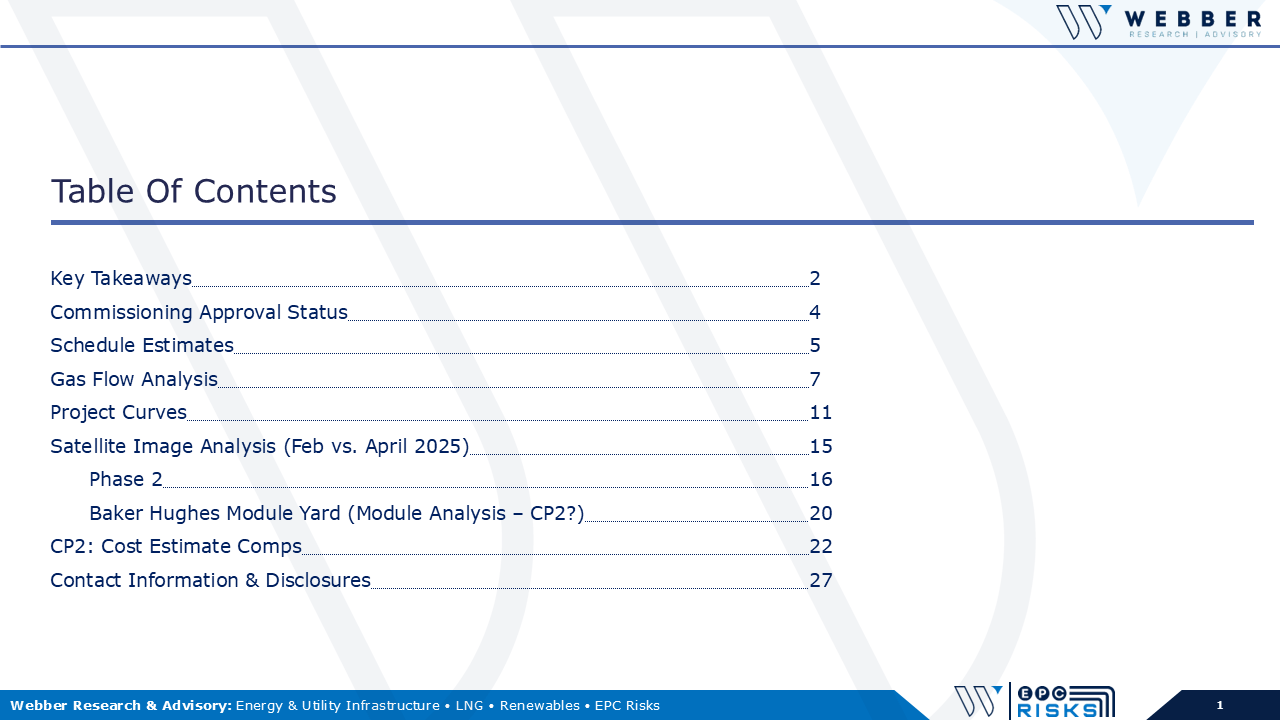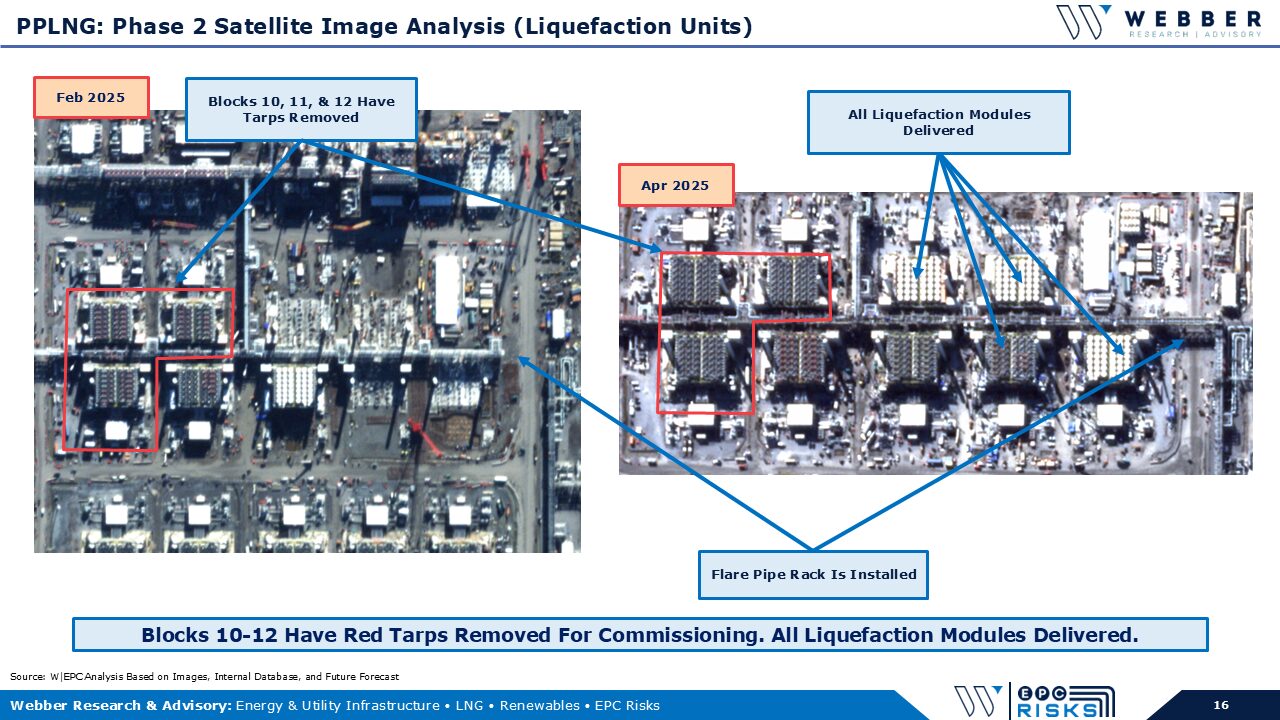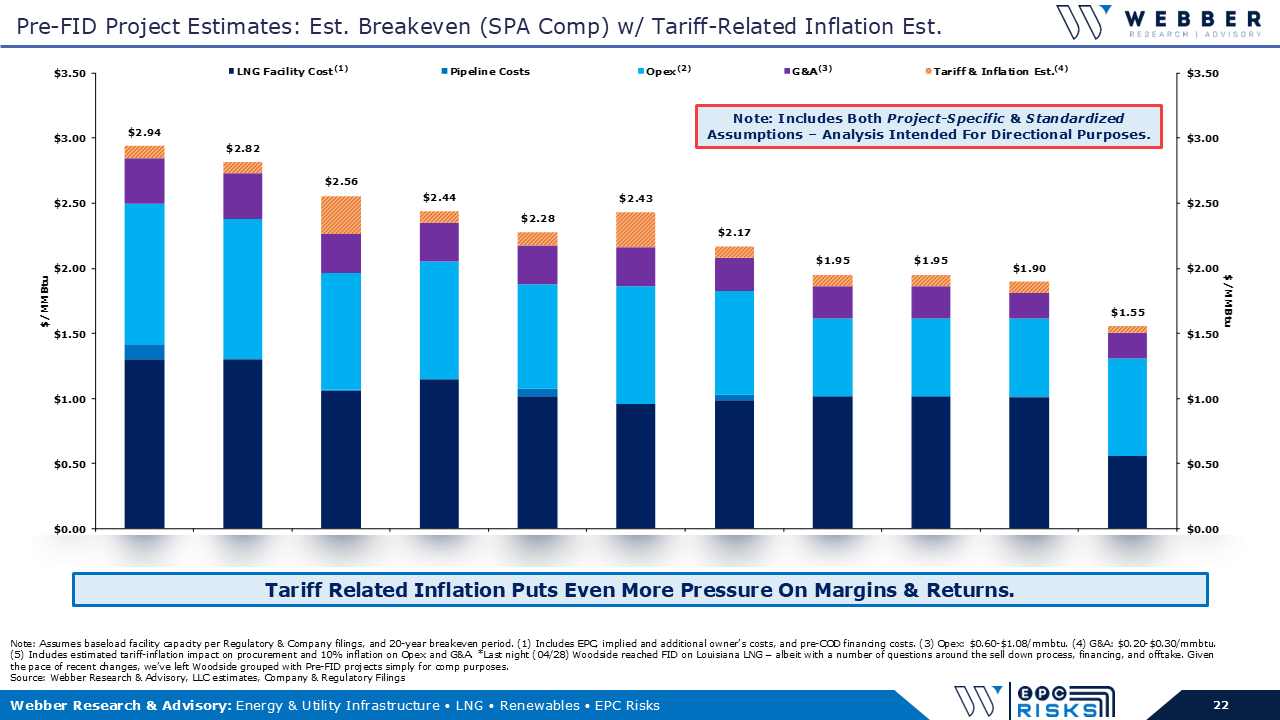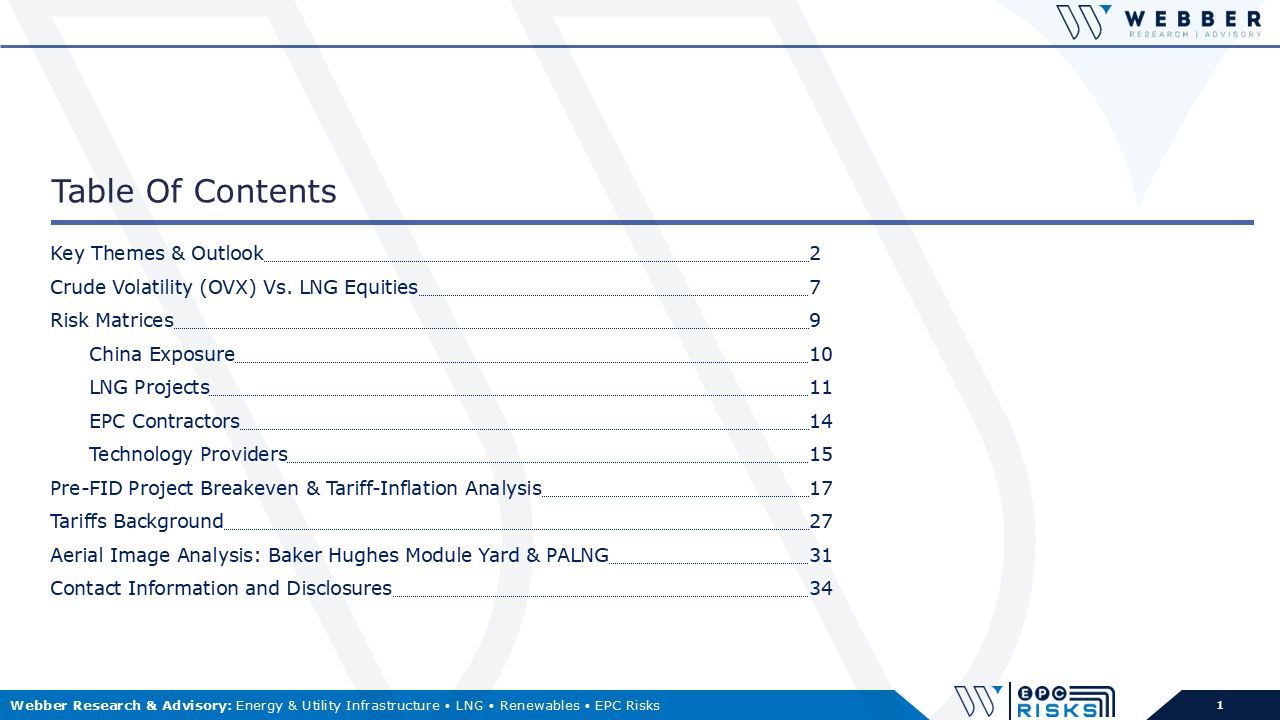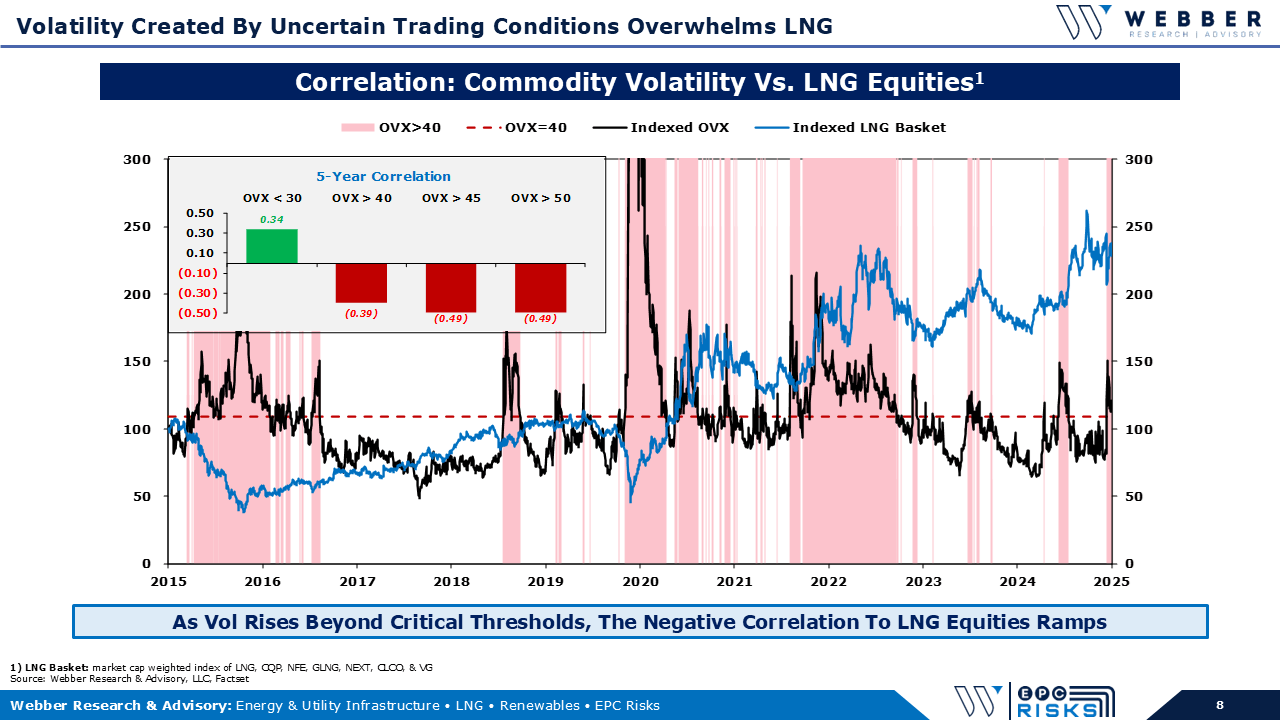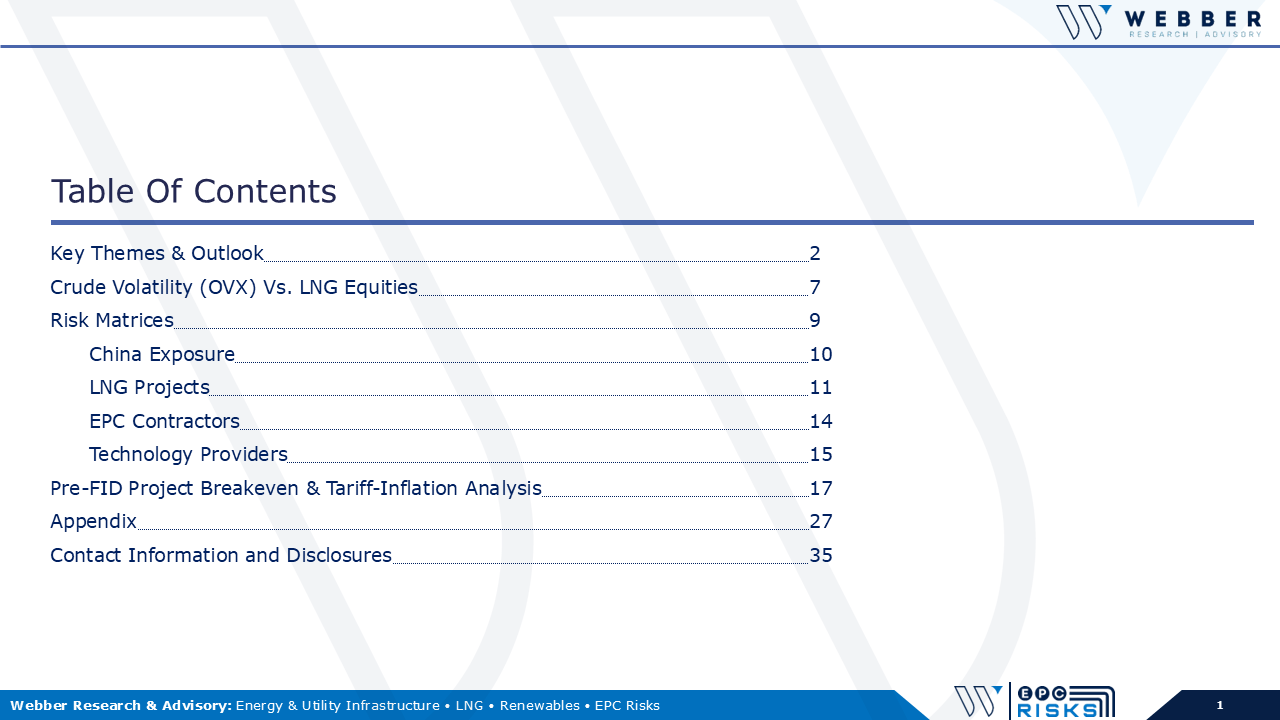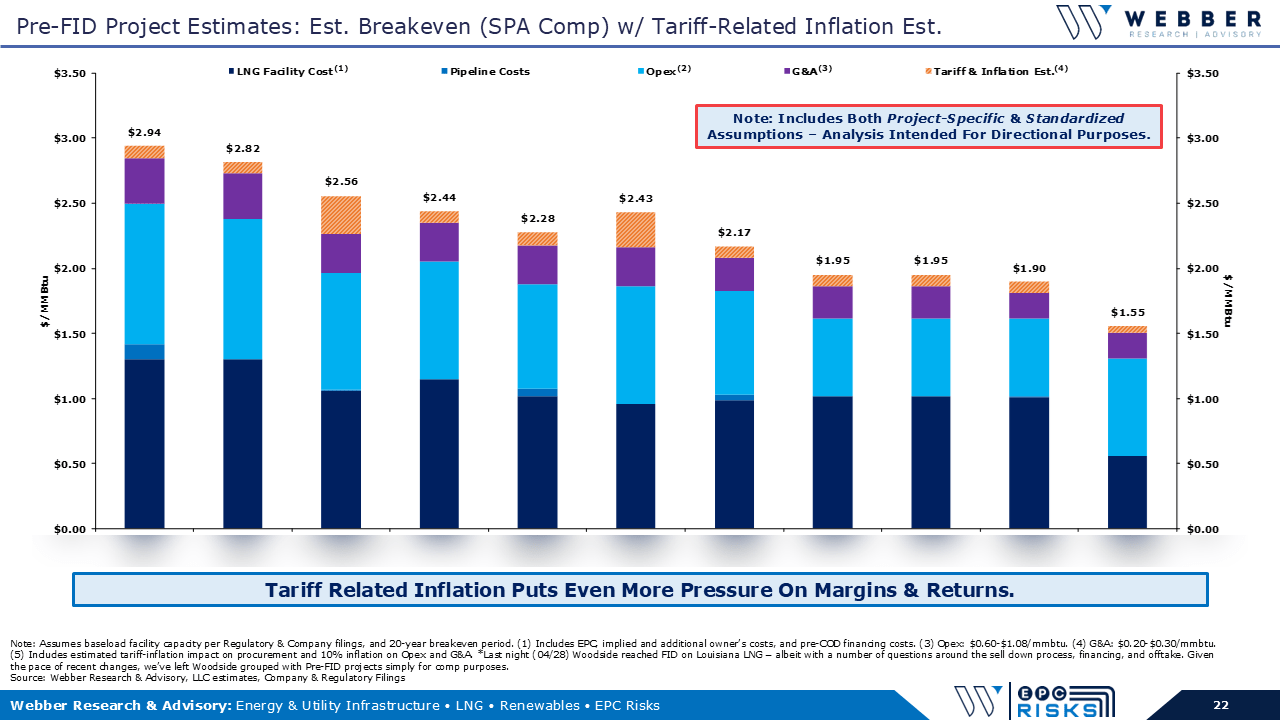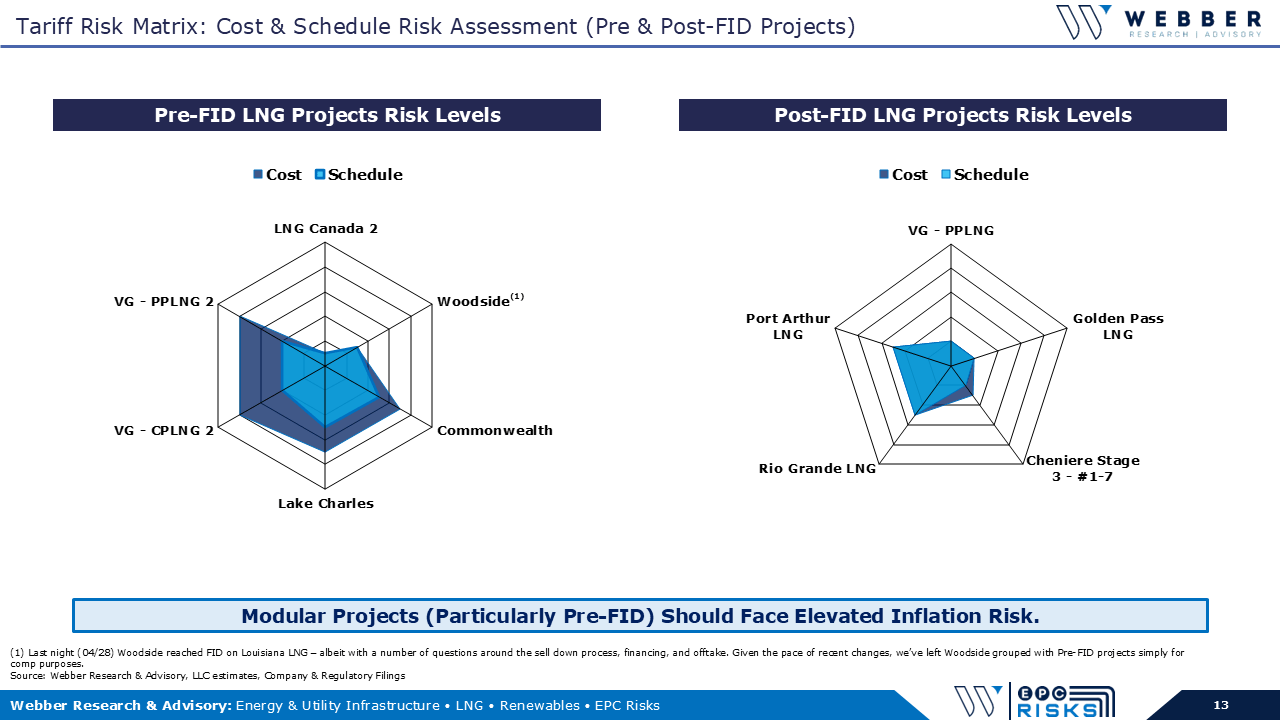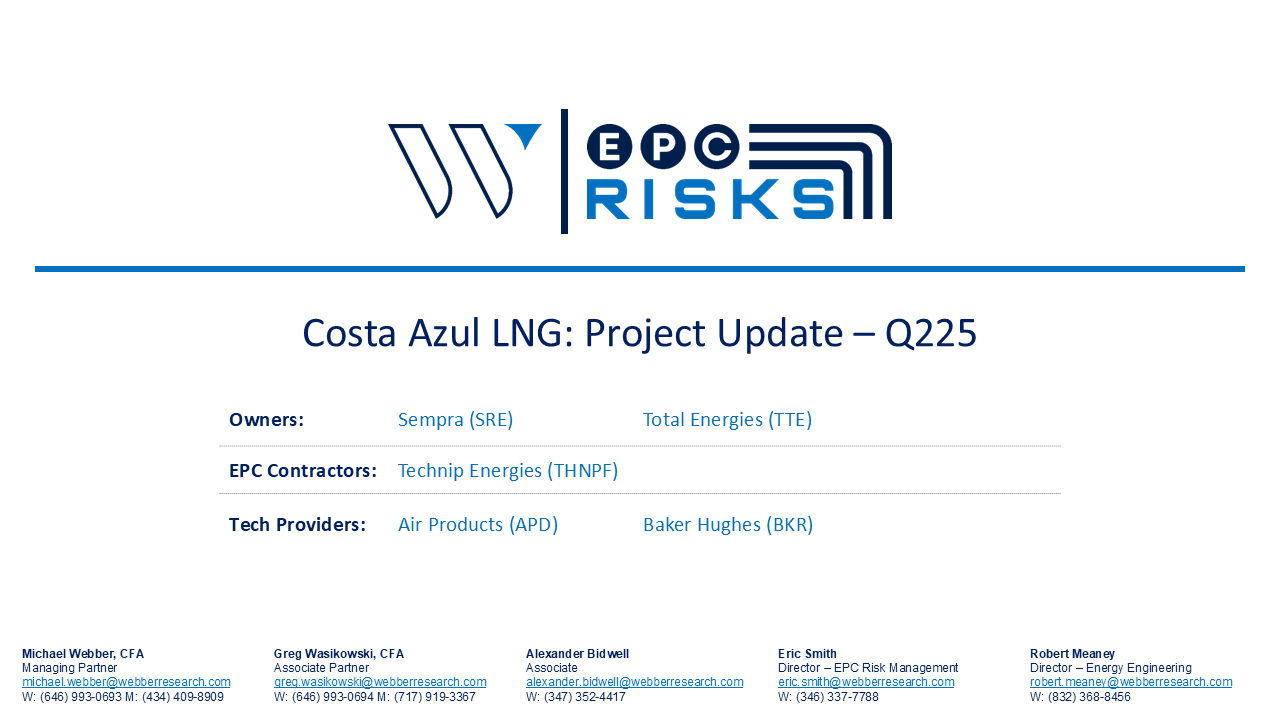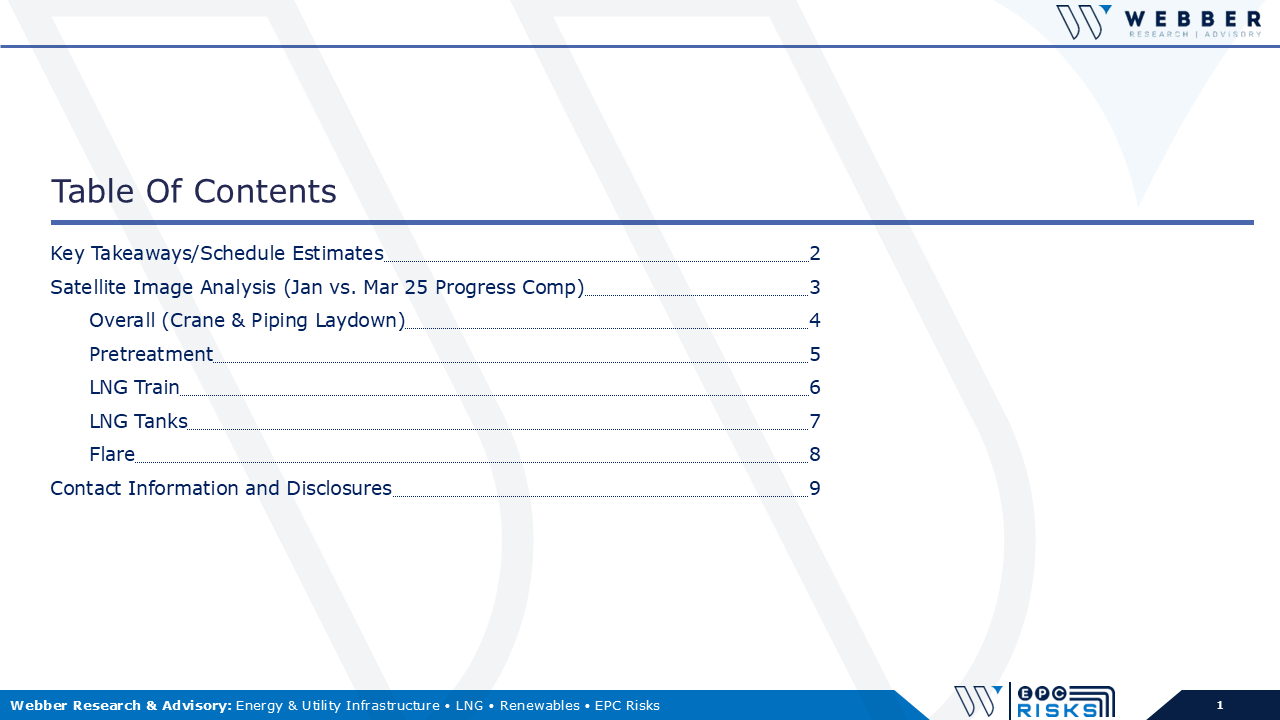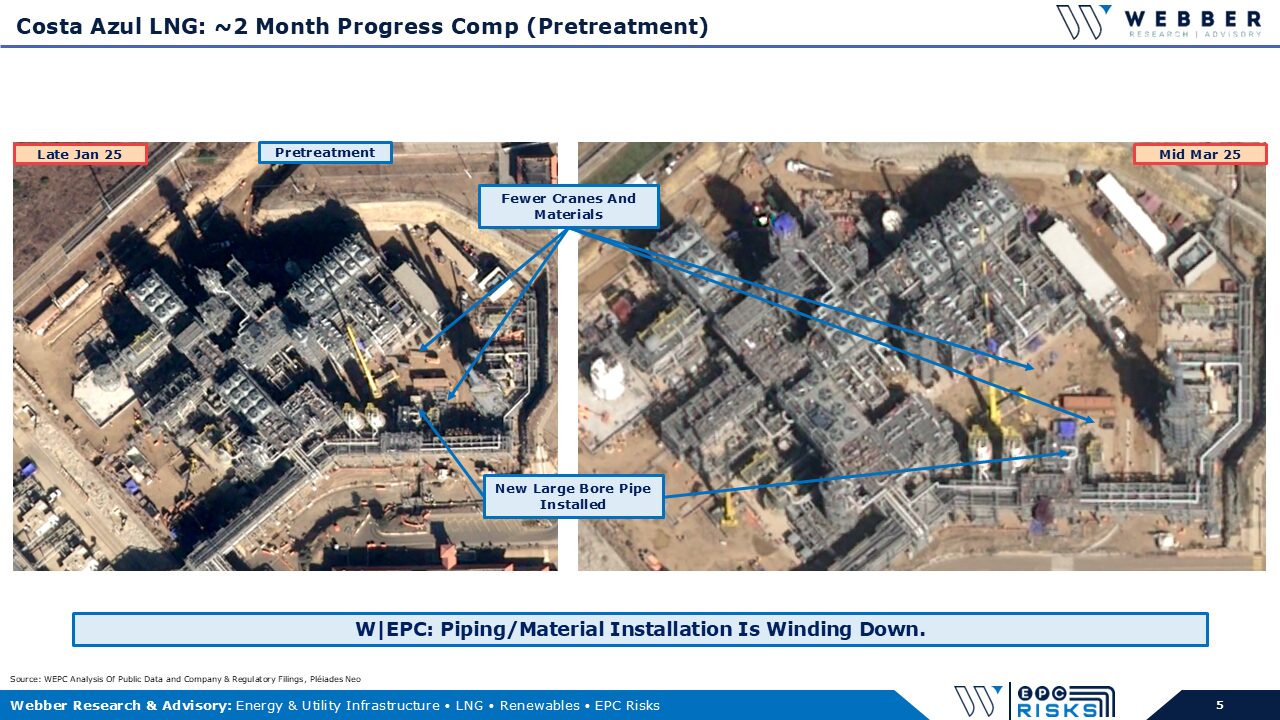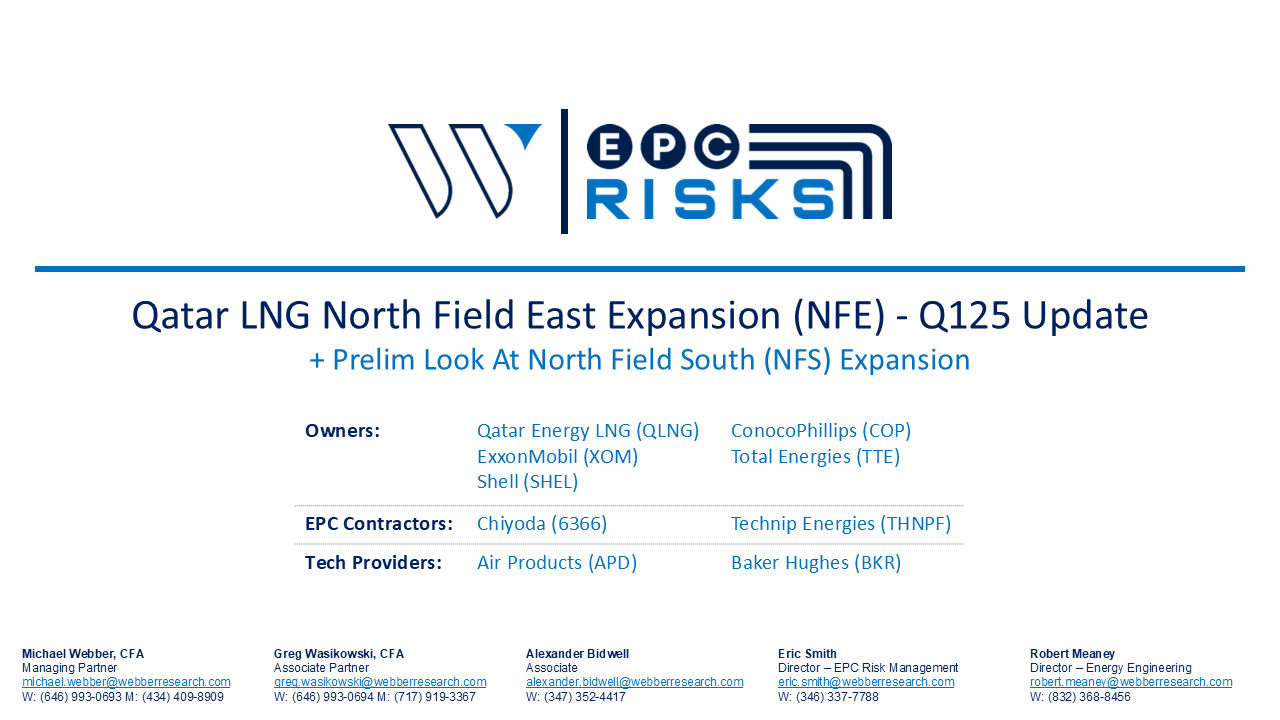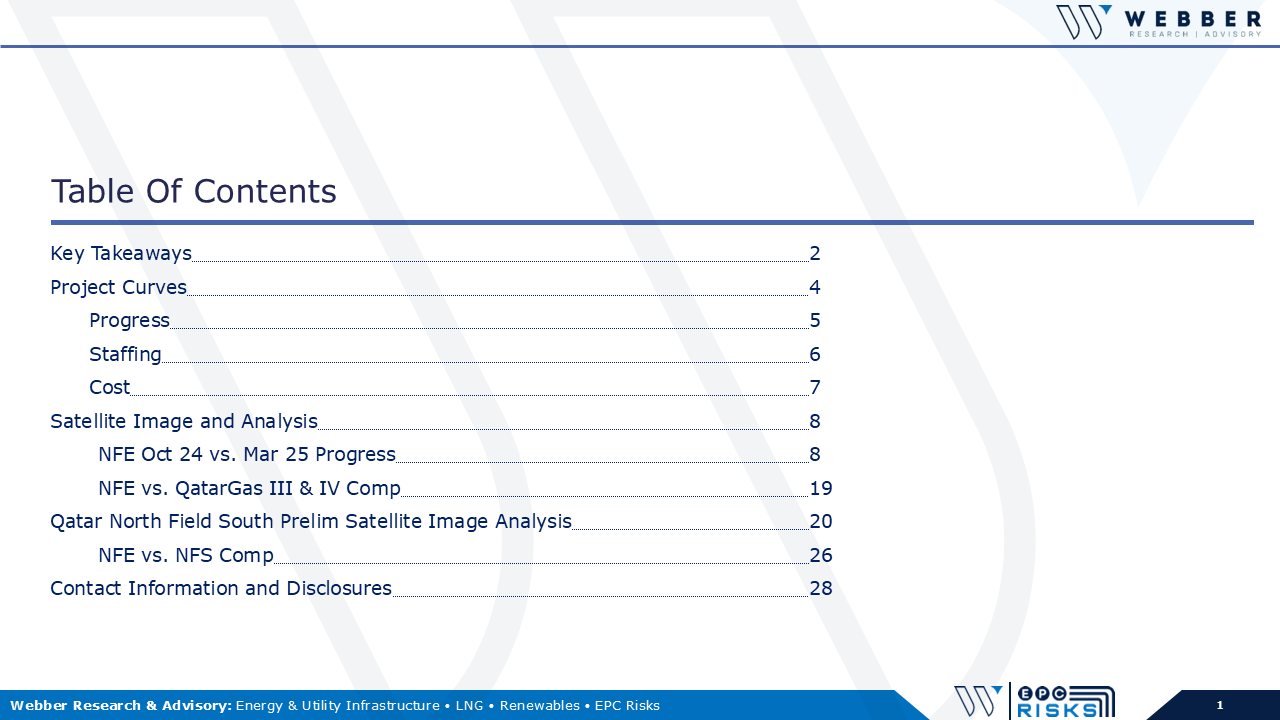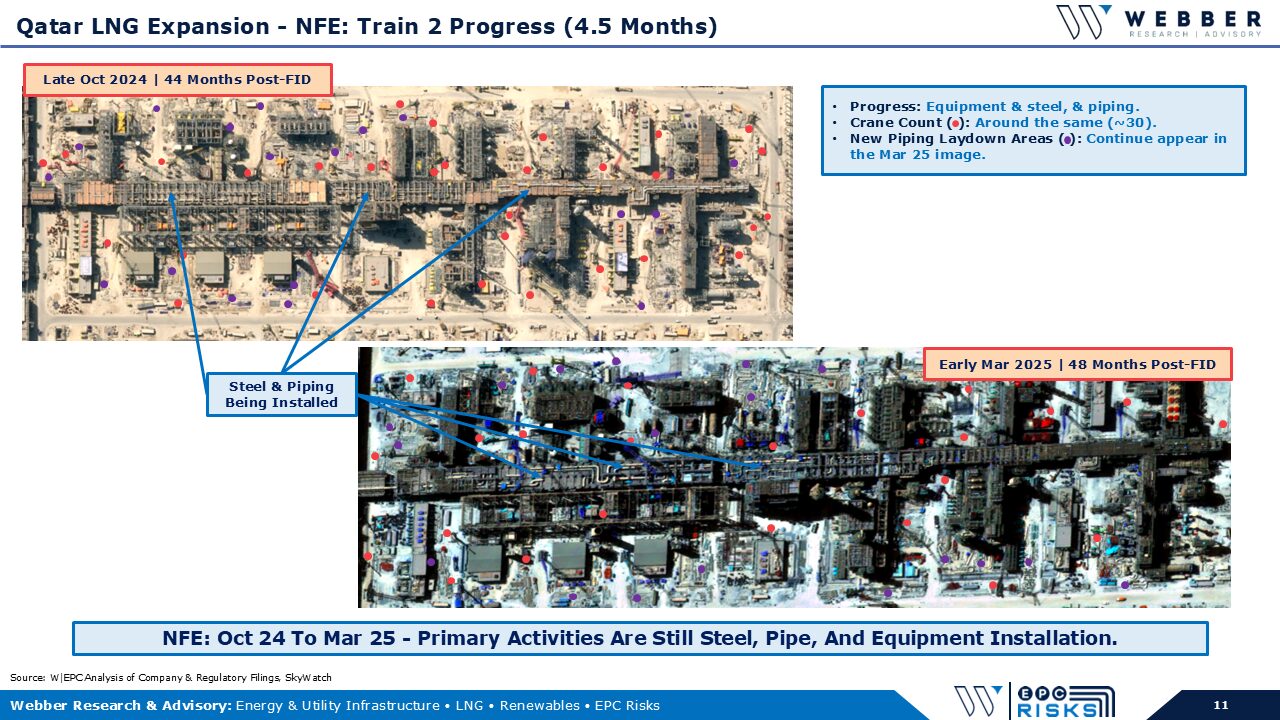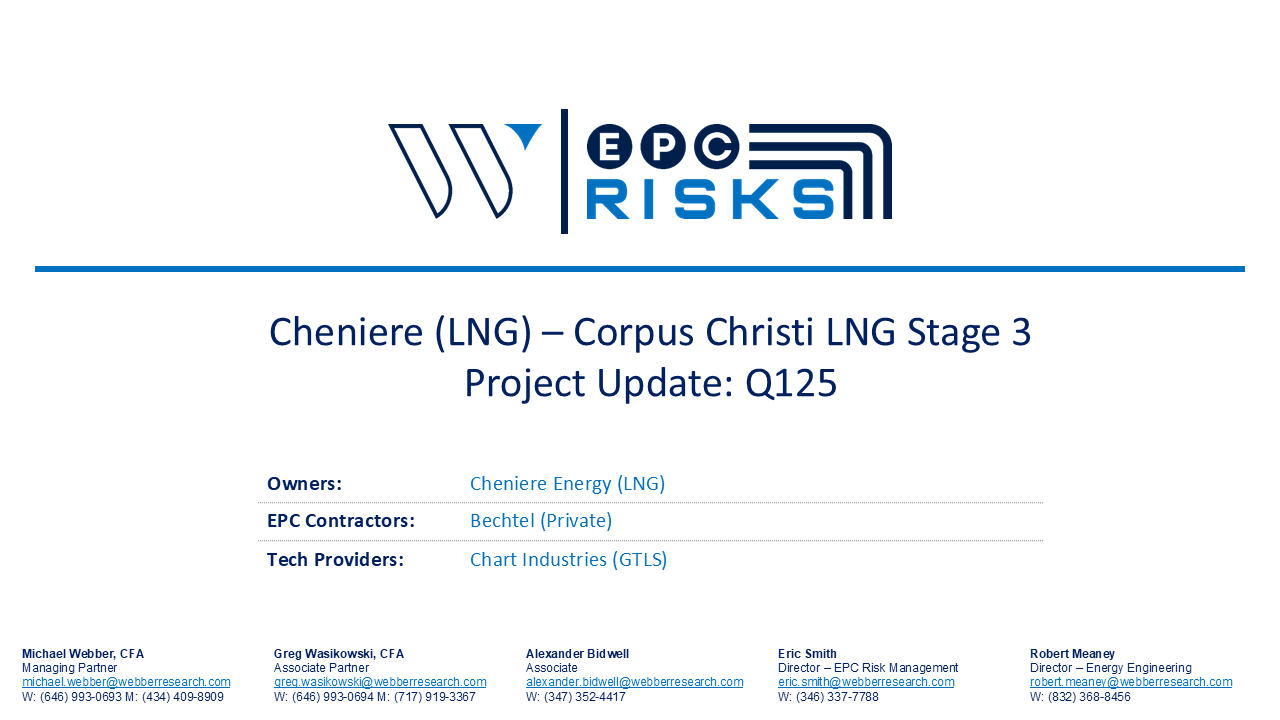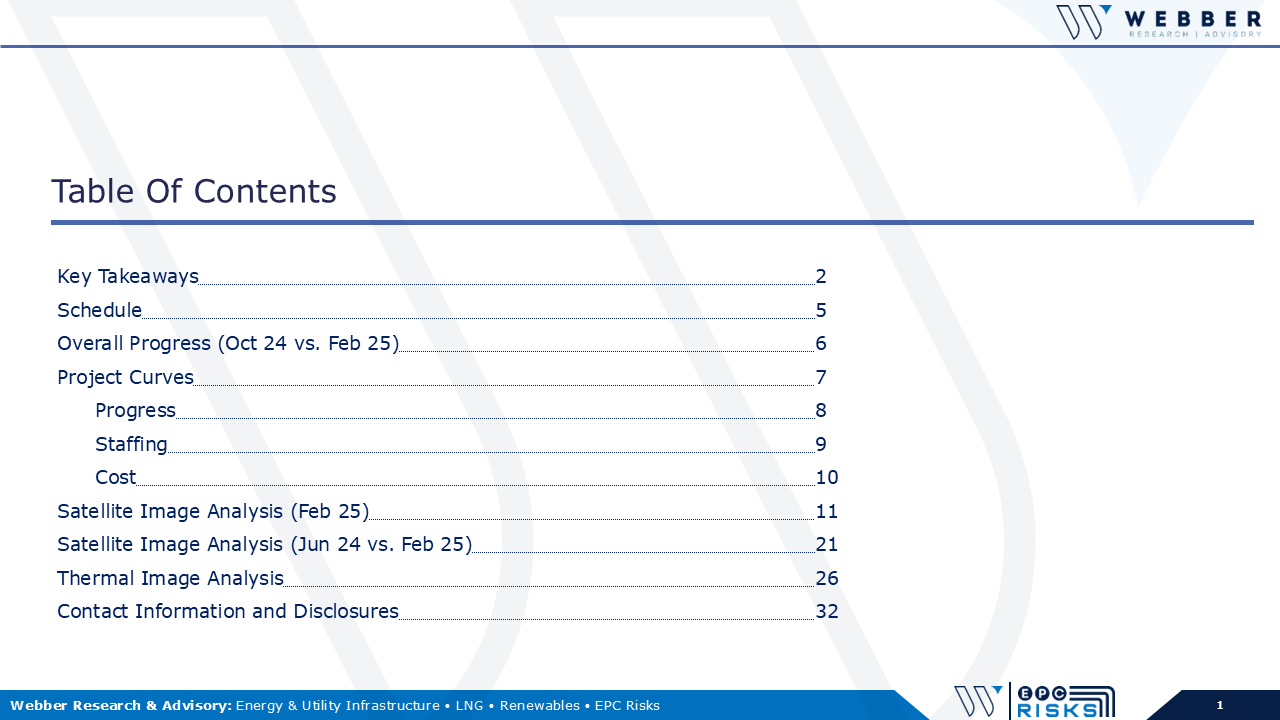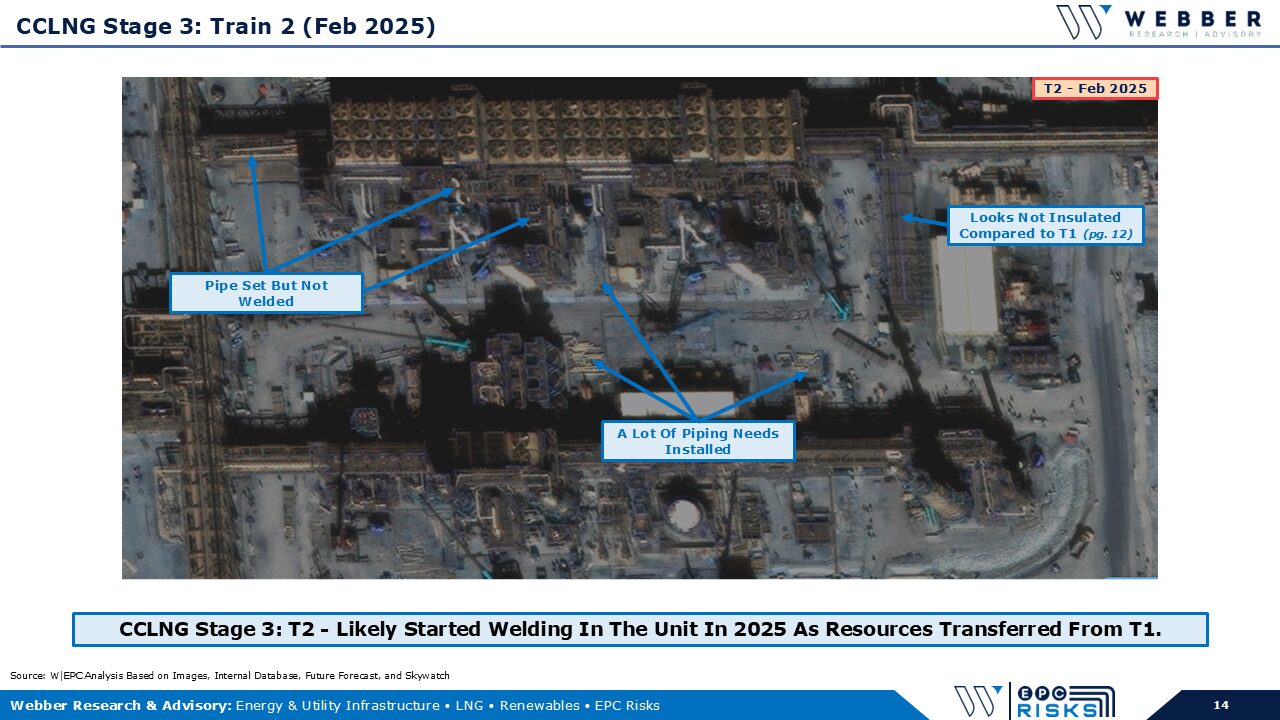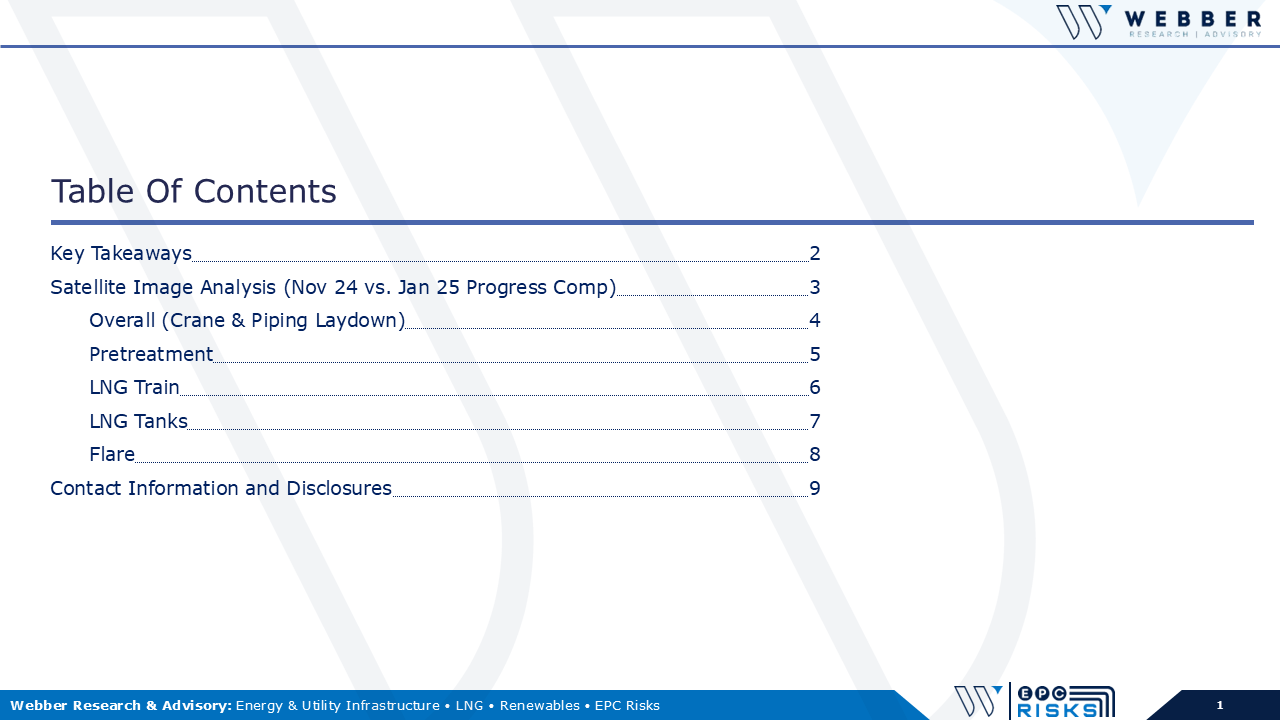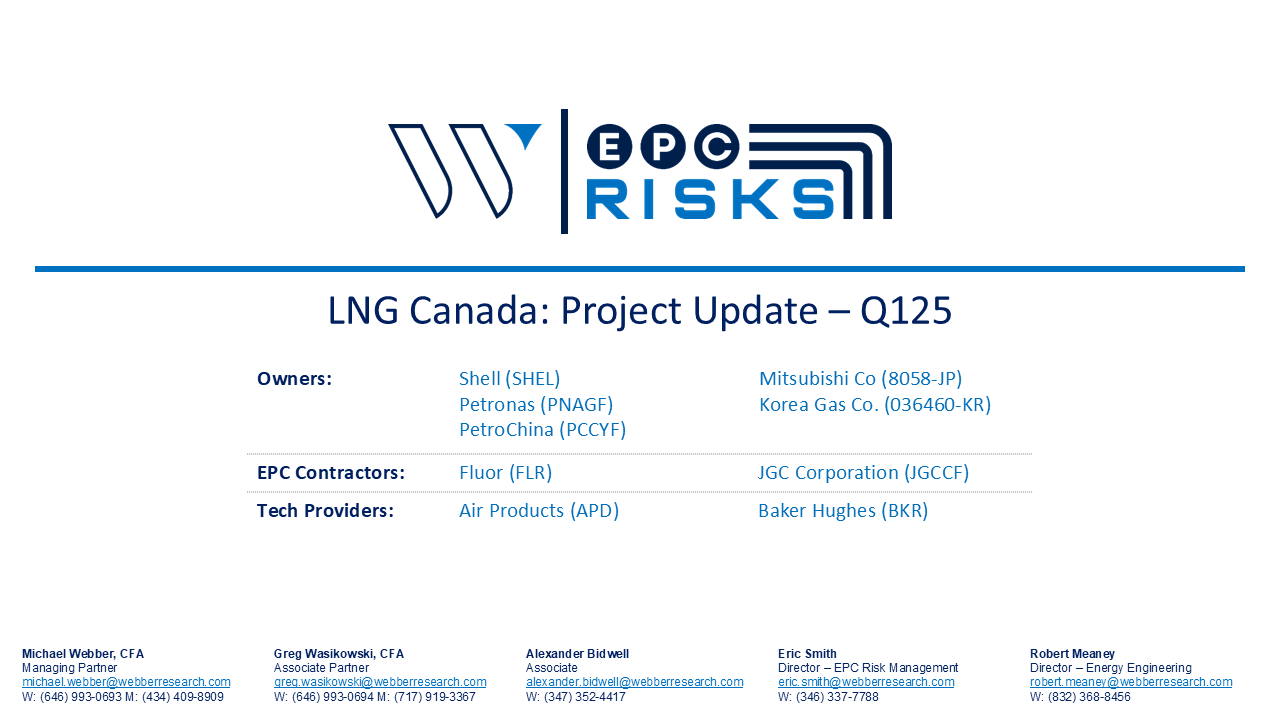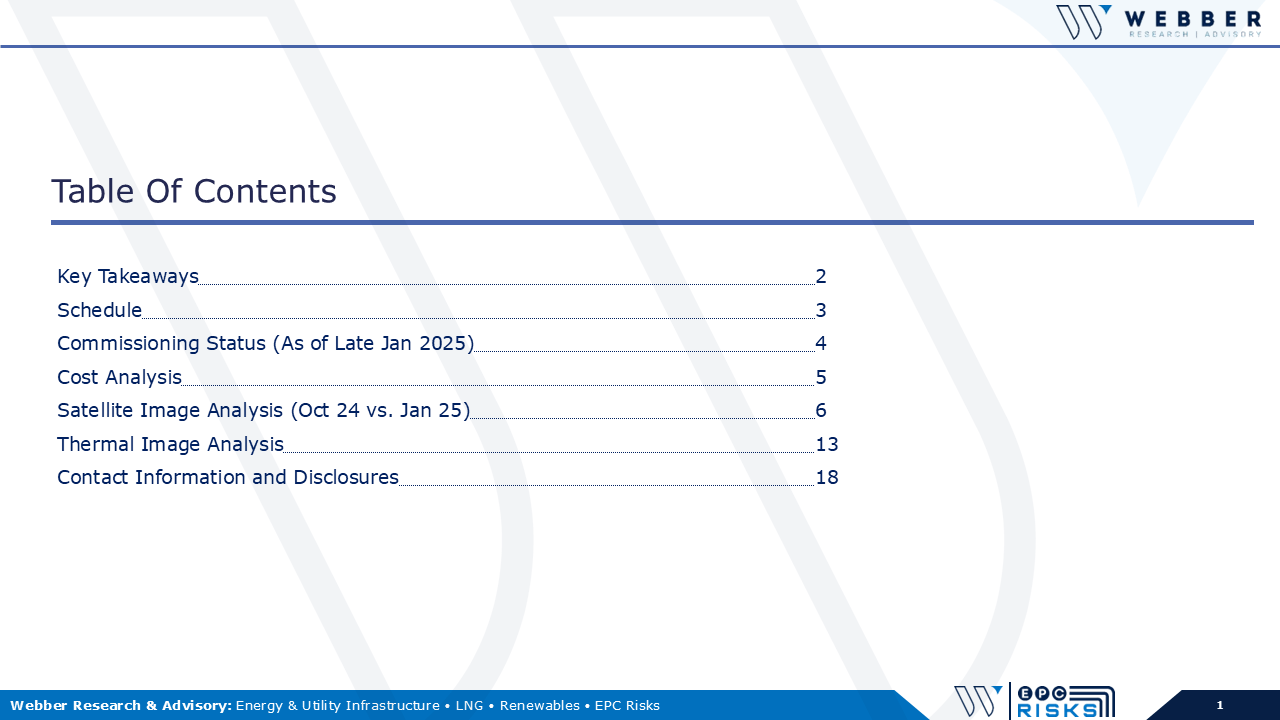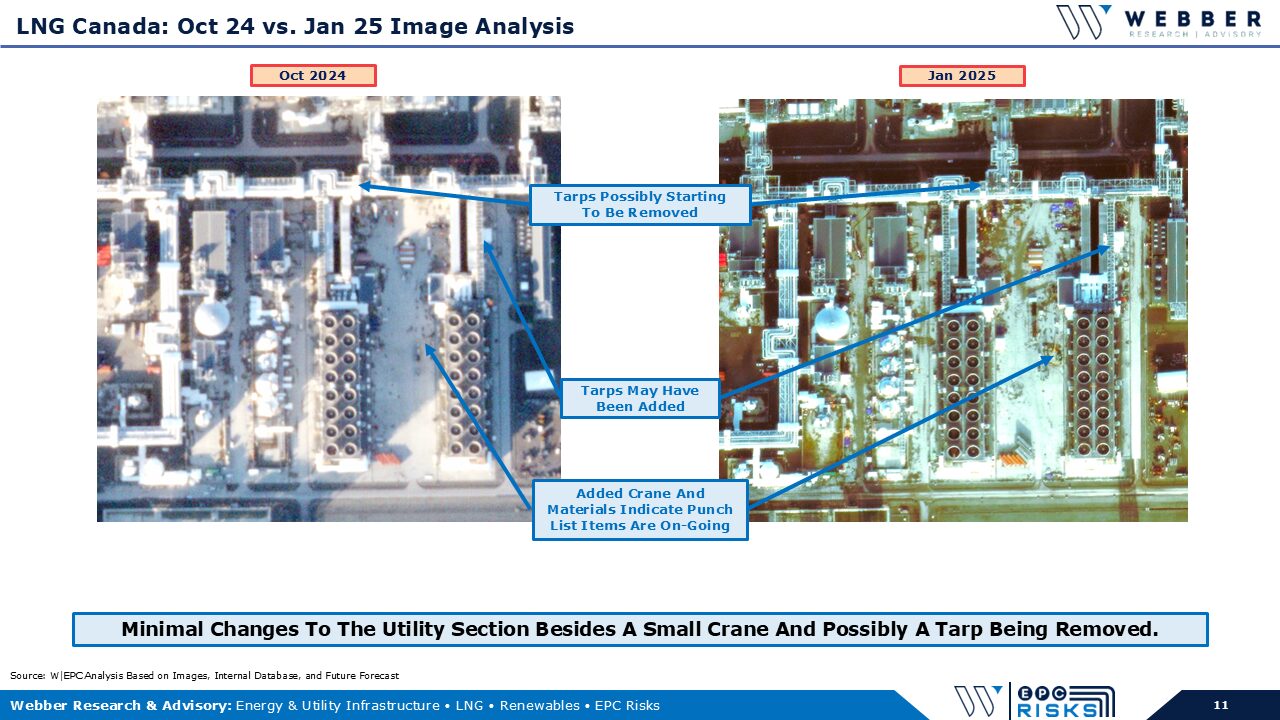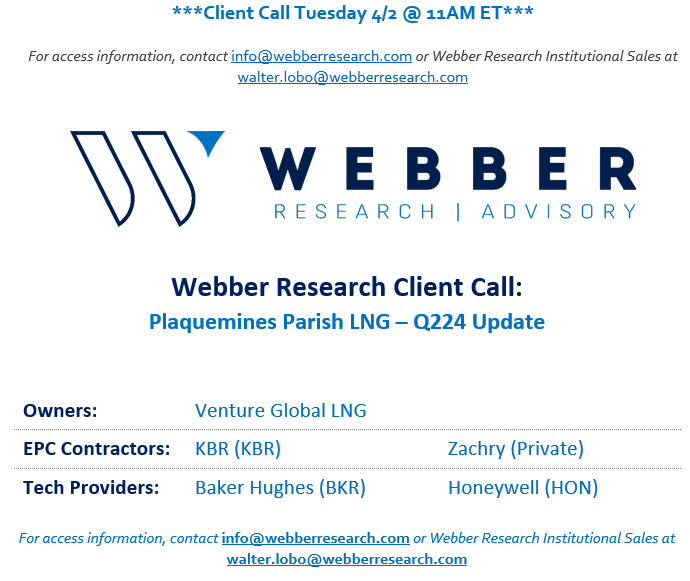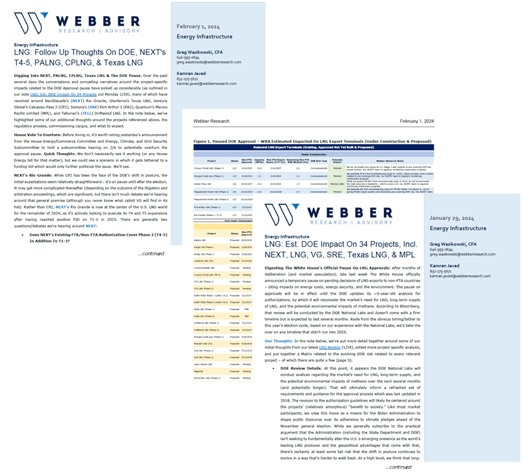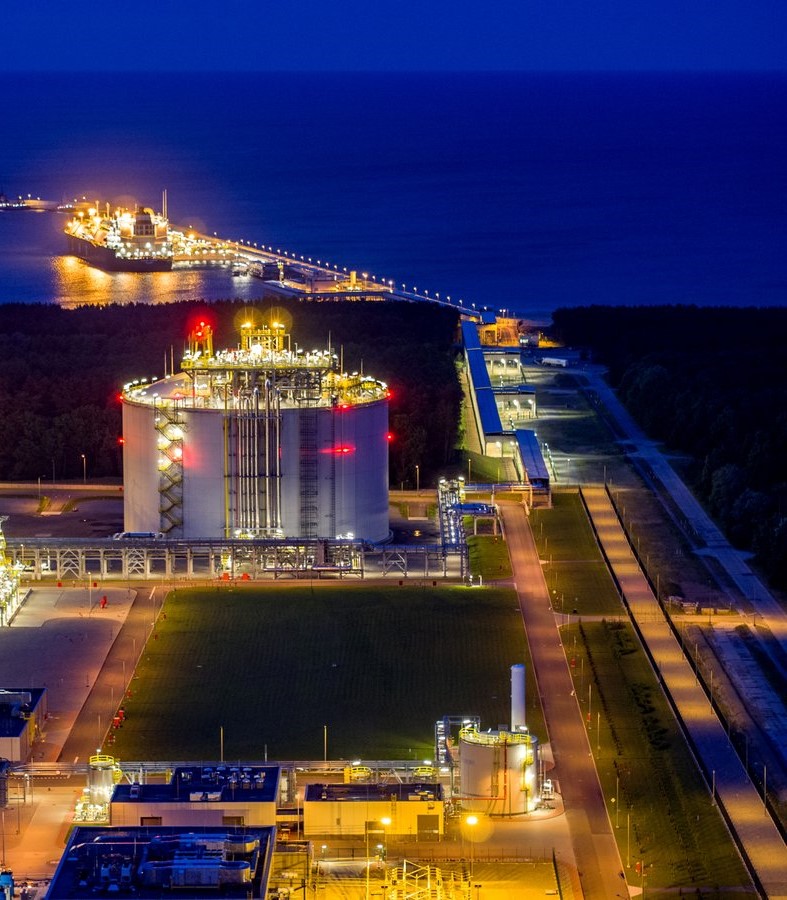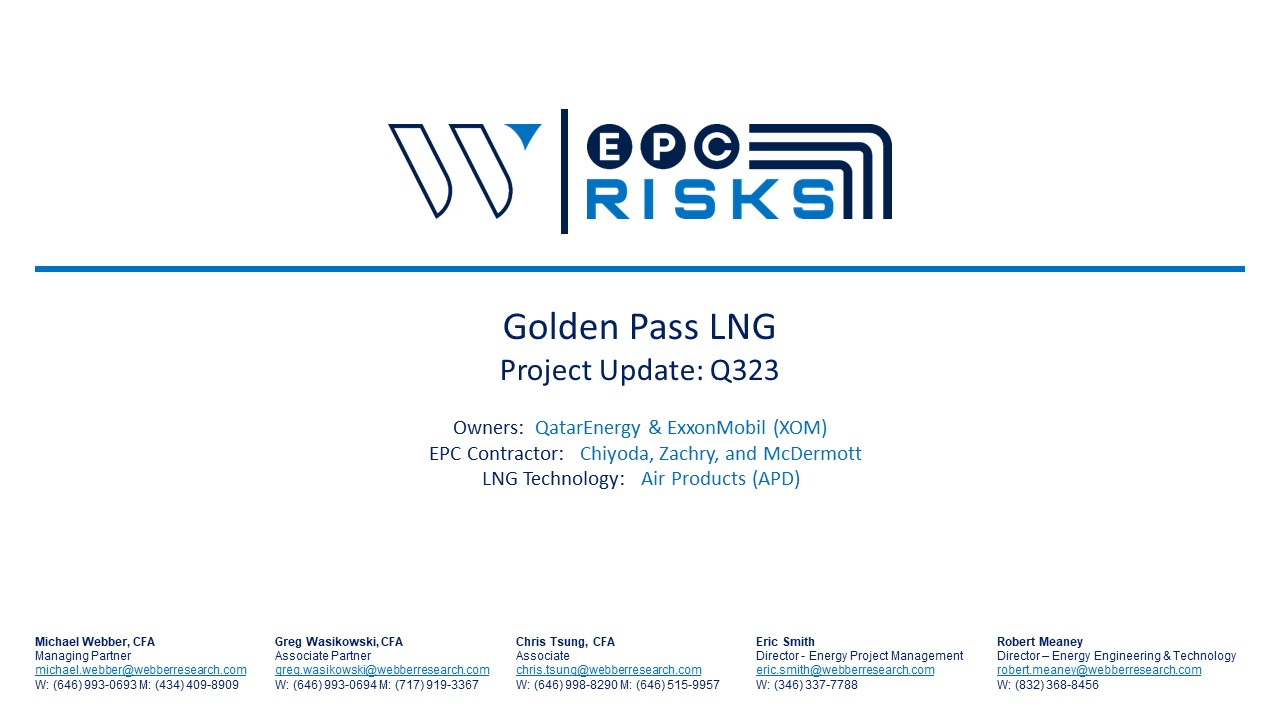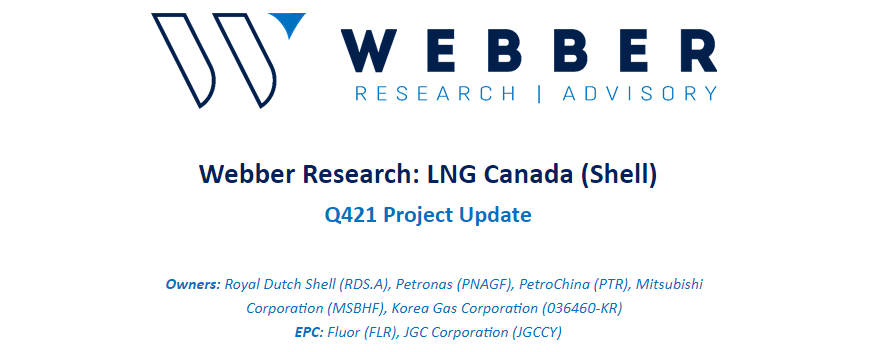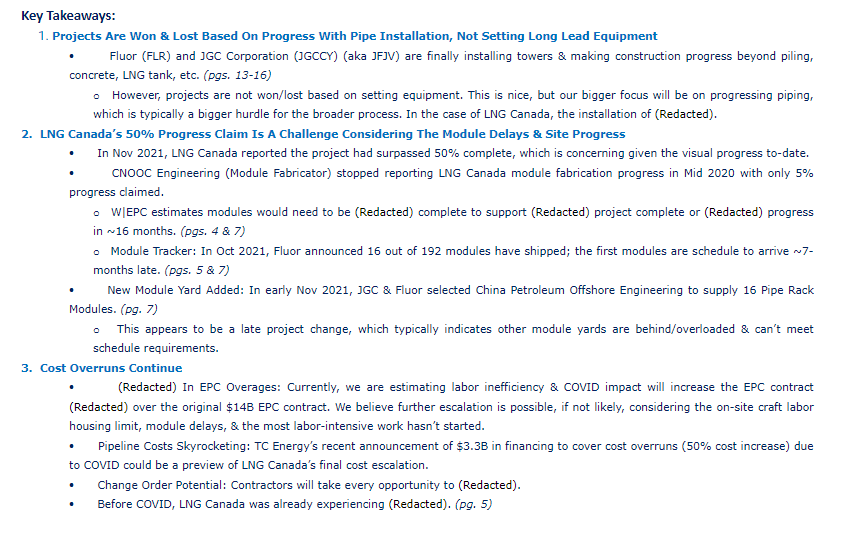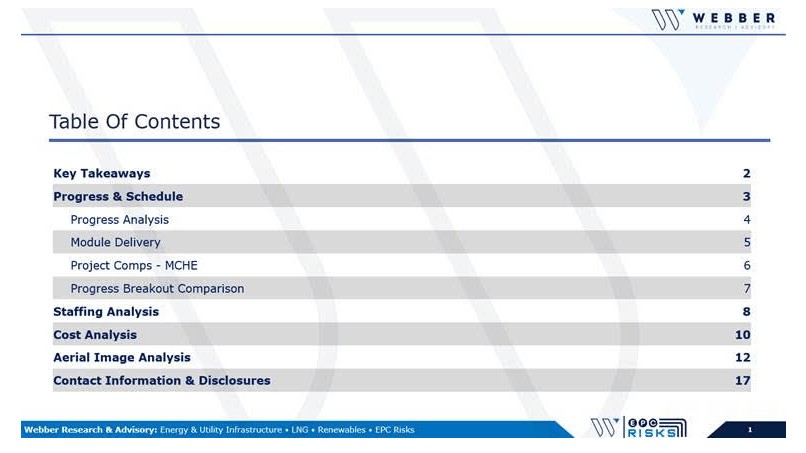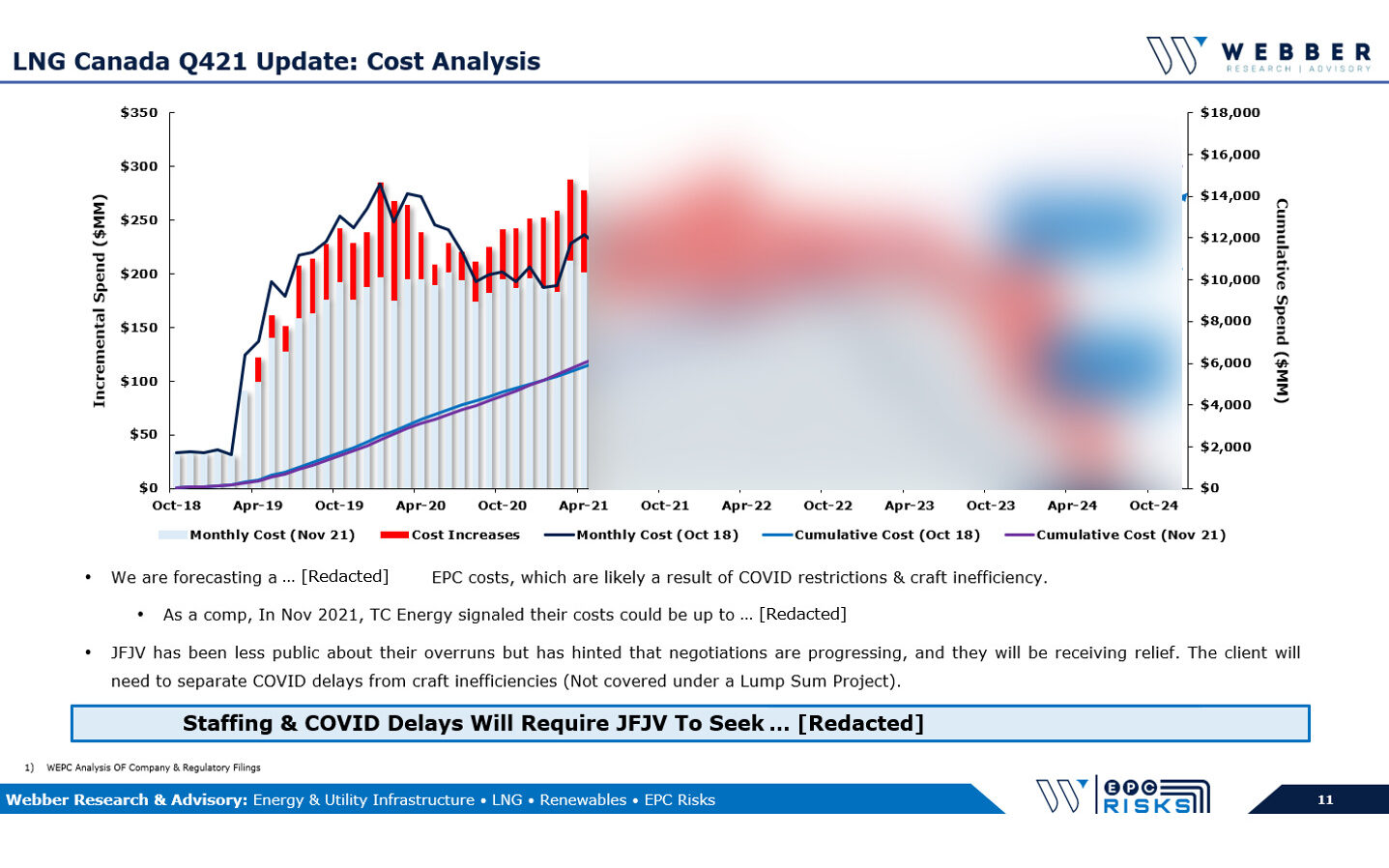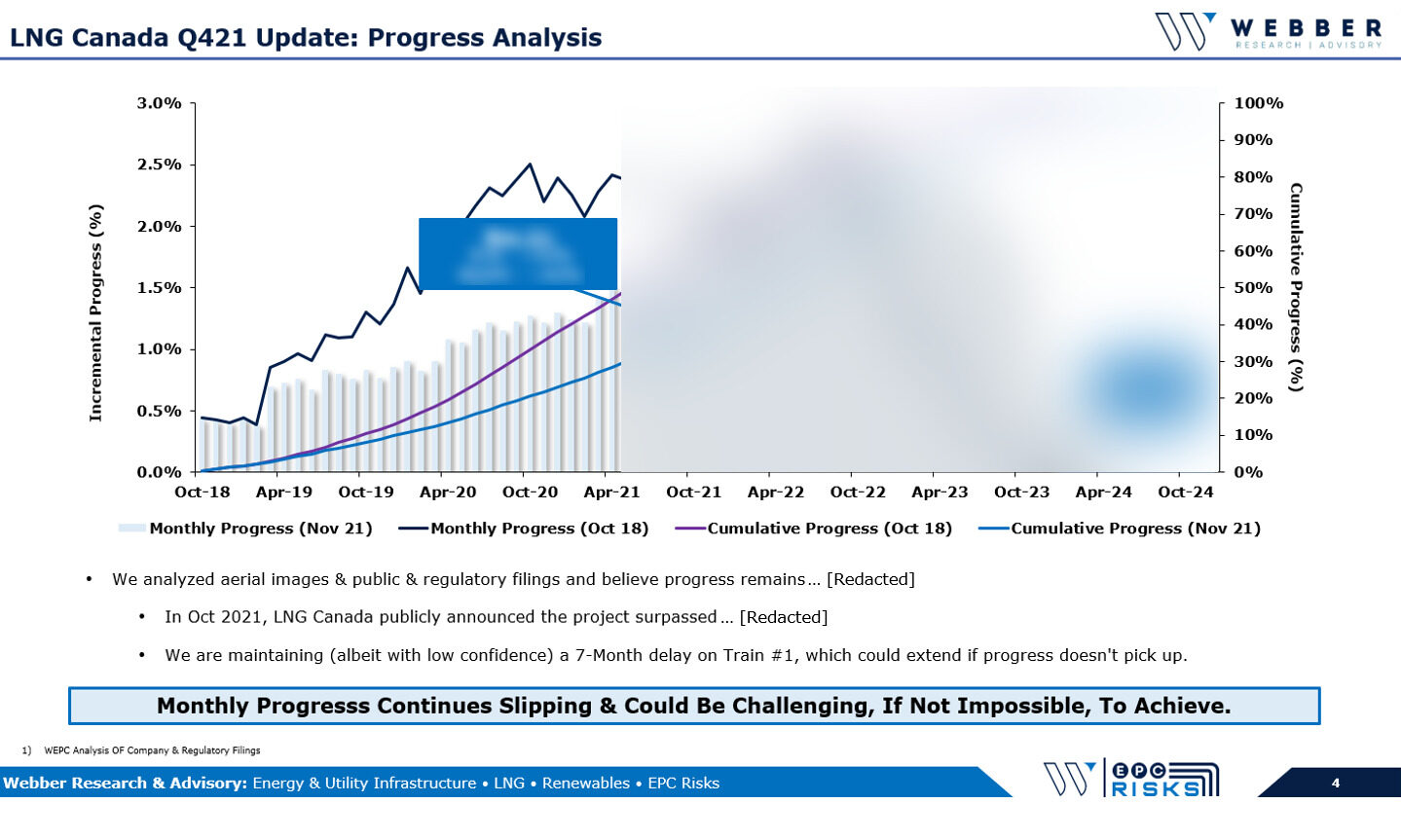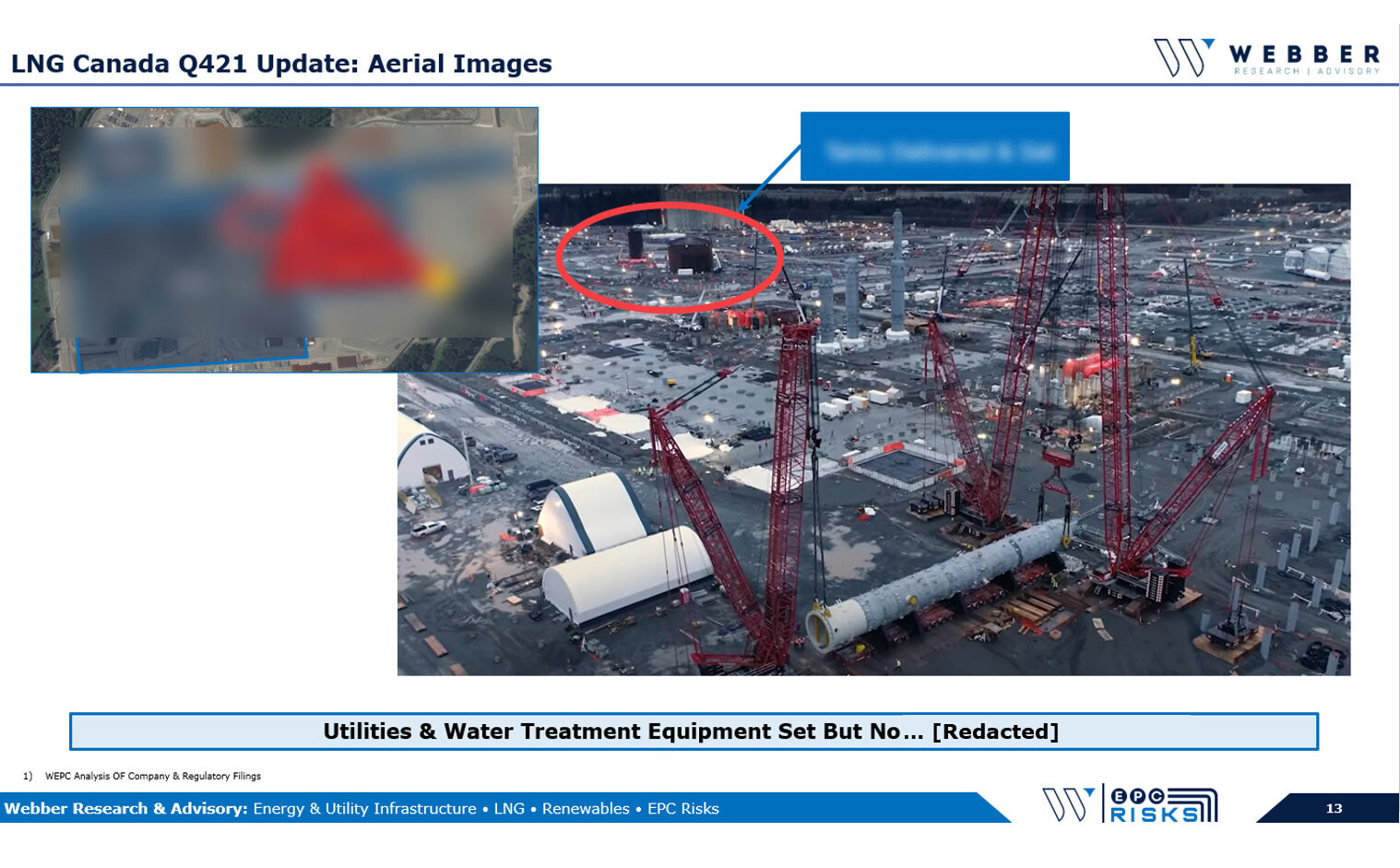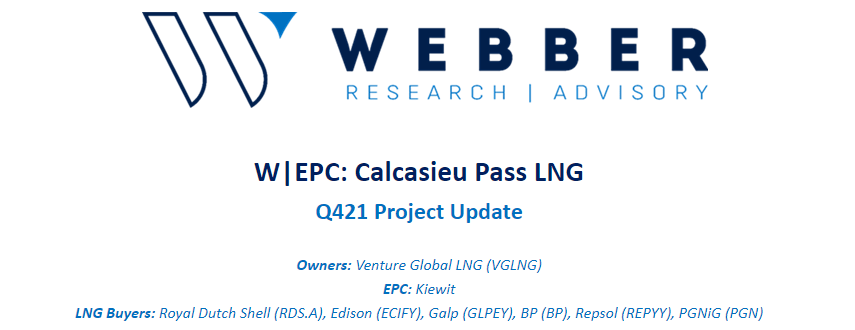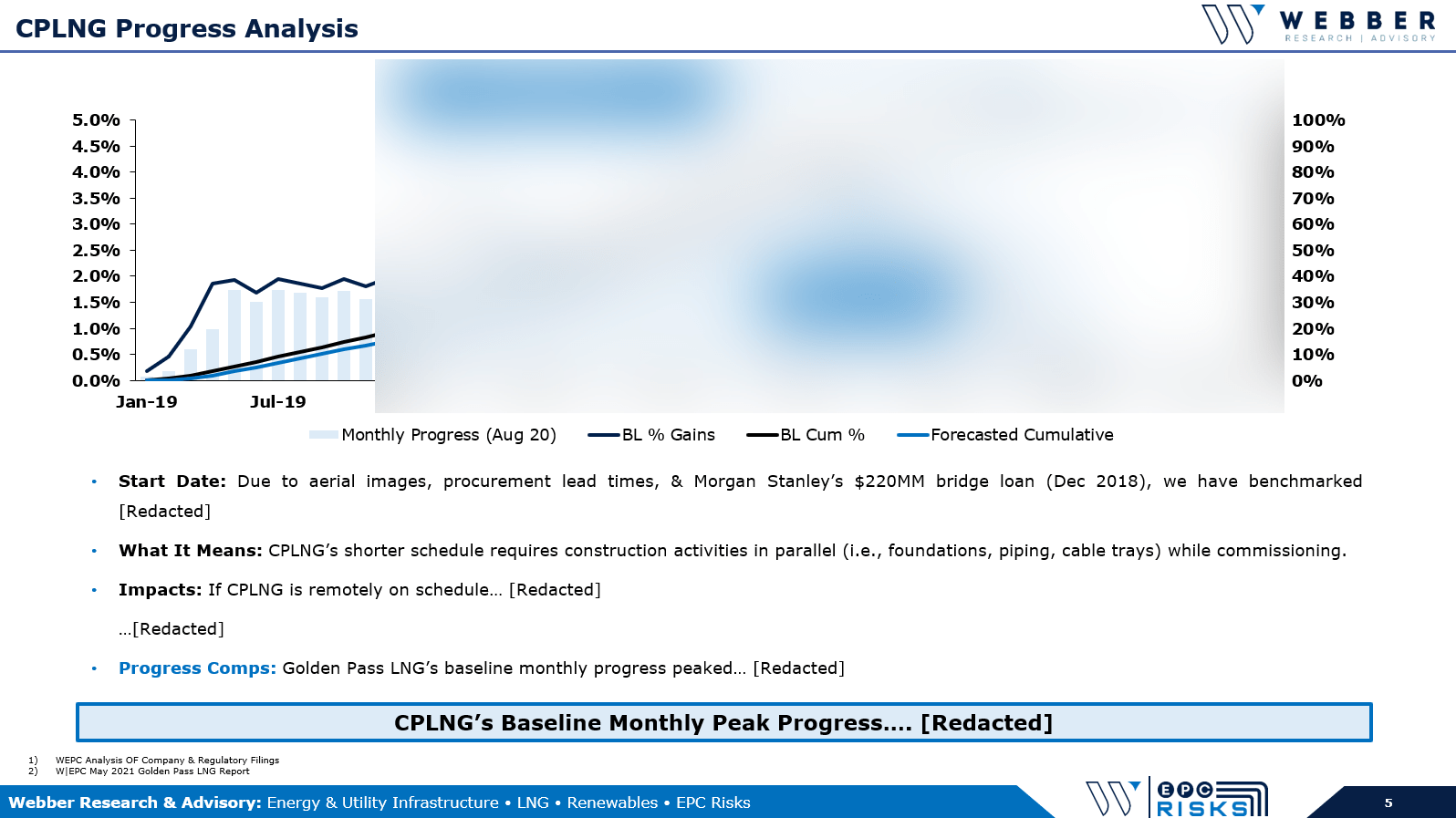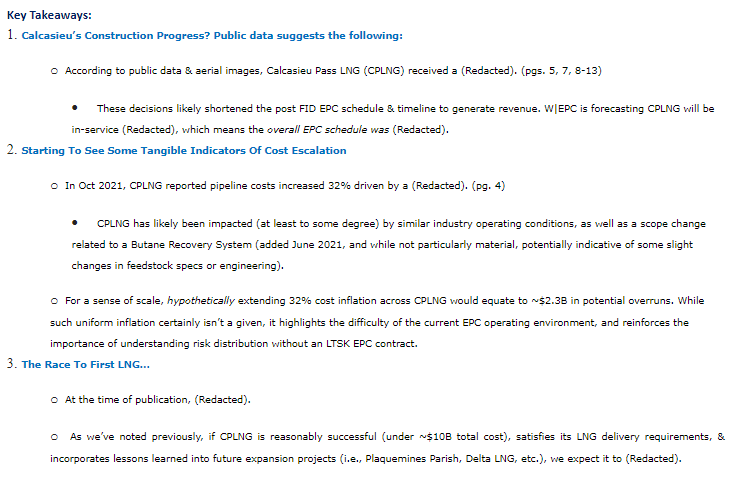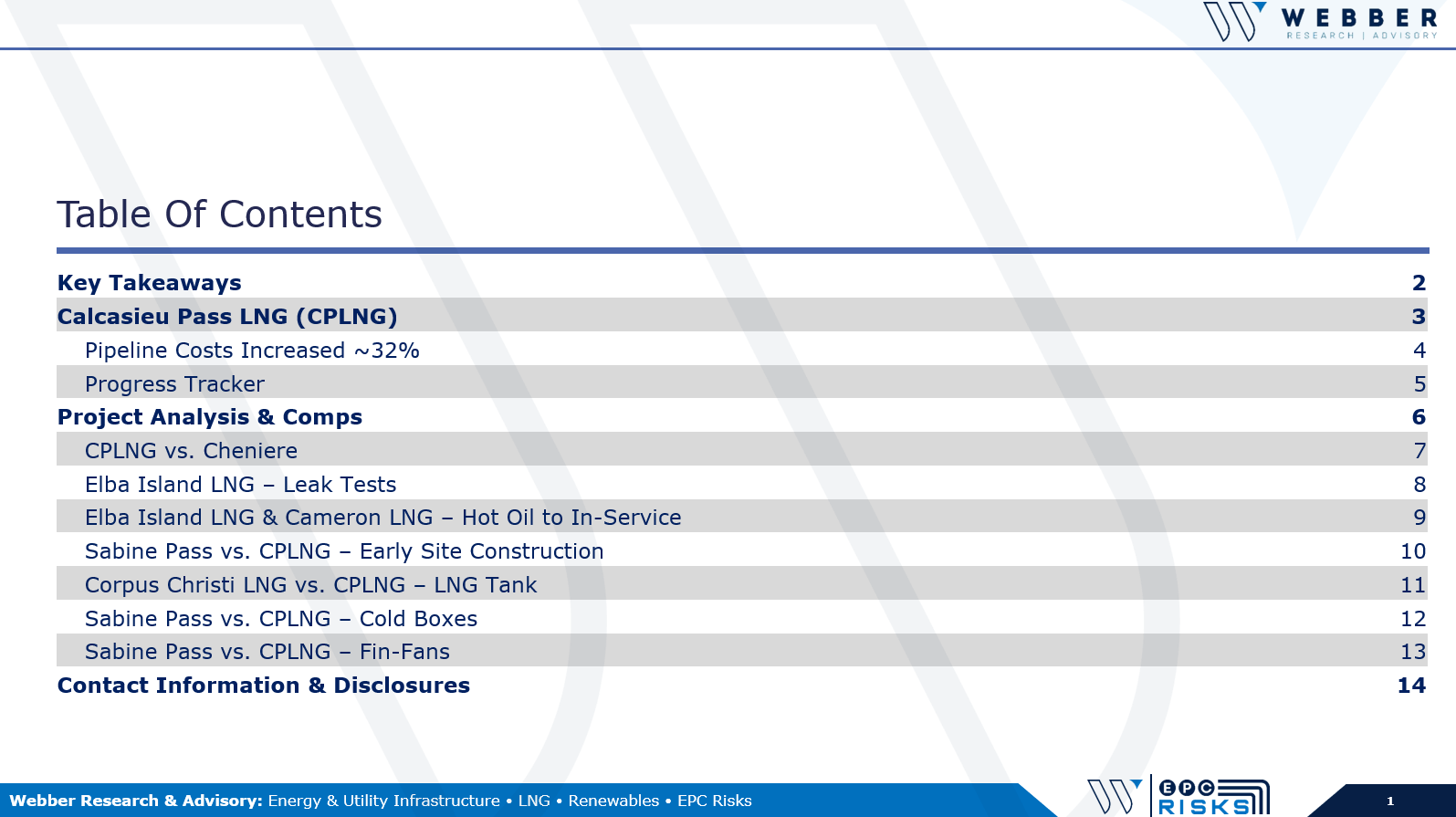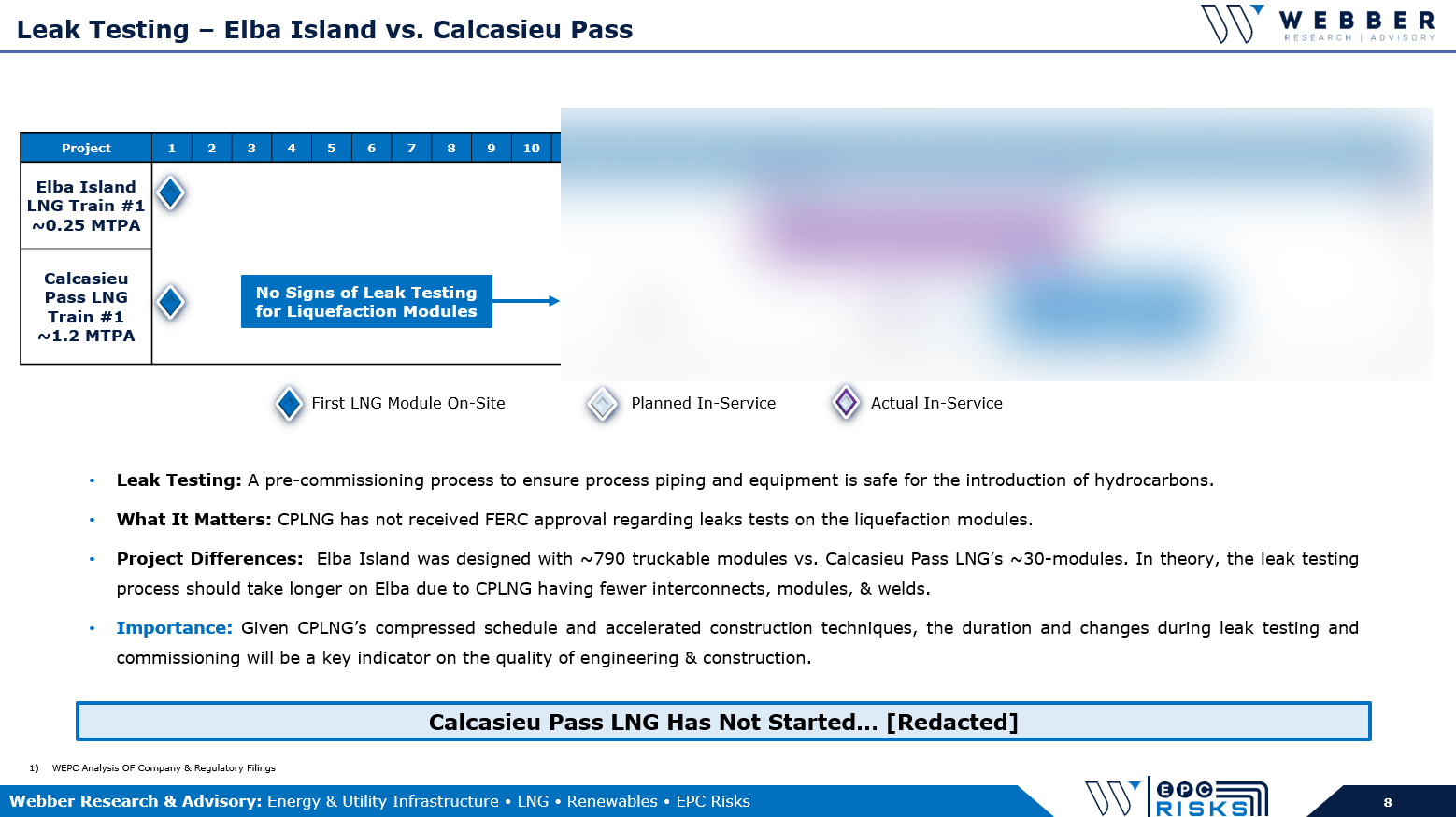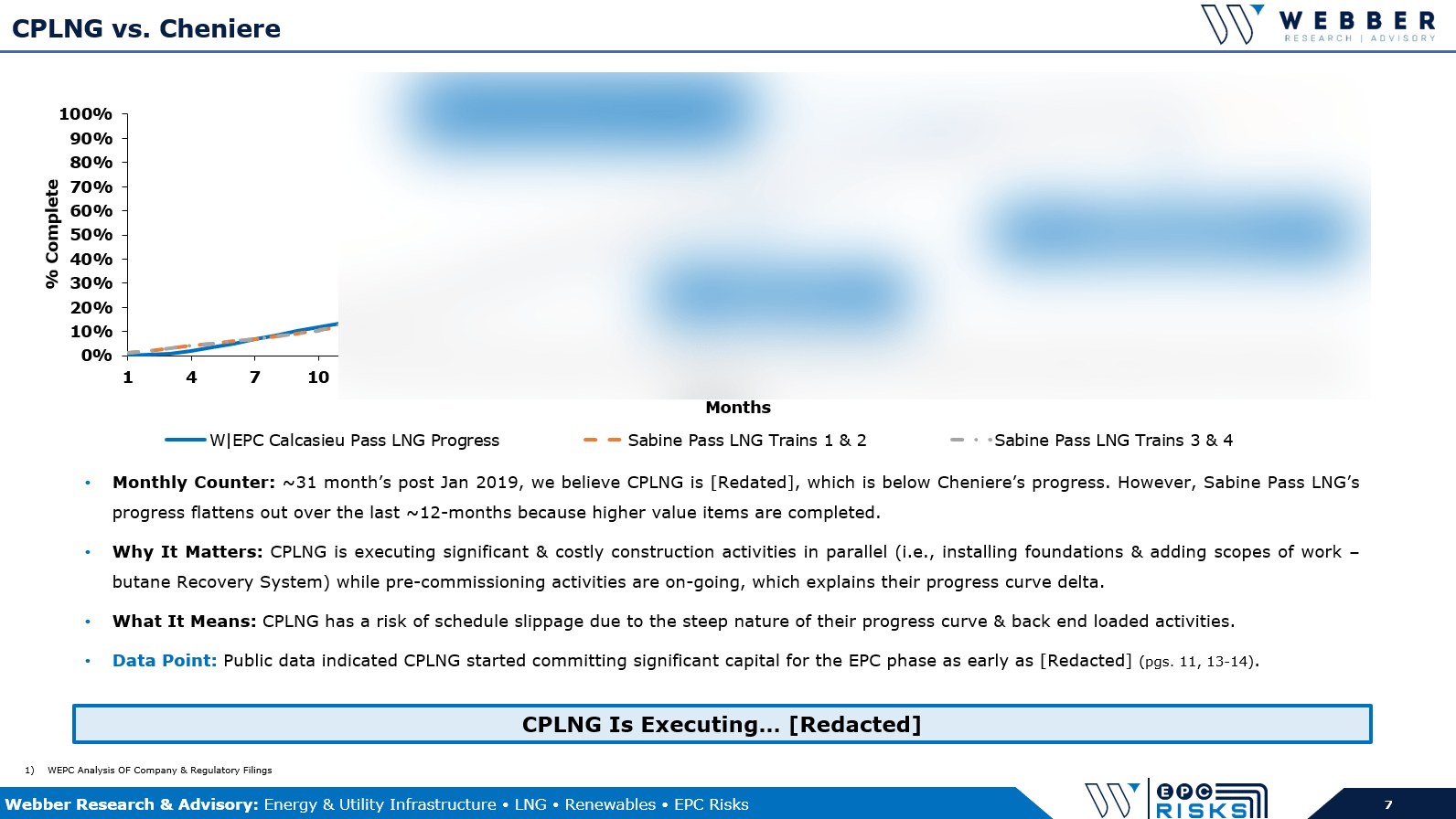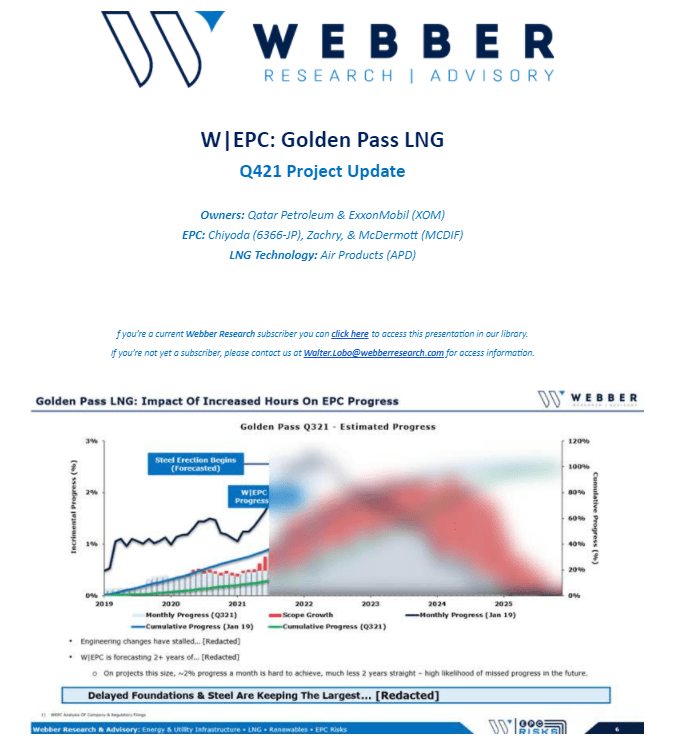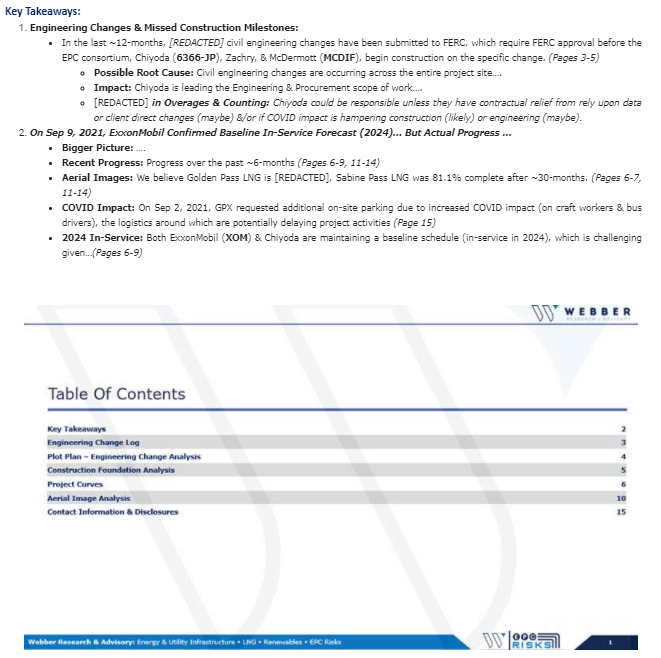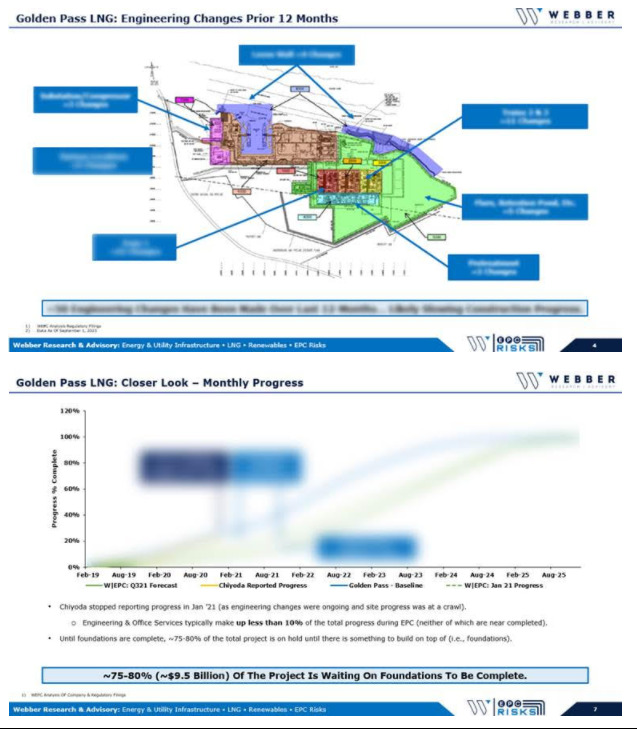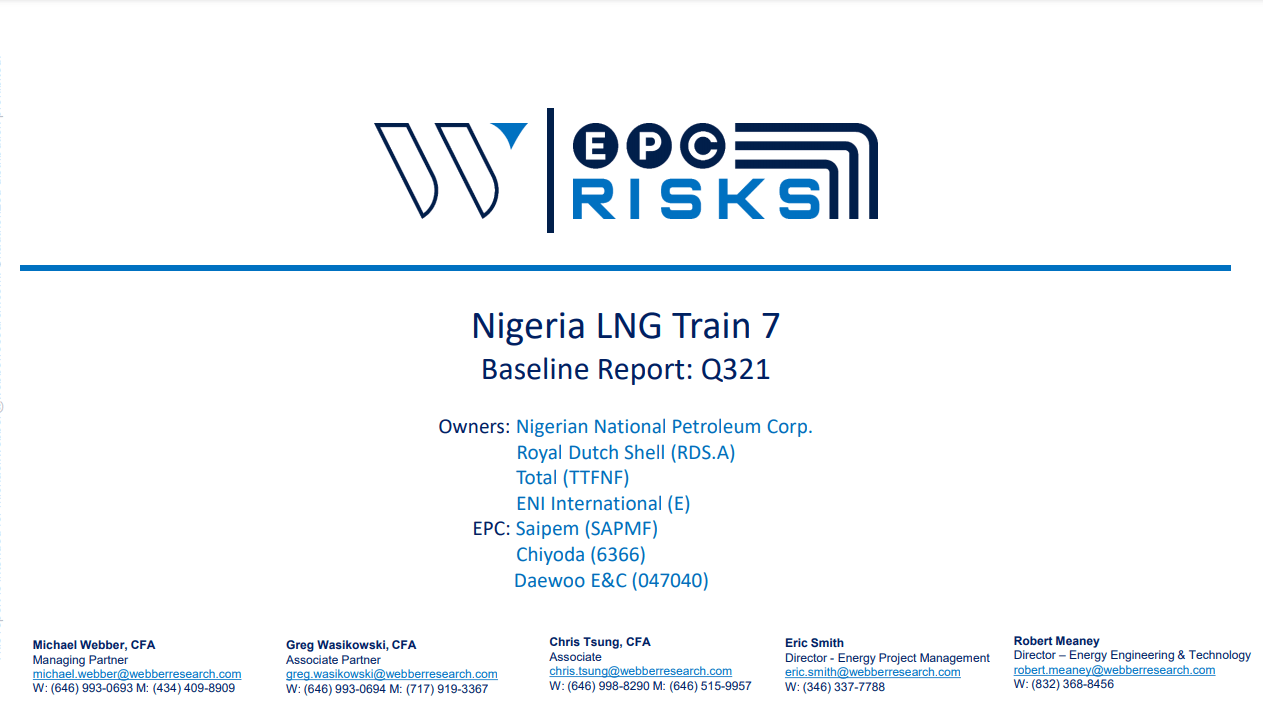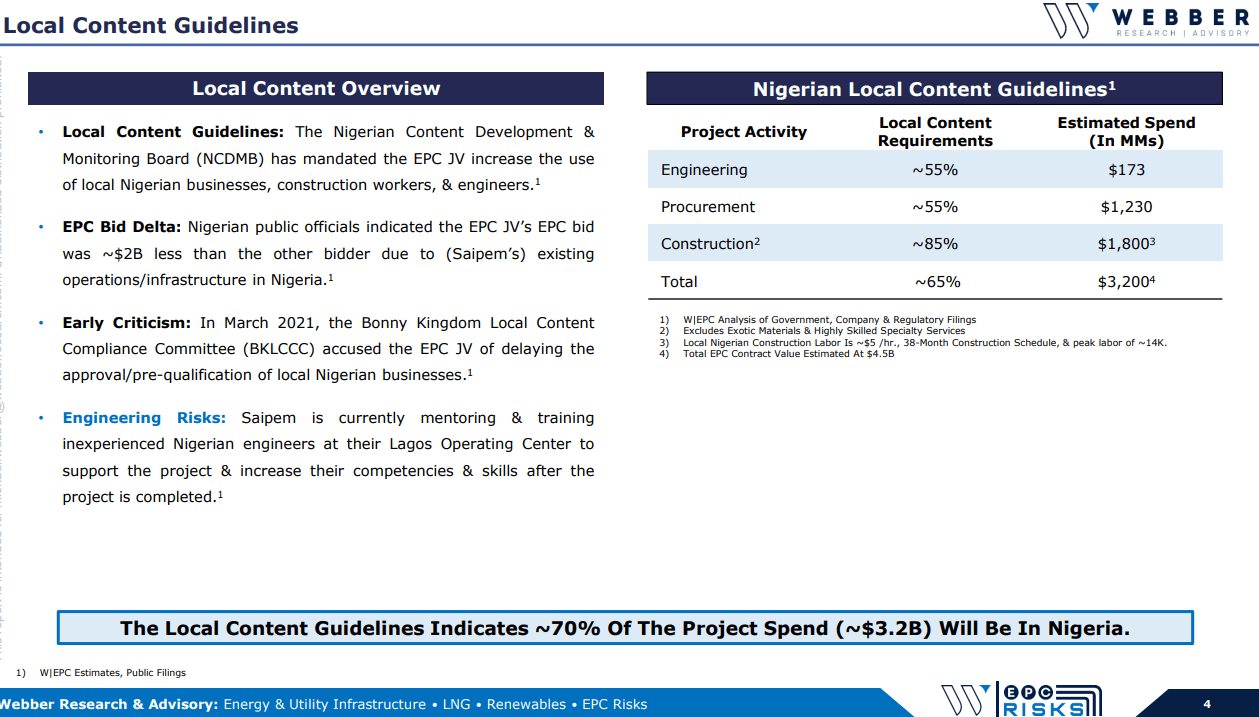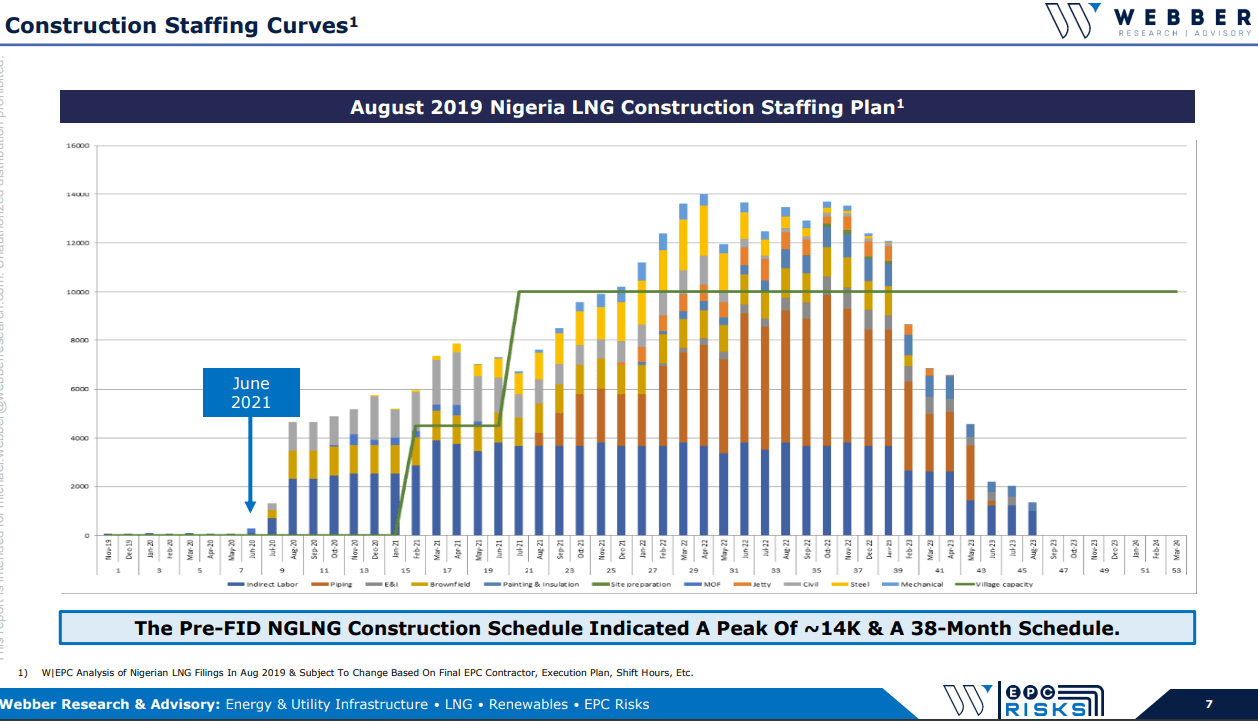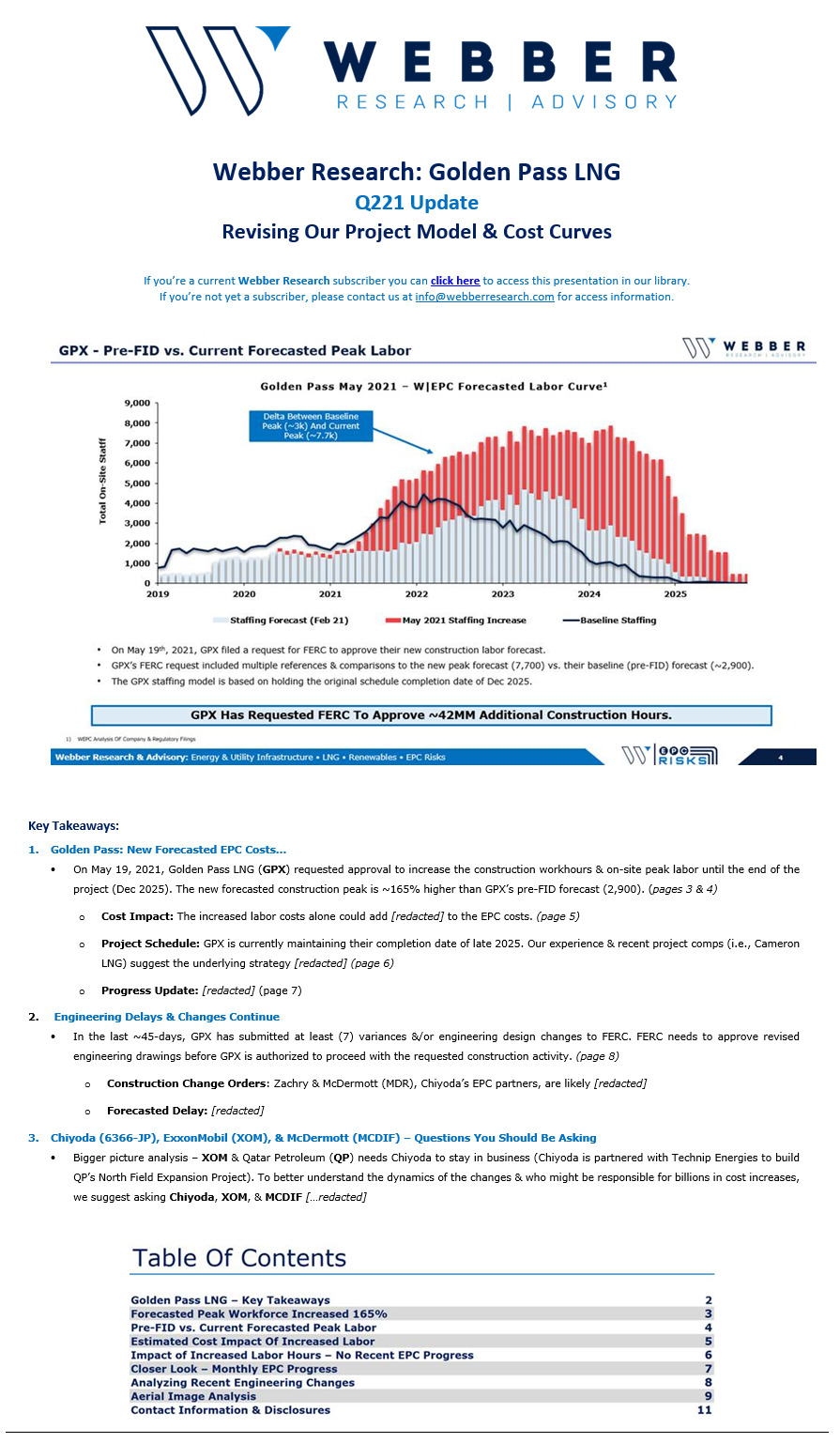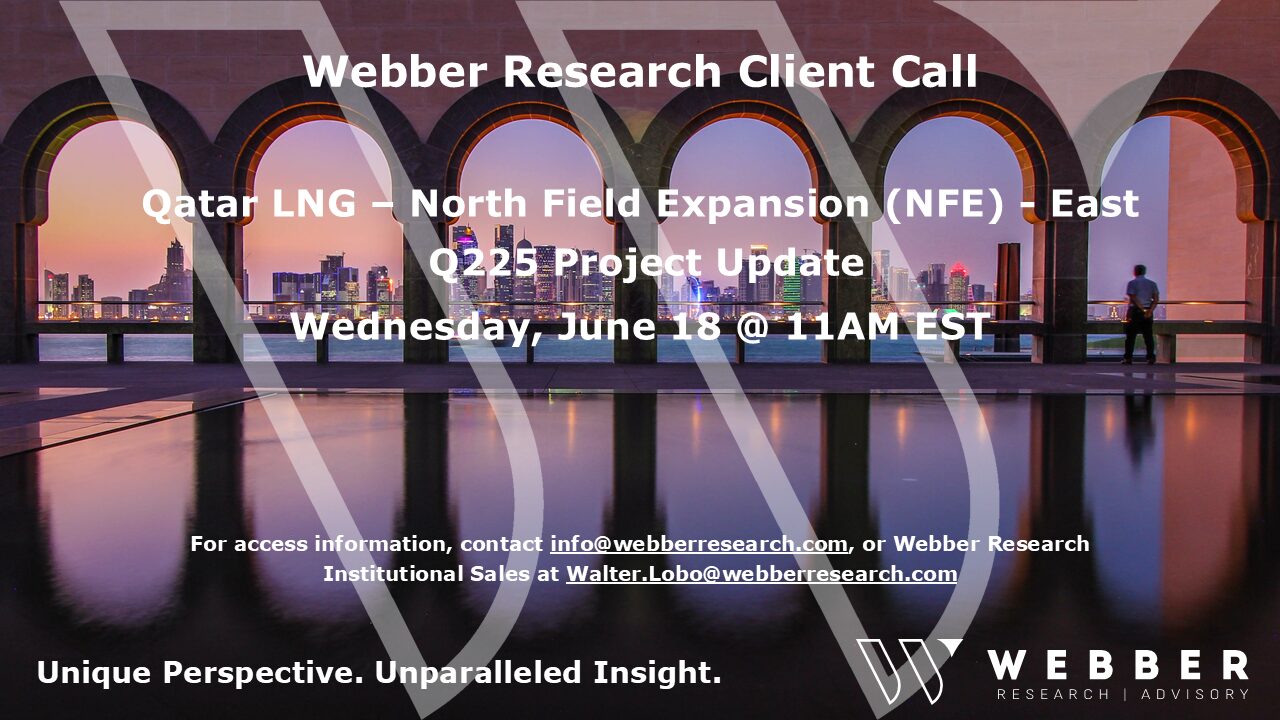

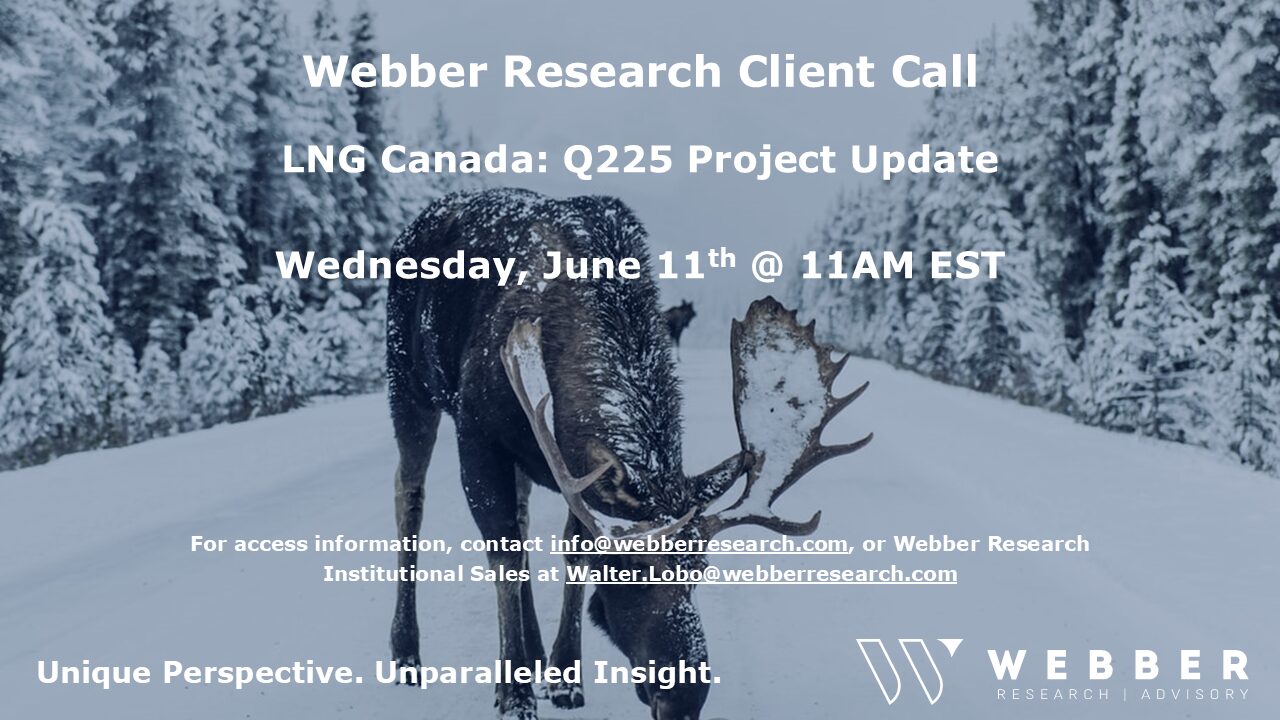


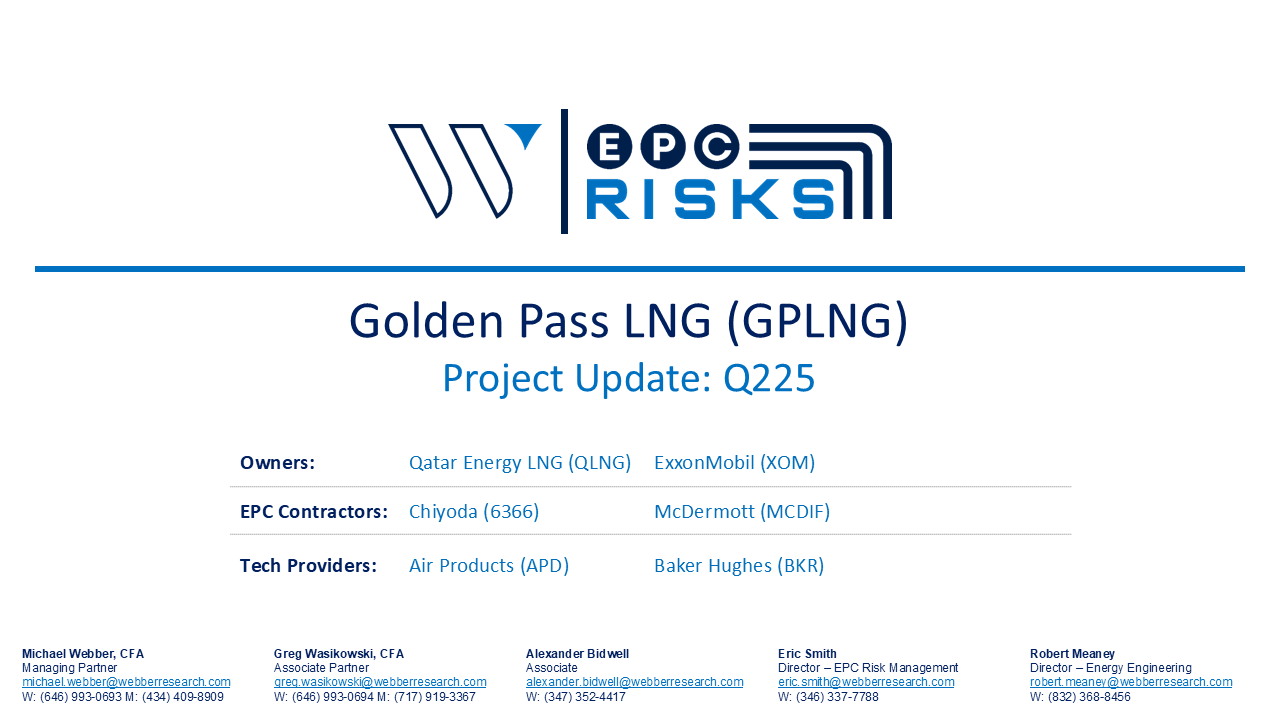
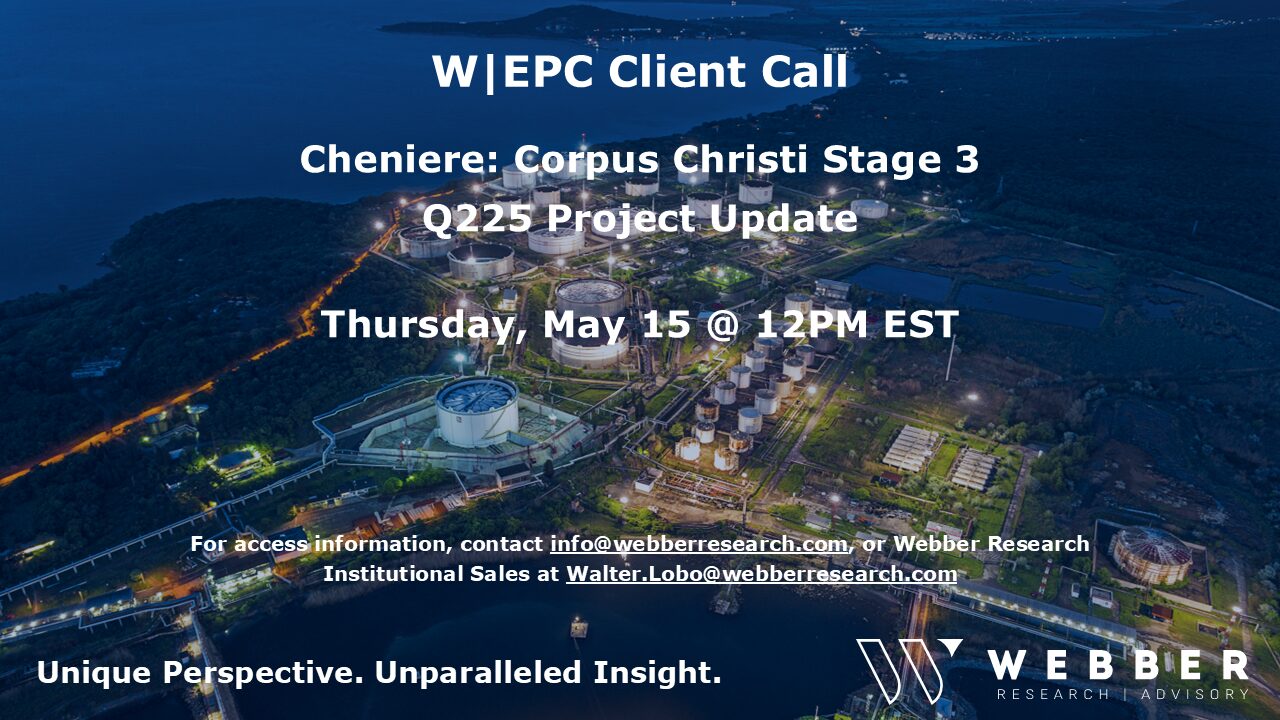
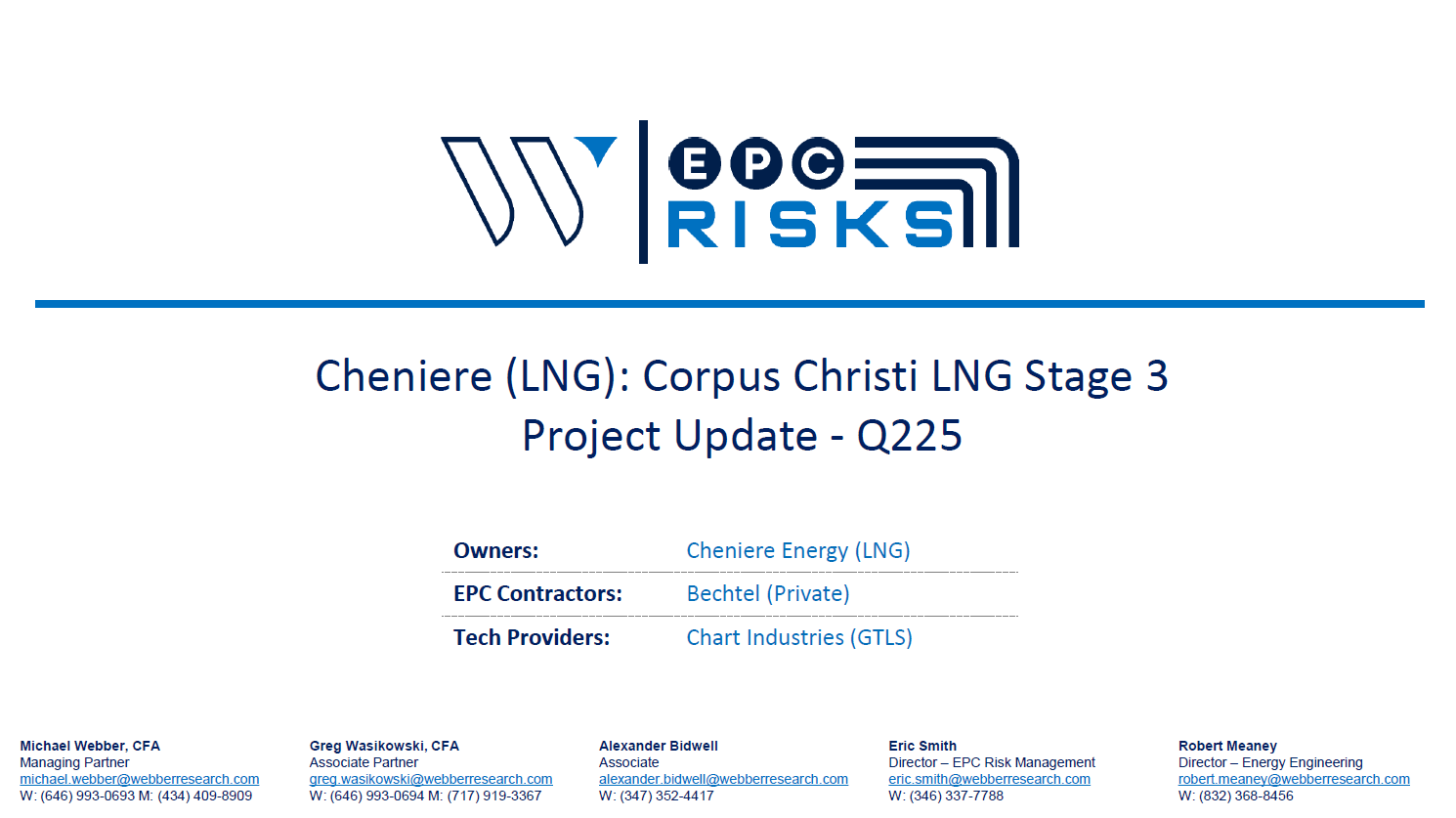
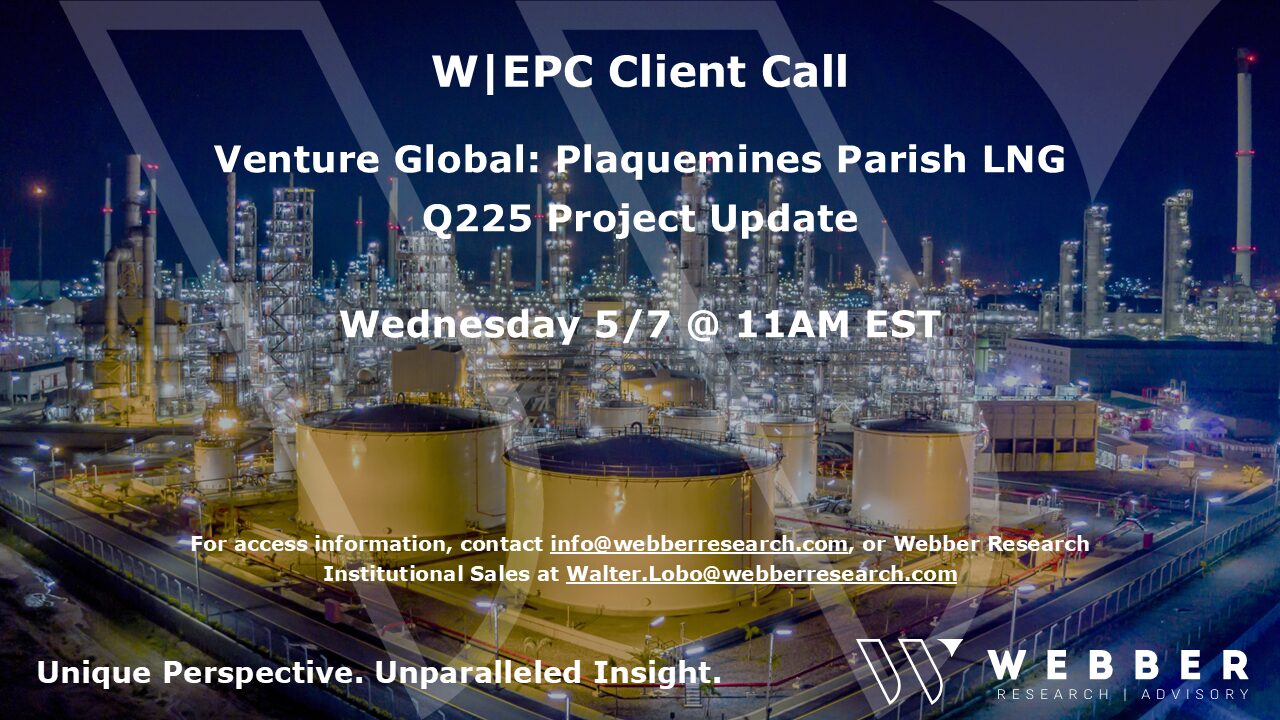
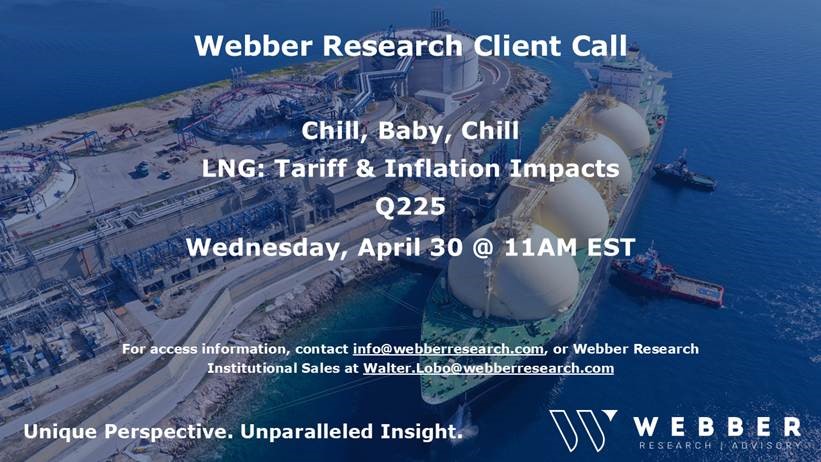
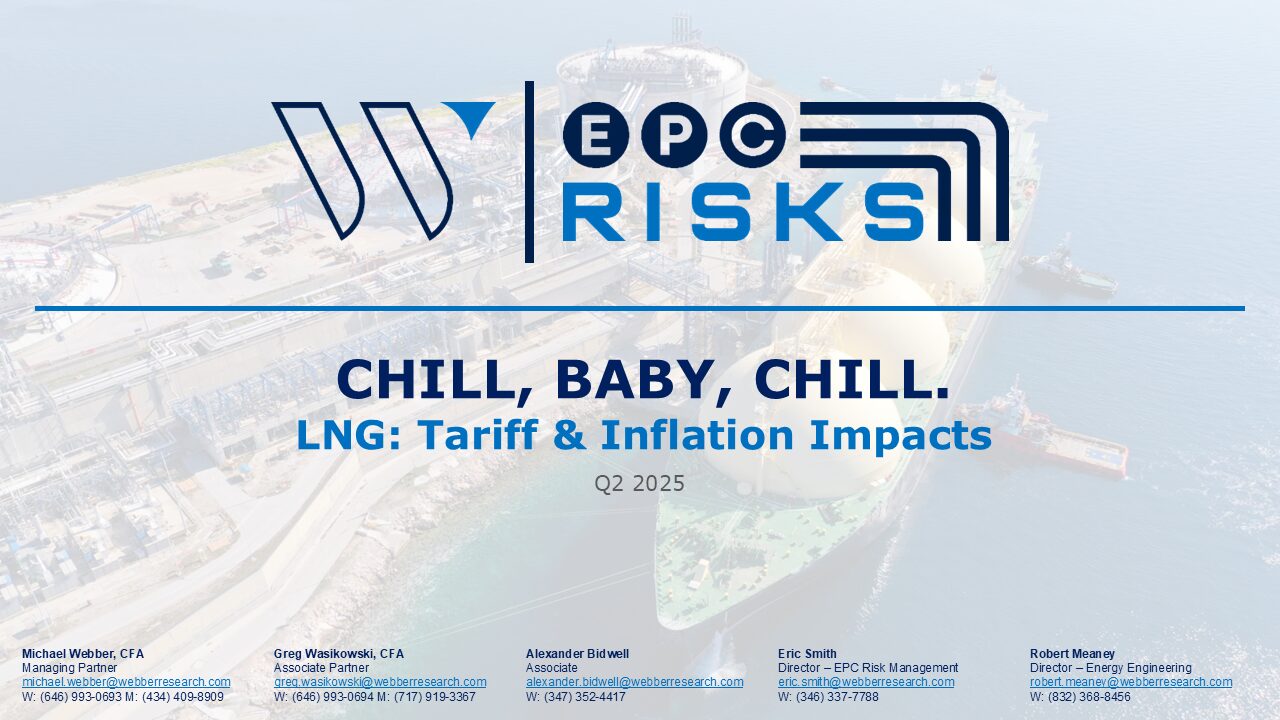
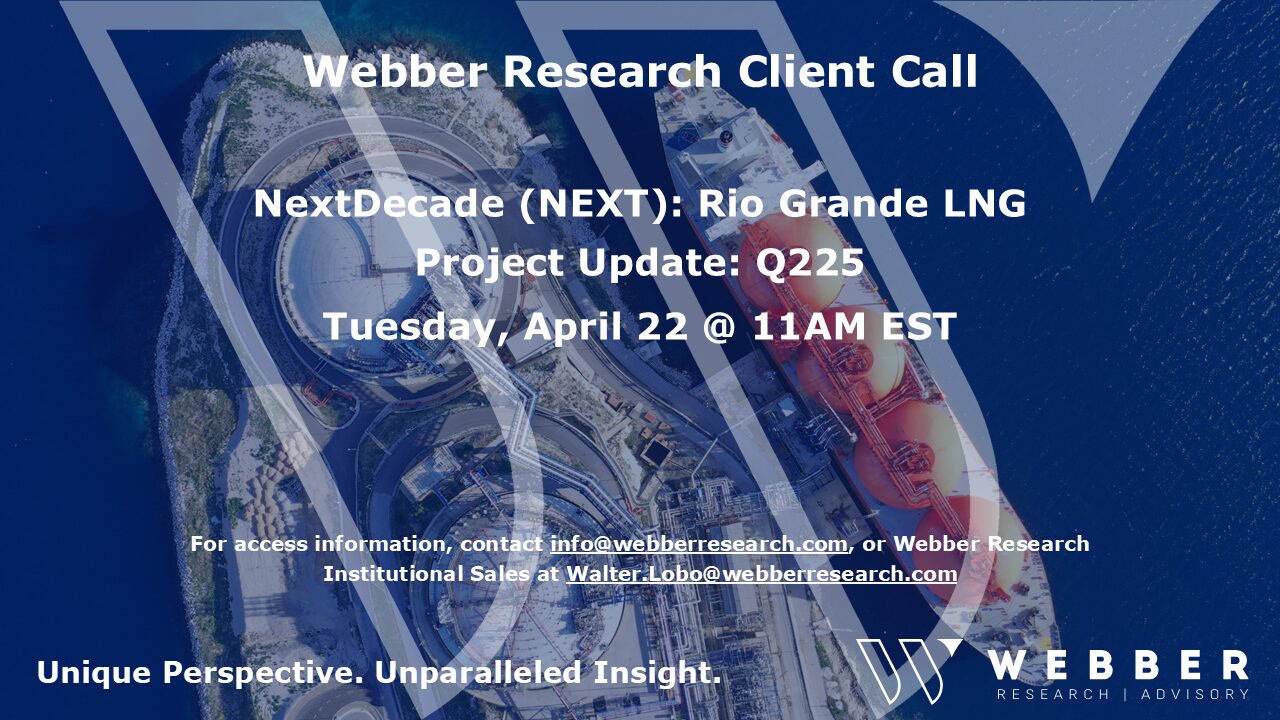
W|EPC: NextDecade (NEXT) – Rio Grande LNG Q225 Project Update & Client Call, Tues 04/22 @11AM EST
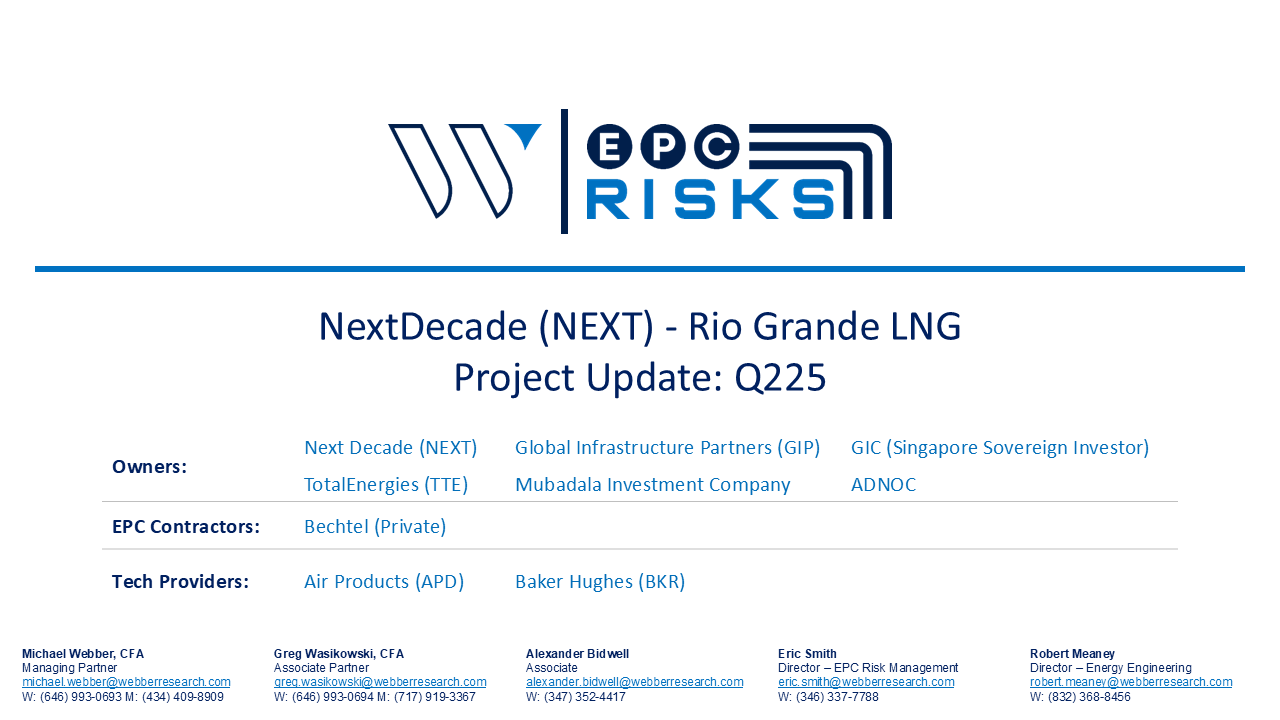
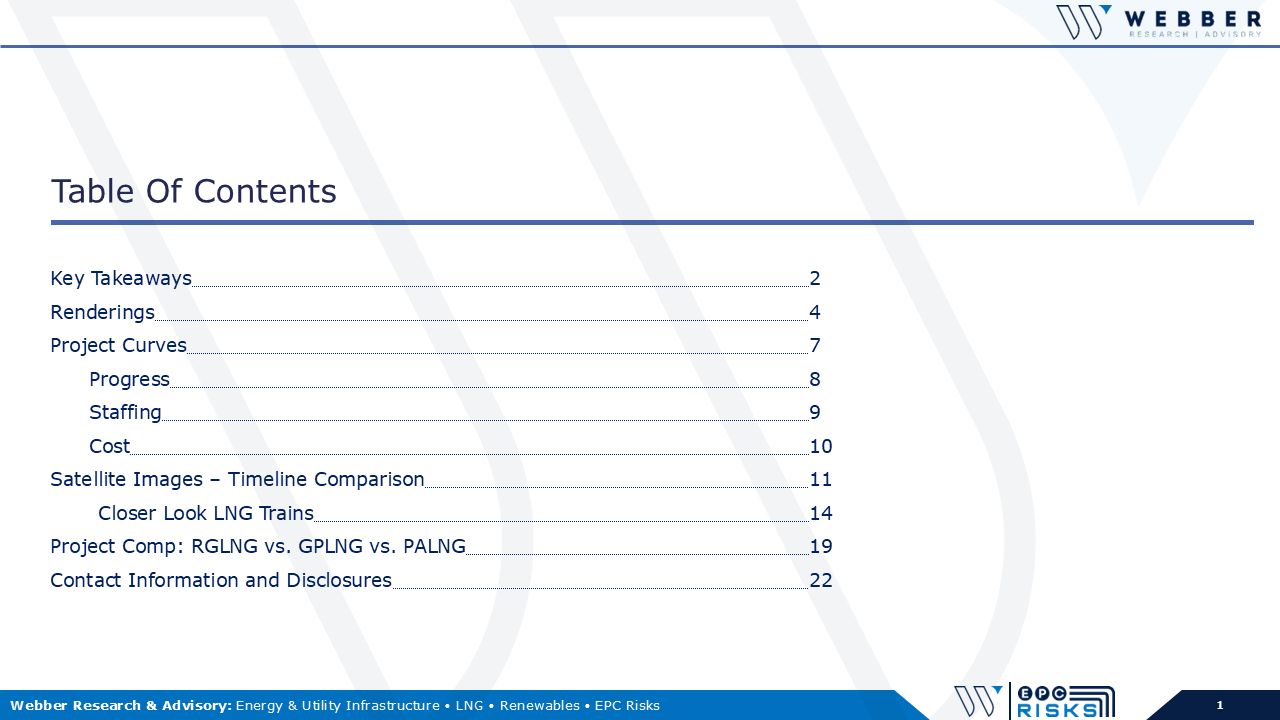
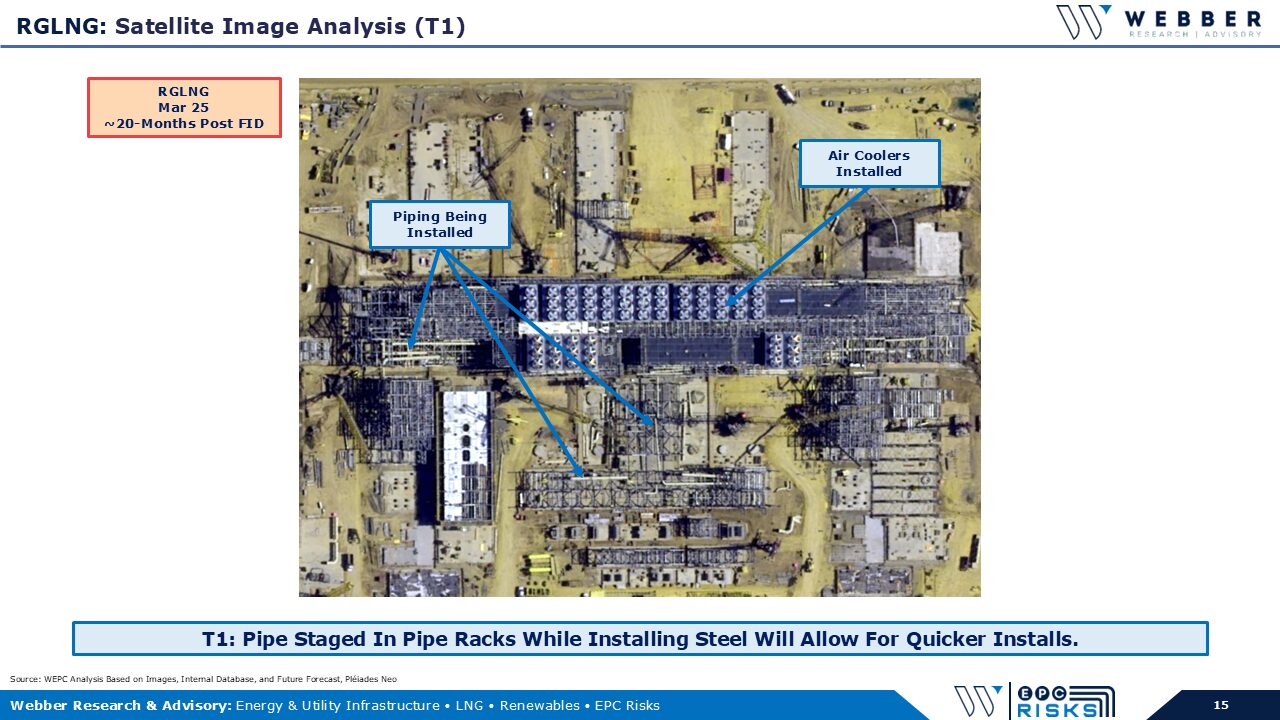

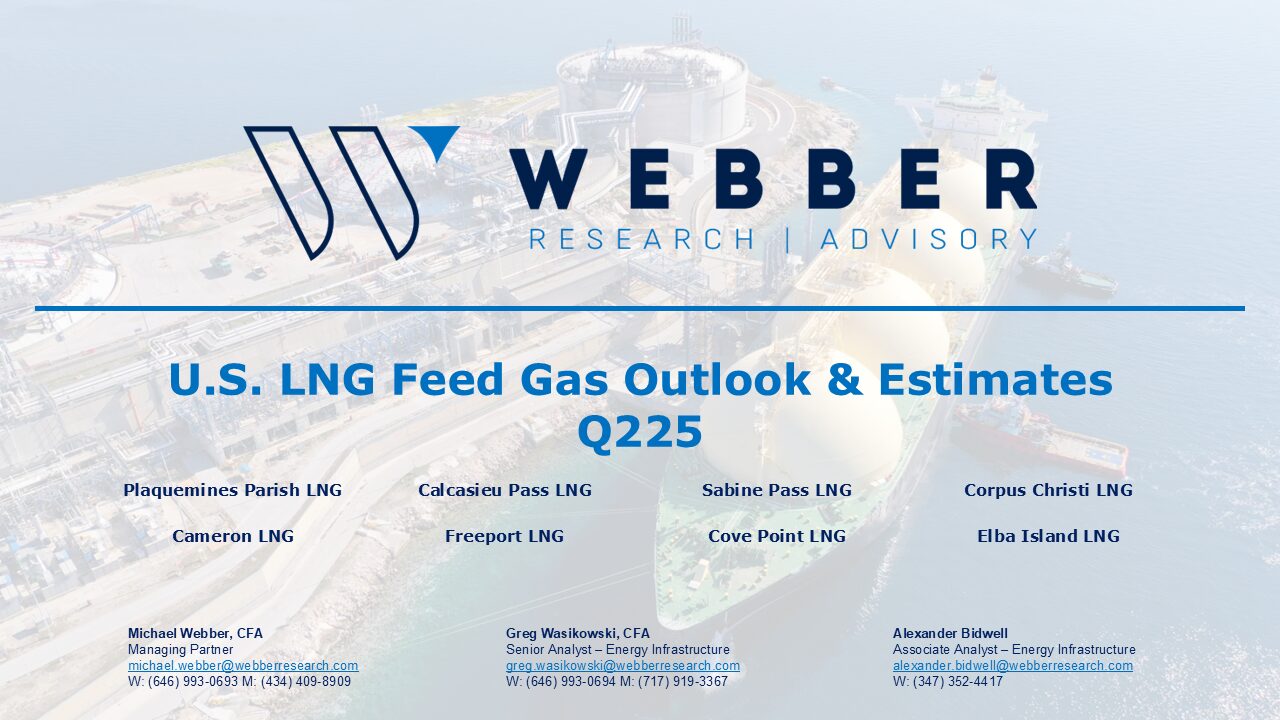
Webber Research: U.S. LNG Feed Gas Outlook & Estimates – Q225
If you’re already a Webber Research subscriber you can access this presentation via our Research Library. For access to the full report, visit our Downloads section, or contact us at [email protected] or [email protected] for subscription information.

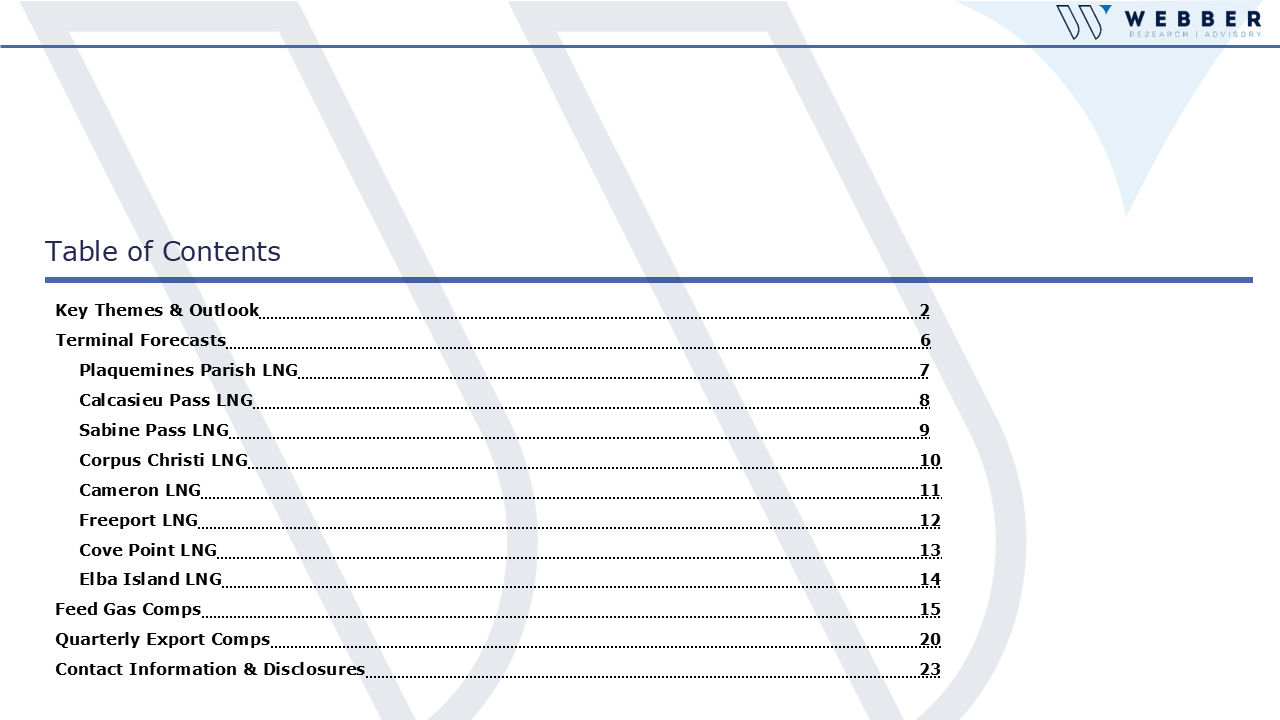
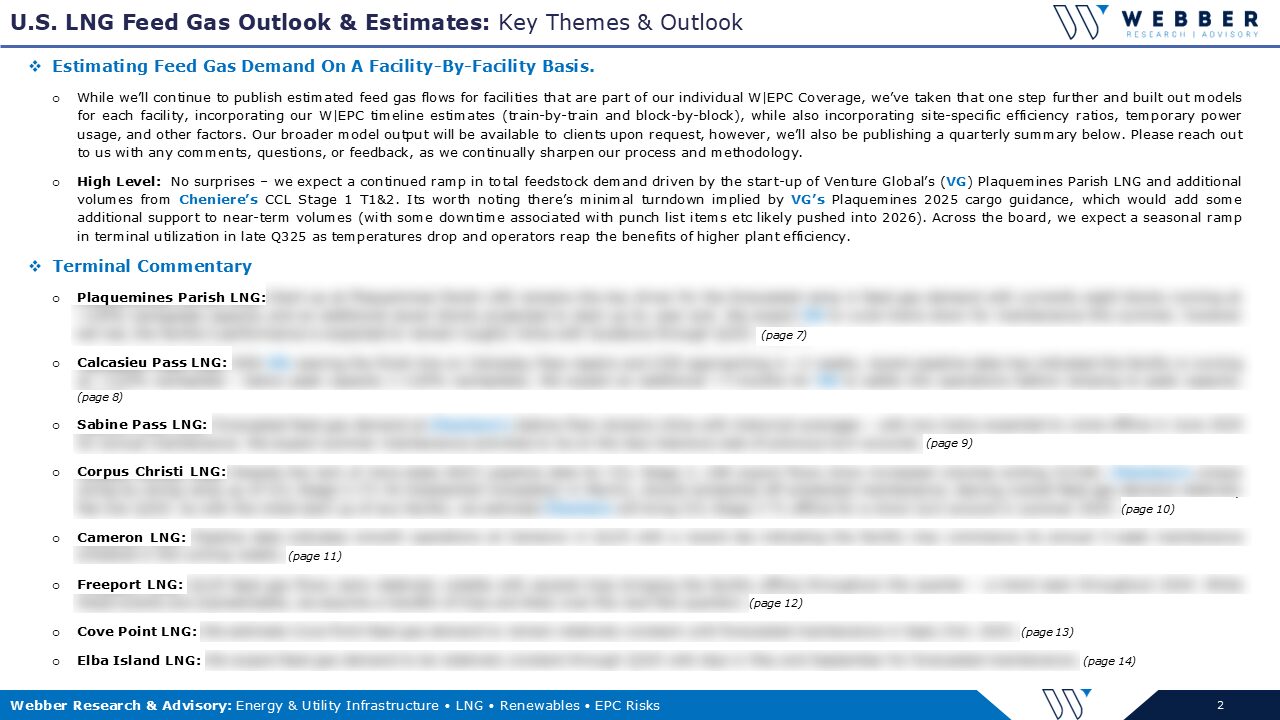
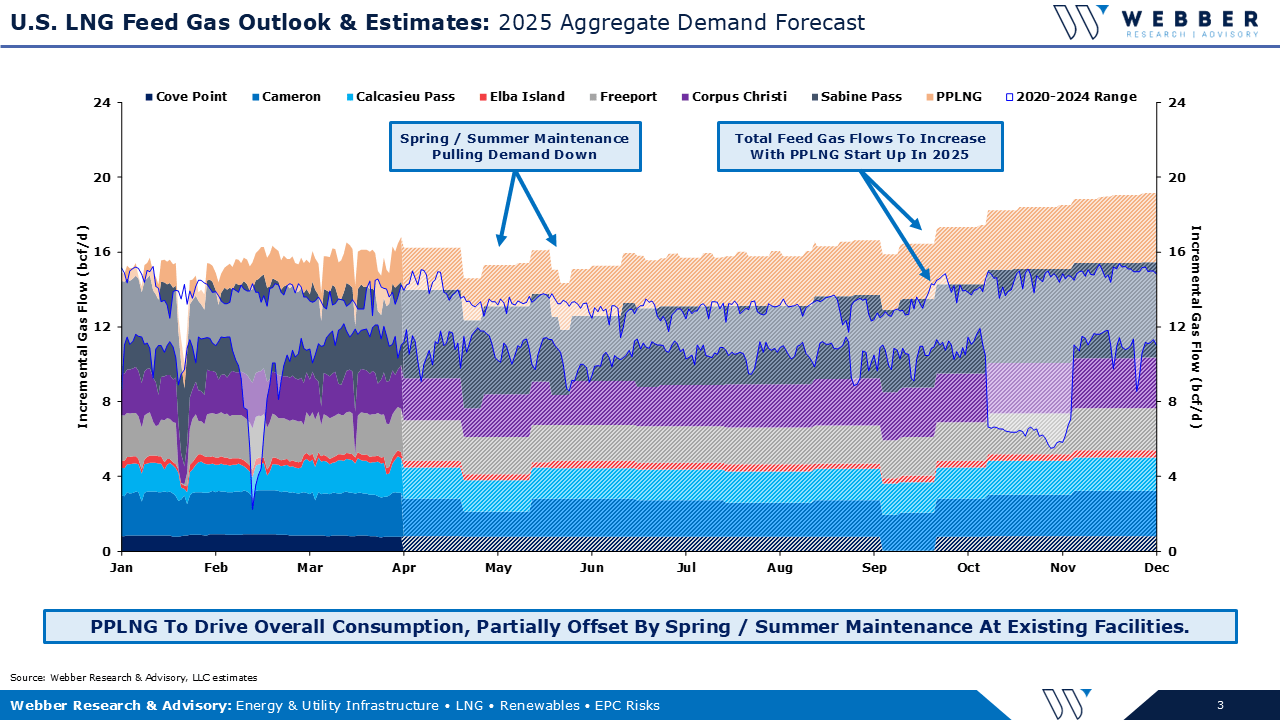
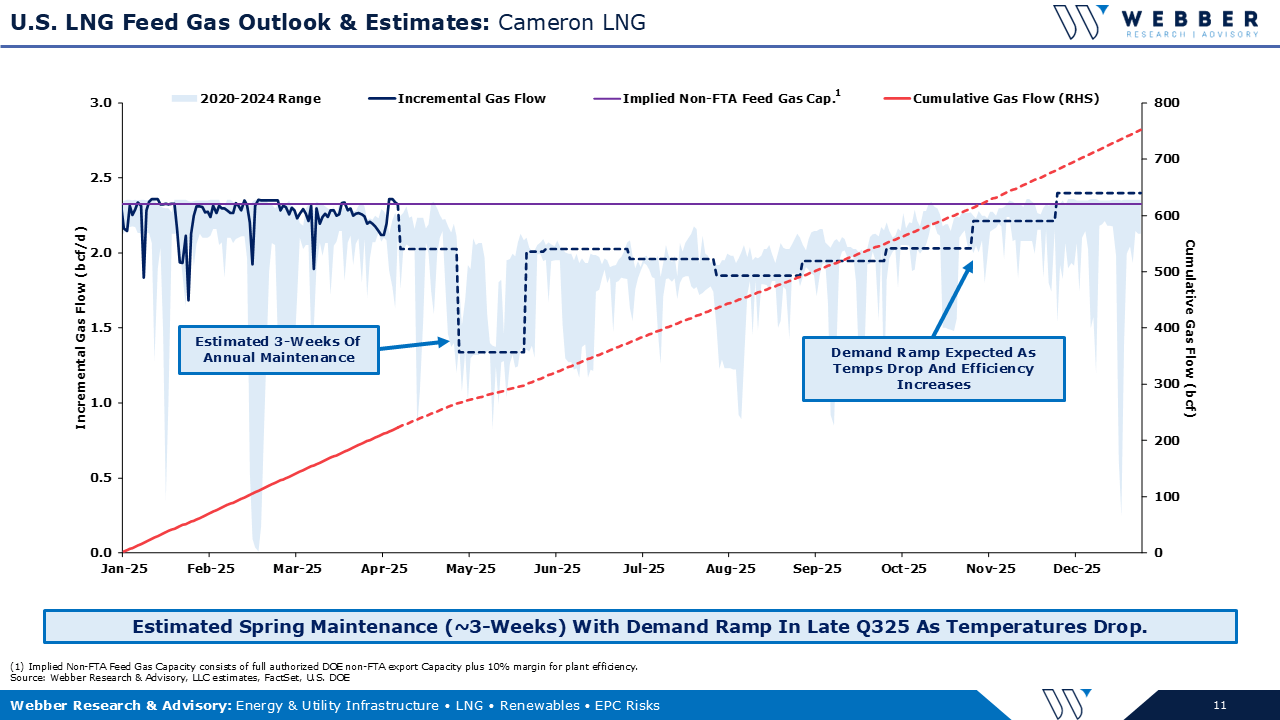
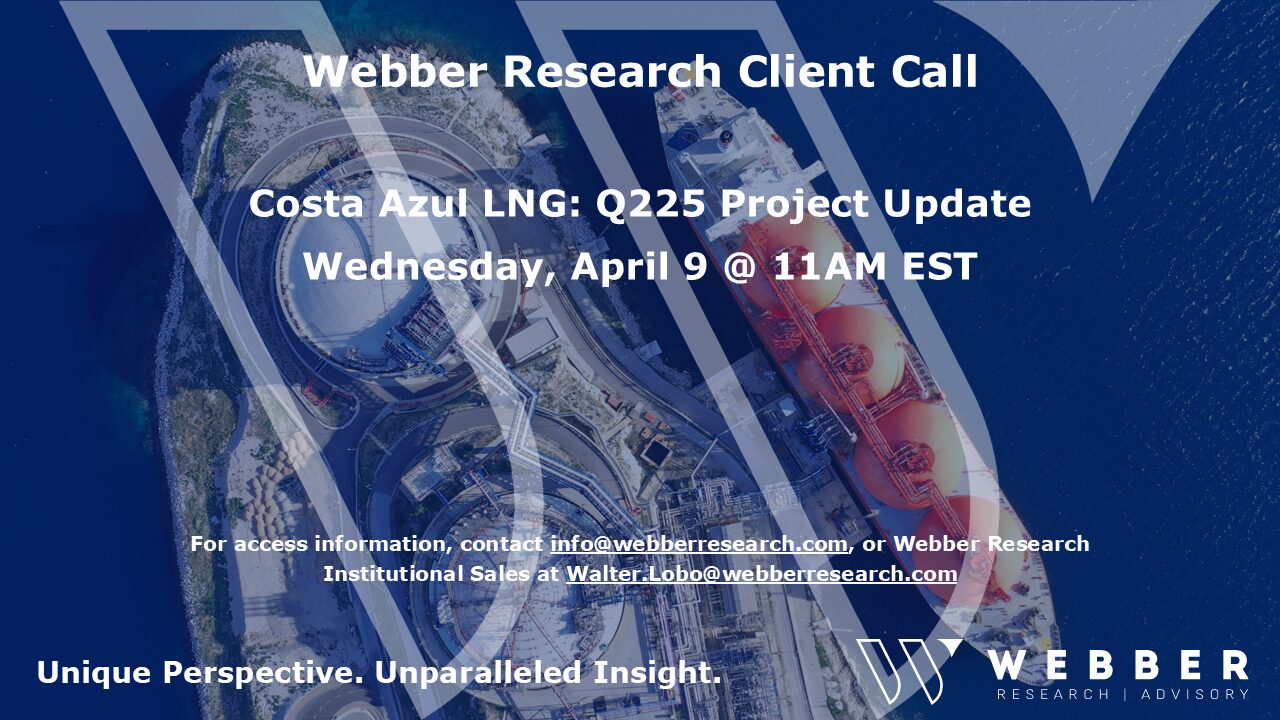

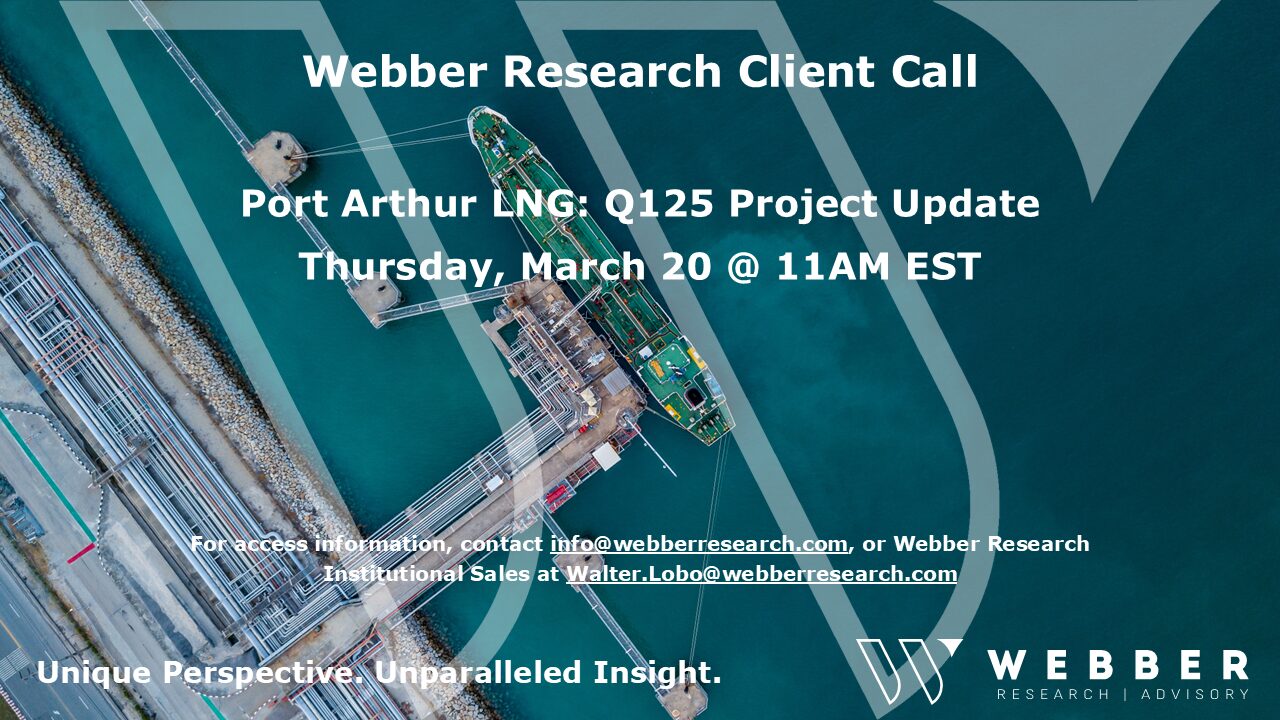
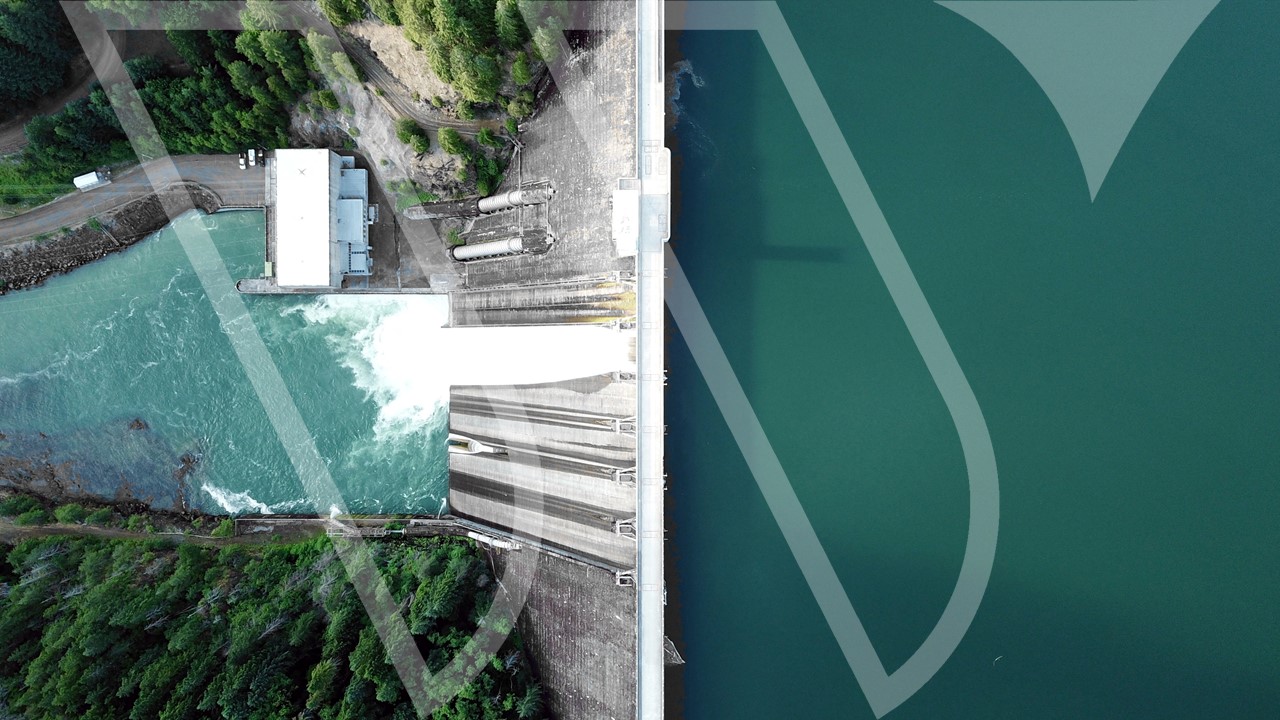
W|EPC: Plaquemines Parish LNG Interim Project Update: Q125
To access the full presentation, please visit our Research Library, or contact us at [email protected] or [email protected].


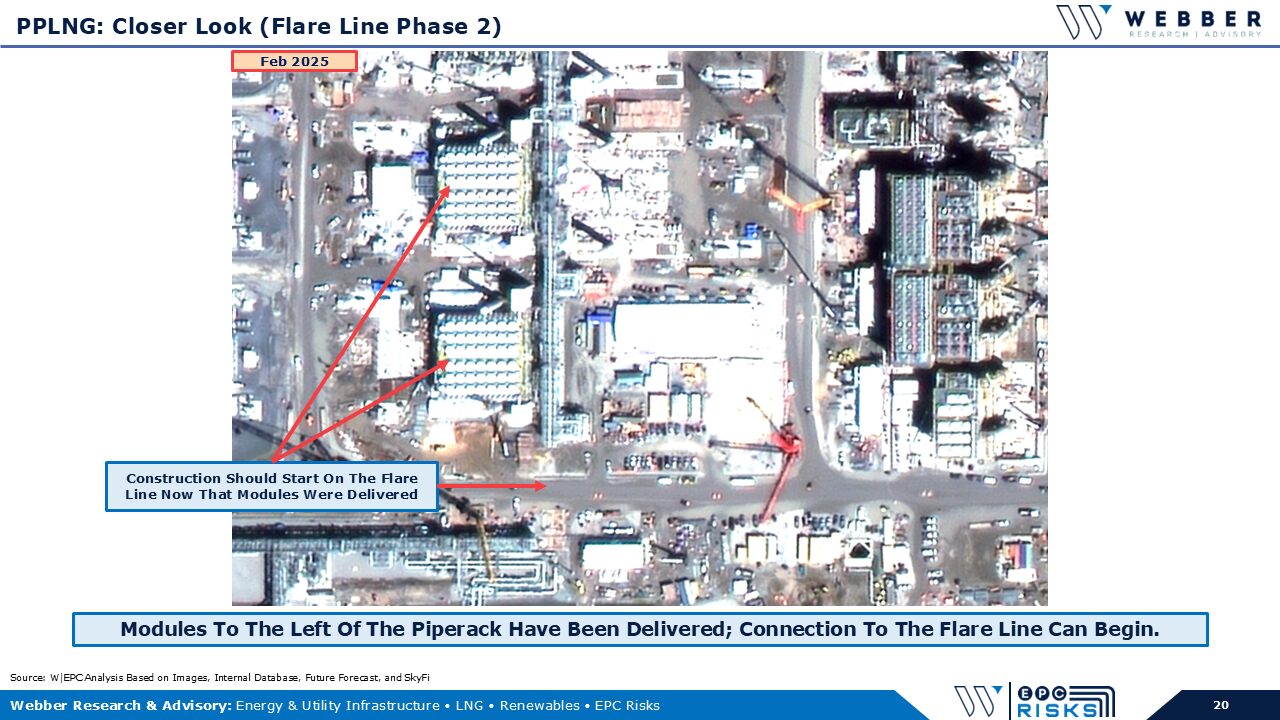
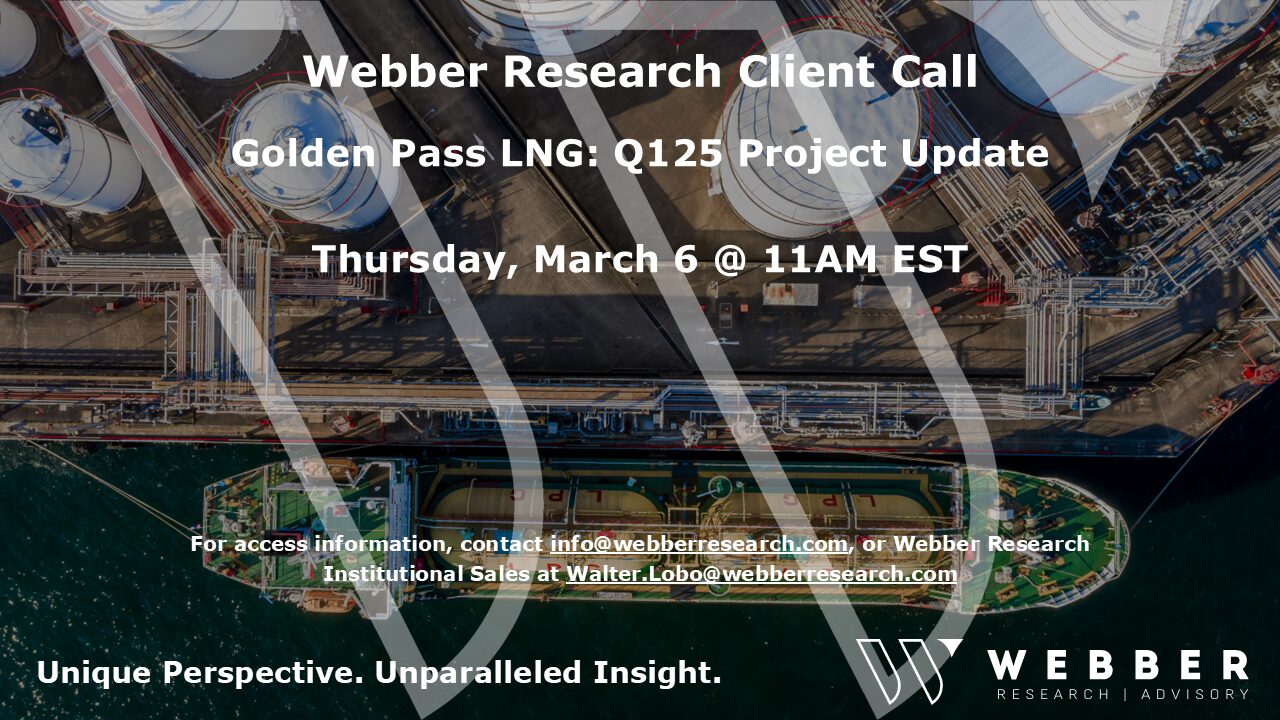
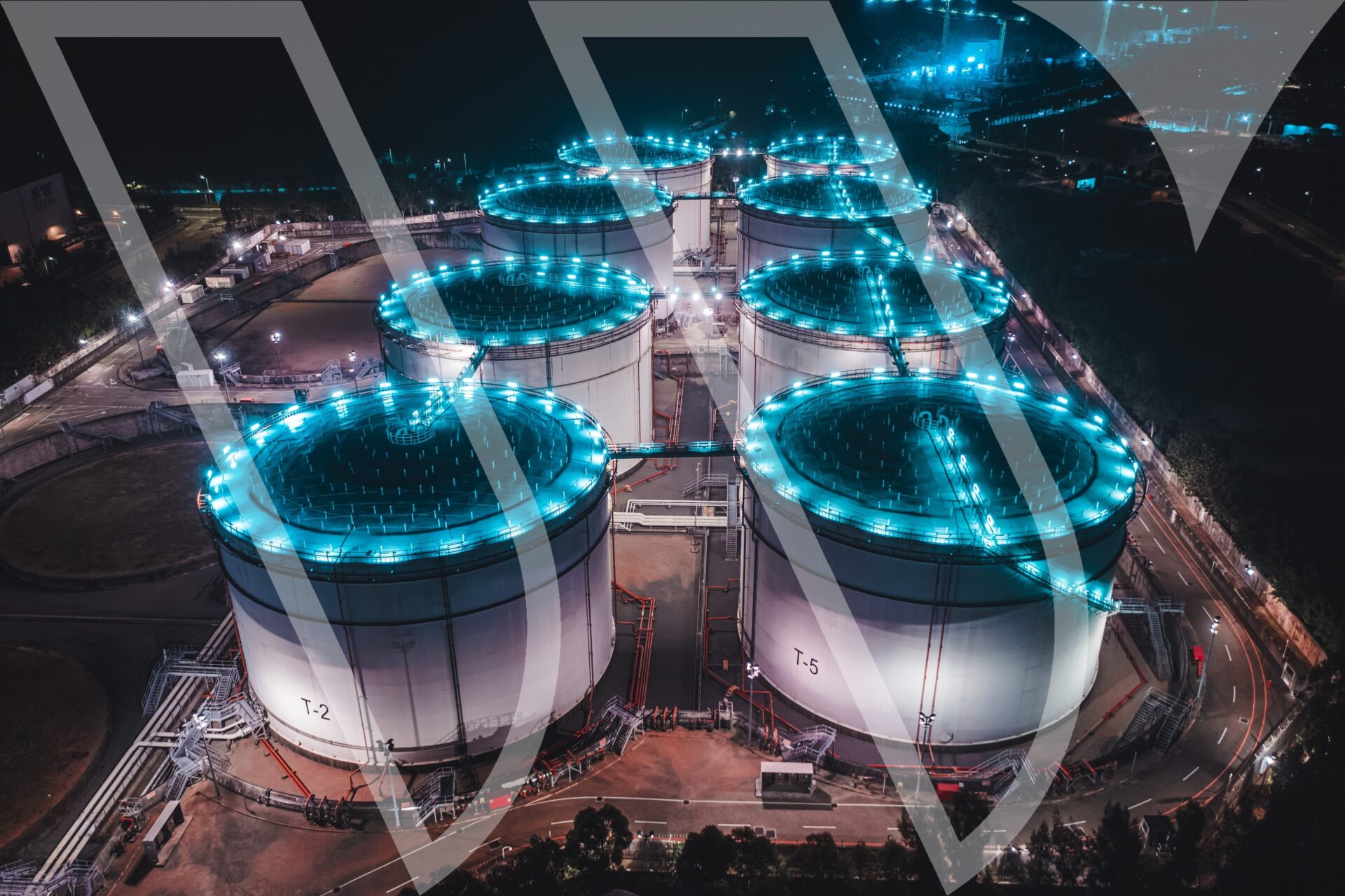
W|EPC: Golden Pass LNG Project Update – Q125
For the full deck, please visit our Downloads page. If you’re already a Webber Research subscriber, you can access this report via our Research Library. For access information please contact us at [email protected], or [email protected].
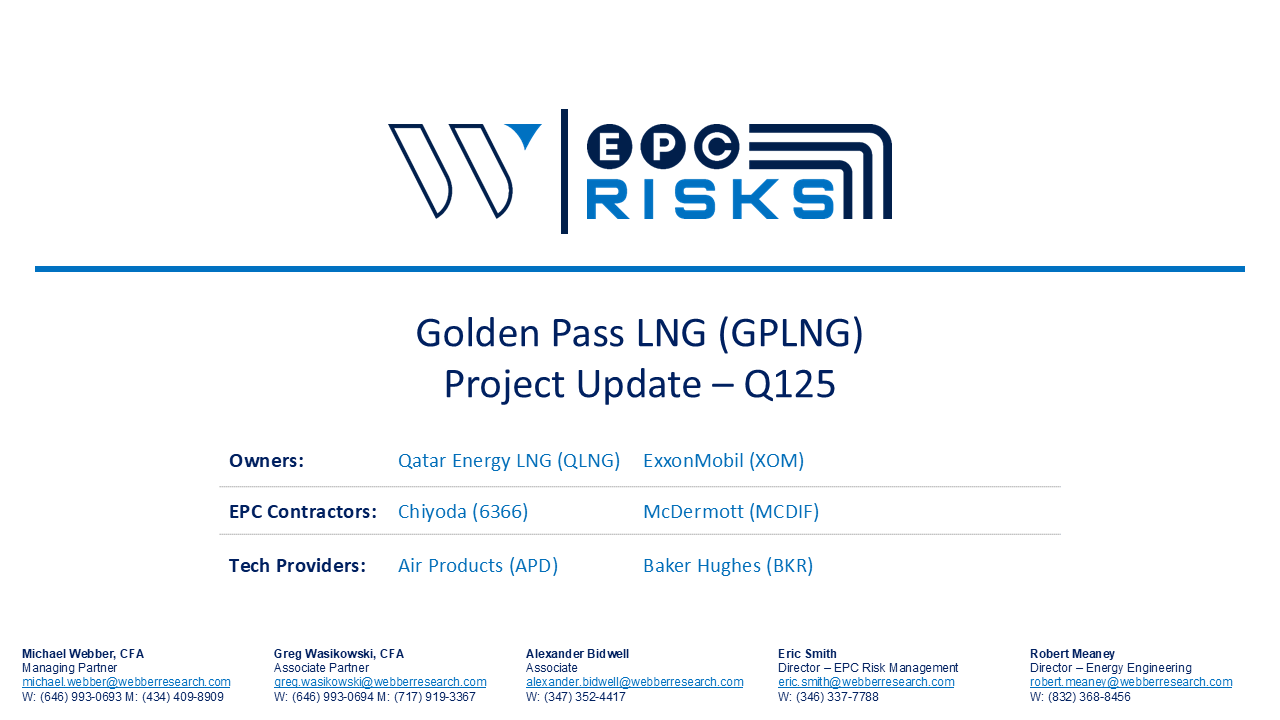
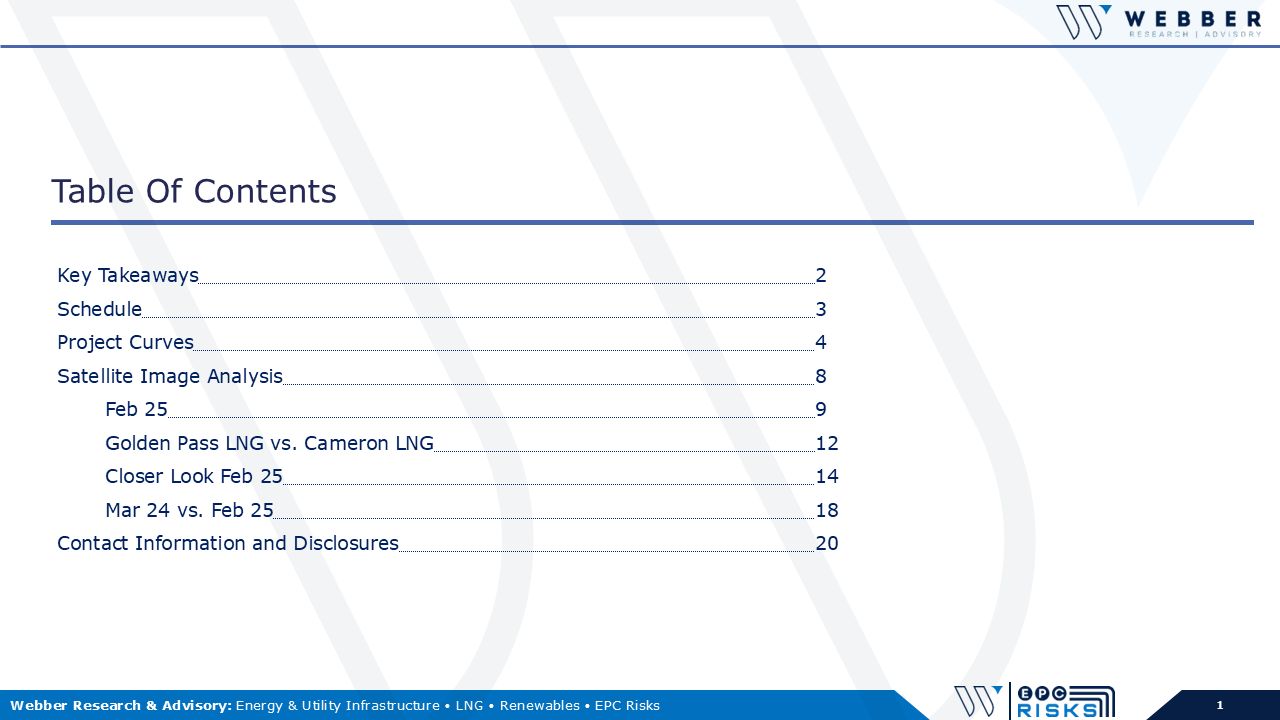

Read More
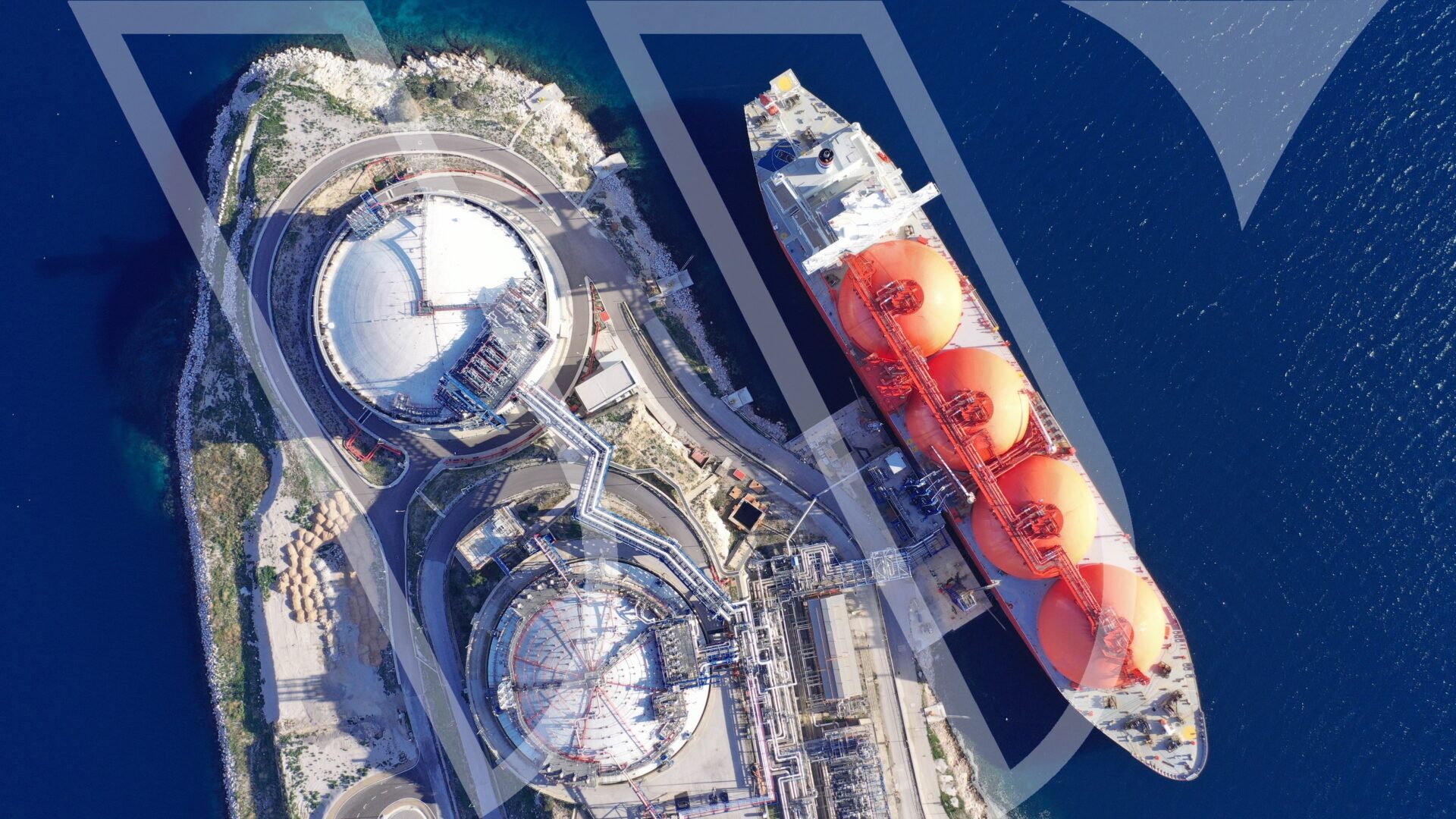
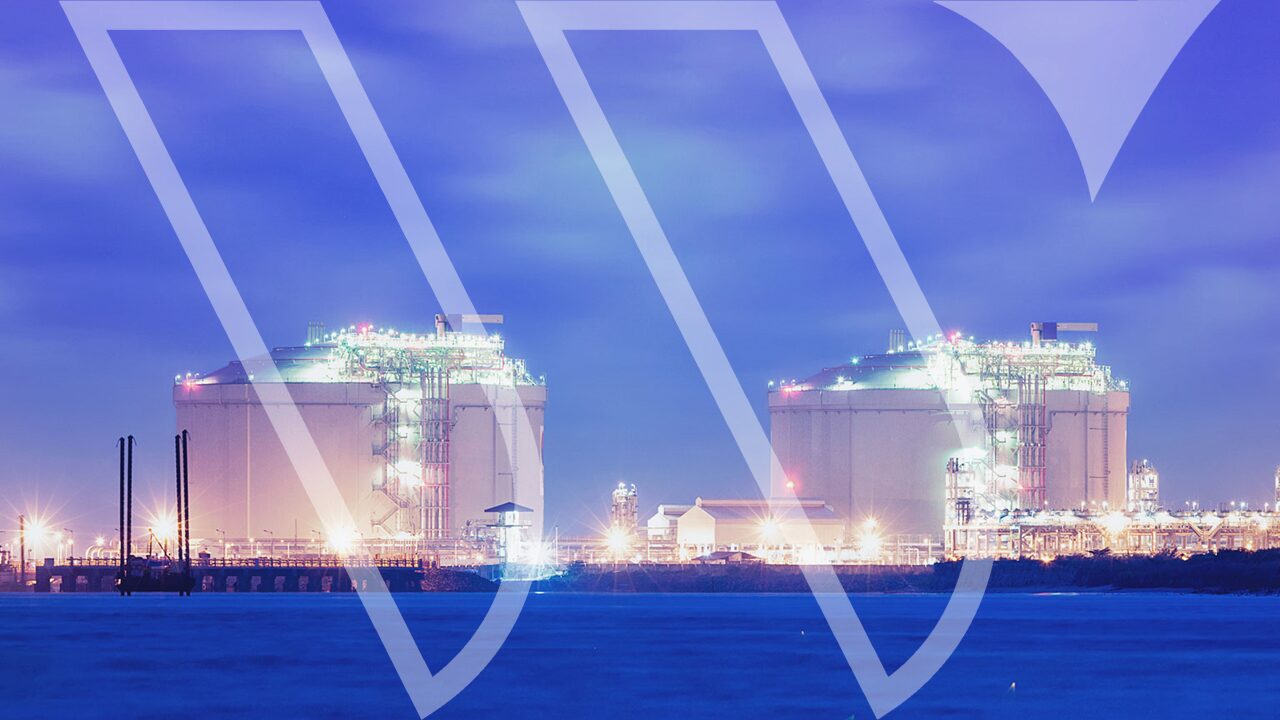
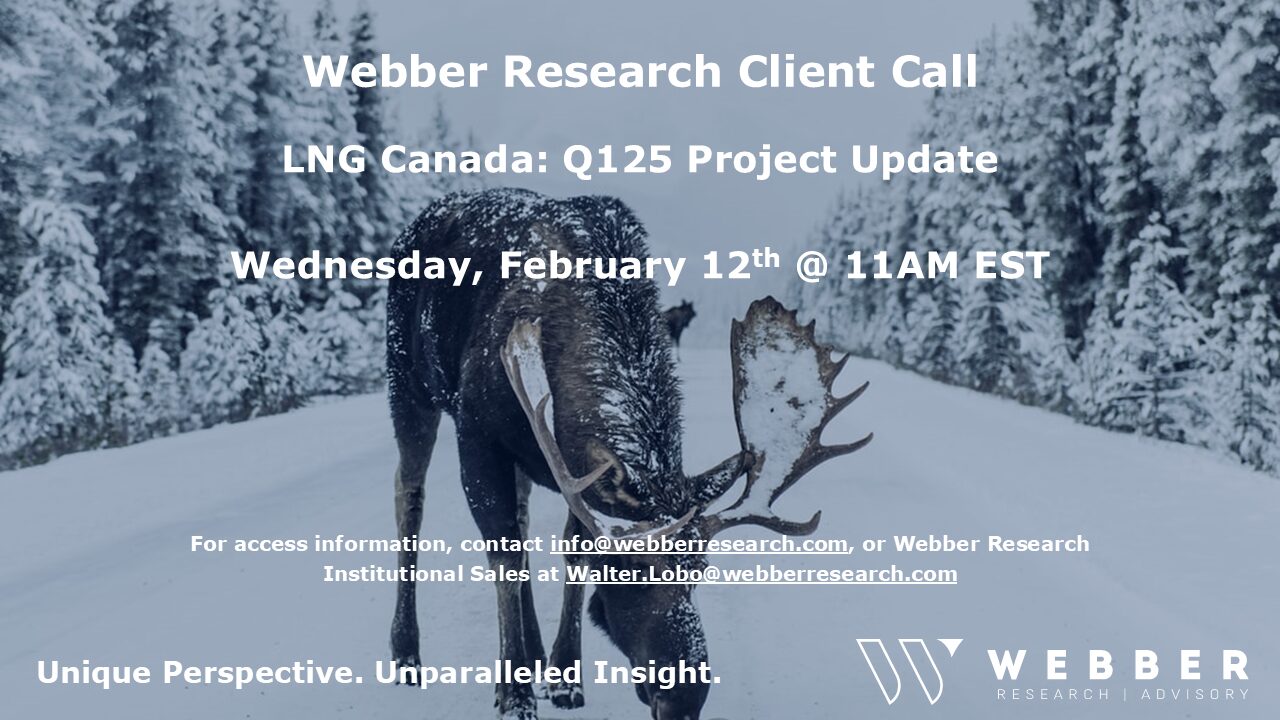
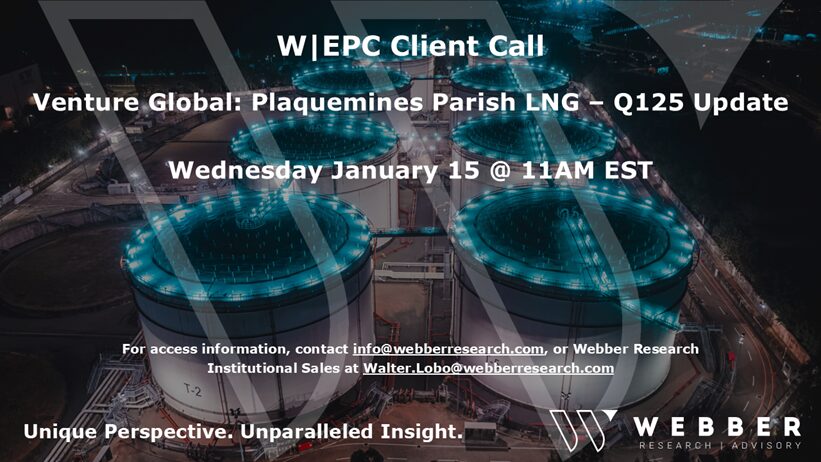
W|EPC: Client Call 01/15 @11AM – Venture Global’s Plaquemines Parish – Q125 Project Review


W|EPC: Venture Global’s Plaquemines Parish LNG – Q125 Project Review
If you’re already a Webber Research client, you can access this via our Library. If you’re not yet a Webber Research client, you can access the full report on our Downloads page, or contact us for access information at [email protected] or [email protected].
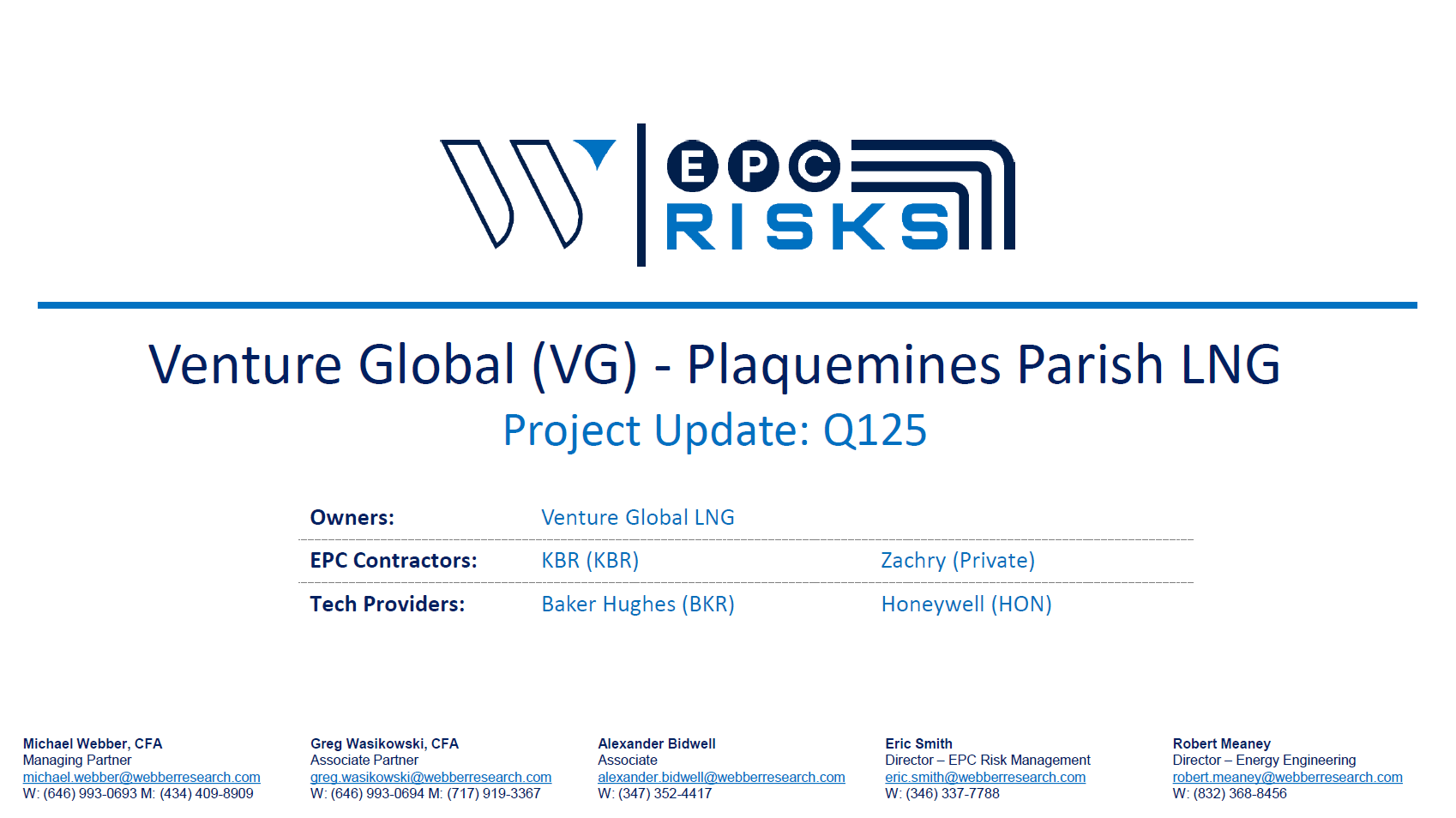
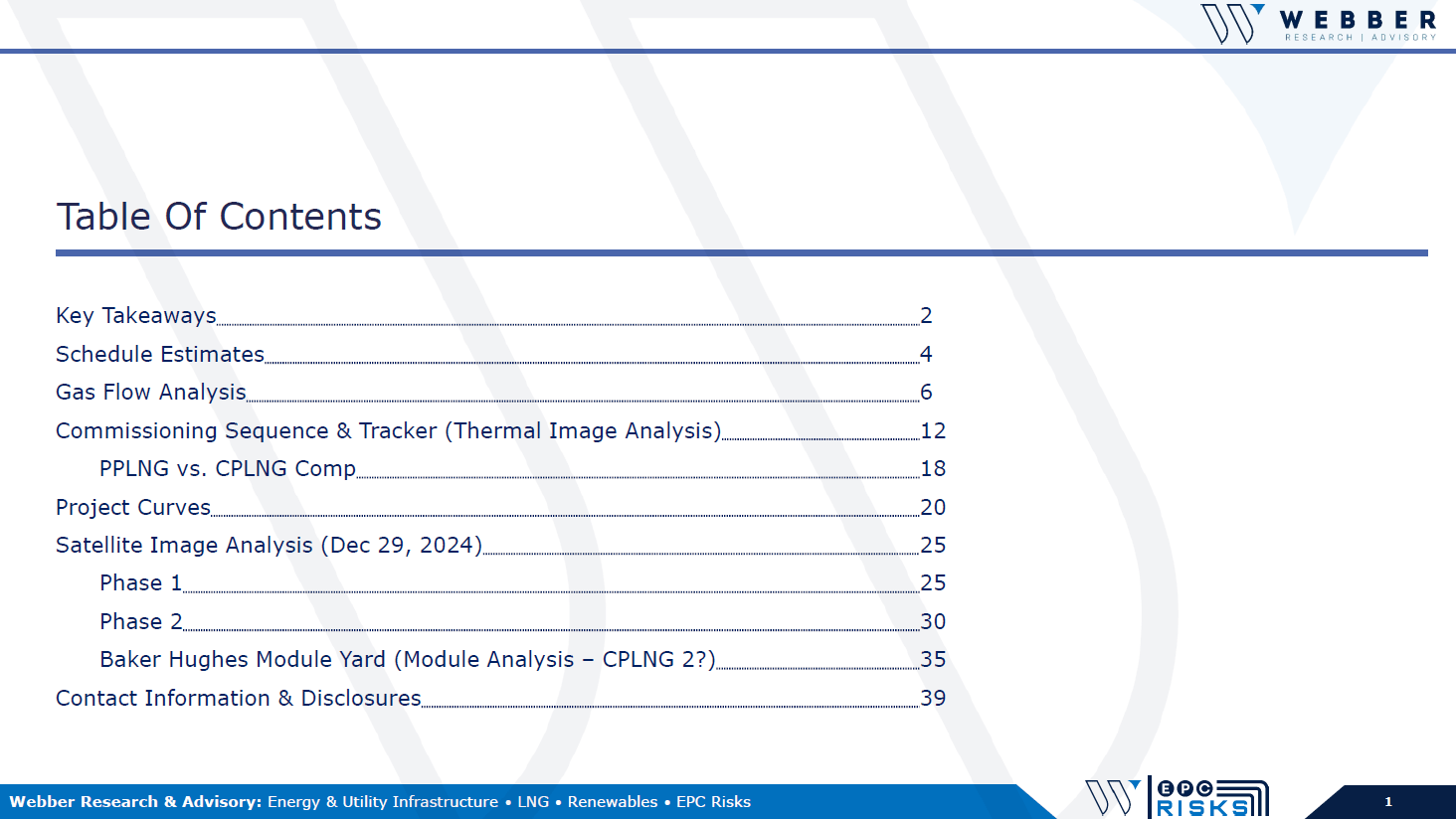
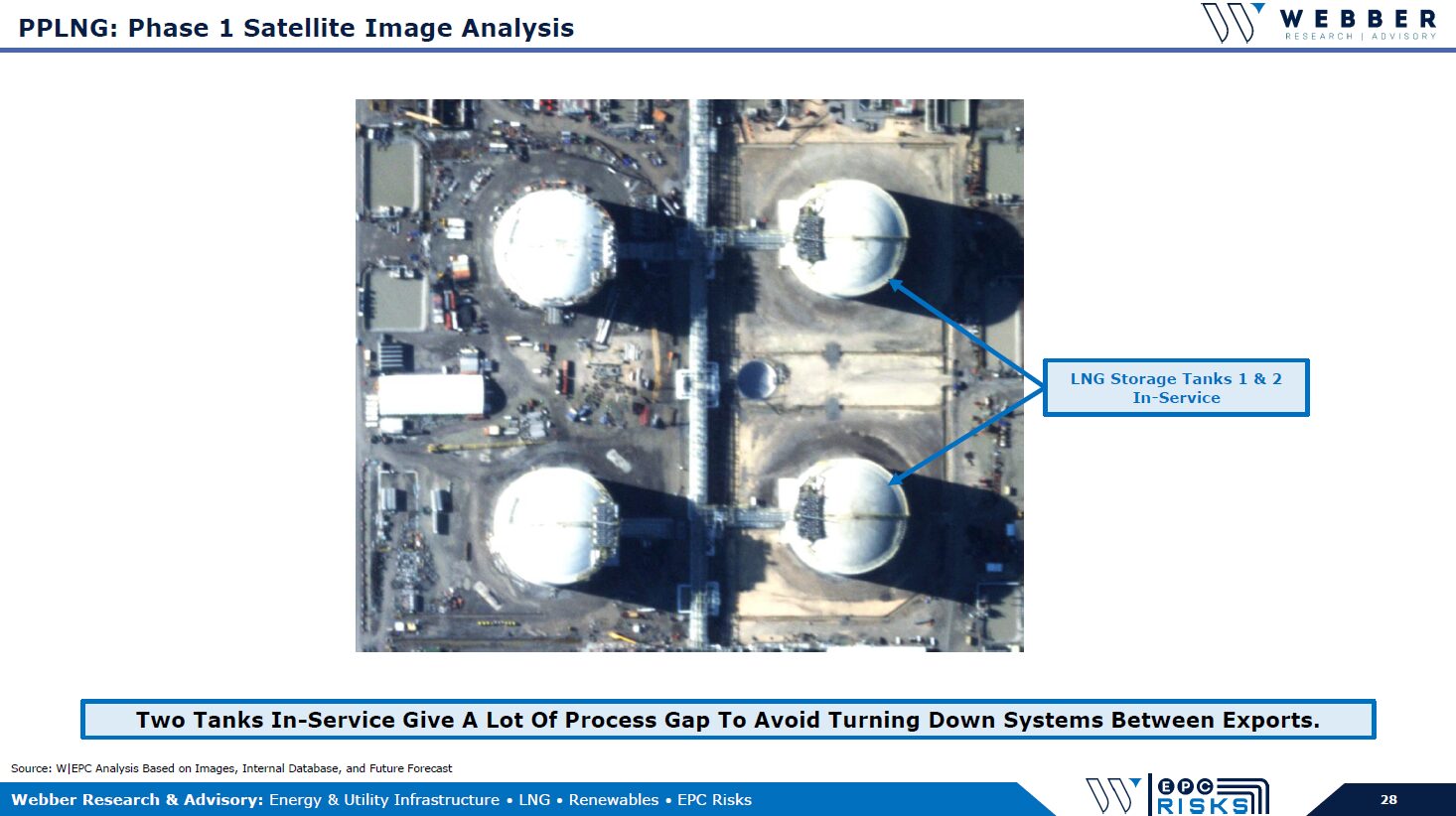
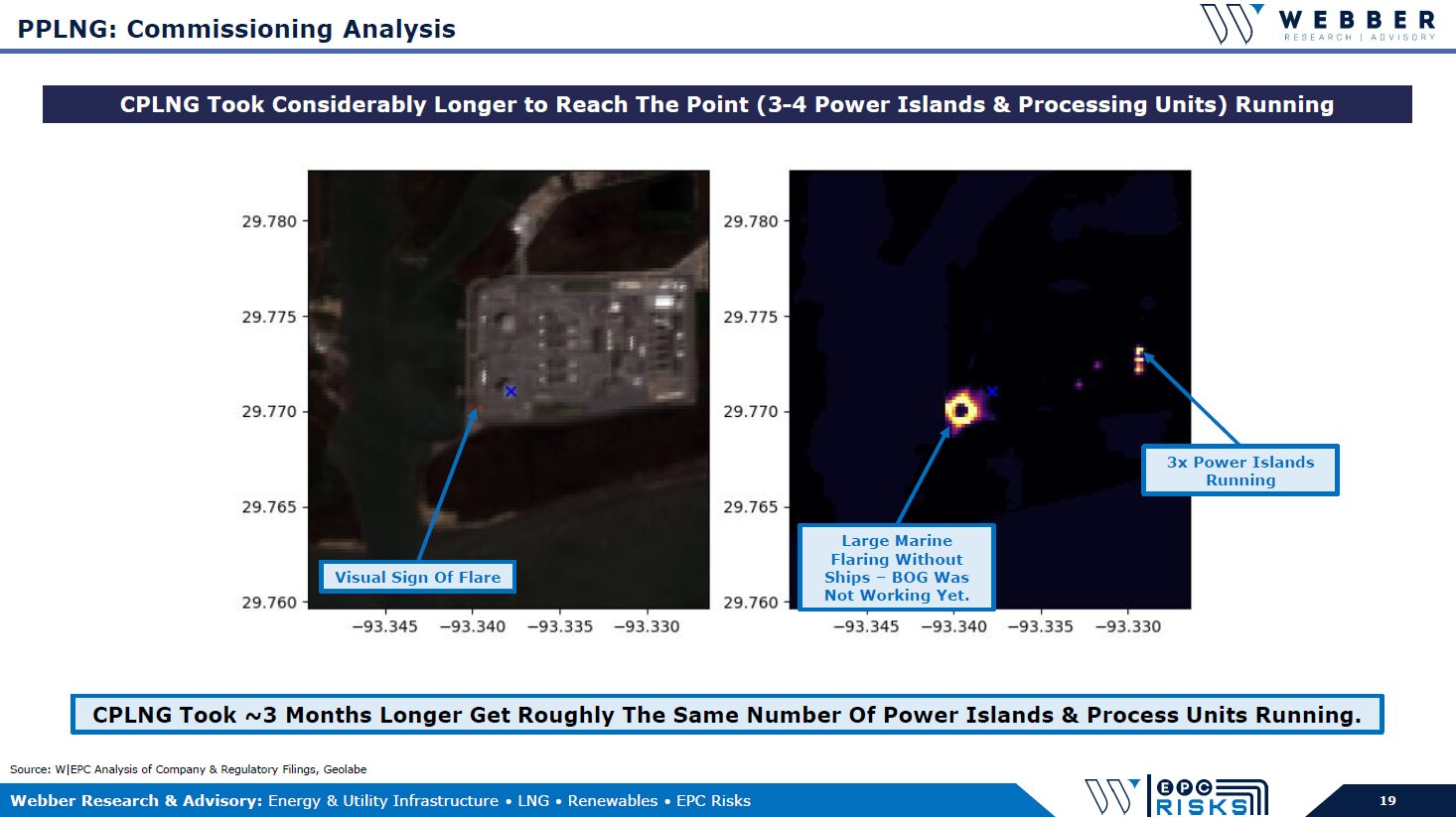
Read More
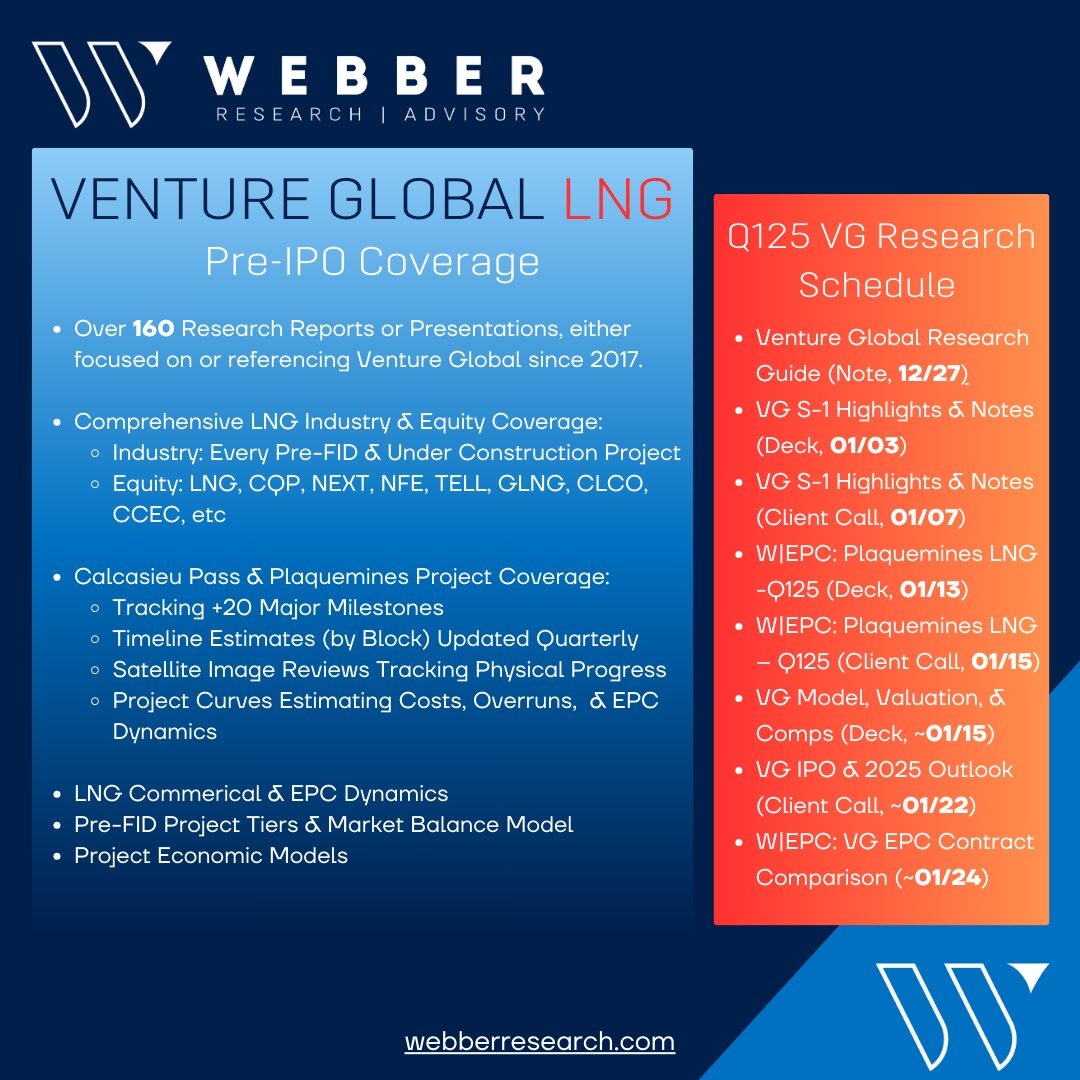
Venture Global IPO Coverage
Read More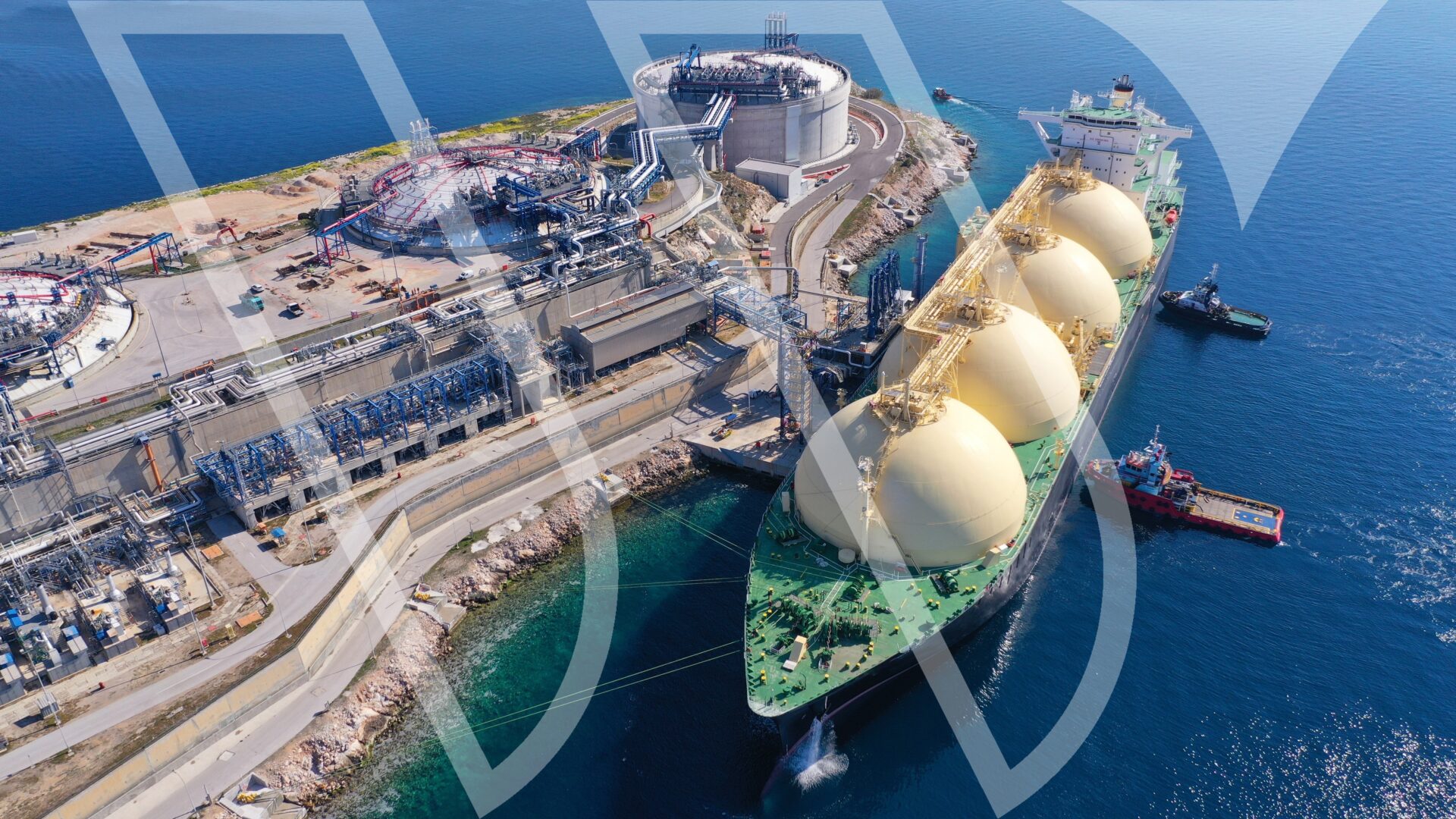
W|EPC: Costa Azul LNG – Q424 Project Review
If you’re already a Webber Research client, you can access this report via our Research Library. For access information, please contact us at [email protected] or [email protected]. For the full report, please visit our Downloads page.
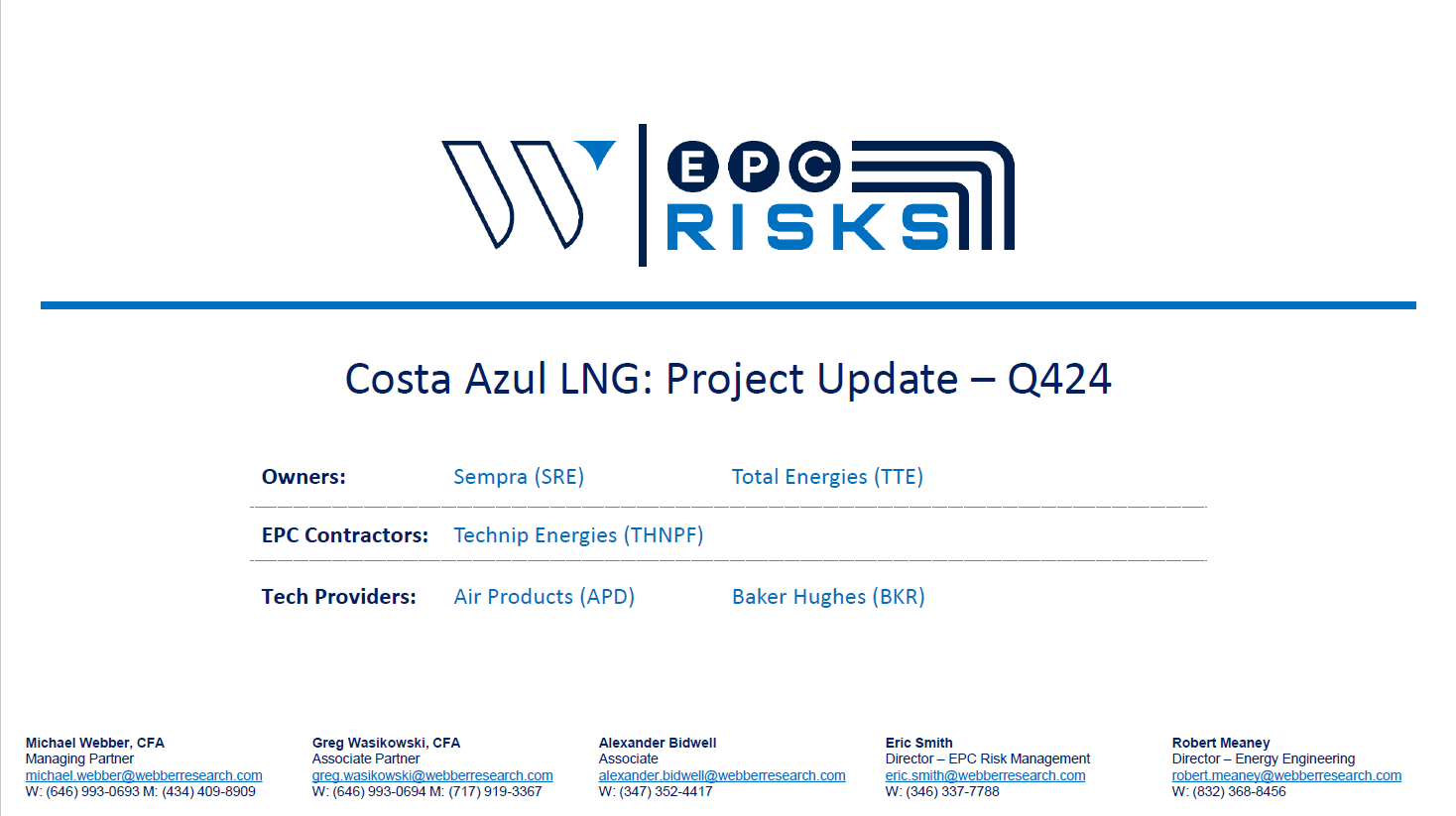
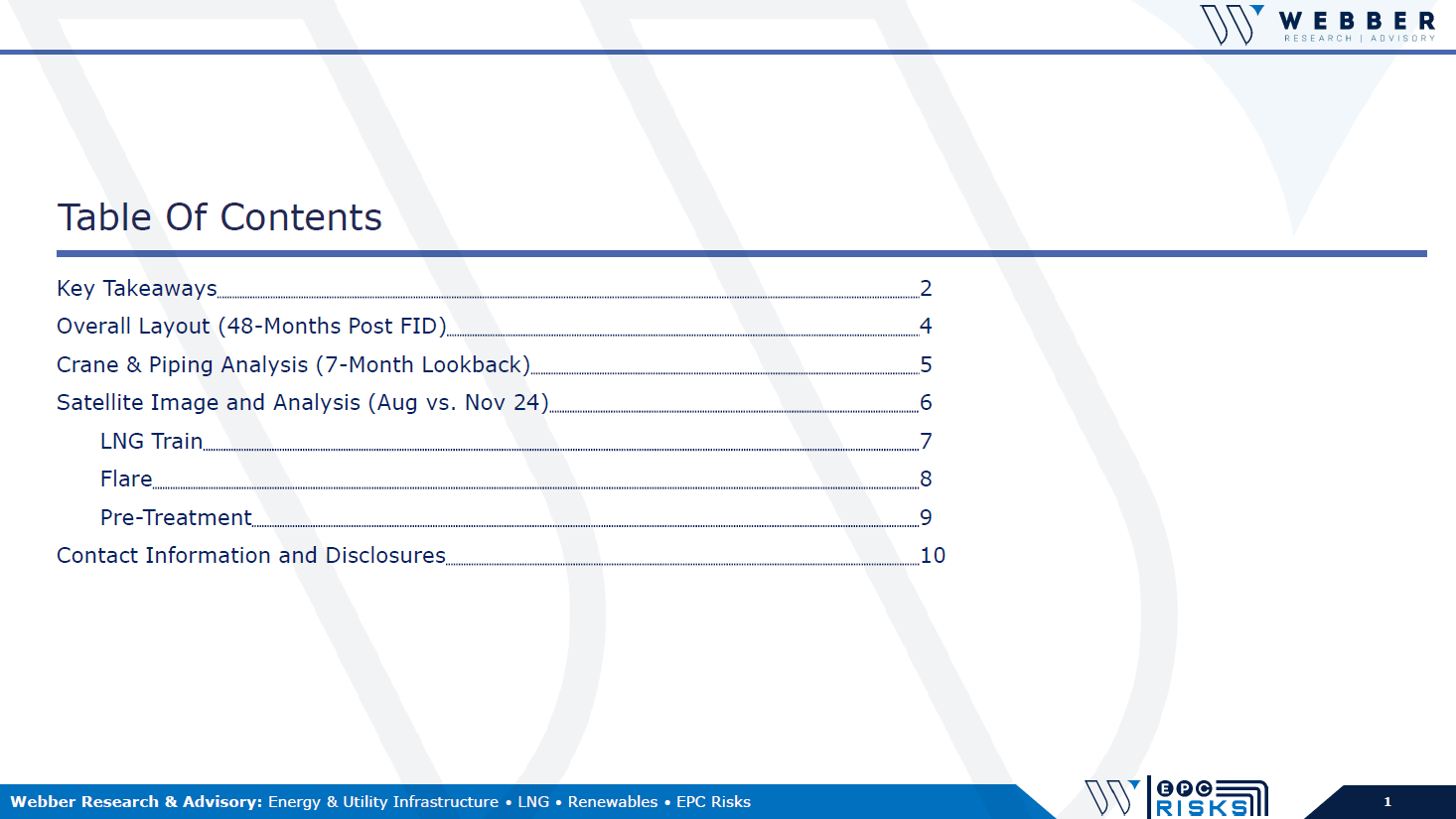
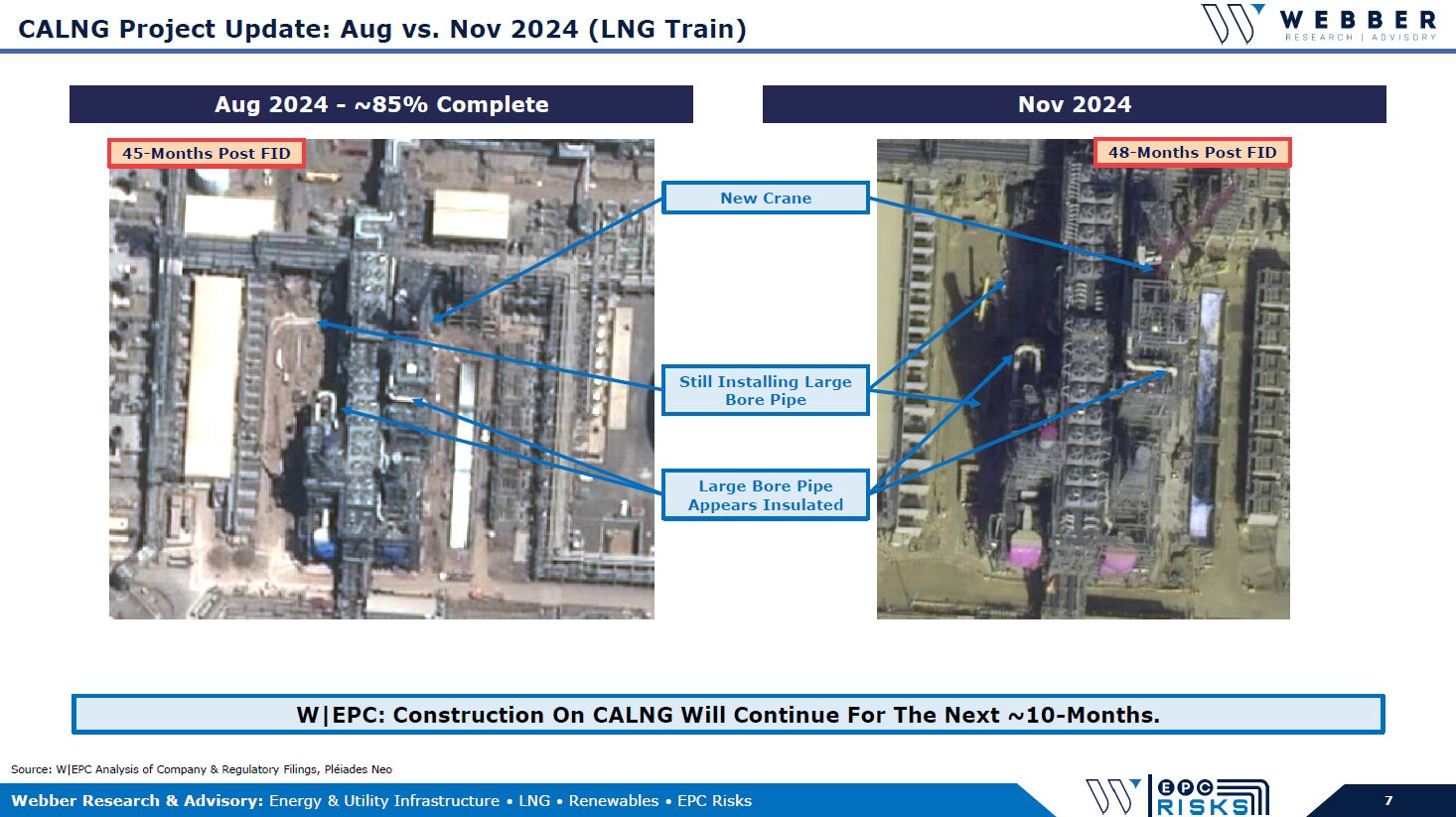
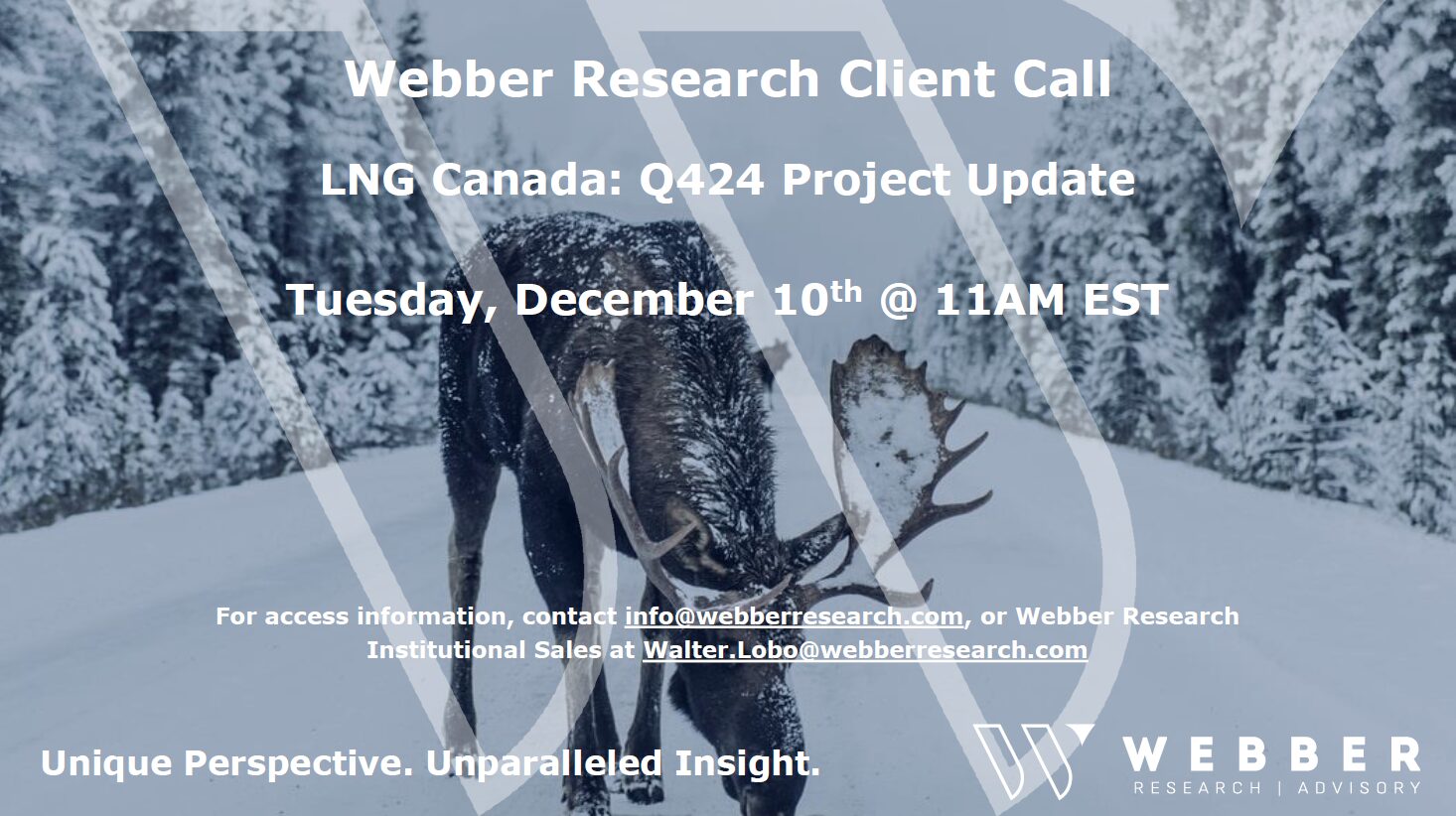
W|EPC: LNG Canada Project Update – Q424
If you’re already a Webber Research client, you can access the full report in our Research Library. If you’re not yet a Webber Research subscriber, please contact us at [email protected] or at [email protected].
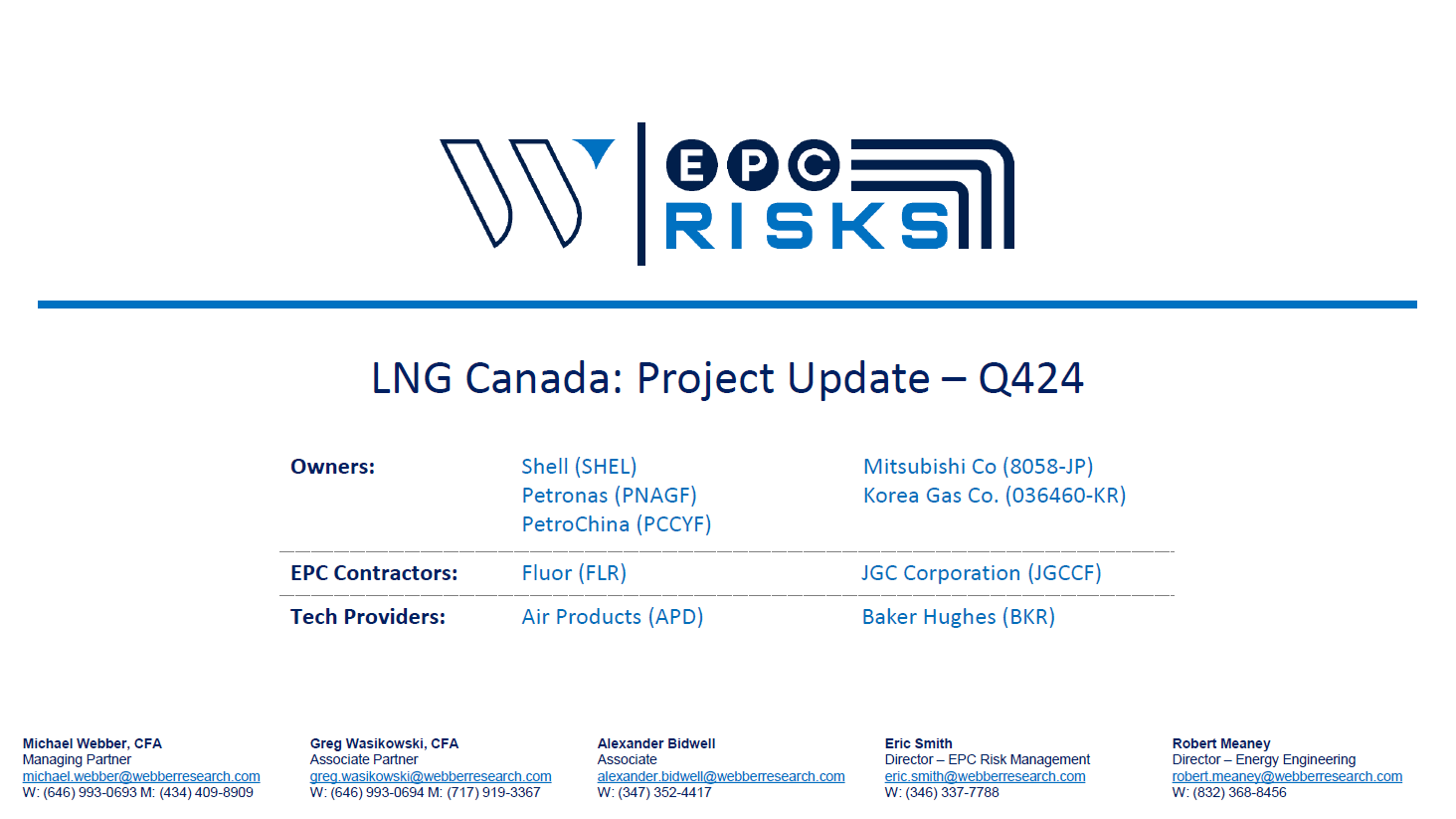
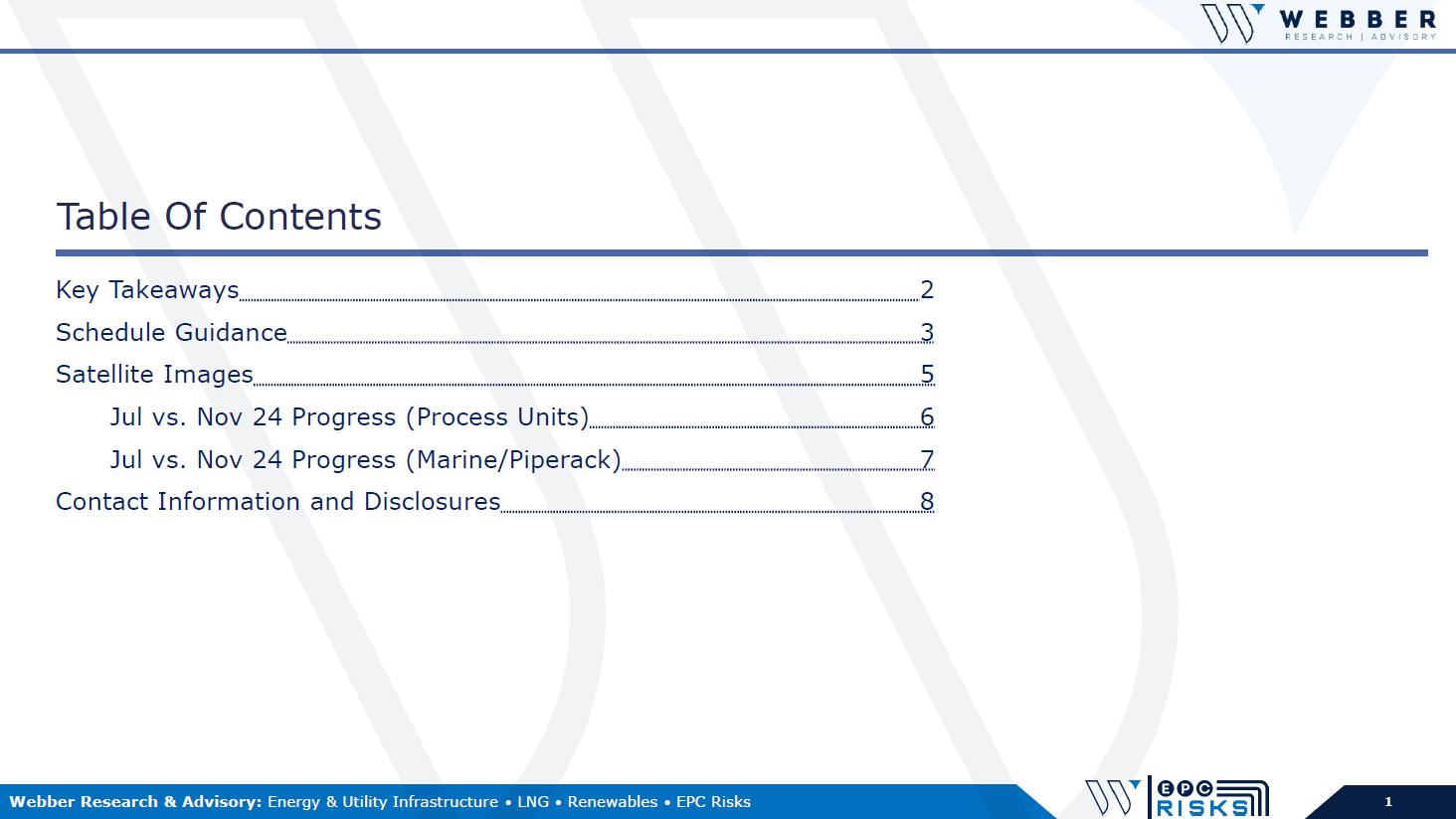


W|EPC: Qatar LNG North Field Expansion (NFE) East – Q424 Project Update
If you’re already a Webber Research client, you can access this report via our Research Library. For access information, email us at [email protected], or at [email protected].
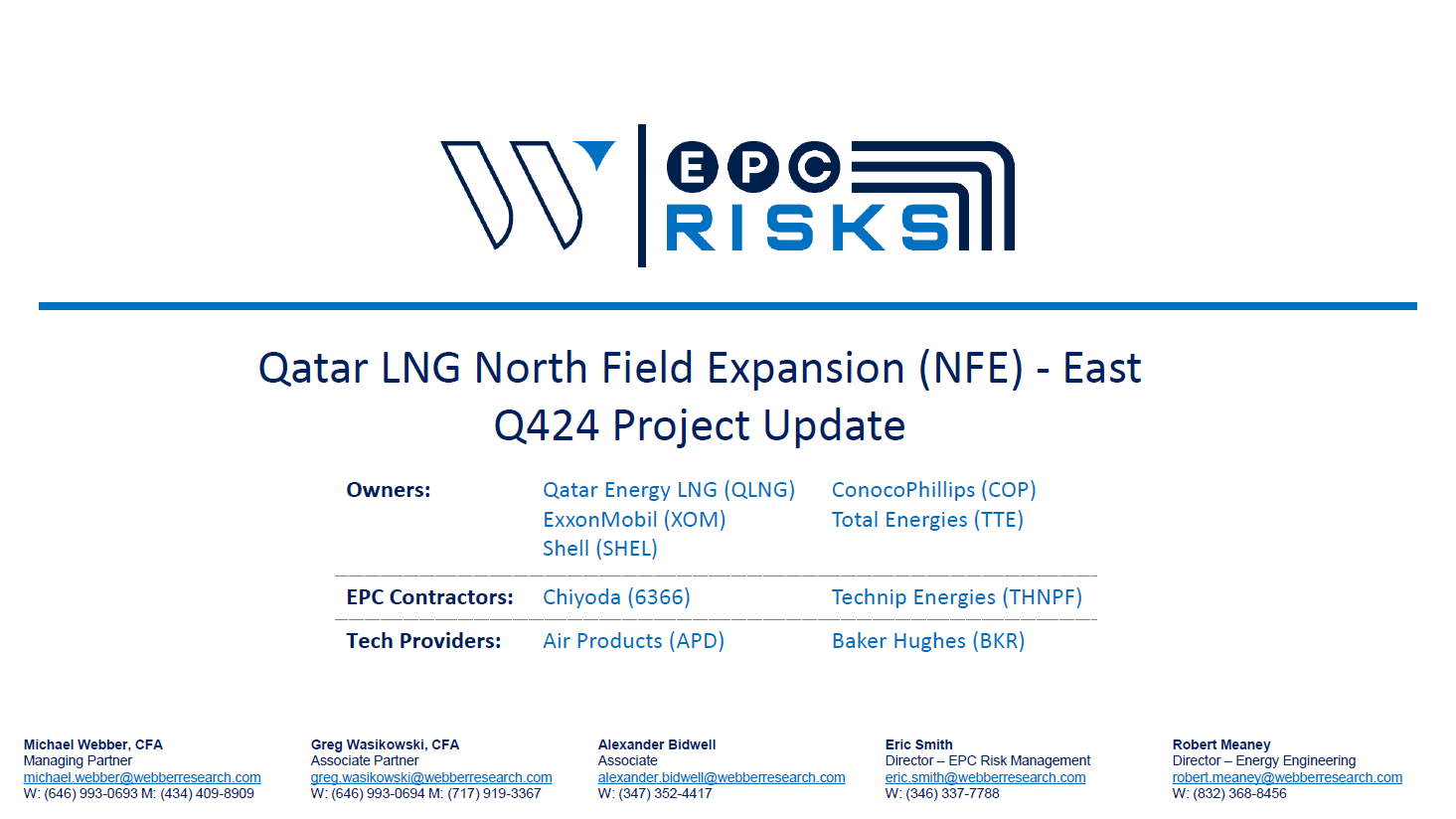
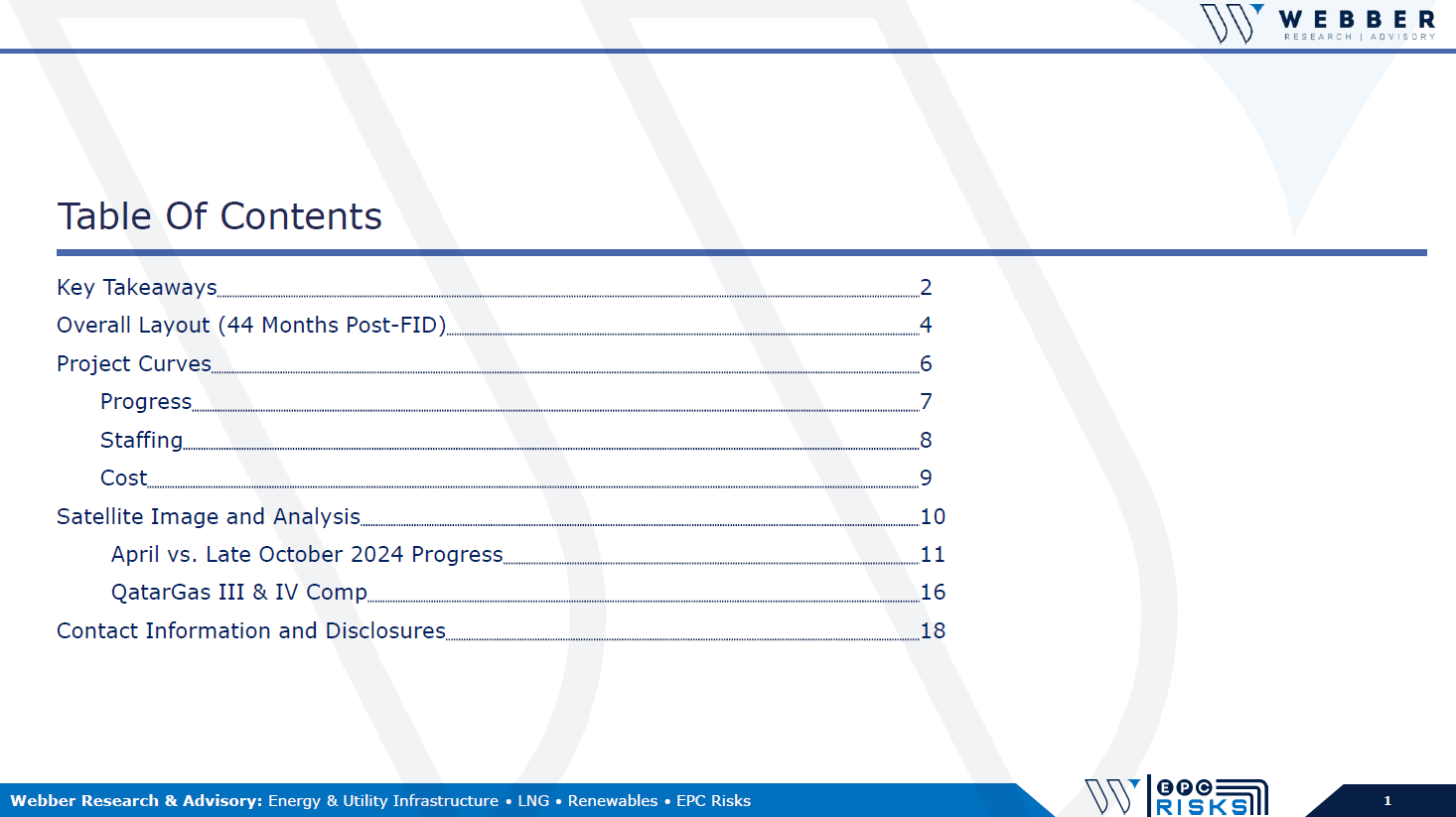
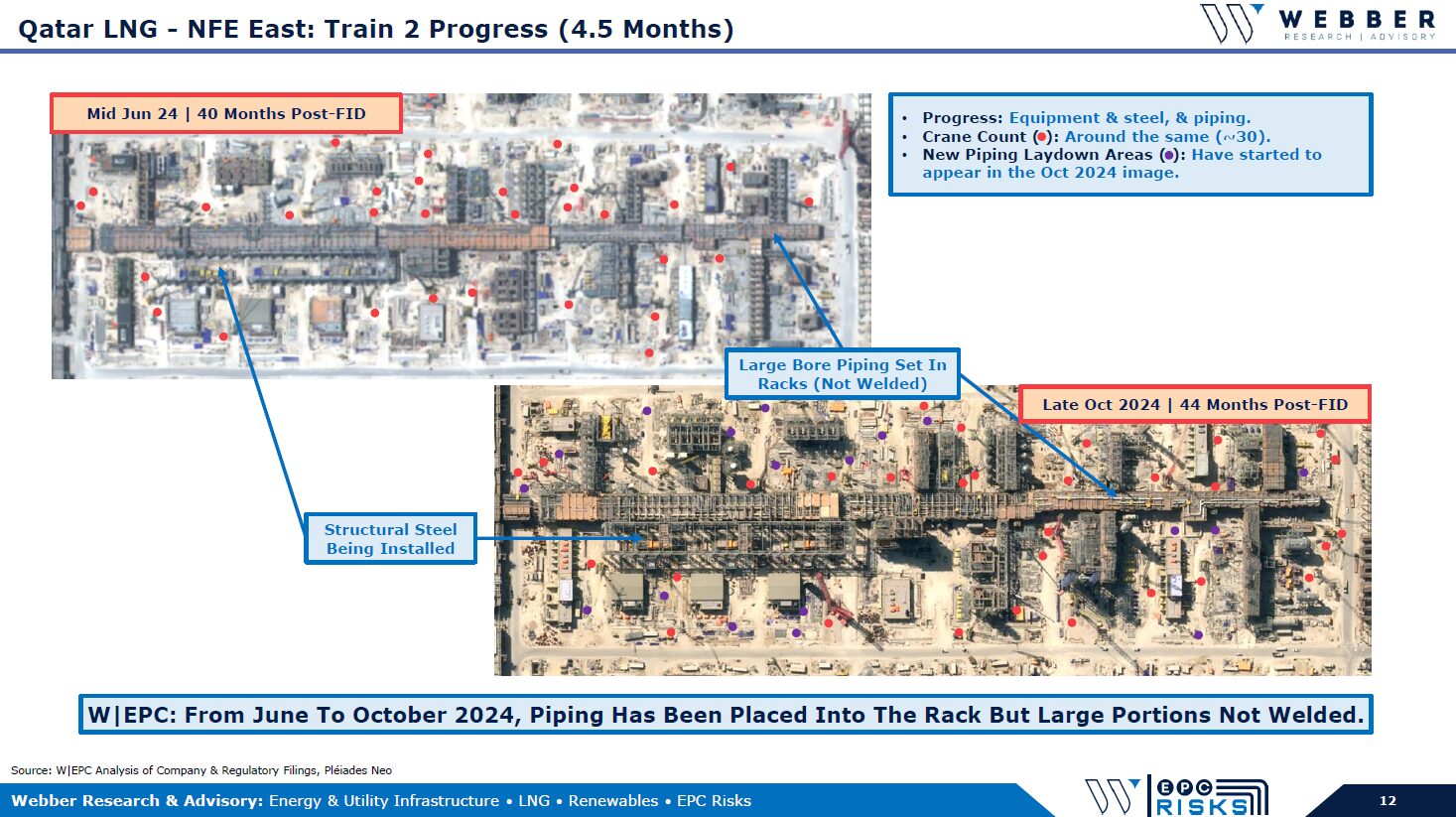
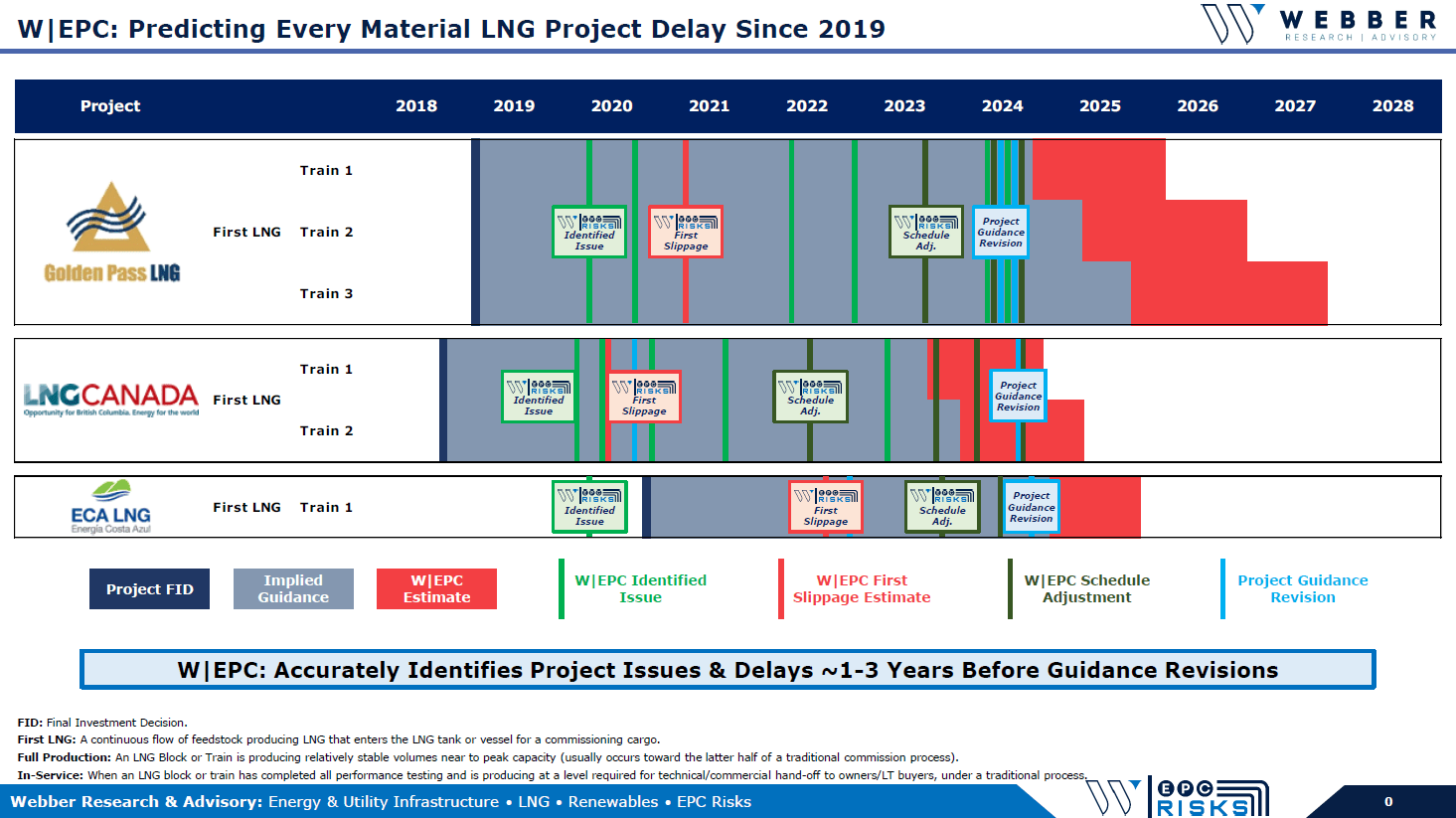
W|EPC: Predicting Every Material LNG Project Delay Since 2019
For access information please contact us at [email protected] or [email protected].
Read More
W|EPC: Corpus Christi LNG Project Update – Q424
If you’re already a Webber Research subscriber, you can access this report via our Research Library. To access the full report, please visit our Downloads page, or contact us at [email protected] or [email protected].
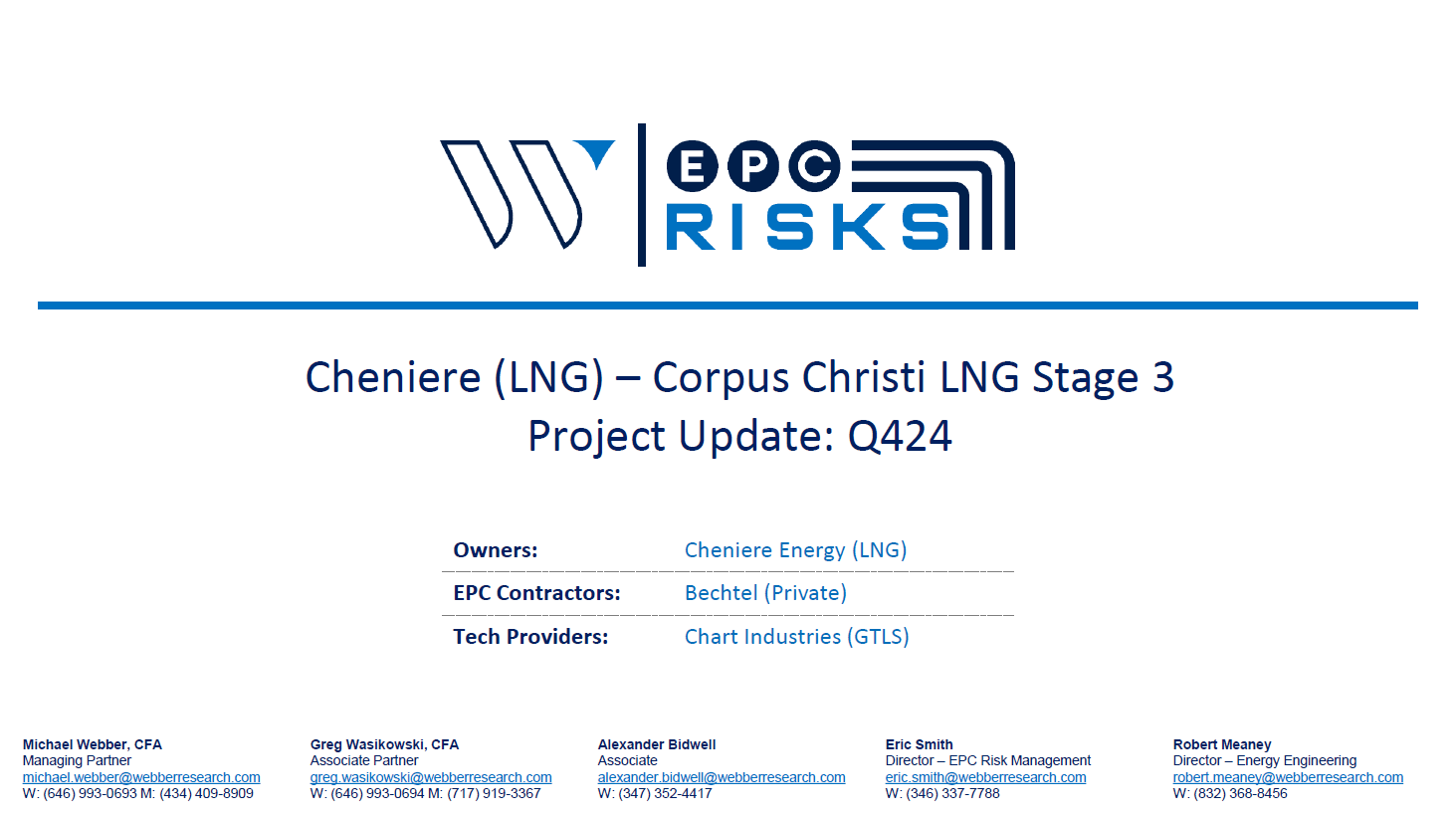
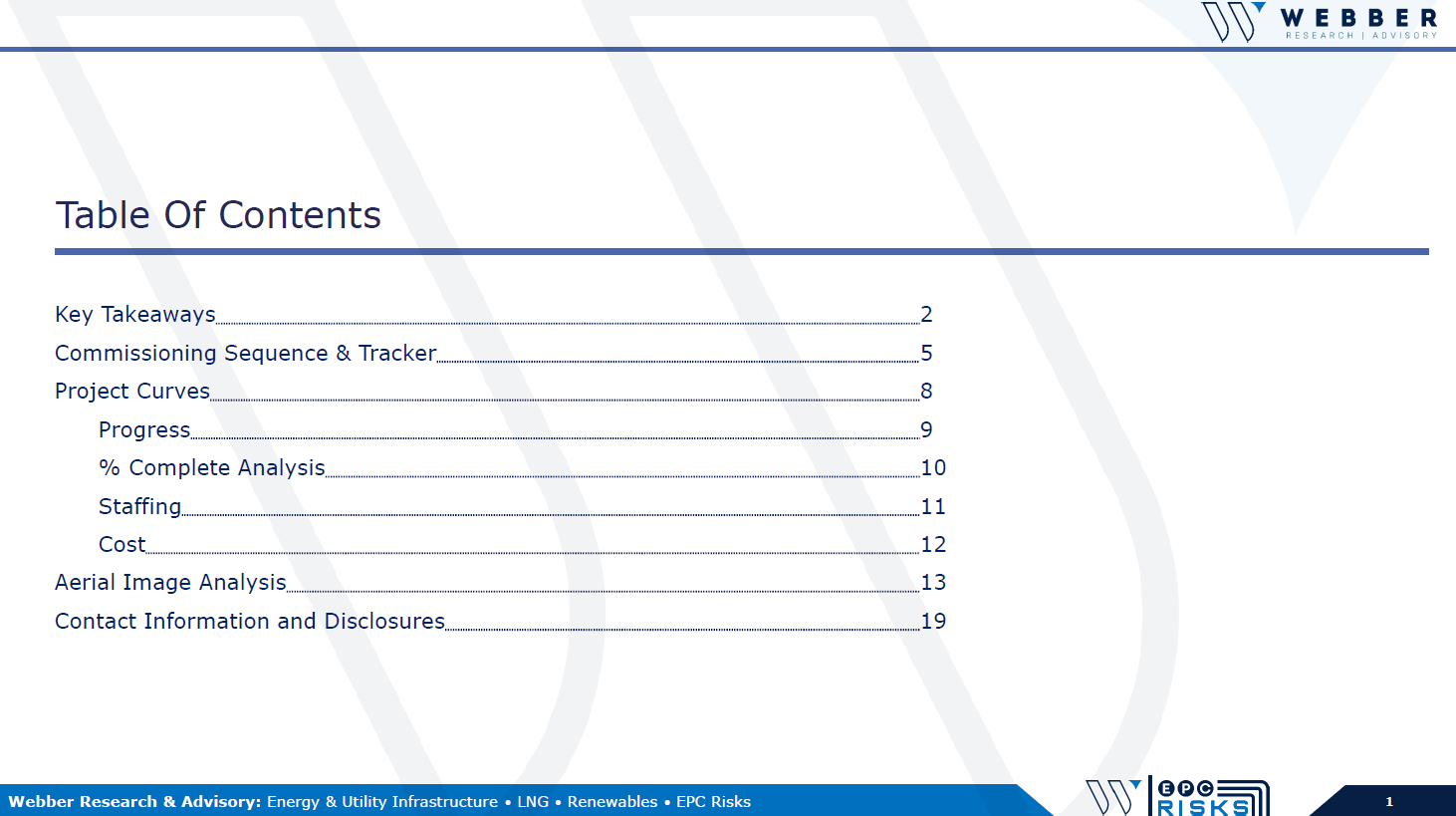
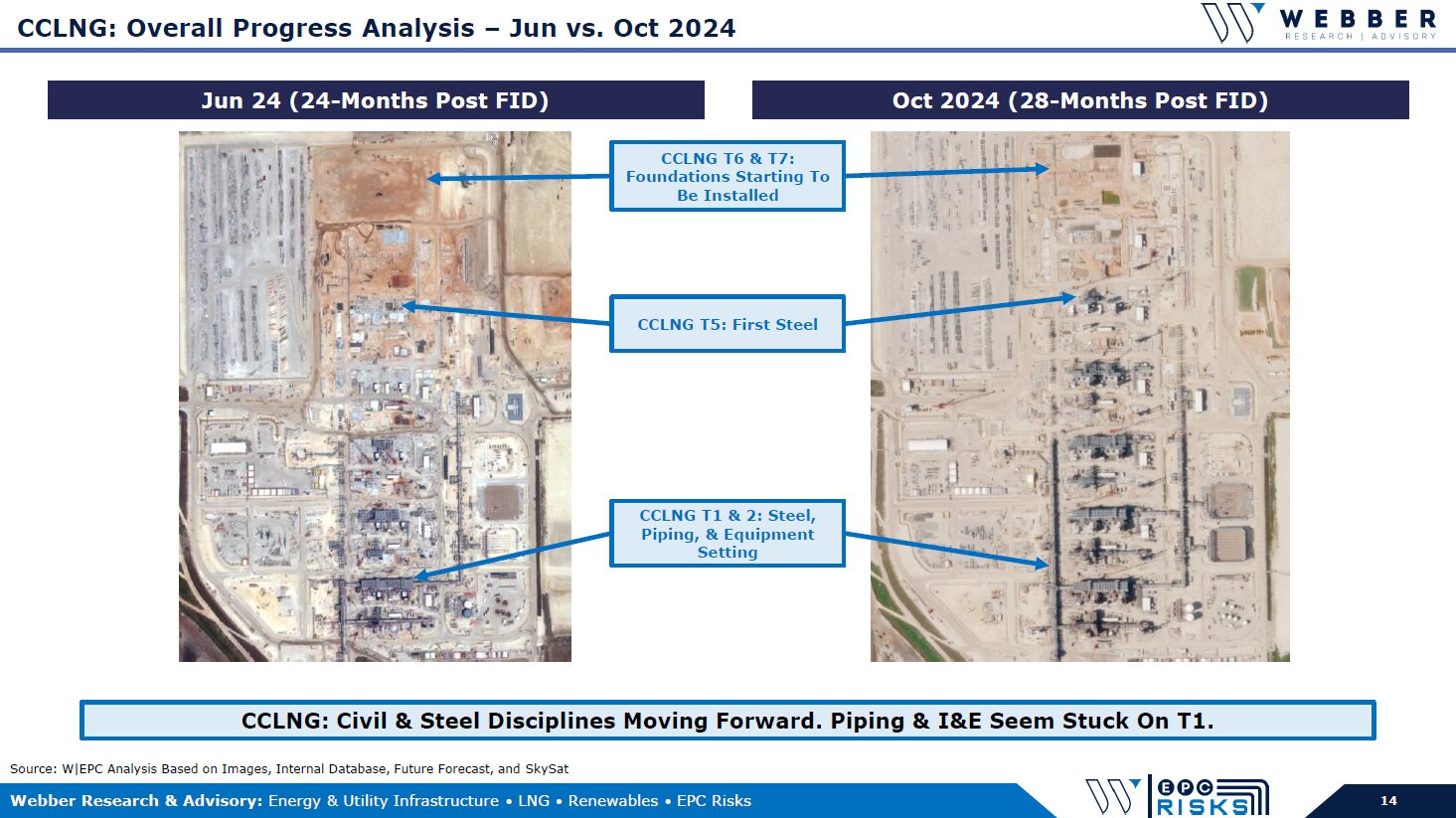
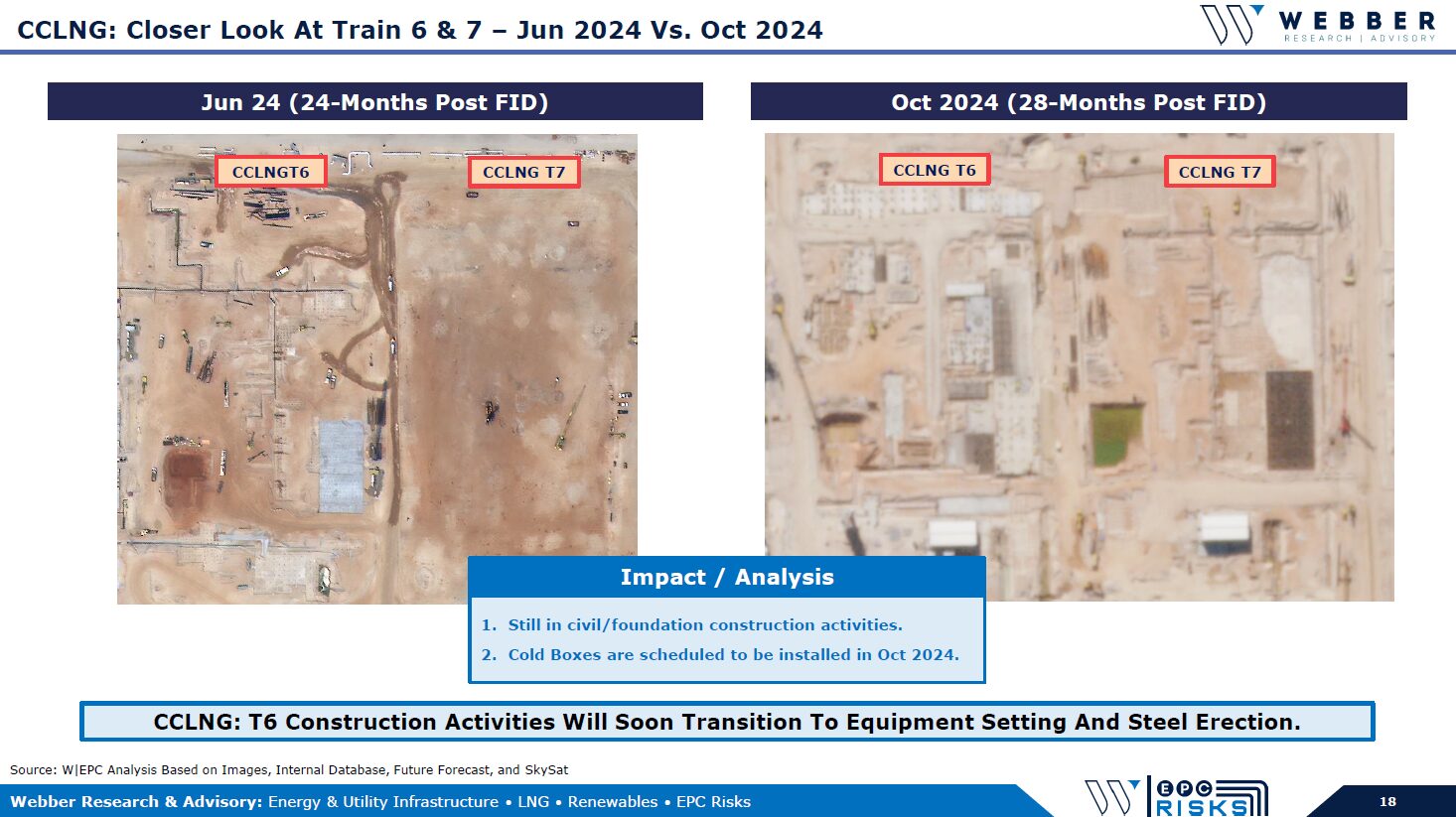
Read More
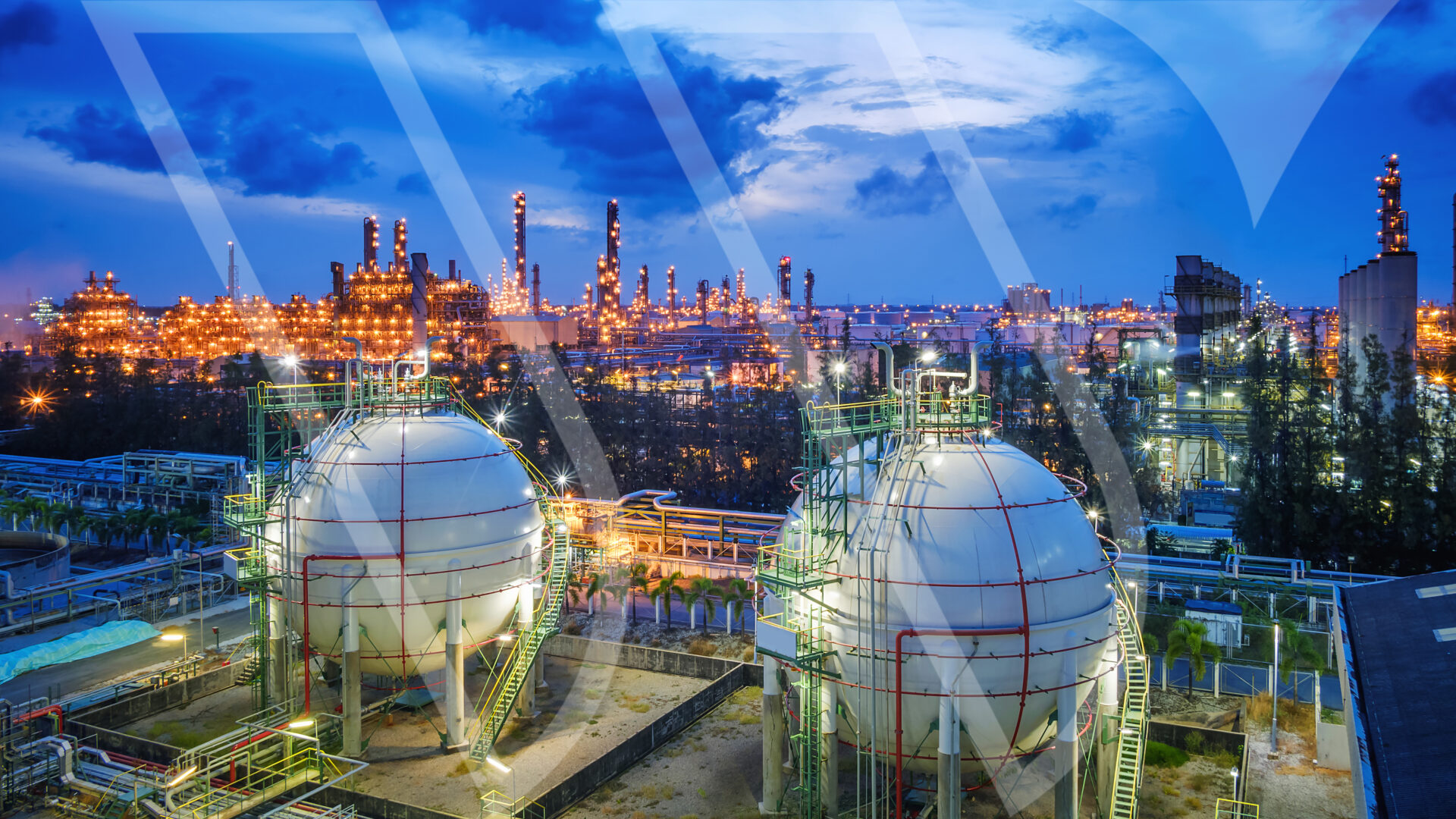
W|EPC: Port Arthur LNG Quarterly Project Update – Q4234
For access information, please contact us at [email protected] or [email protected]
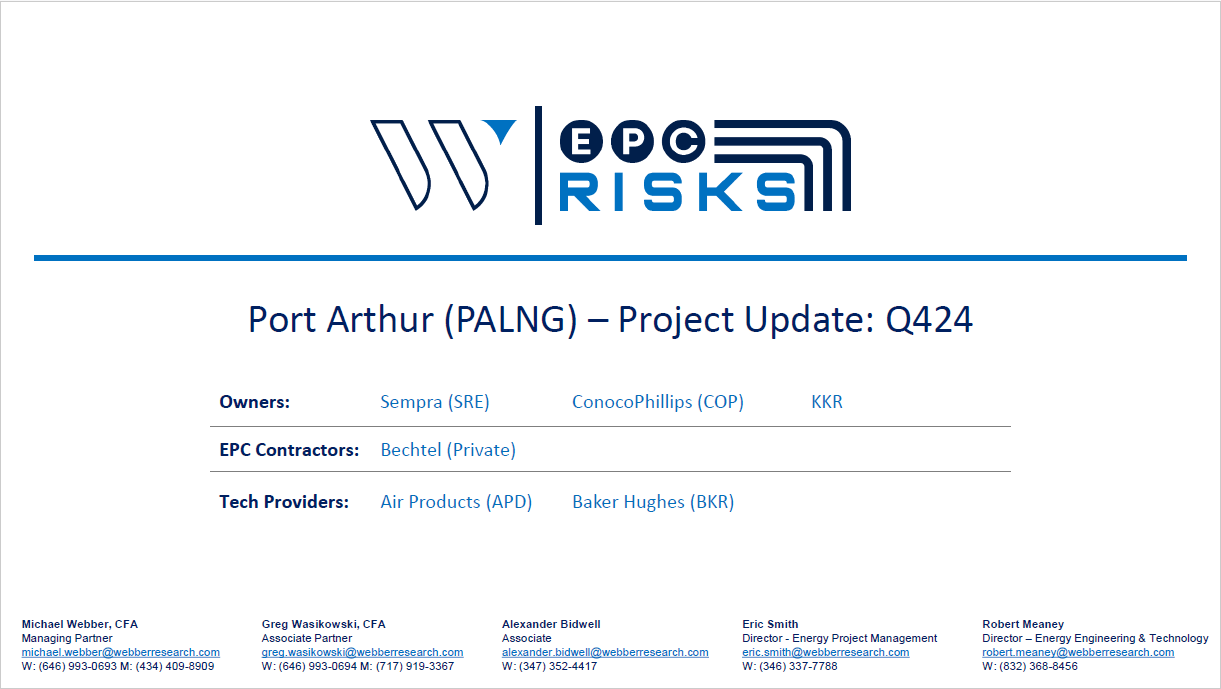
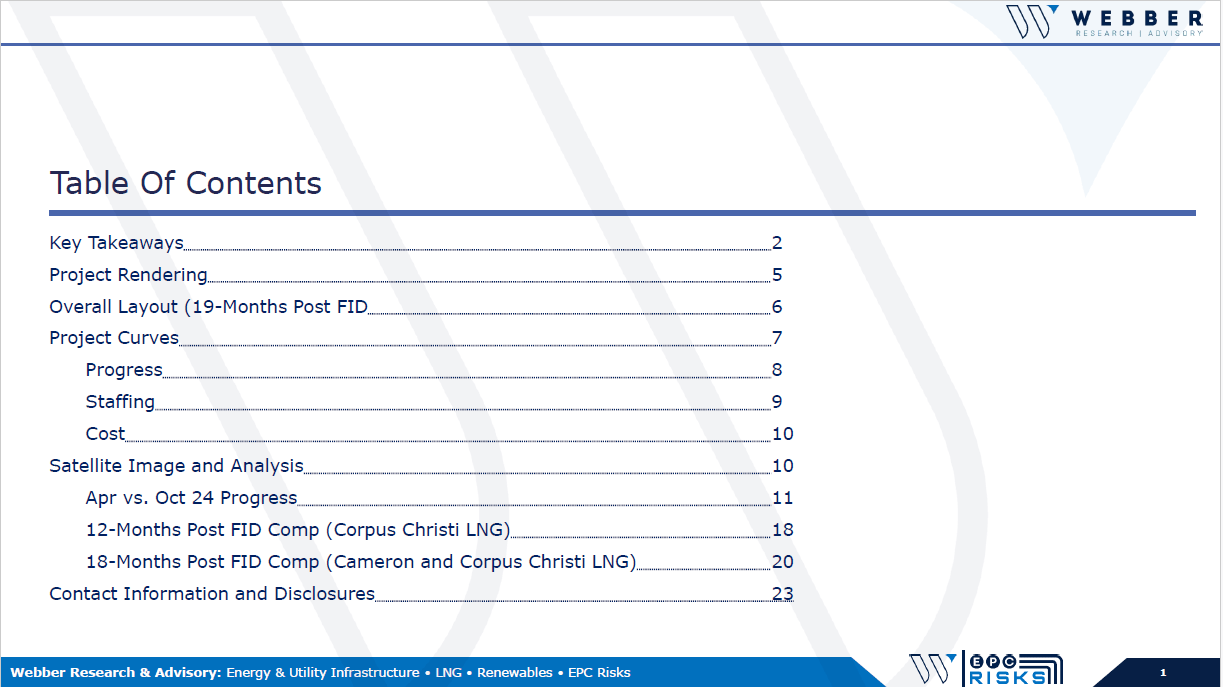
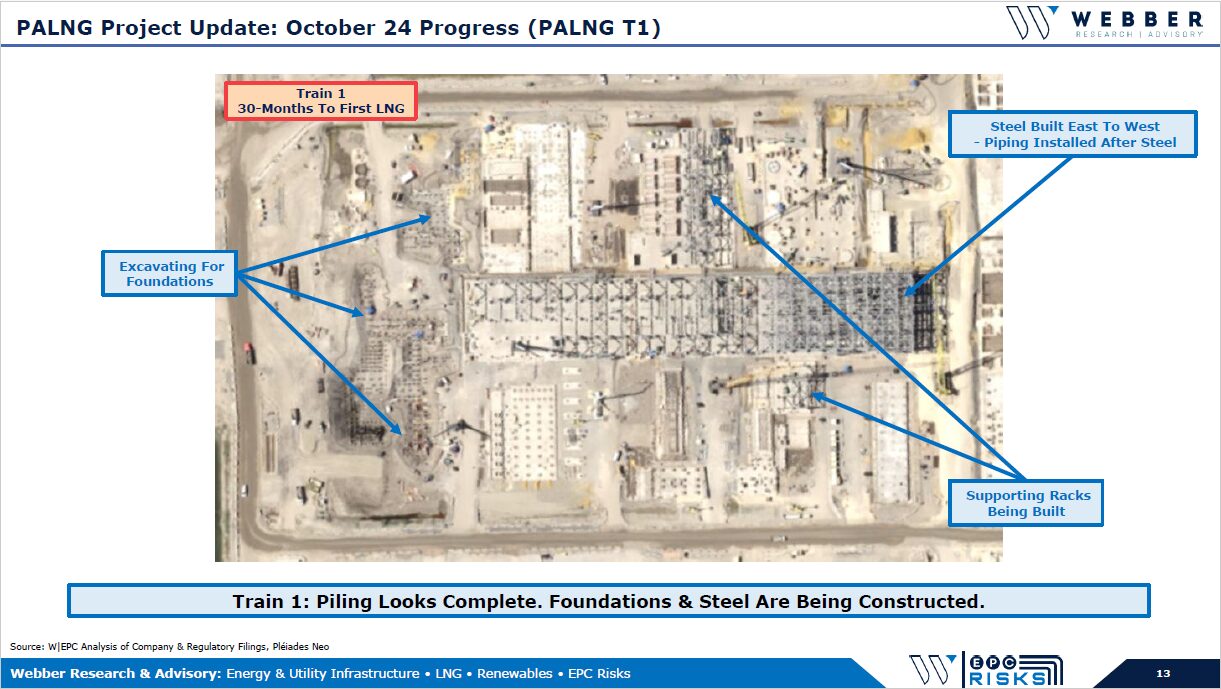
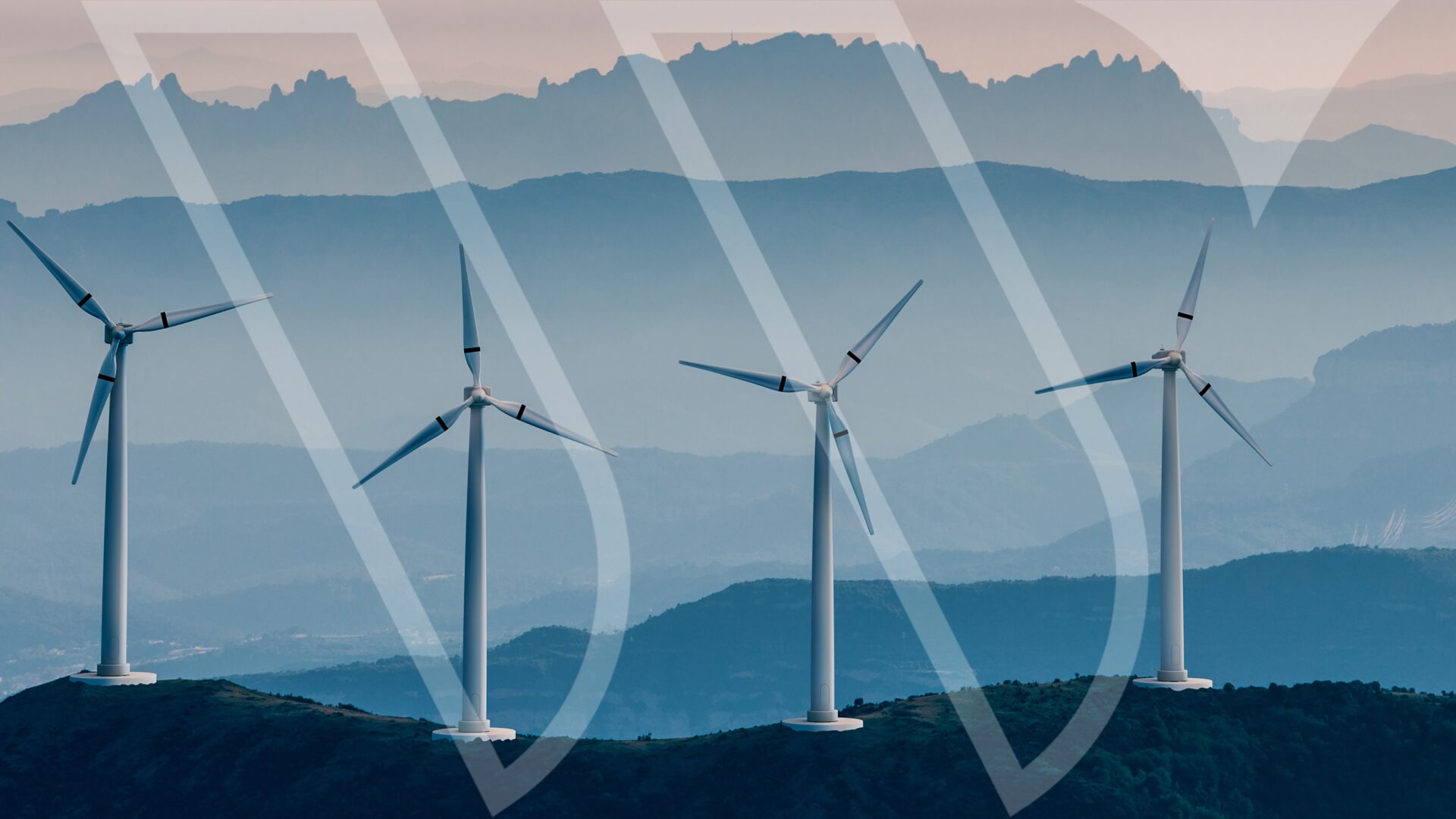
W|EPC: Plaqumines Parish LNG Project Update – Q123
Read More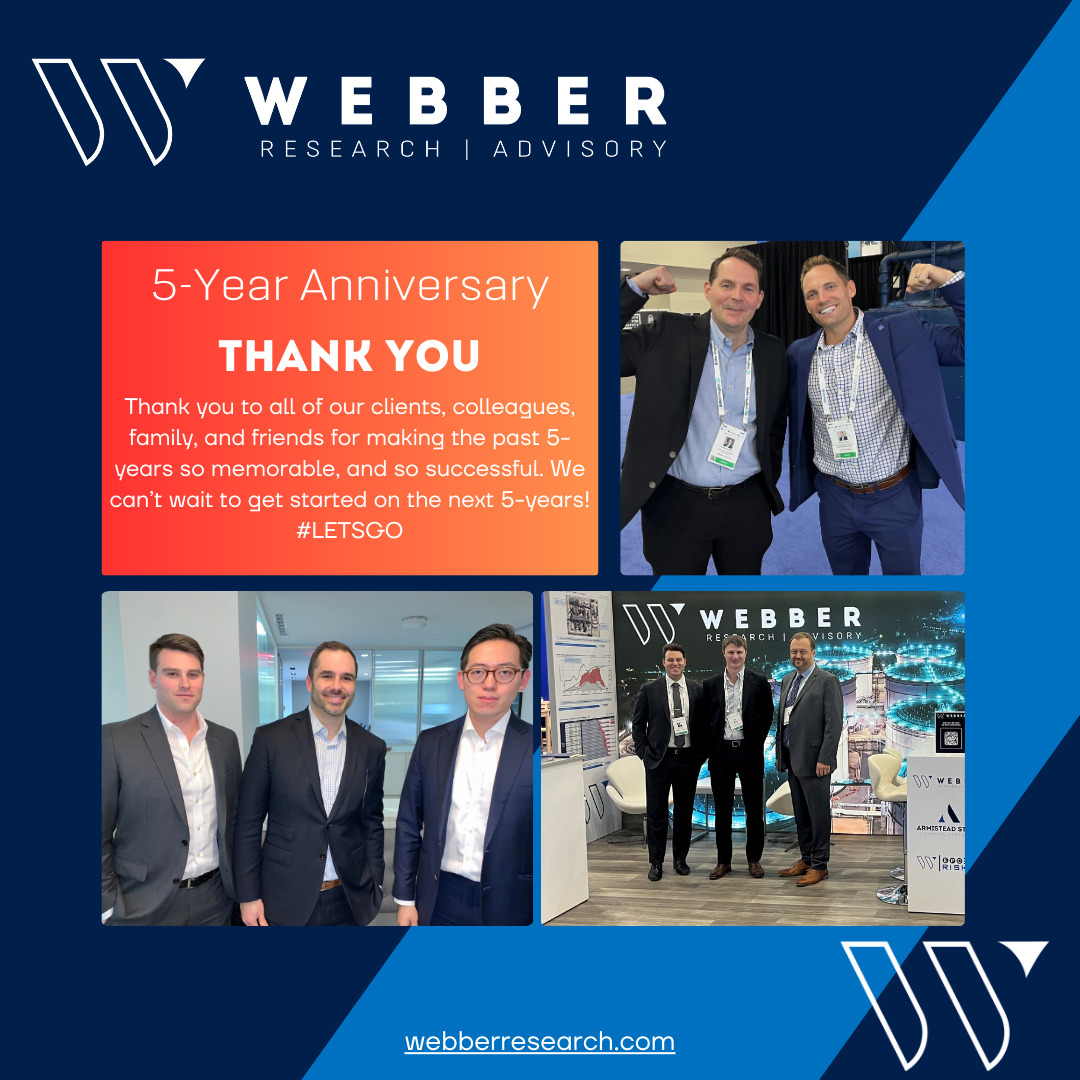

W|EPC: Golden Pass LNG Q324 Project Review – Client Call Weds 09/25 @11AM EST
For our full Q324 Project Review, please visit our Downloads section. If you’re already a Webber Research subscriber, you can access this report via our Research Library. For access information, please contact us at [email protected], or at [email protected].
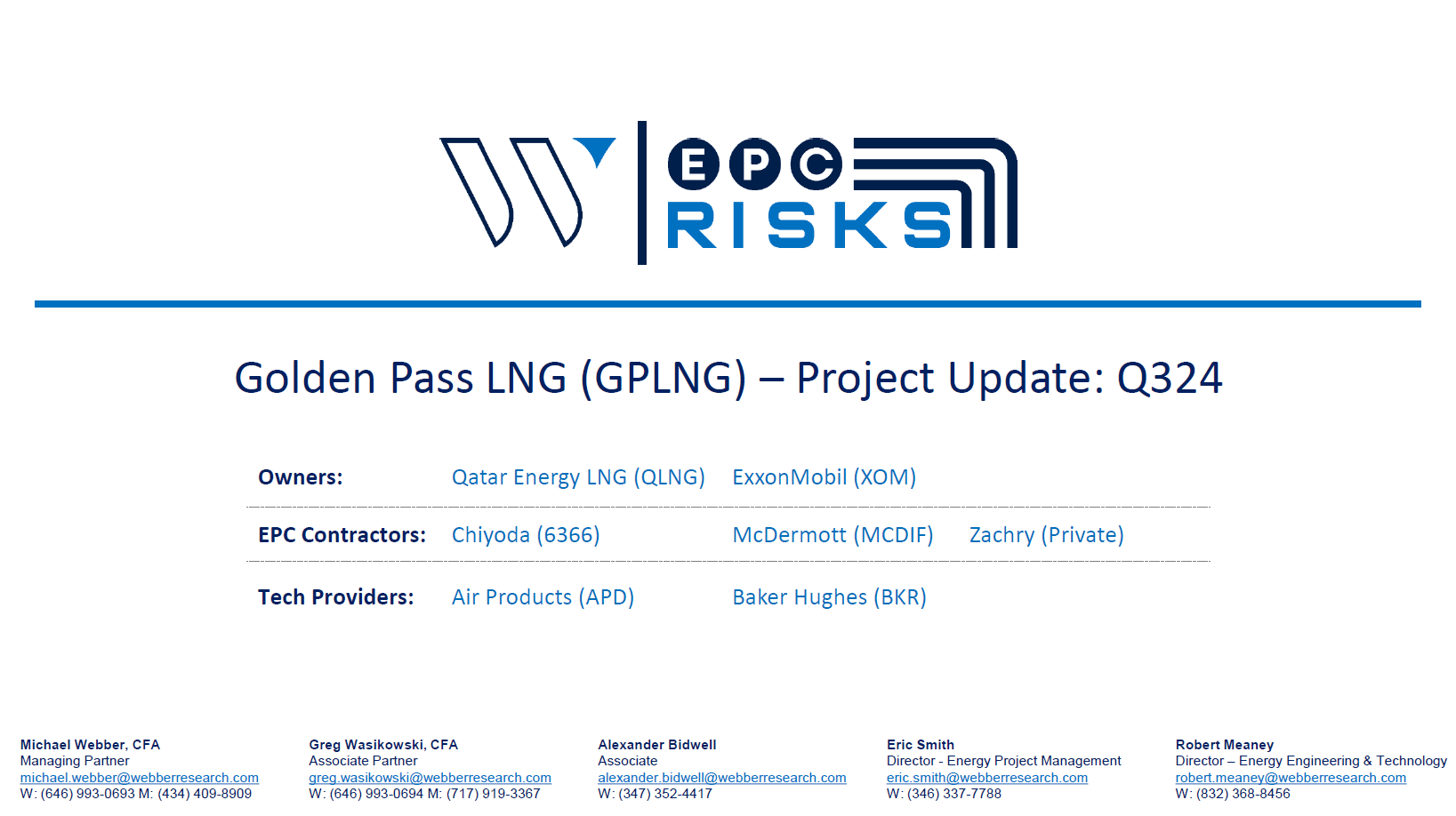
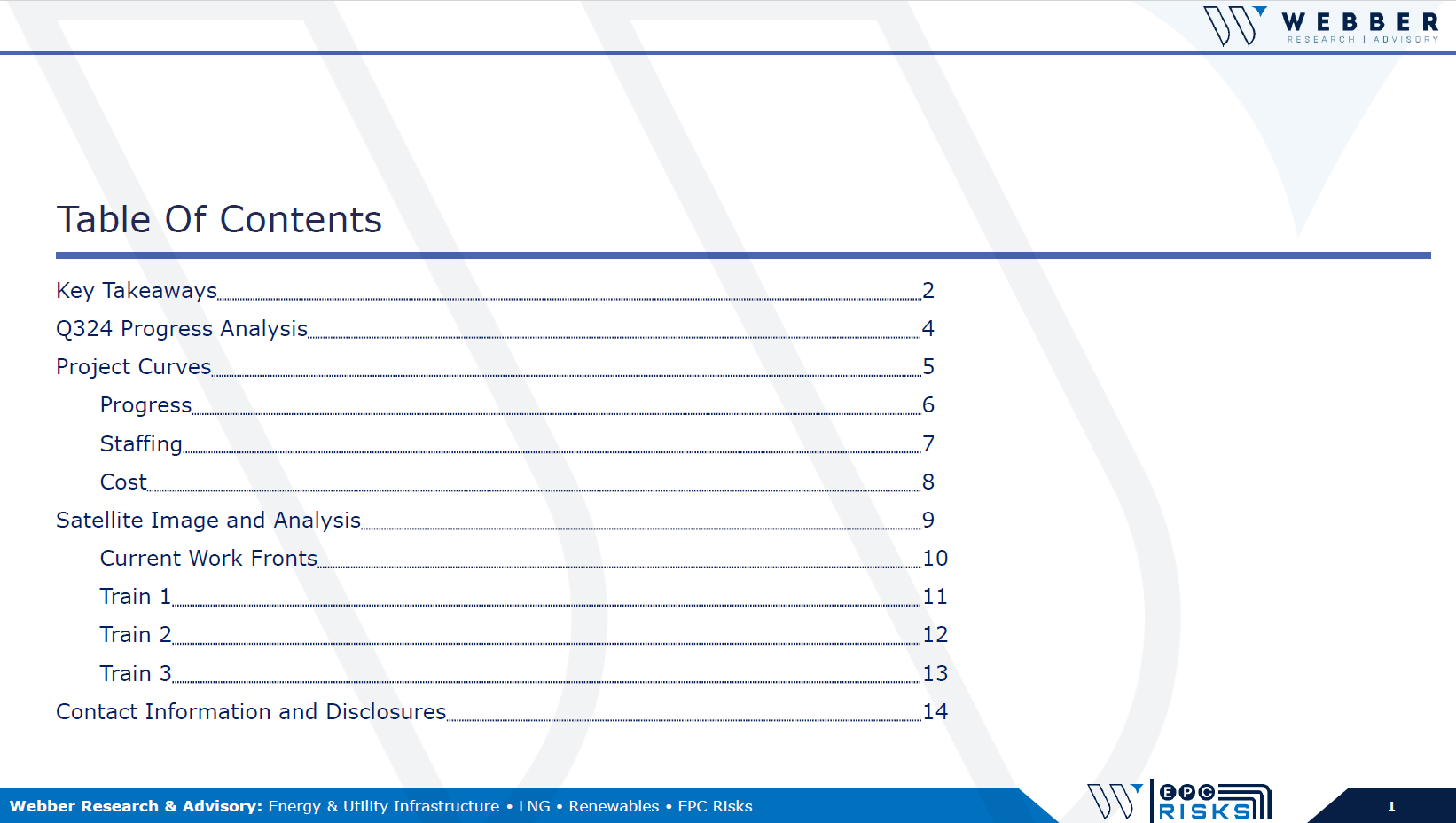
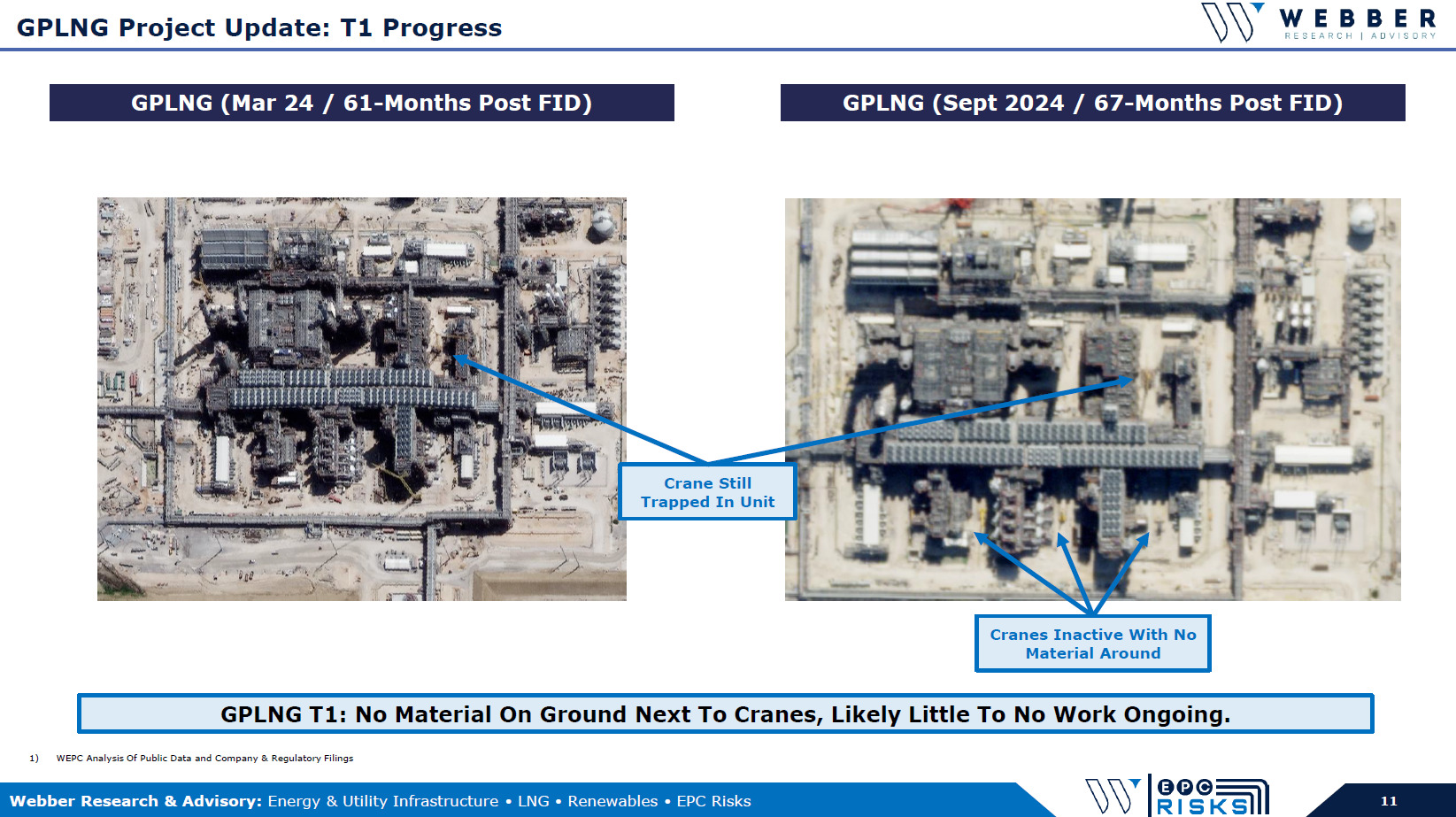
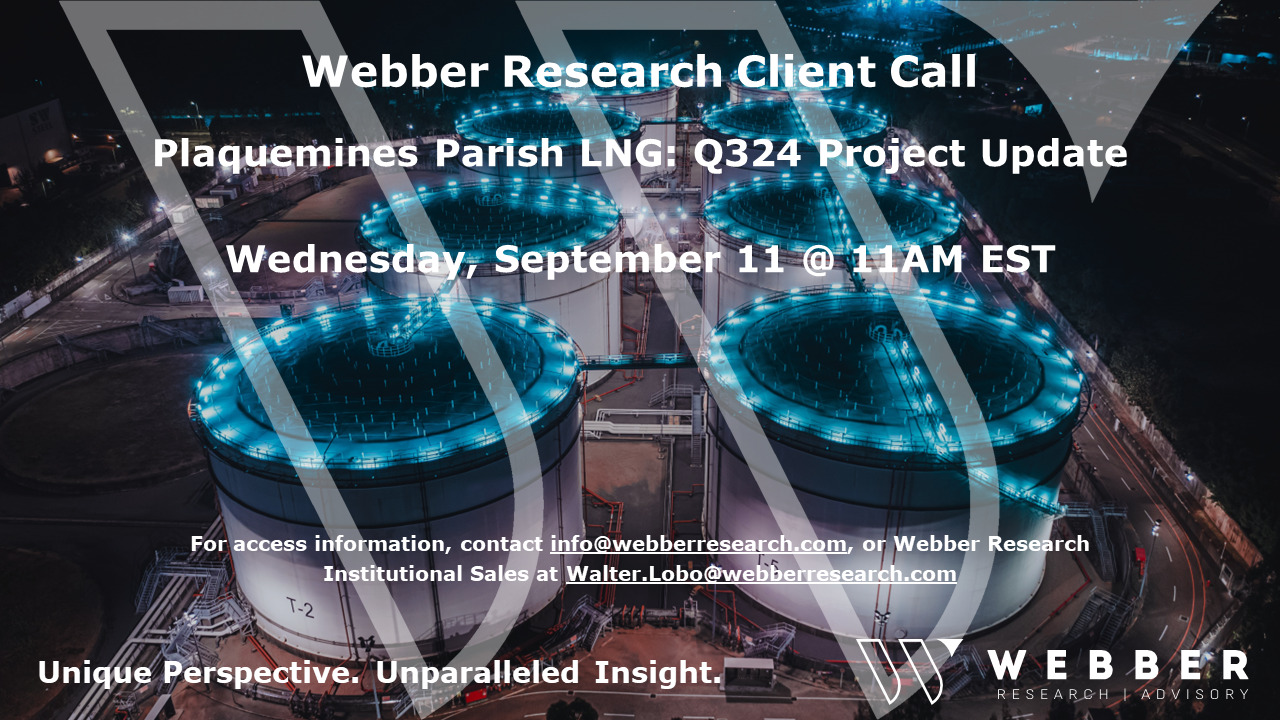
W|EPC: Plaquemines Parish LNG Project Update – Q324
For our full report, please visit our download page. If you’re already a Webber Research subscriber, you can access this report via our library. For access information, email us at [email protected] or at [email protected]
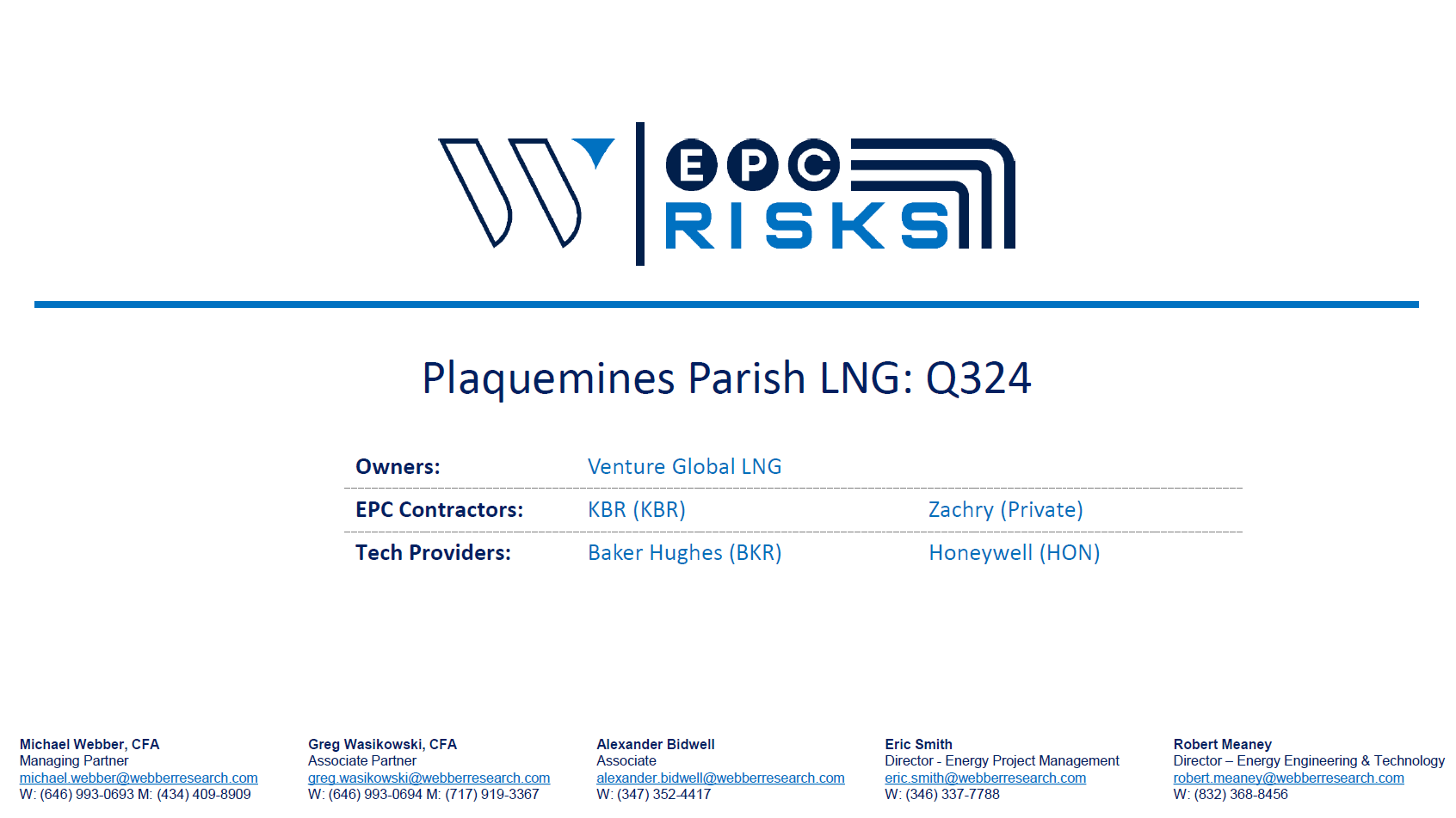

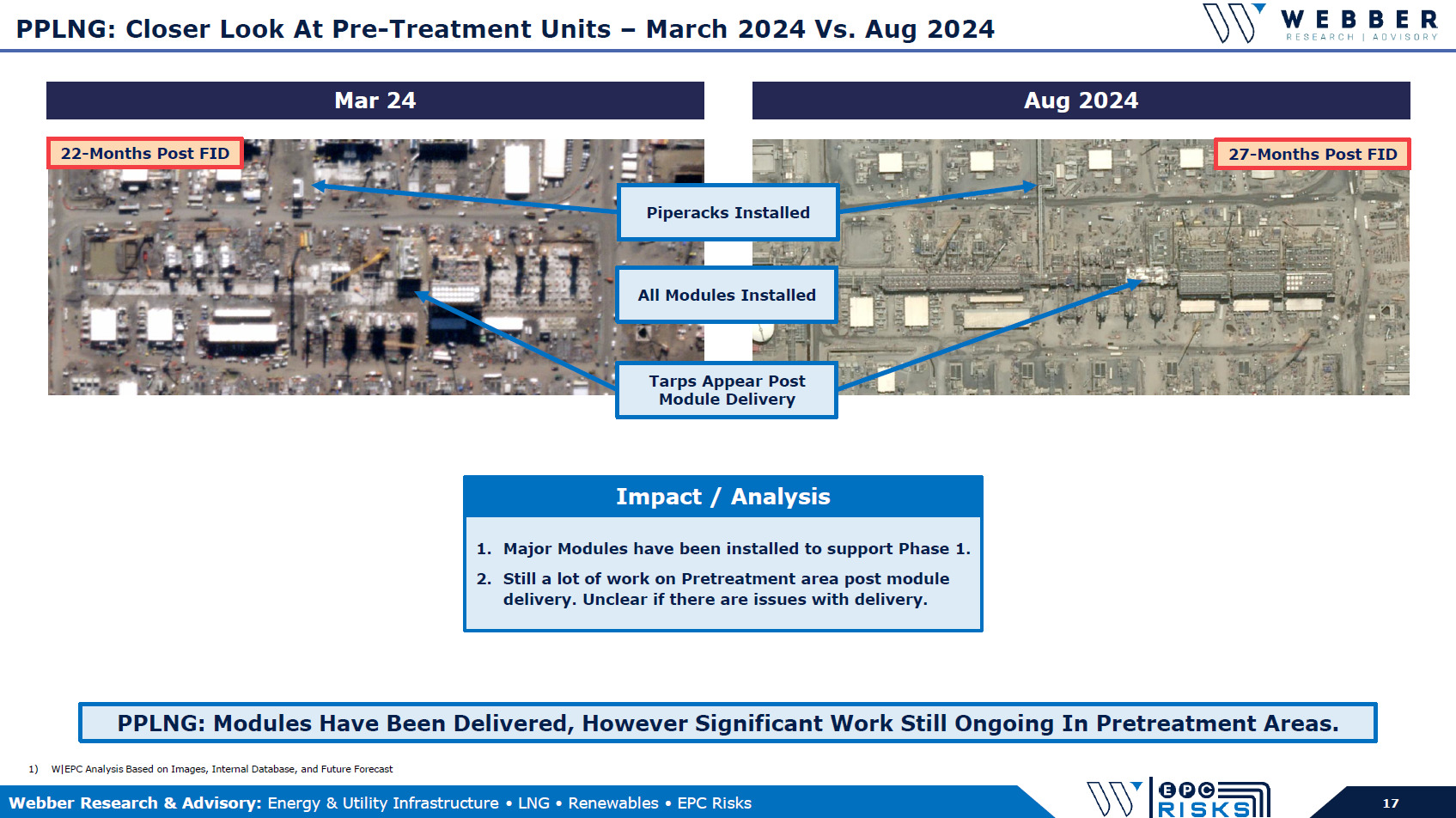

W|EPC: Costa Azul LNG – Project Update Q324
For our full report, please visit our download page. If you’re already a Webber Research subscriber, you can access this report via our library. For access information, email us at [email protected] or at [email protected]
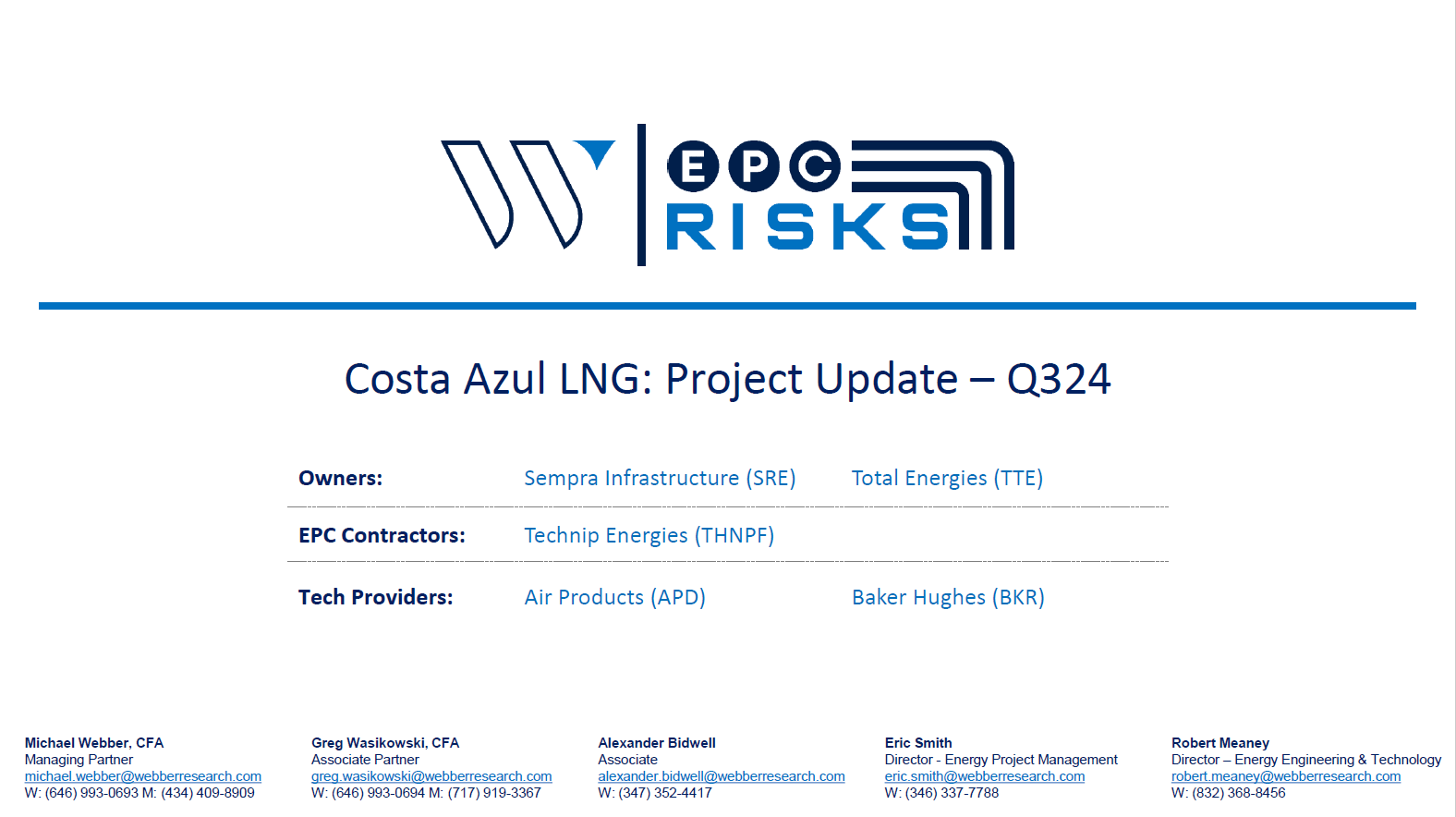
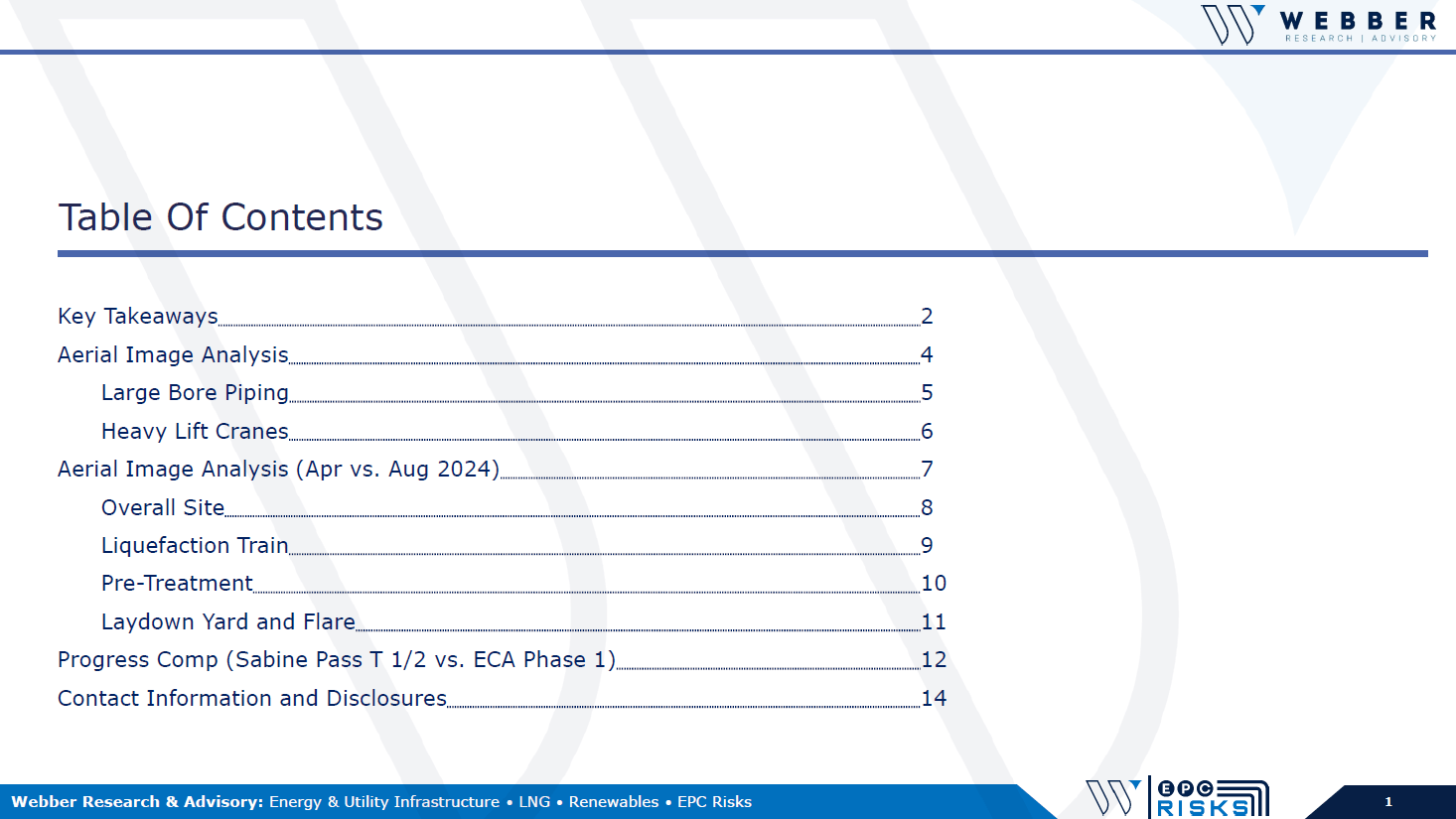
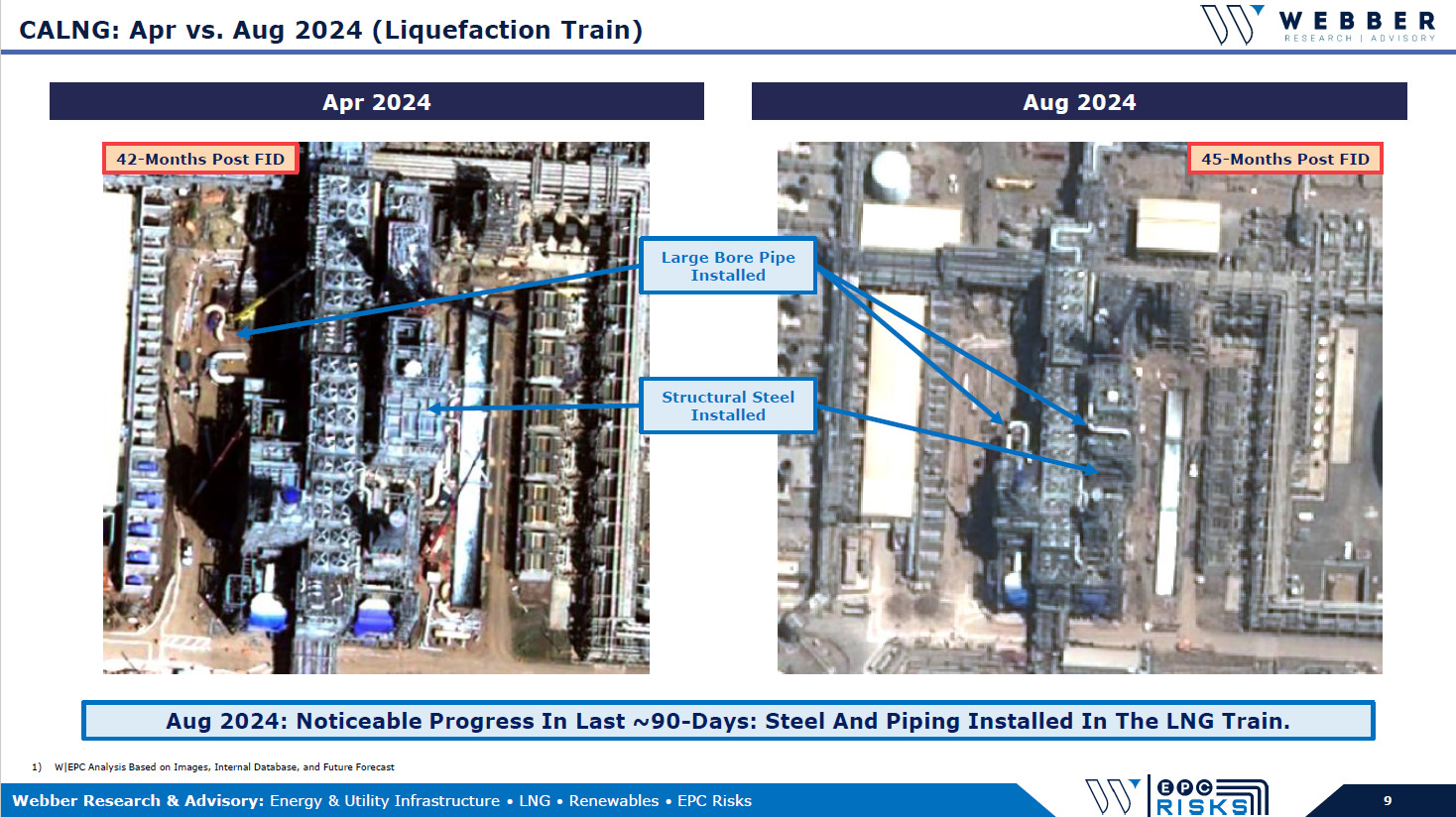
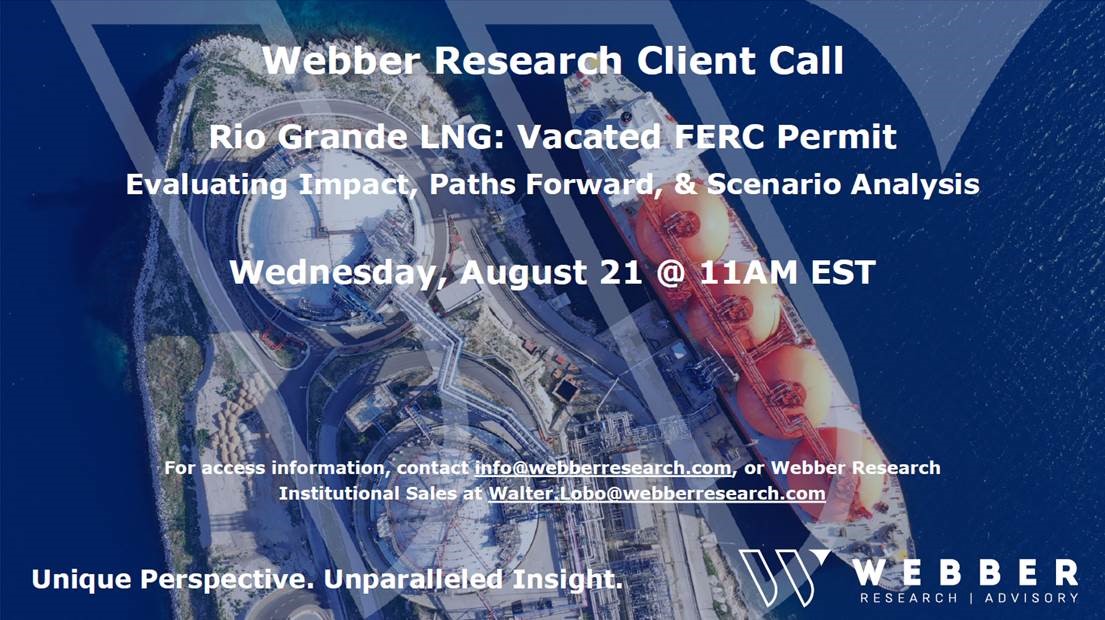
W|EPC: Rio Grande LNG – Vacated FERC Permit Q324 – Analyzing Impact & Scenarios
To access the full presentation, please visit our Downloads page. If you’re an existing Webber Research subscriber, you can access this report via our library. For subscription information, please contact us at [email protected], or at [email protected].
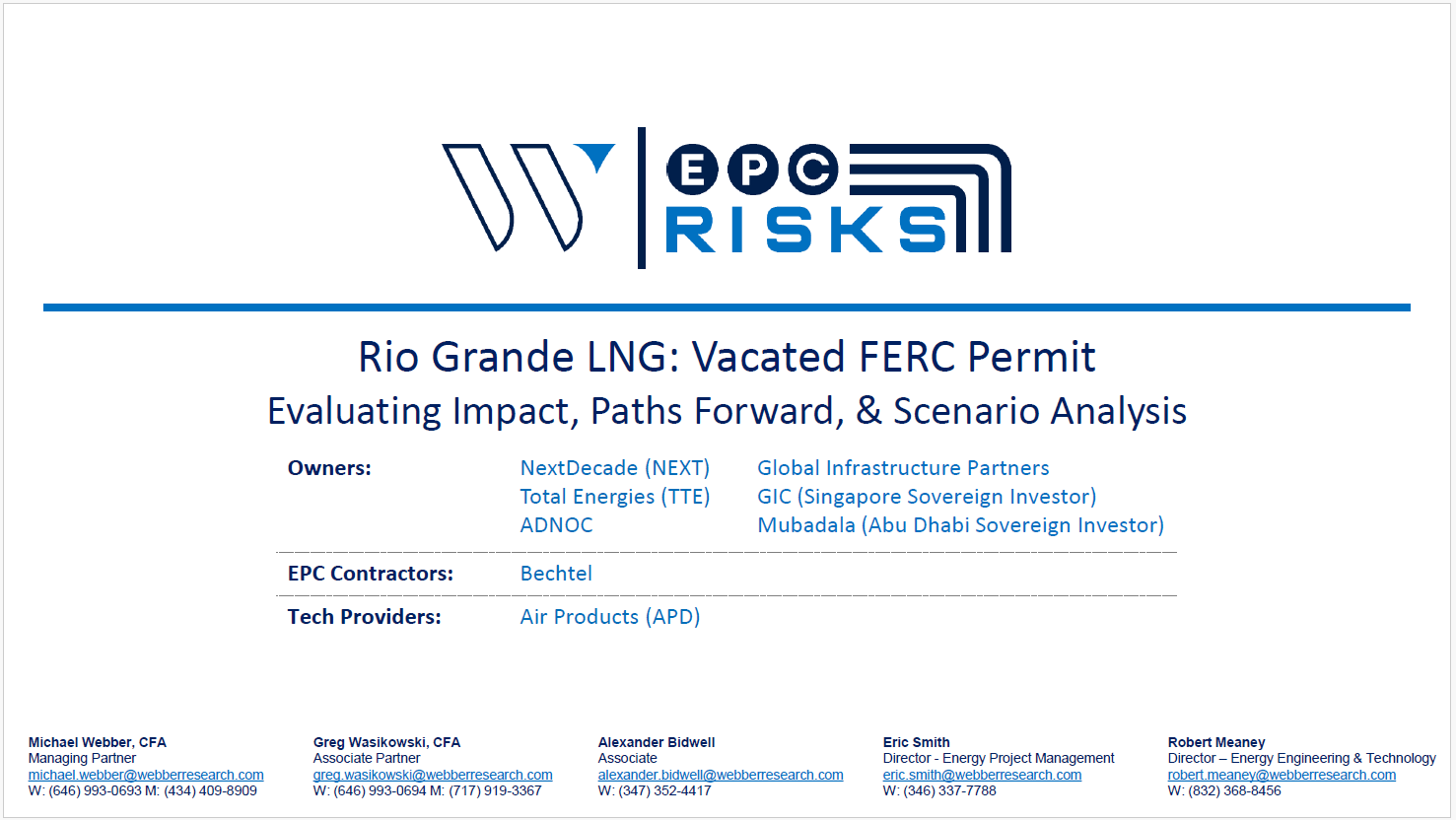
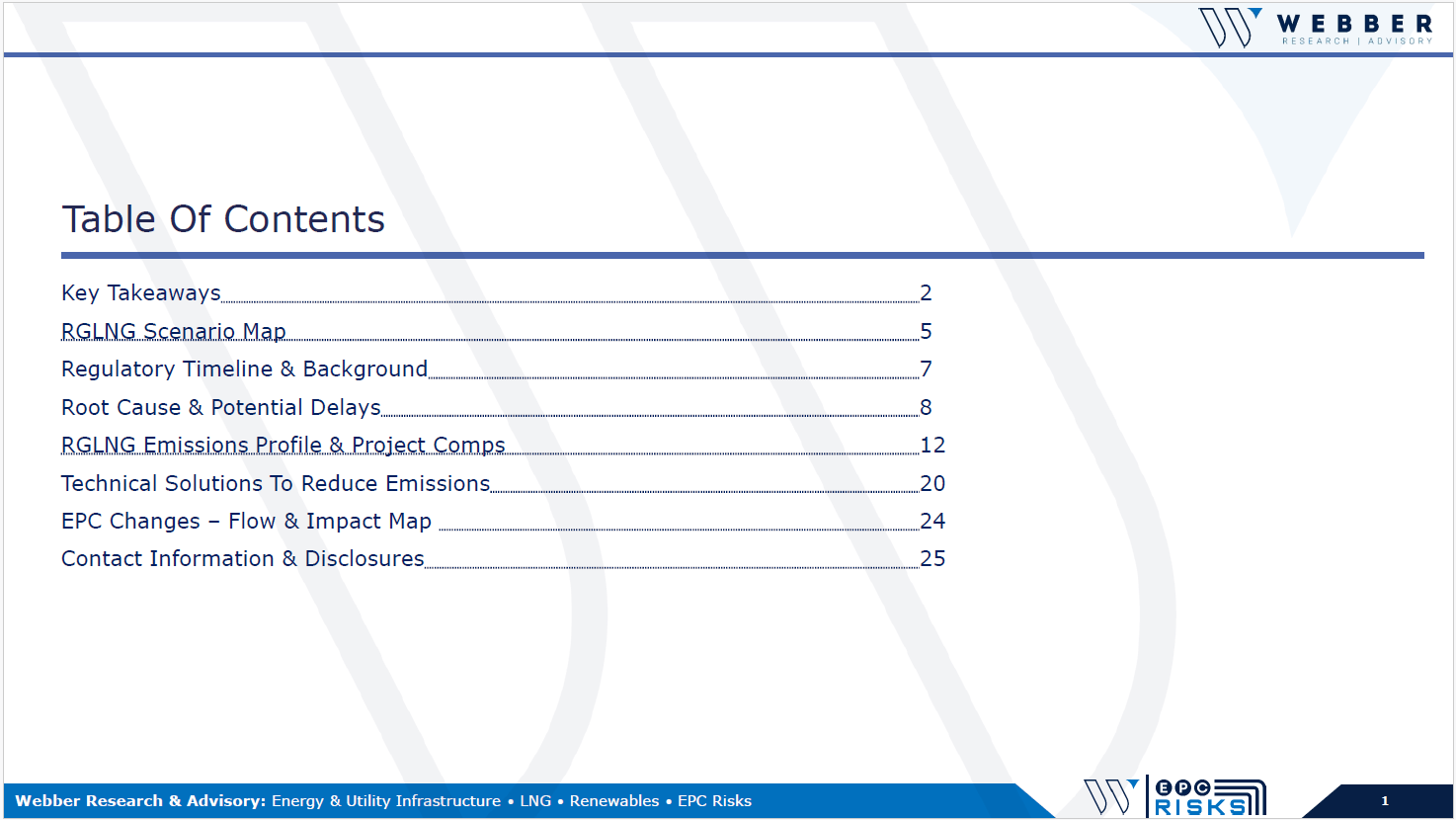
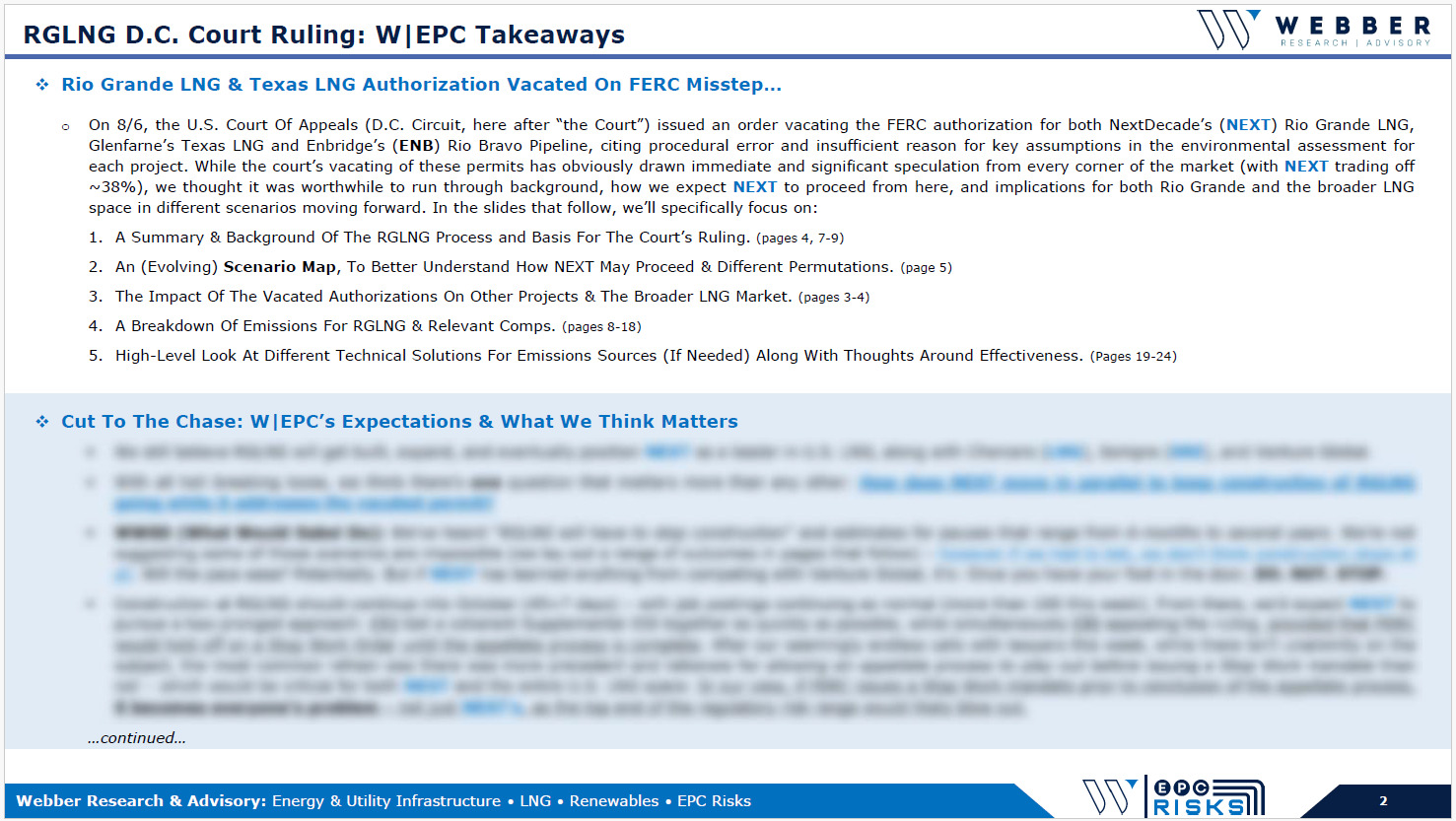
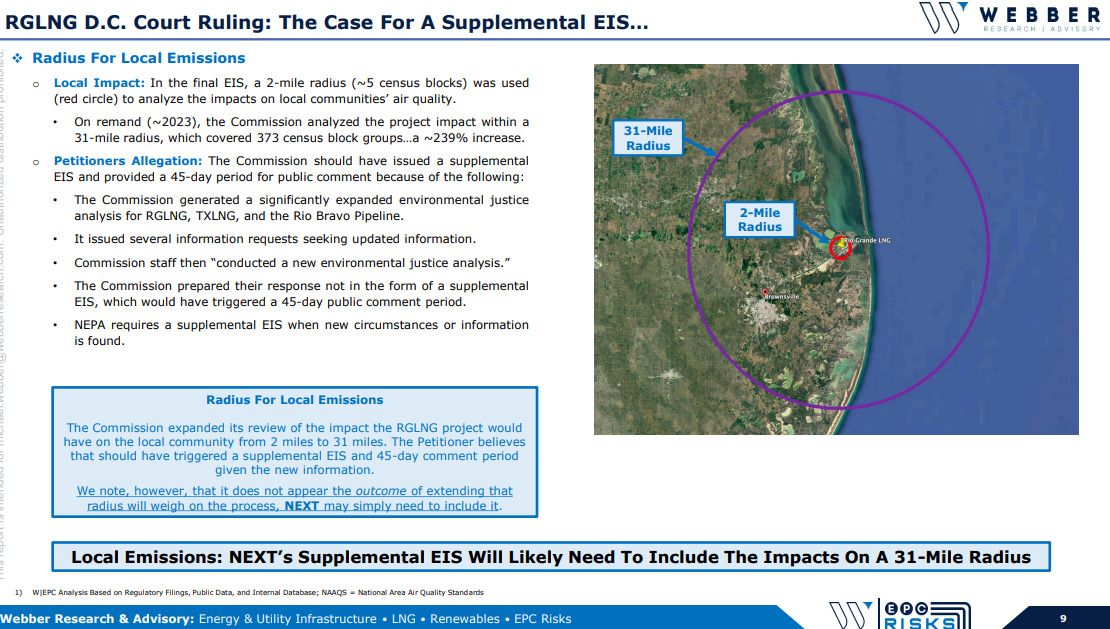

W|EPC: LNG Canada Q324 Project Update – Updated Timeline Ests, Satellite Image Review, & Analysis
To access the full report, please visit our downloads page. If you’re already a Webber Research client, you can access this report via our library. For subscription information, contact us at [email protected] or at [email protected]
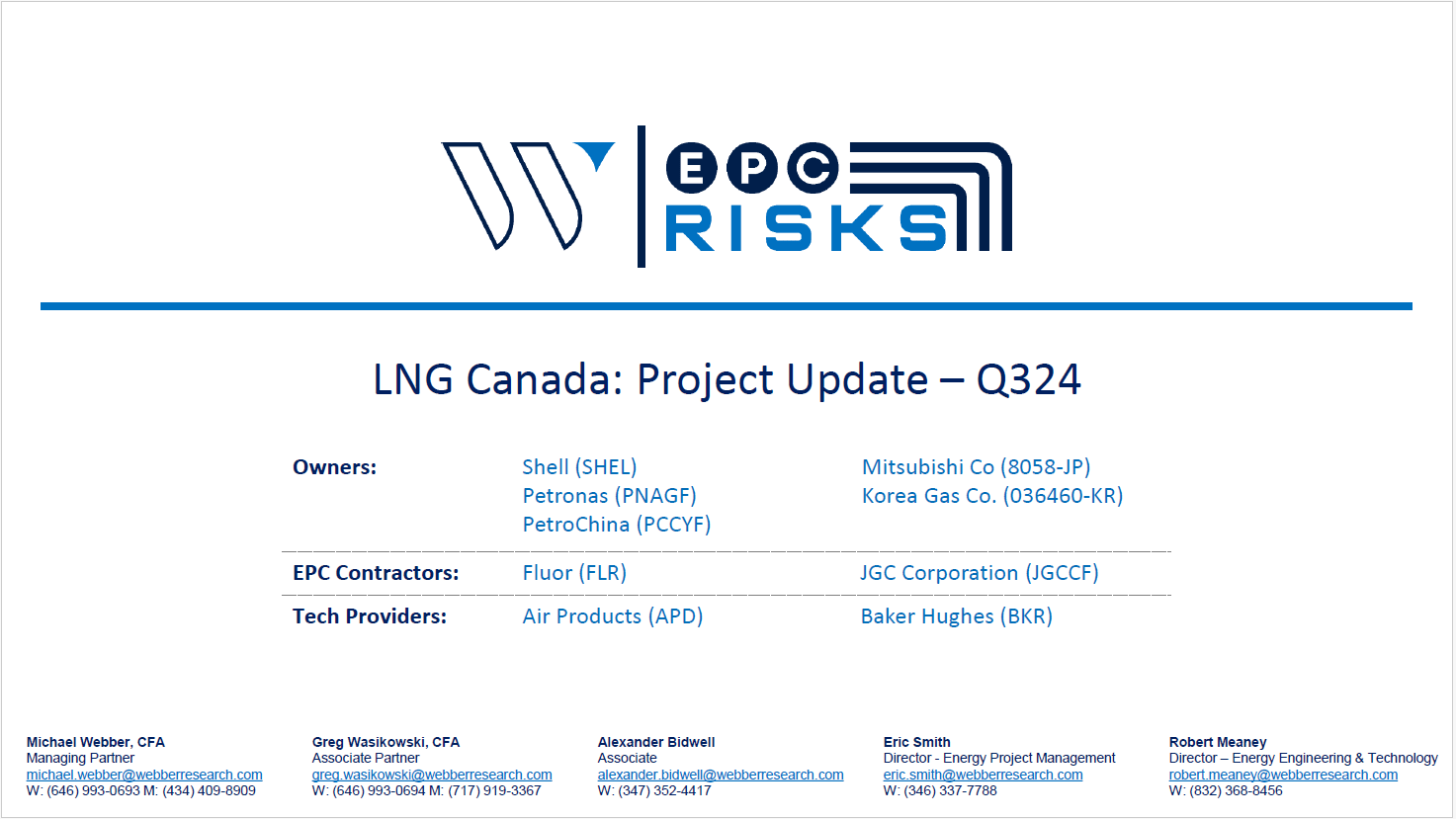
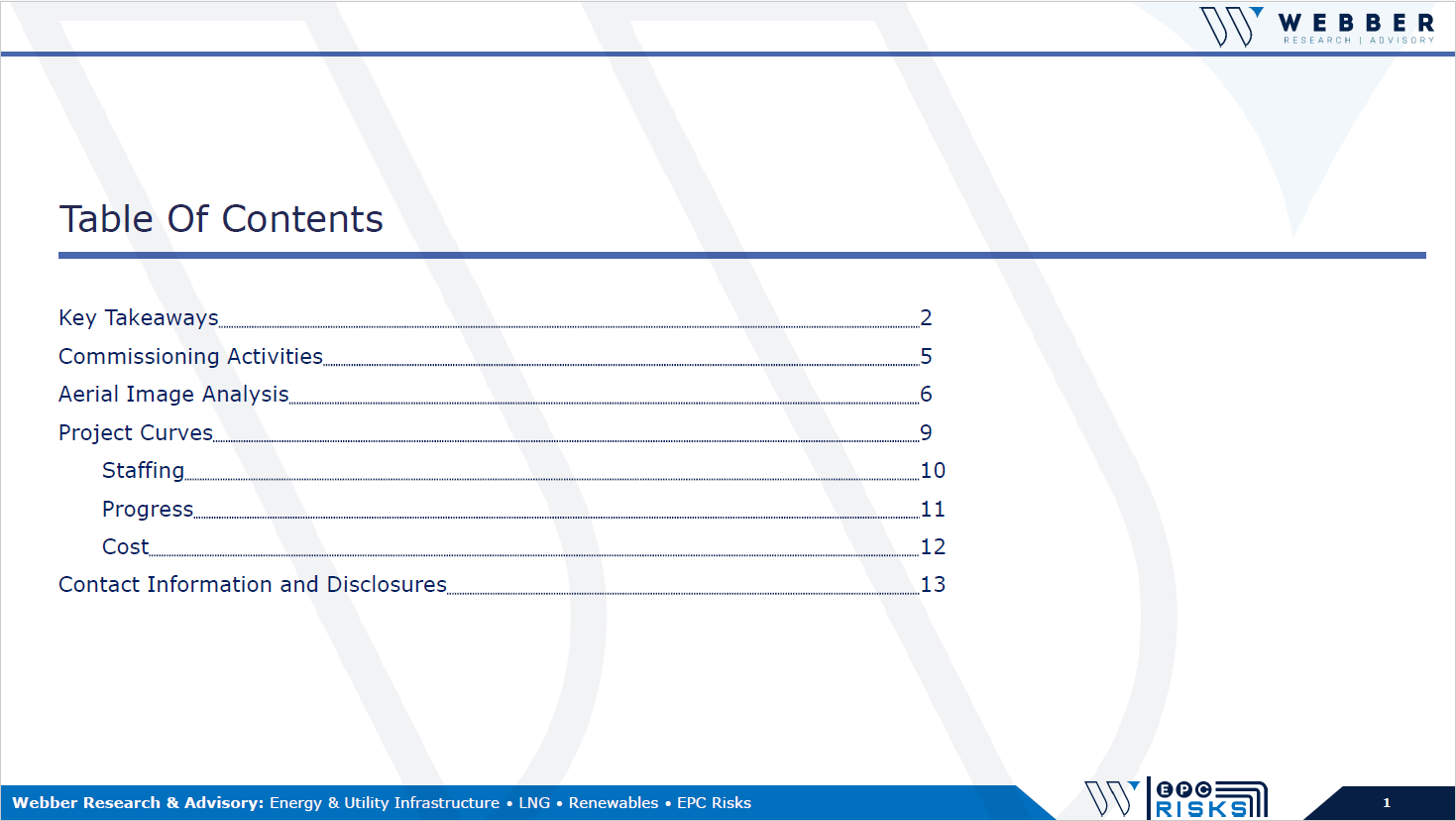
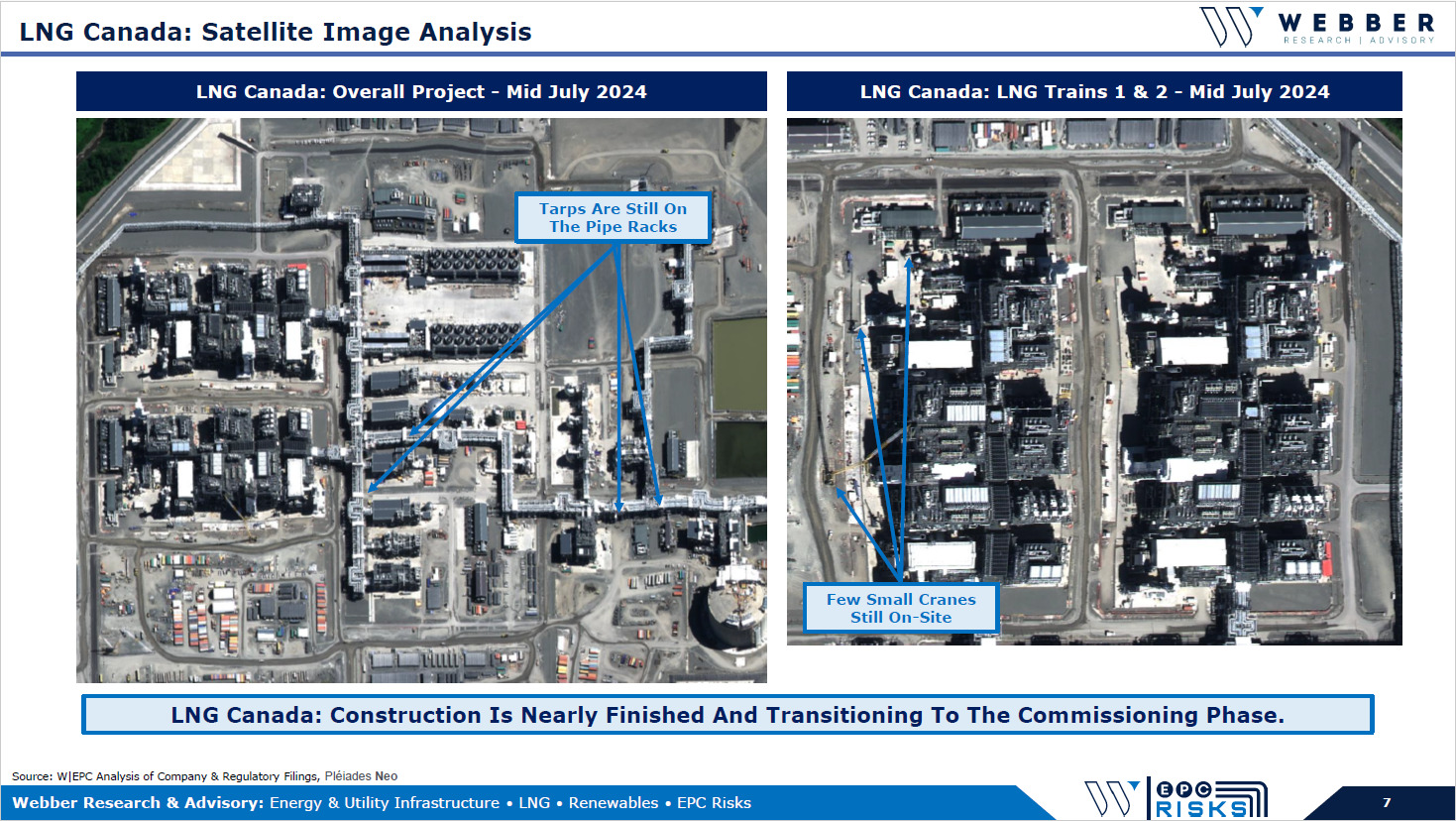
Read More

W|EPC: Qatar LNG North Field Expansion – Q324 Update & Project Estimates
For our full report, please visit our downloads page. If you’re already a Webber Research subscriber, you can access this report via our library. For access information, contact us at [email protected], or [email protected].


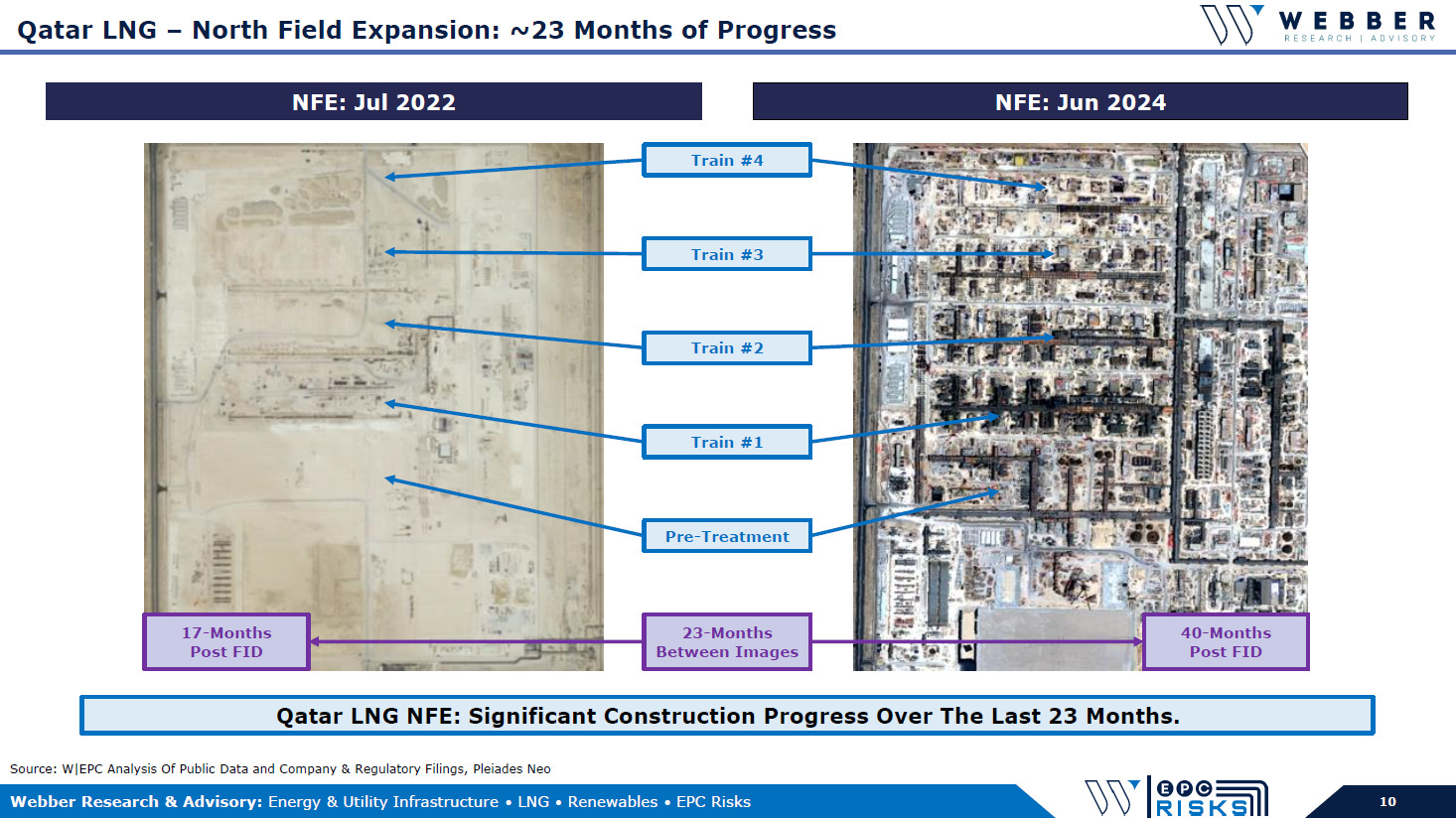
Read More

W|EPC: Cheniere’s Corpus Christi LNG – Q224 Project Update
To download this report, click here. If you’re already a Webber Research subscriber, you can access this report via our library. For access information, email us at [email protected] or [email protected].
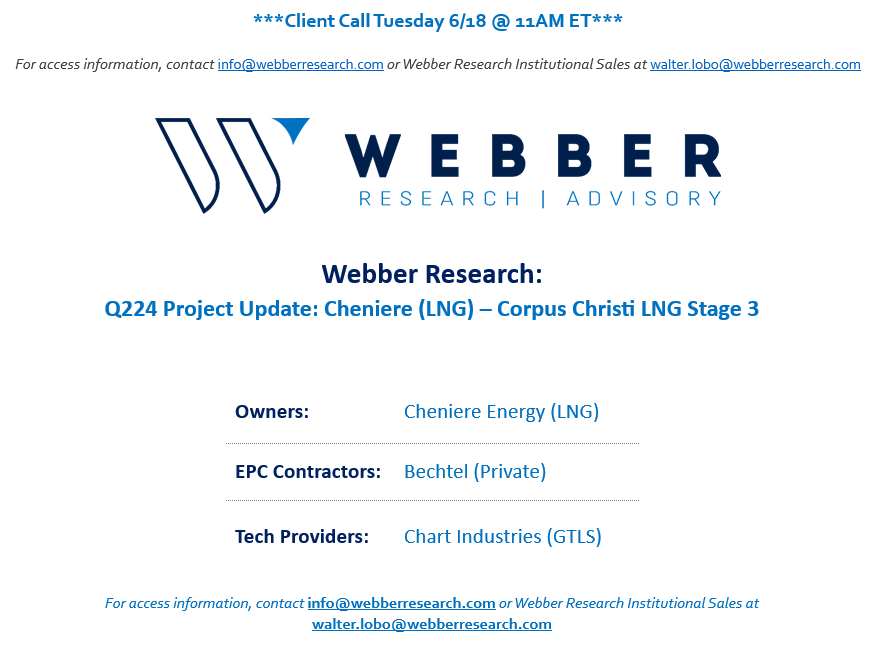

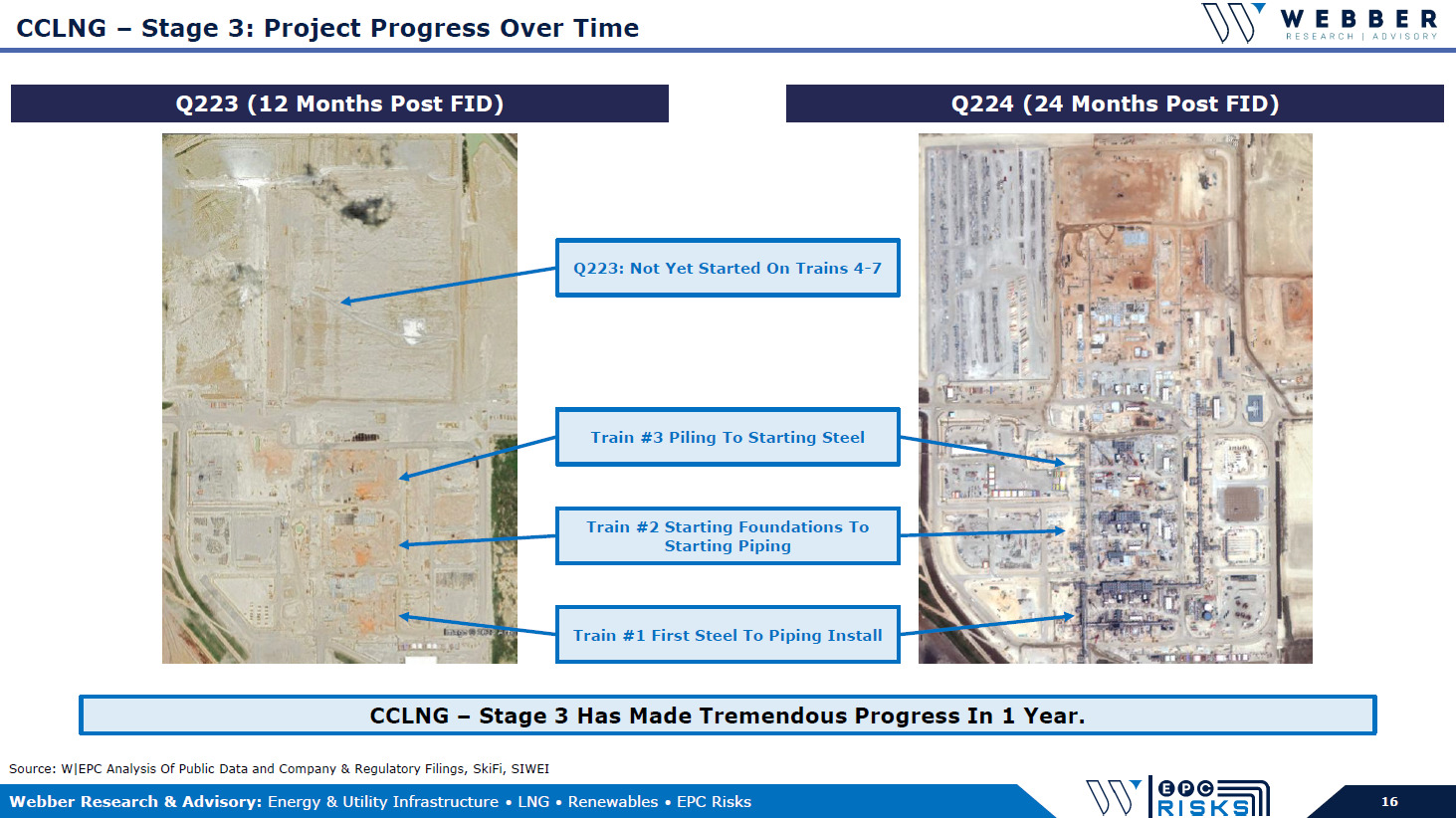
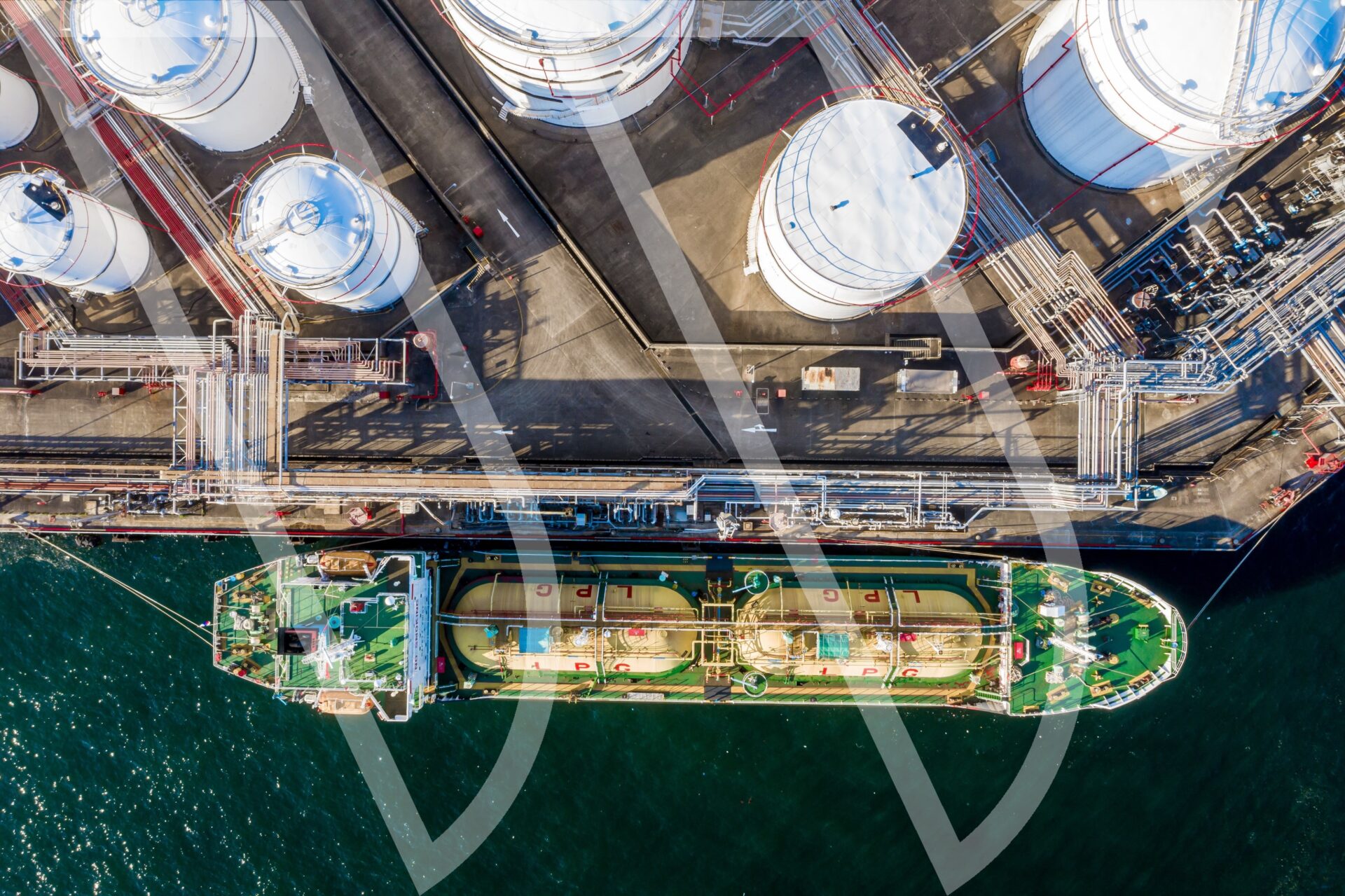
W|EPC: Client Call – Golden Pass LNG & Zachry Bankruptcy Impact – Weds 06/05 @11am
To download this report, click here. If you’re already a Webber Research subscriber, you can access this report via our library. For access information, contact us at [email protected], or at [email protected].
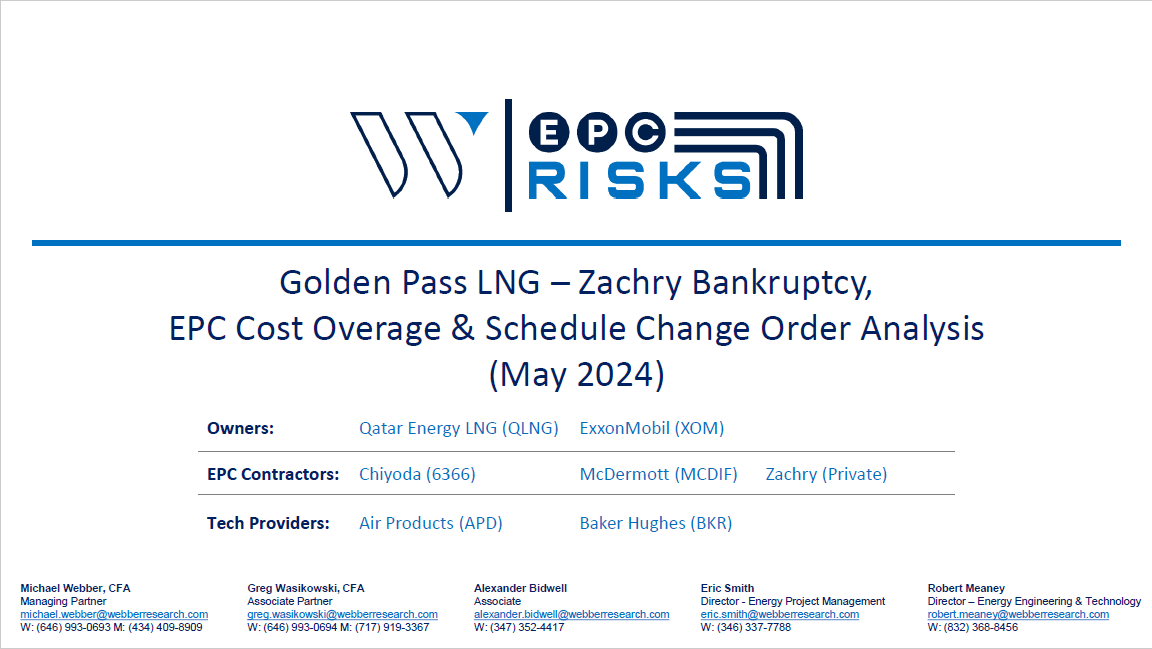
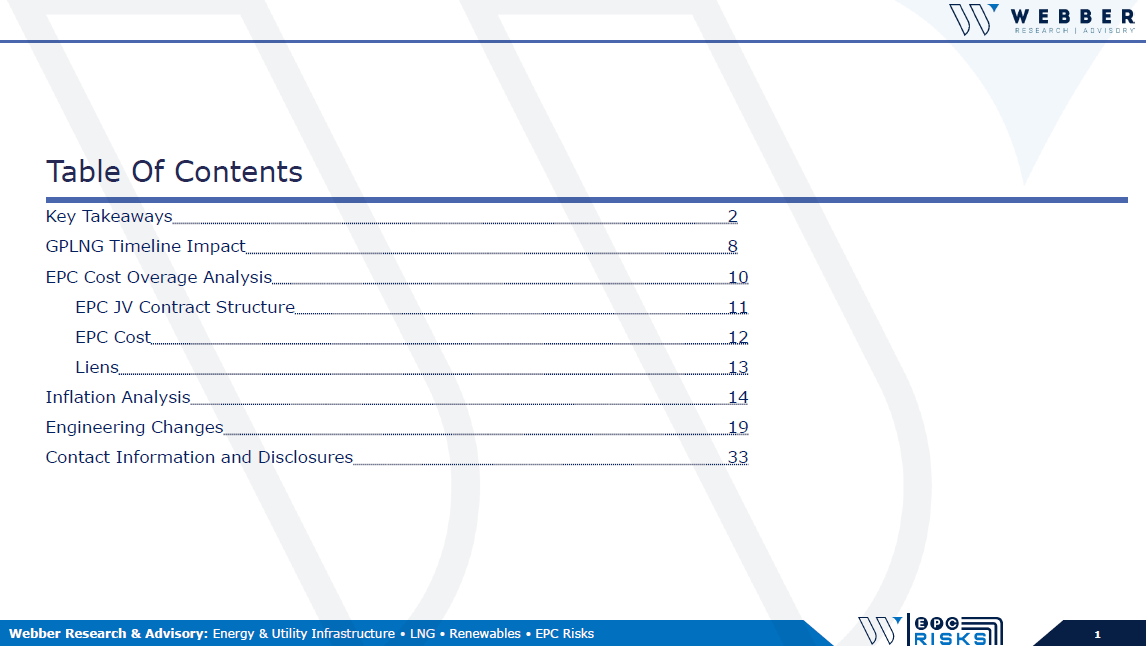
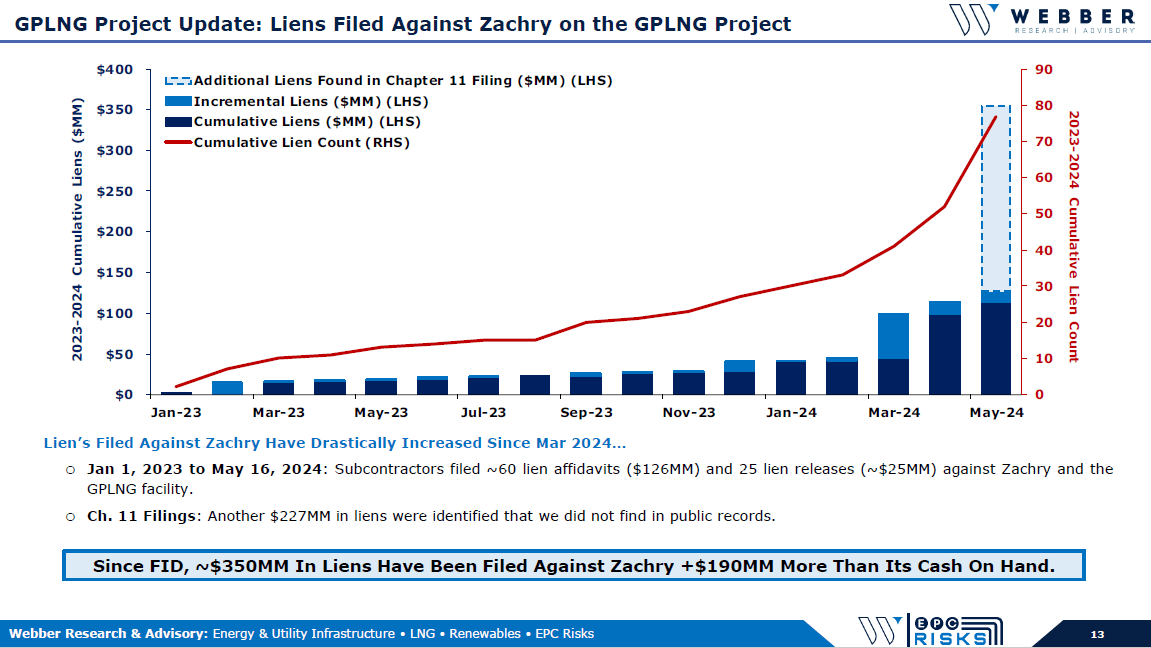
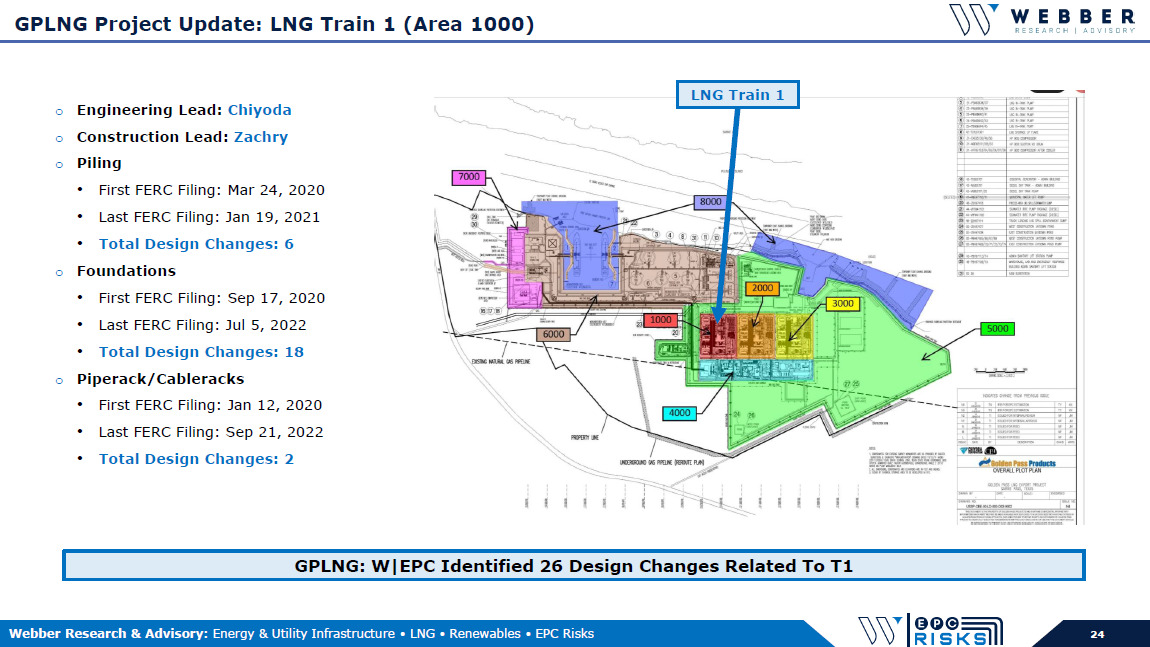

W|EPC: Sempra’s Costa Azul (ECA) LNG Project Update – Q224
To access the full report, please visit our Downloads Page. If you’re already a Webber Research Subscriber, you can access this report via our library. For access or subscription information, contact [email protected] or at i[email protected]




W|EPC: Golden Pass LNG Project Update – Q224
To download this report, click here. If you’re already a Webber Research subscriber, you can access this report via our library. For access information, contact us at [email protected], or at [email protected]


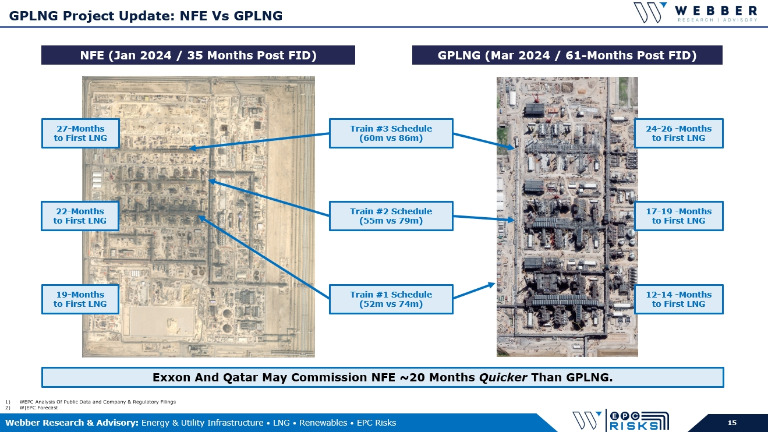
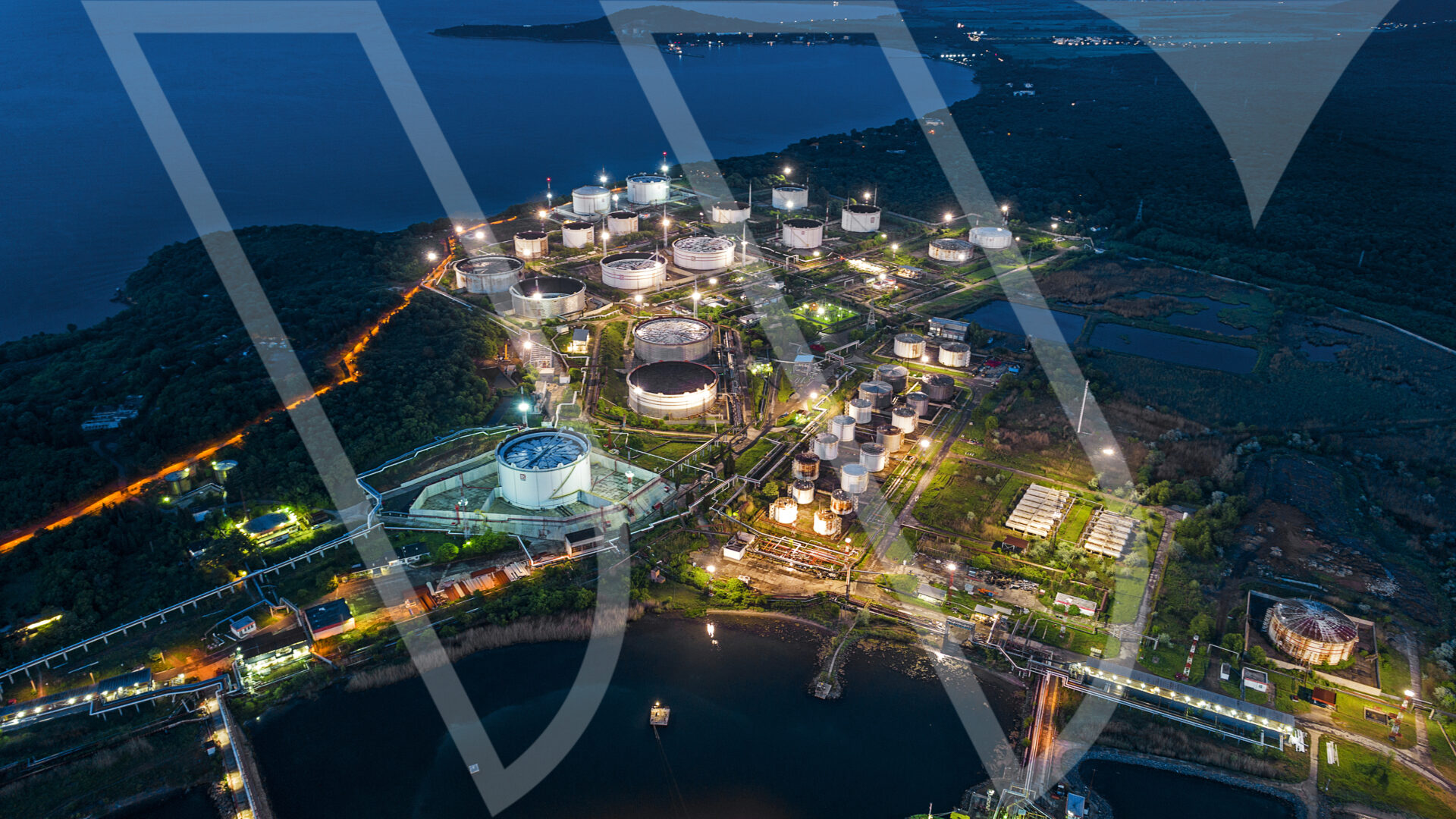

W|EPC: Venture Global’s Plaquemines LNG Project Update – Q224
To Download this report, click here. If you’re already a Webber Research subscriber, you access this report via our library. For access information, email us at [email protected] or at [email protected].


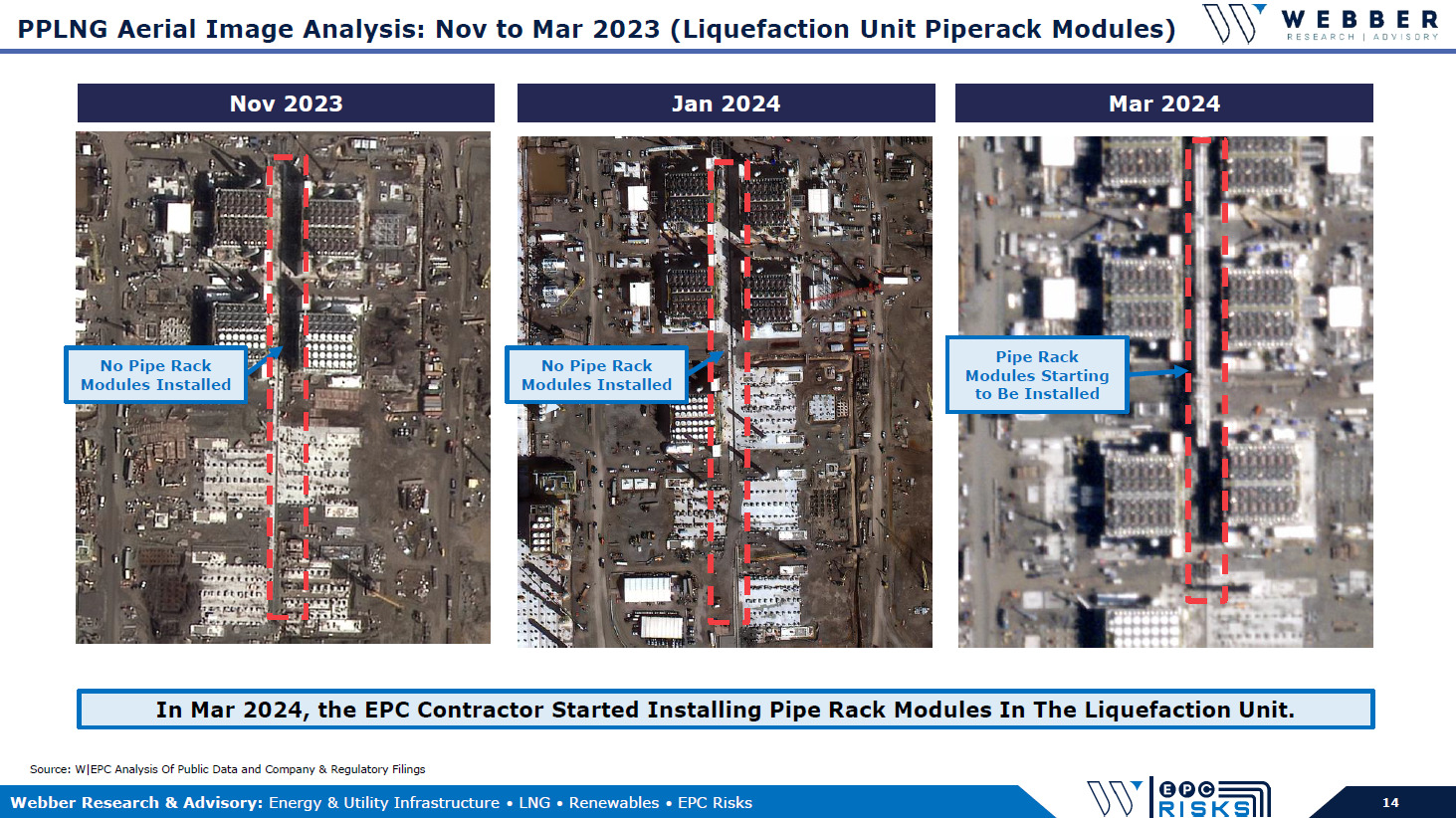

W|EPC: LNG Canada Project Update – Q124
To download this report, click here. If you’re already a Webber Research subscriber, click here. For access information, please contact us at [email protected], or [email protected].


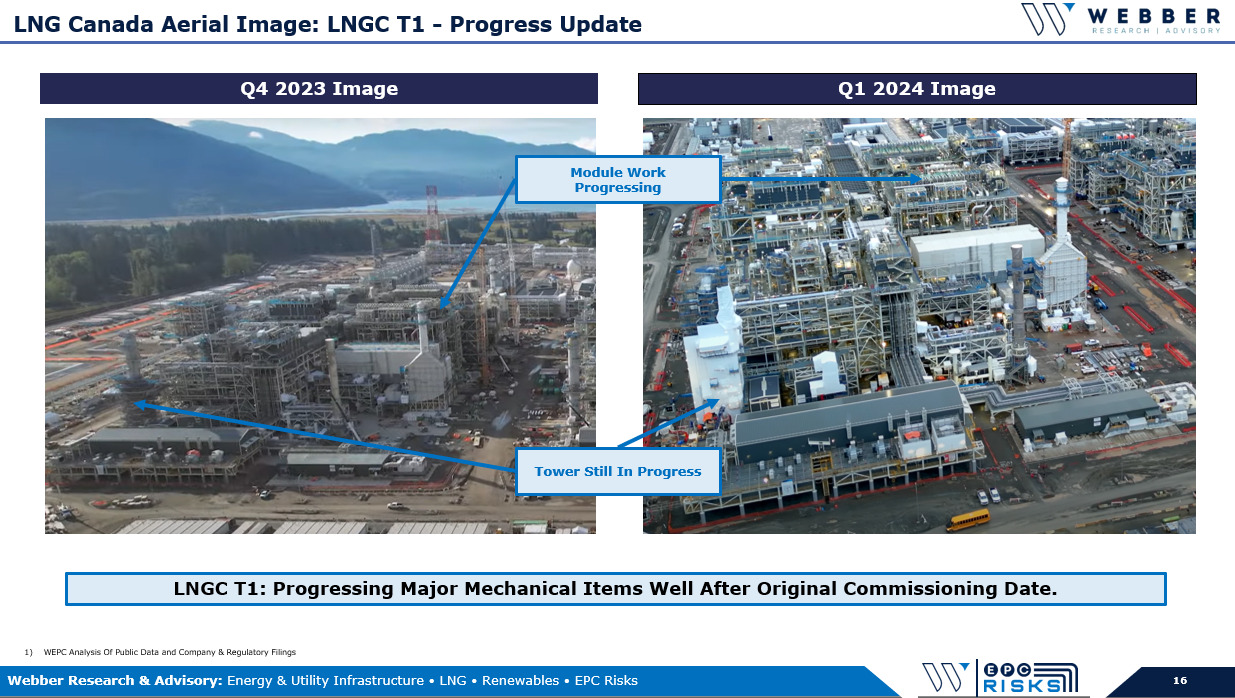

W|EPC: Qatar LNG – North Field Expansion – Q124 Project Update
To download this report, click here. If you’re already a Webber Research subscriber, you can access this report via our research library. If you’re not a a subscriber, contact us at [email protected] or [email protected].
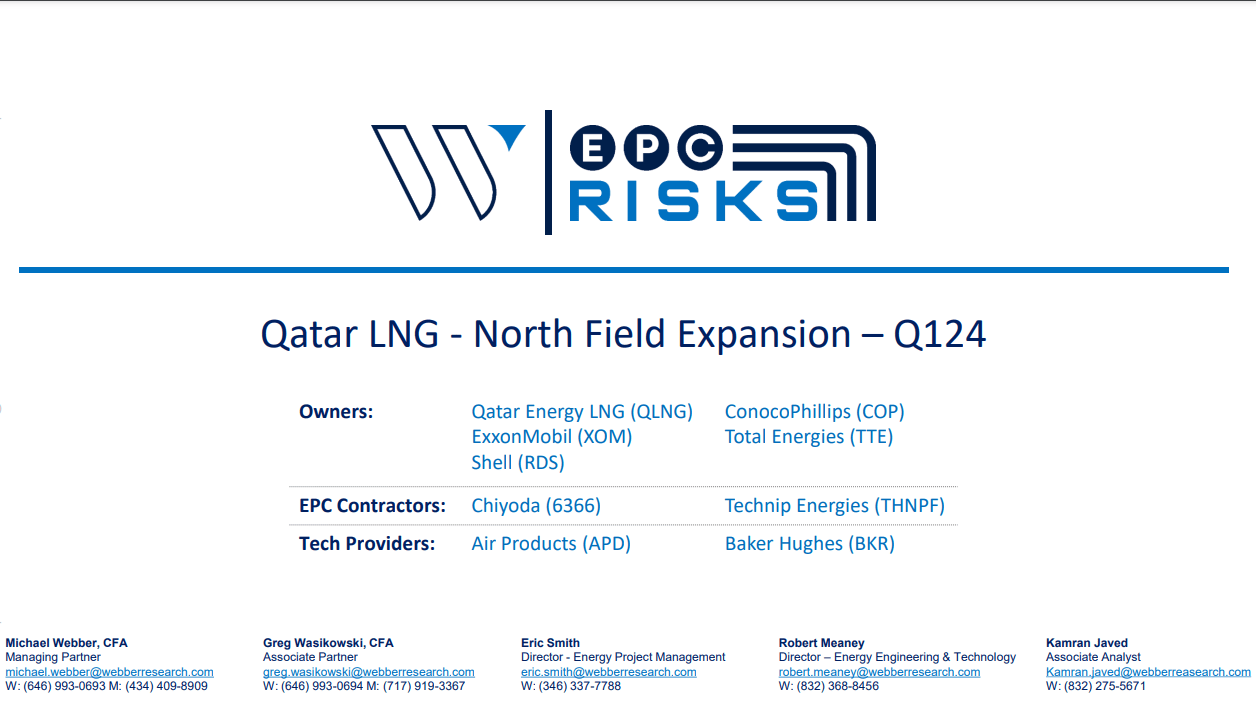



W|EPC: Dow Chemical’s $7B Net Zero Ethylene Cracker, Early Analysis – Q124
To download this report, click here. If you’re already a Webber Research subscriber, you can access this report via our Library. For access information, please contact Walter Lobo, or reach out to us at [email protected].
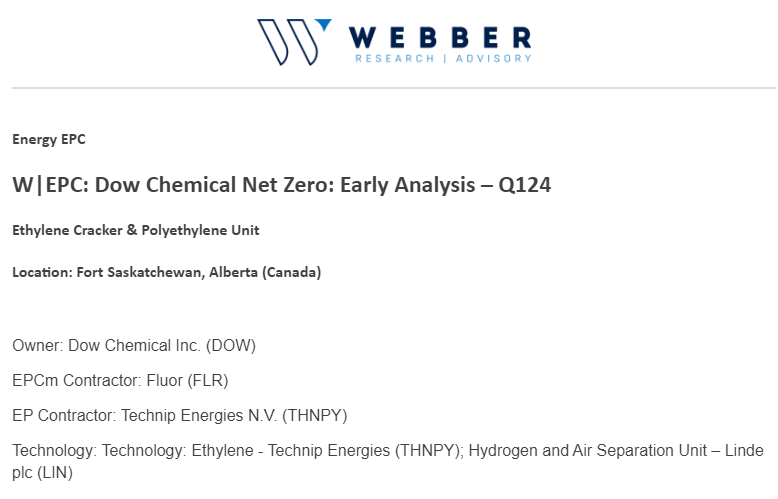


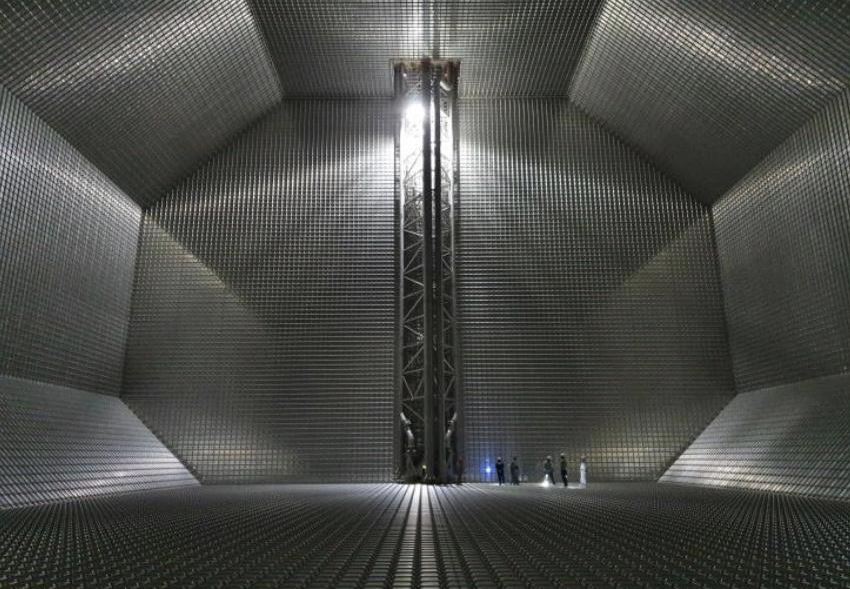

W|EPC: Plaquemines Parish LNG – Q124 Update
To download this report, click here. For access information, please contact us at [email protected], or at [email protected]



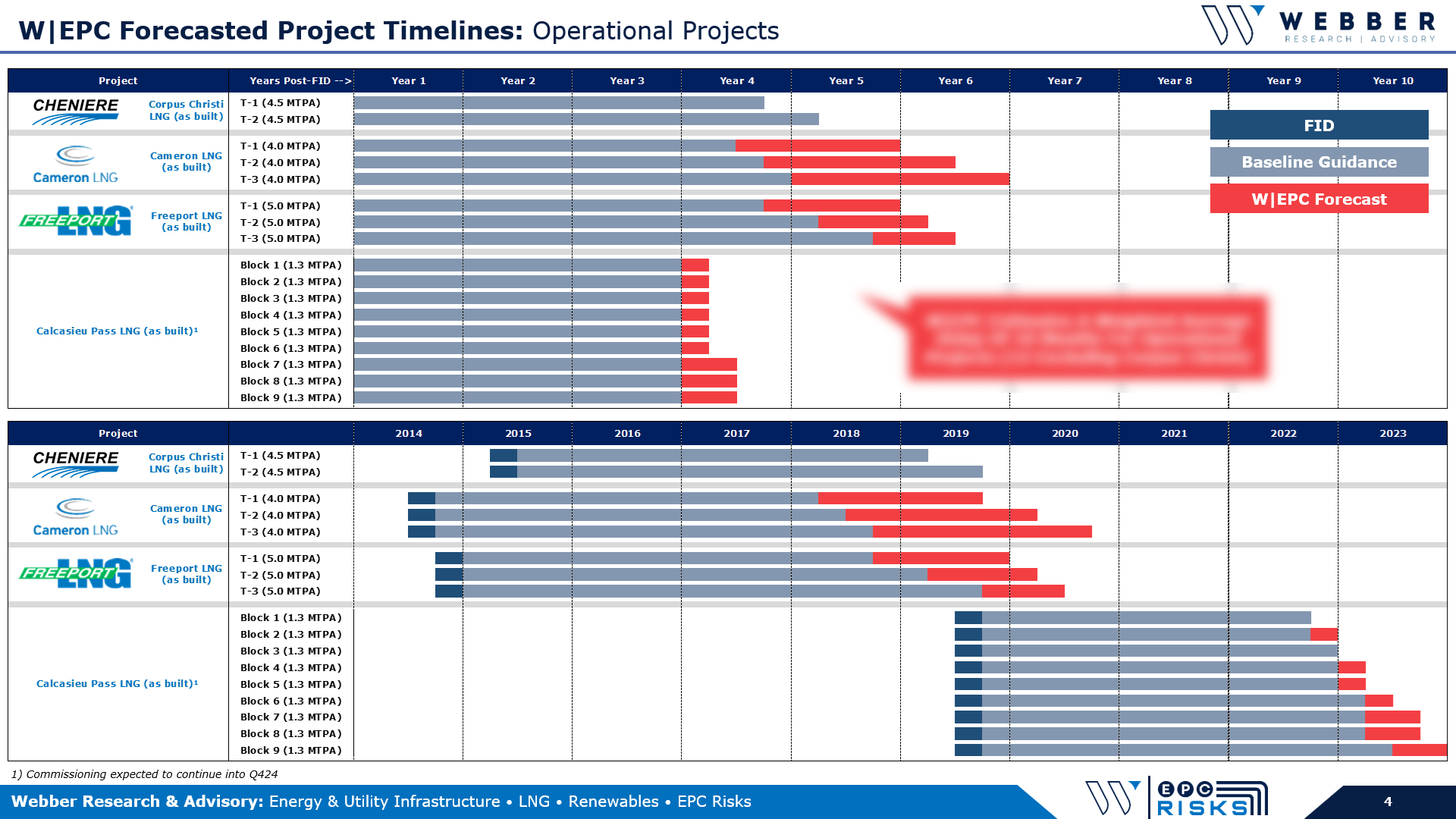
W|EPC: Forecasted LNG Project Timelines – Q423 Update

If you’re a current Webber Research subscriber, you can click here to access this presentation in our library. If you’re not yet a subscriber, please contact us at Walter Lobo for access information. To download this presentation, click here.



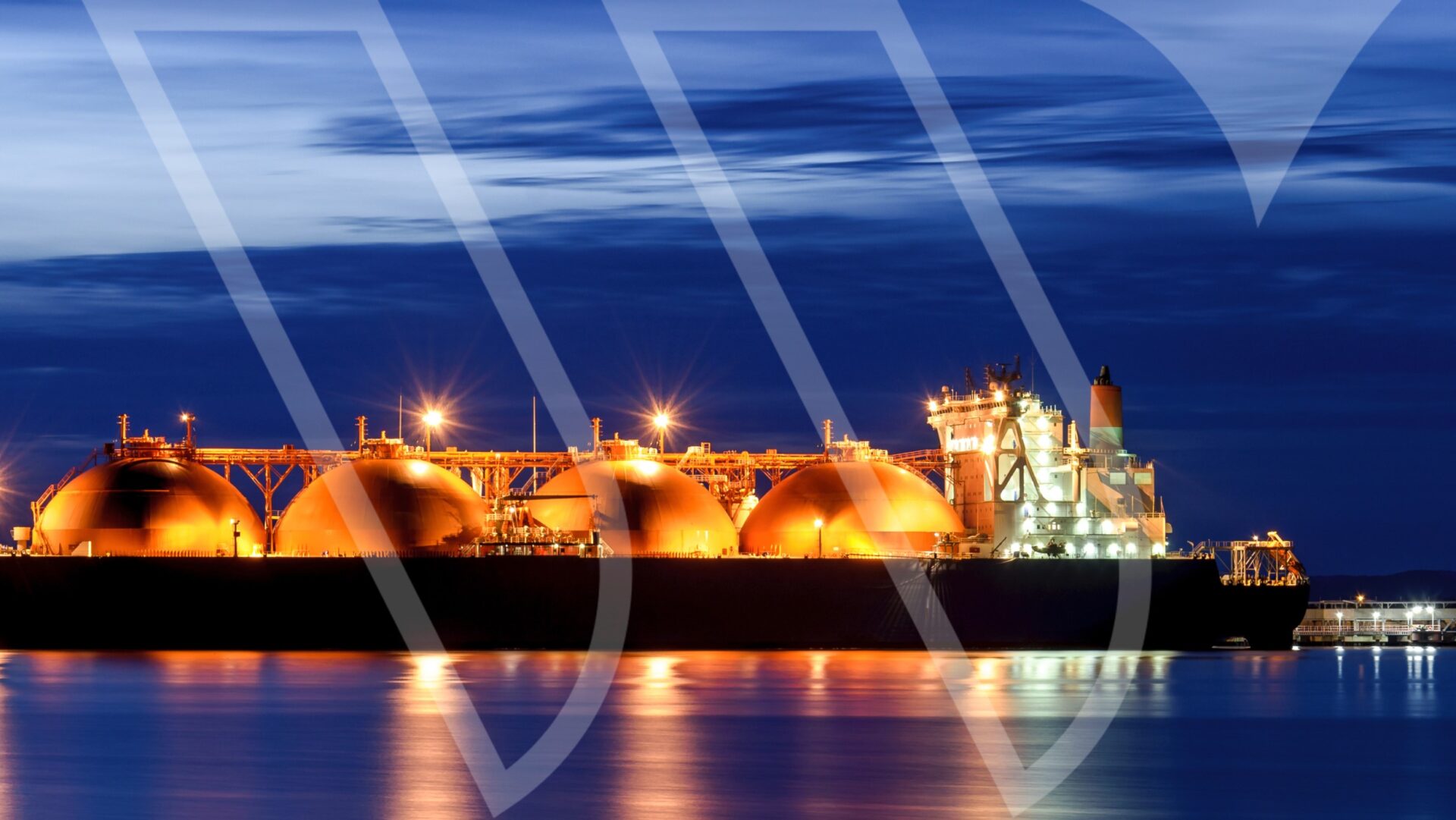
W|EPC: Golden Pass LNG Project Update – Q423
If you’re already a Webber Research subscriber, this report is available via our research library. For access information, email us at [email protected]. To download this report, click here.
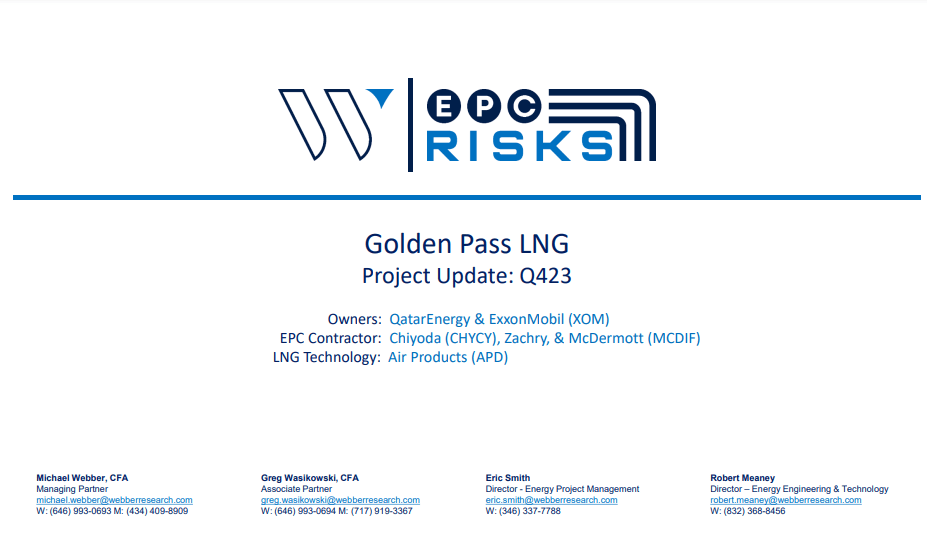
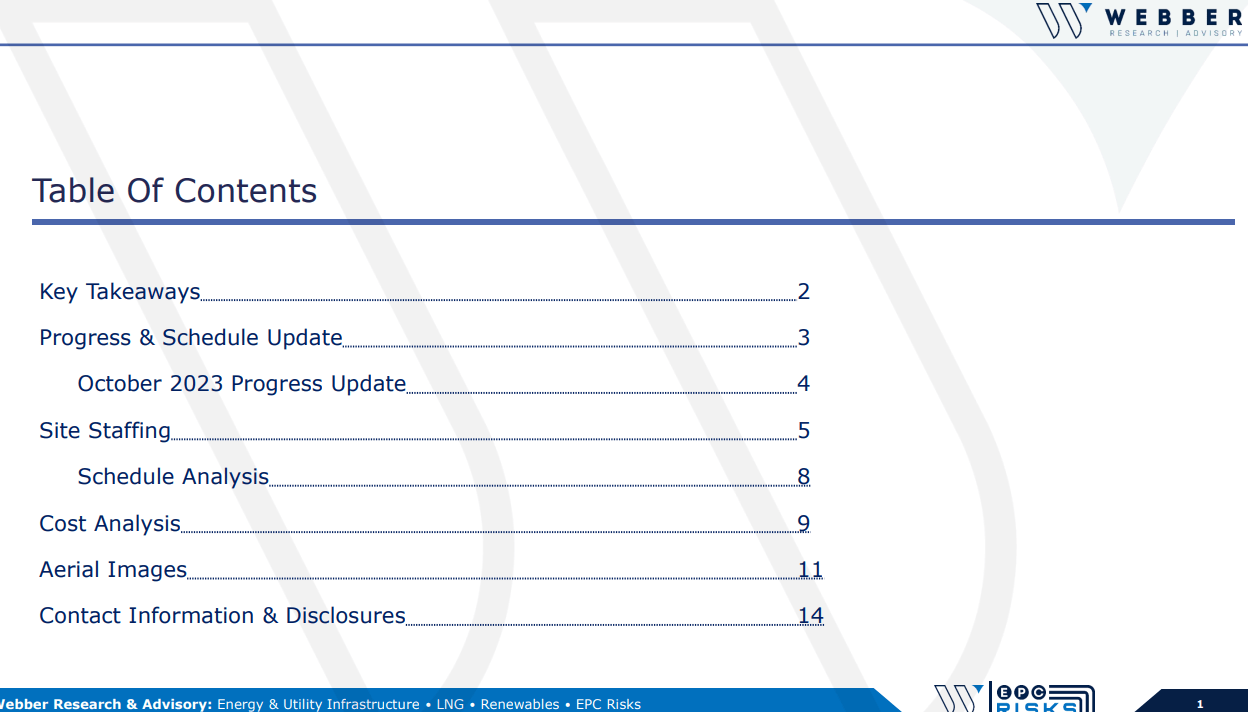
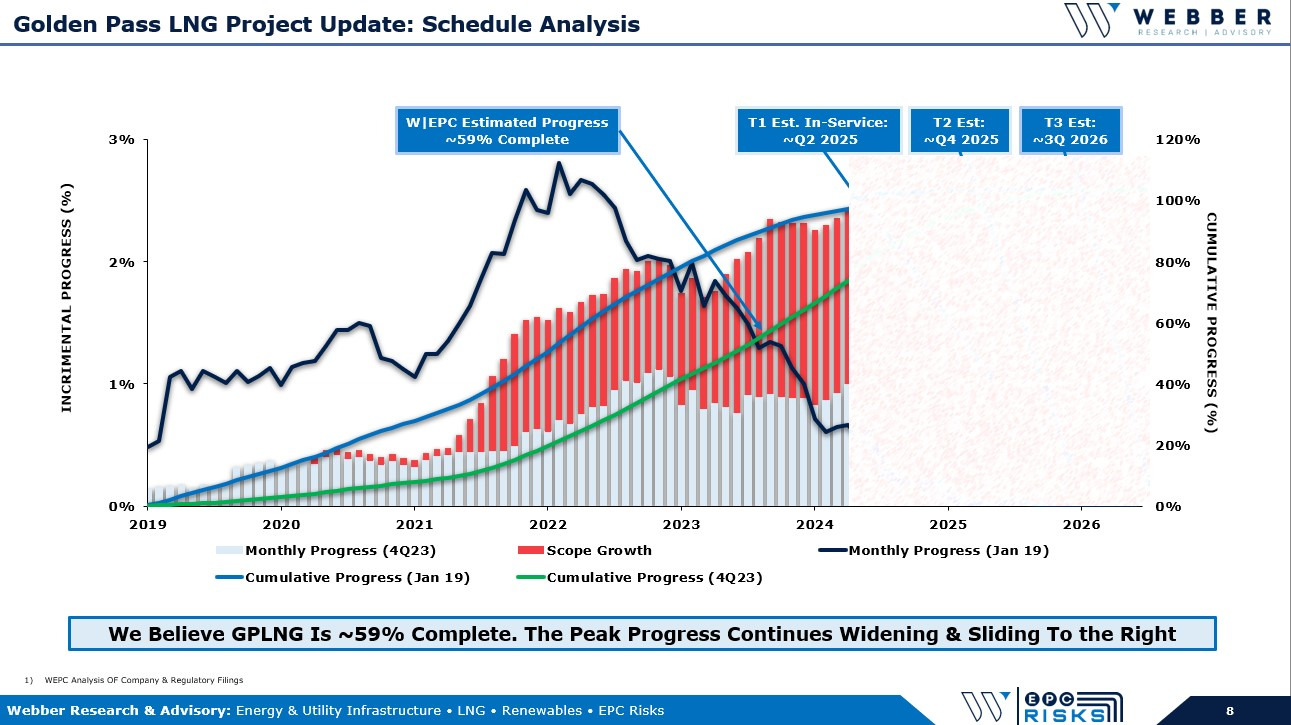

W|EPC: LNG Canada Project Update – Q423
If you’re already a Webber Research subscriber, this report is available via our research library. For access information, email us at [email protected]. To download this report, click here.
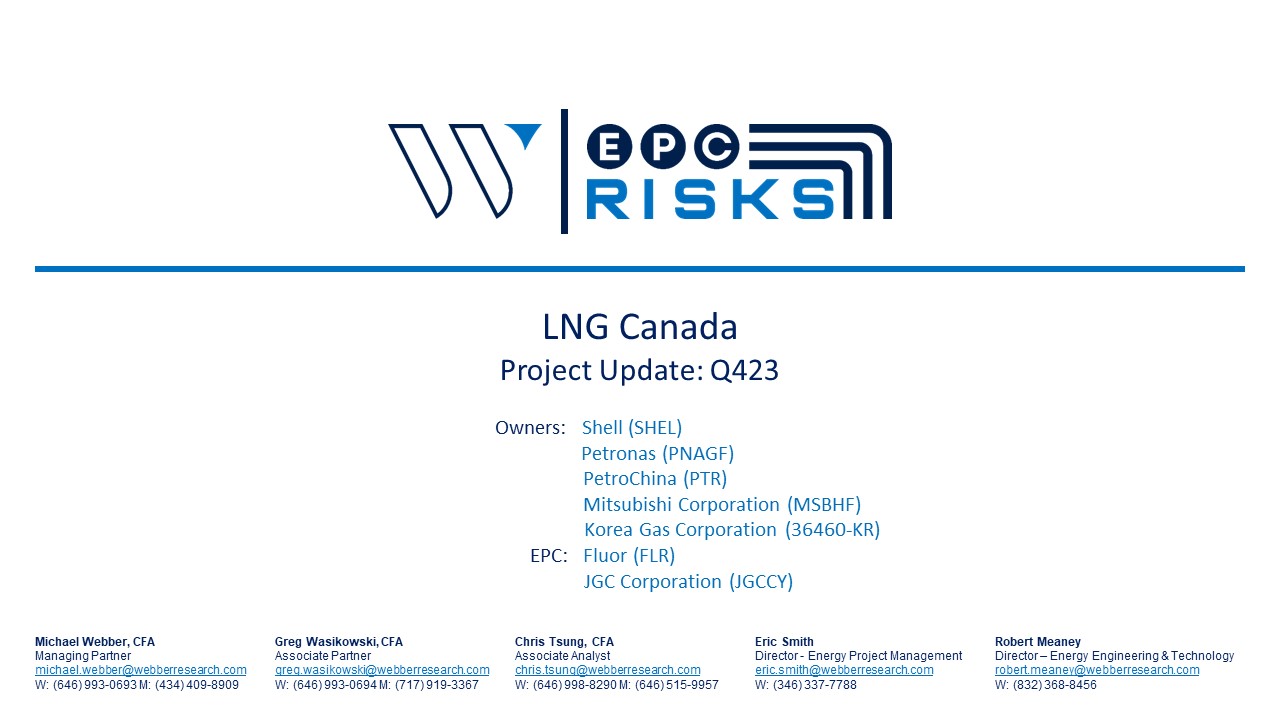
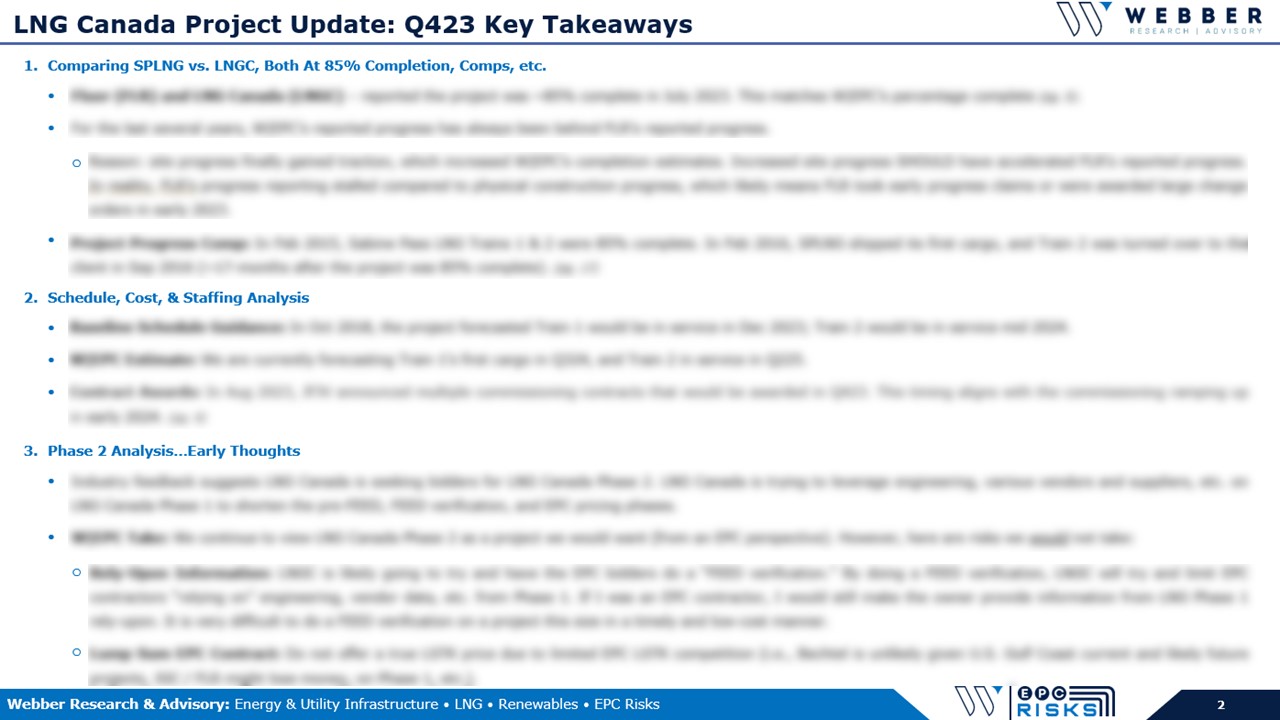

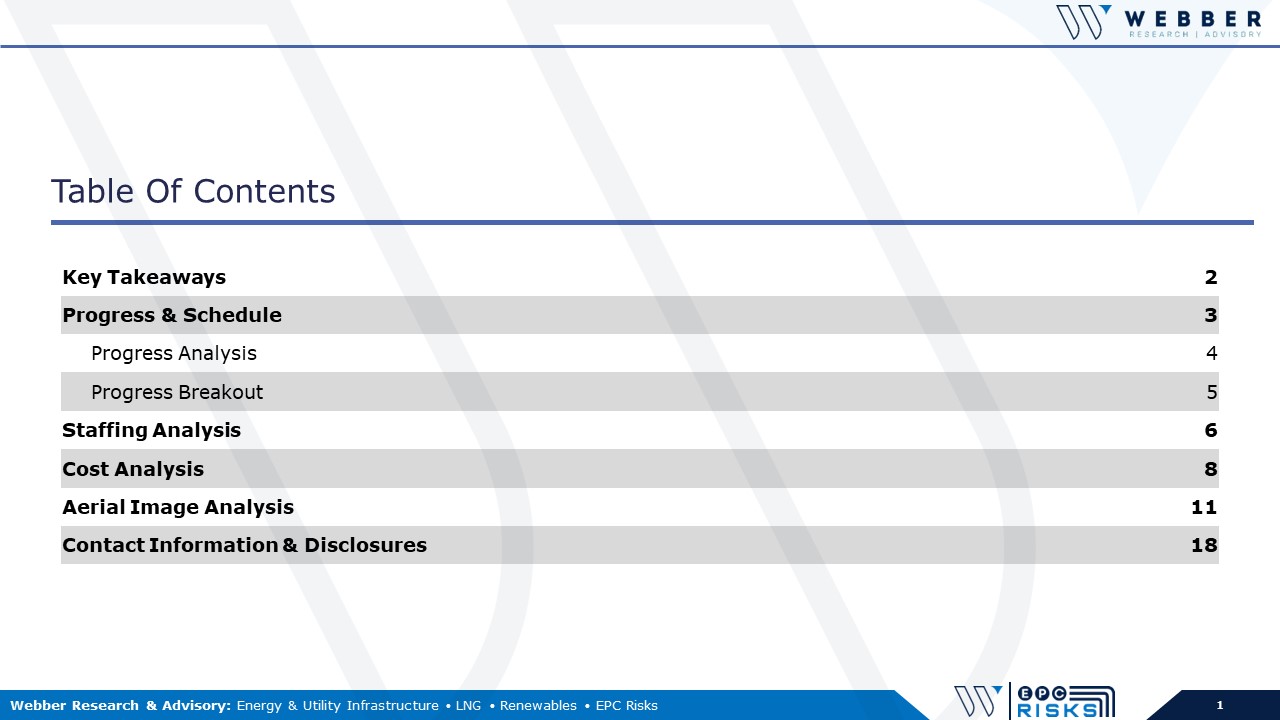

W|EPC: Sempra’s Costa Azul (ECA) Phase 1 Project Update – Q423
If you’re already a Webber Research subscriber, this report is available via our research library. For access information, email us at [email protected]. To download this report, click here.
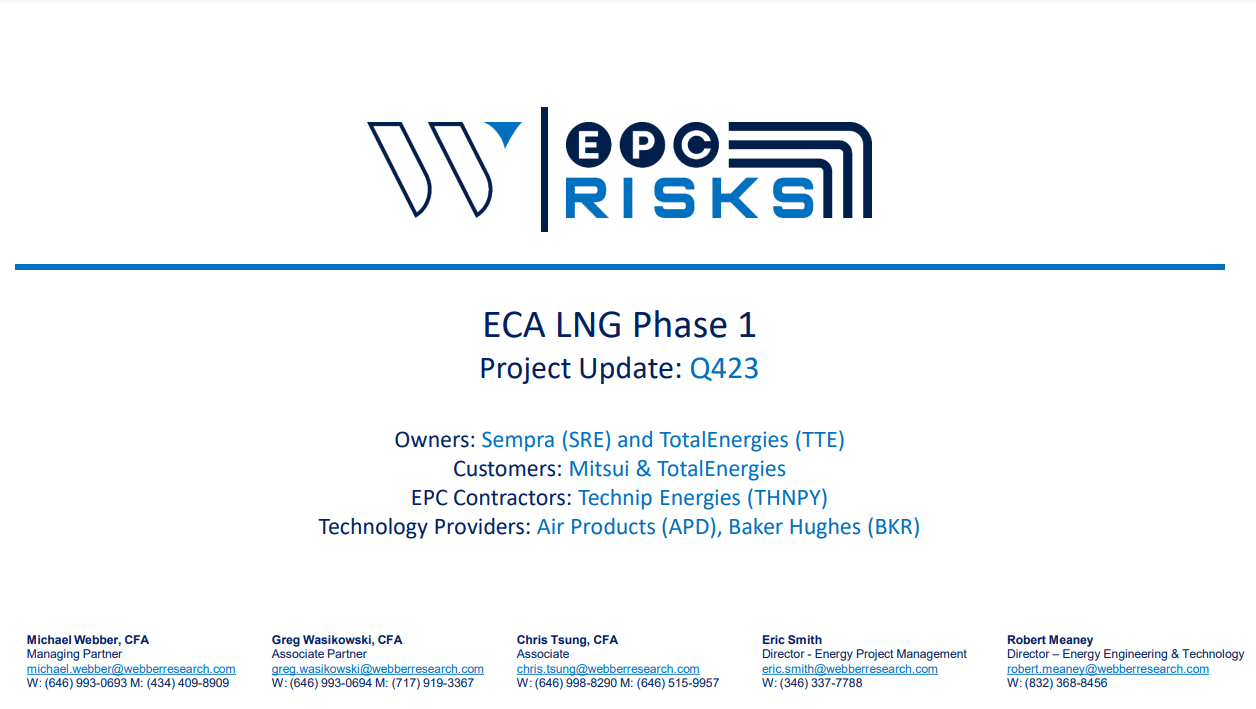

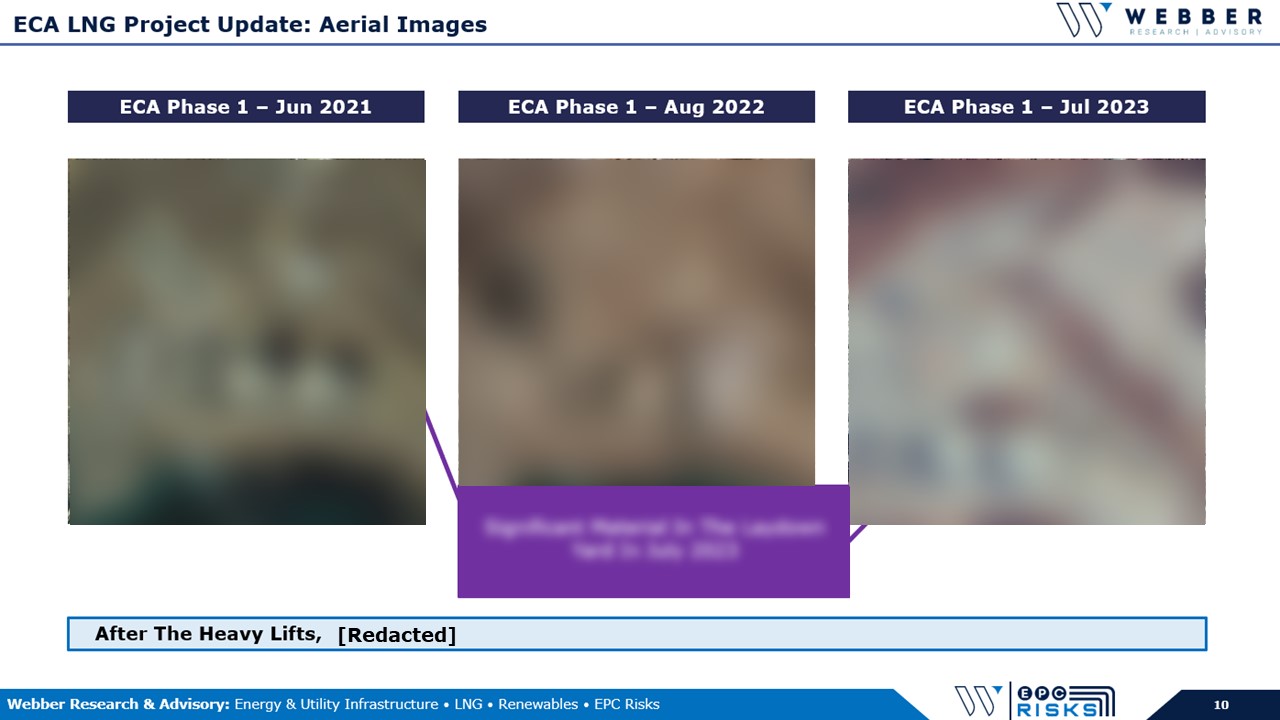

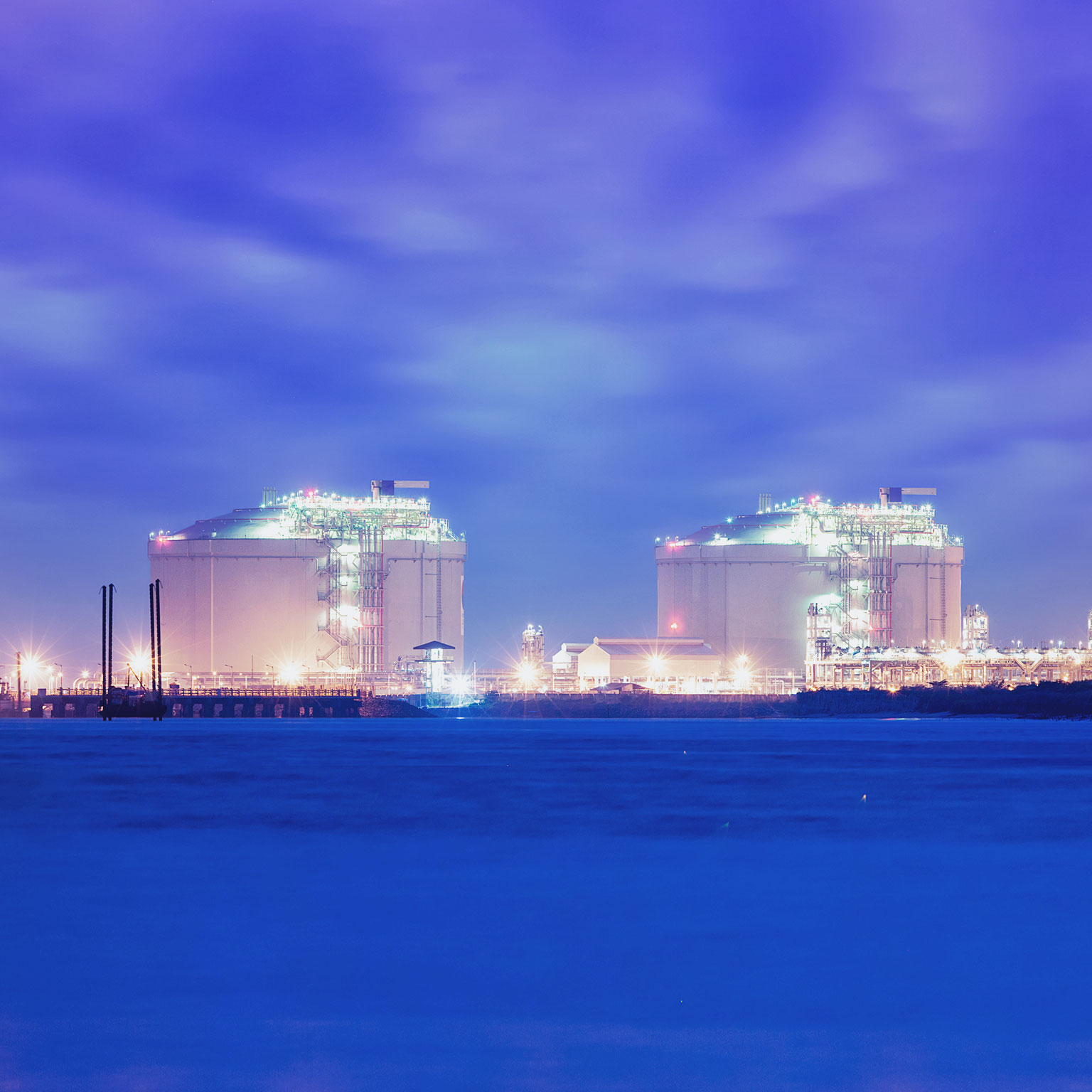
W|EPC: Venture Global’s Plaquemines Parish LNG – Q323 Project Update
If you’re already a Webber Research subscriber, you can access this report via our W|EPC Research Library. If you’re not yet a subscriber and would like to download this report, click here. For access or subscription information, email us at [email protected].



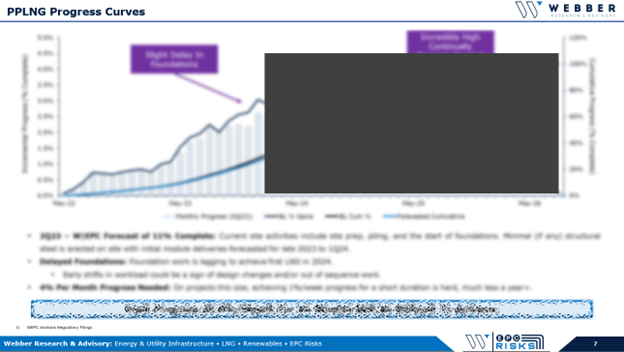
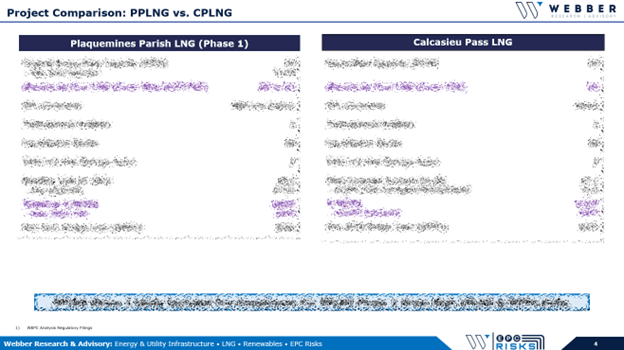
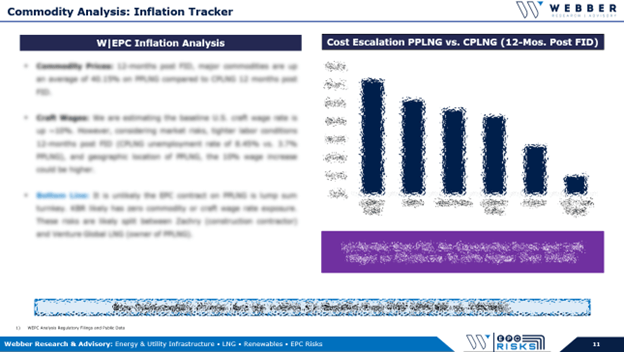
Read More
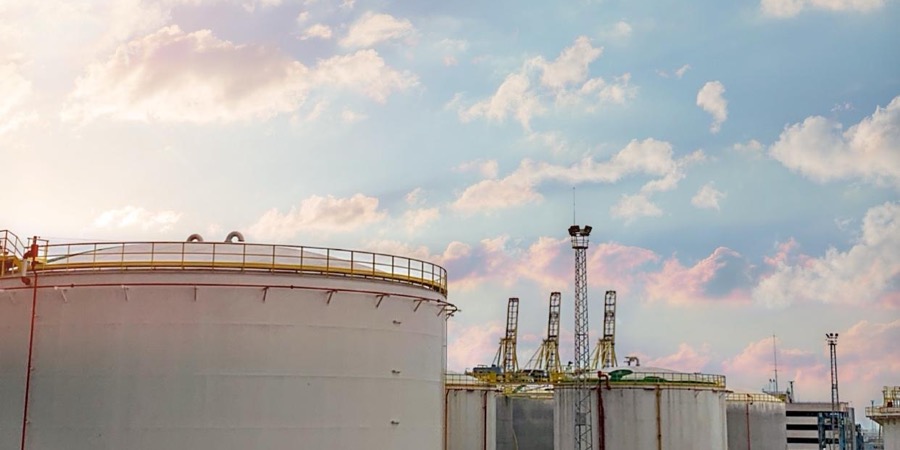
W|EPC: Kinder Morgan’s Elba Island – Analyzing ~$350MM In Project Claims vs. EPC LSTK Wraps (May 2023)***
For access information, contact us at [email protected] or at [email protected]. To download this report, please click here.
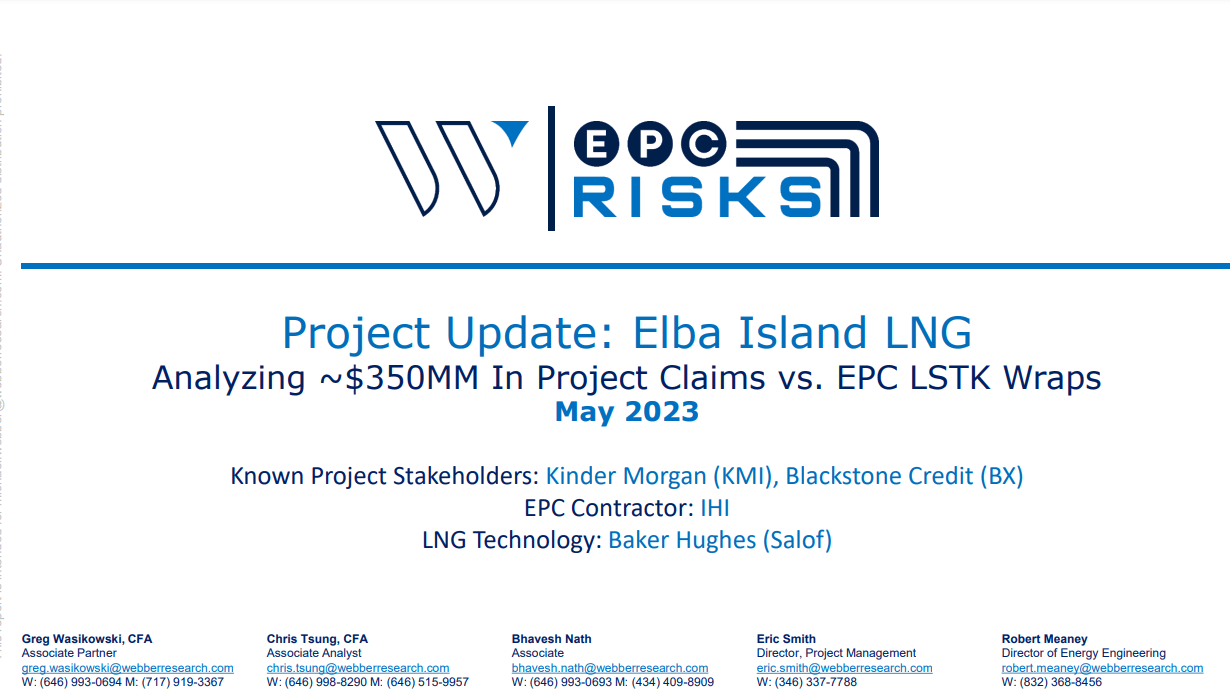

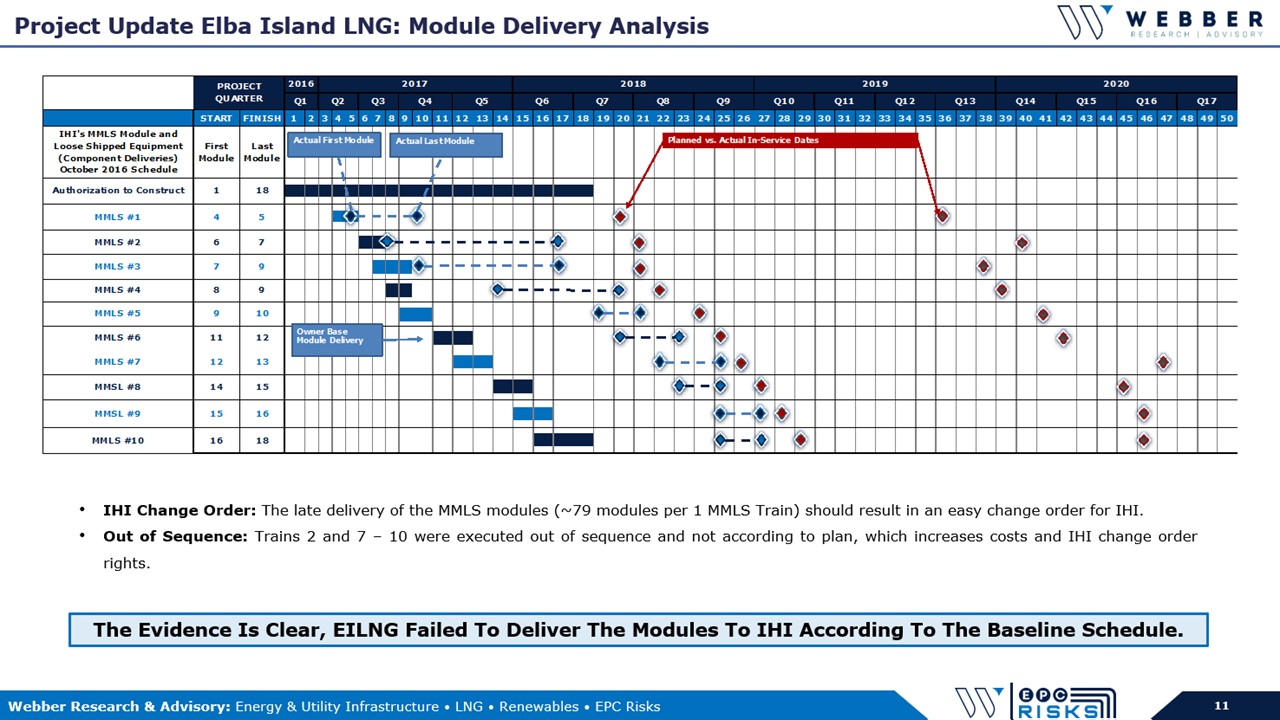
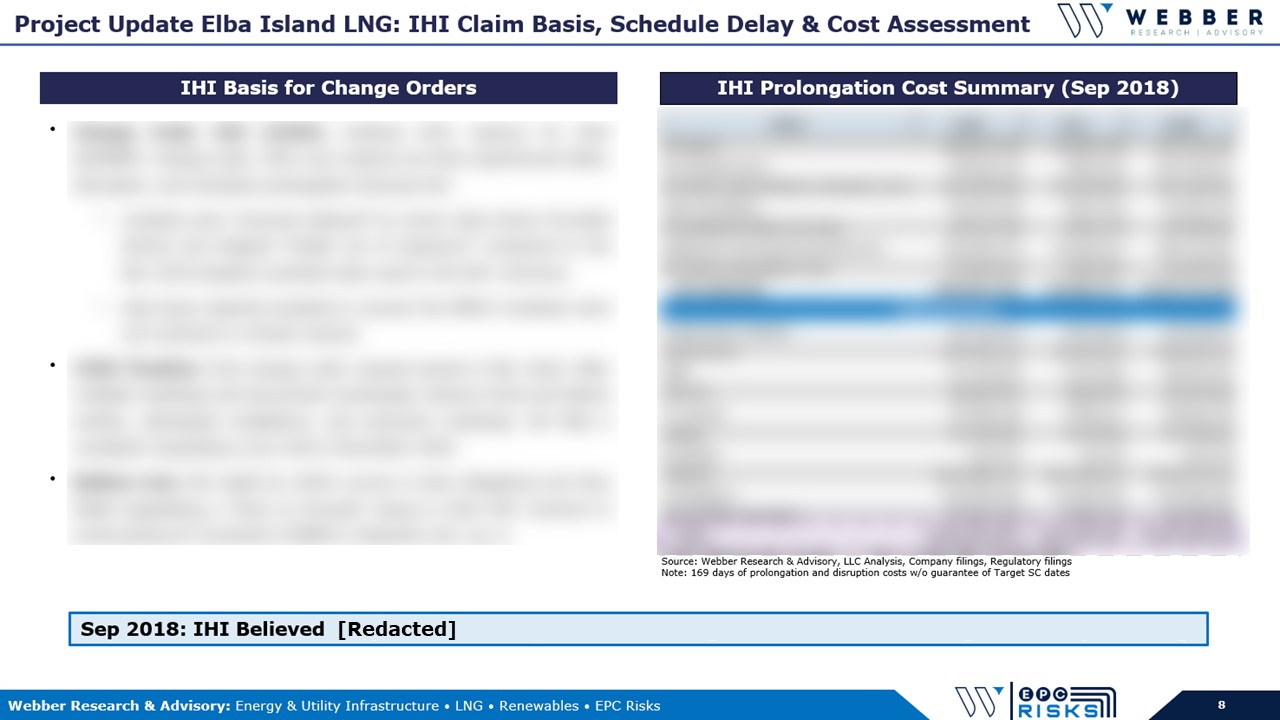


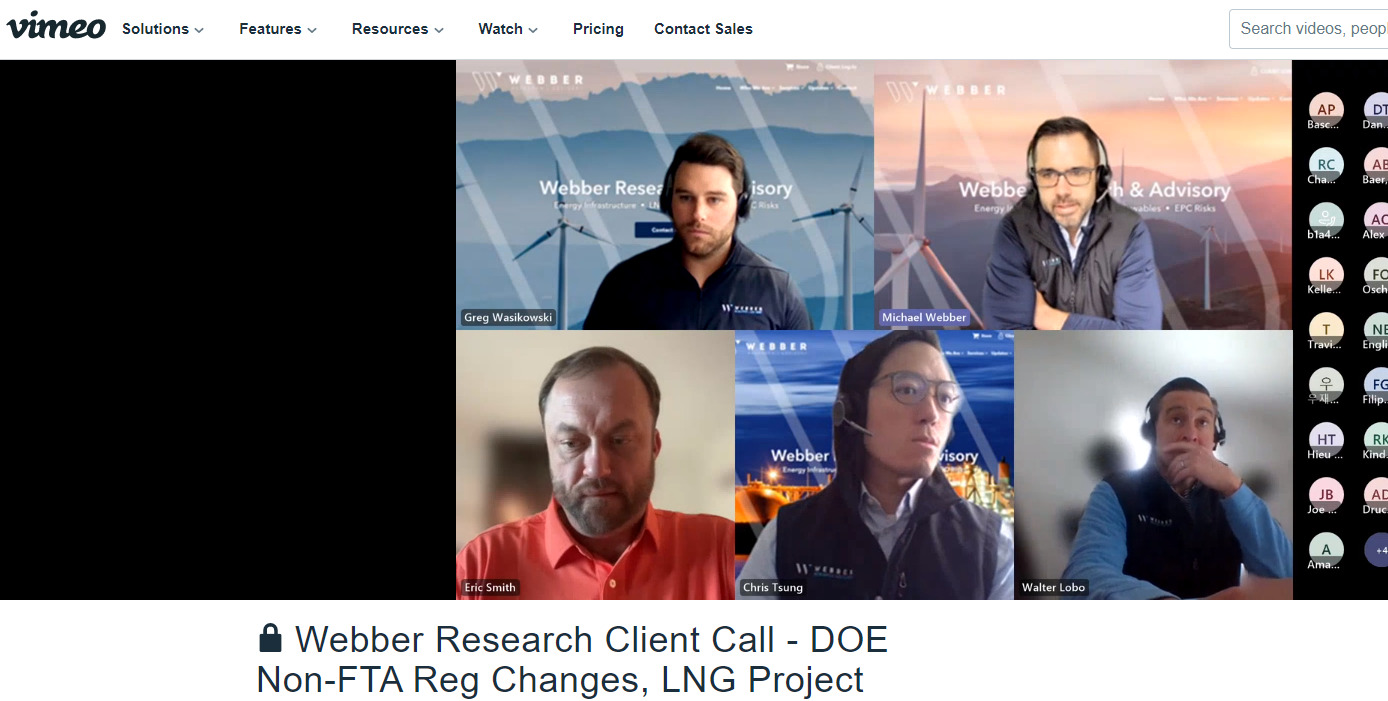
Conference Call Replay: Changes To DOE’s Non-FTA Process: Impact on Global LNG
For replay information, please reach out to [email protected]
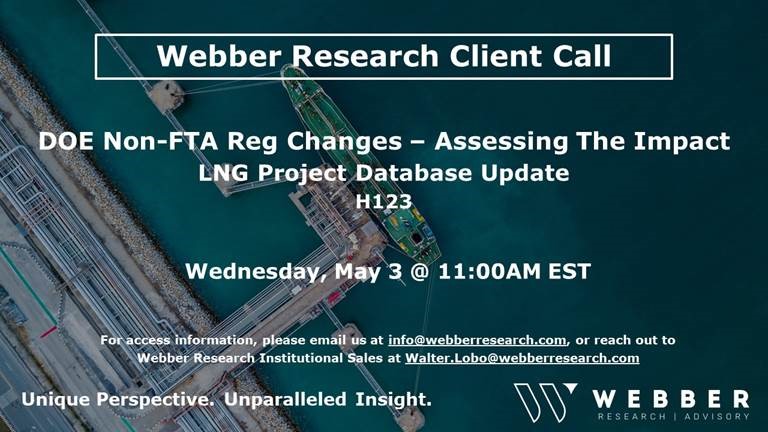

W|EPC: DOE Non-FTA Reg Changes & LNG Project Database Update Summary
For access information, contact us at [email protected] or [email protected]. To download this report, please click here.


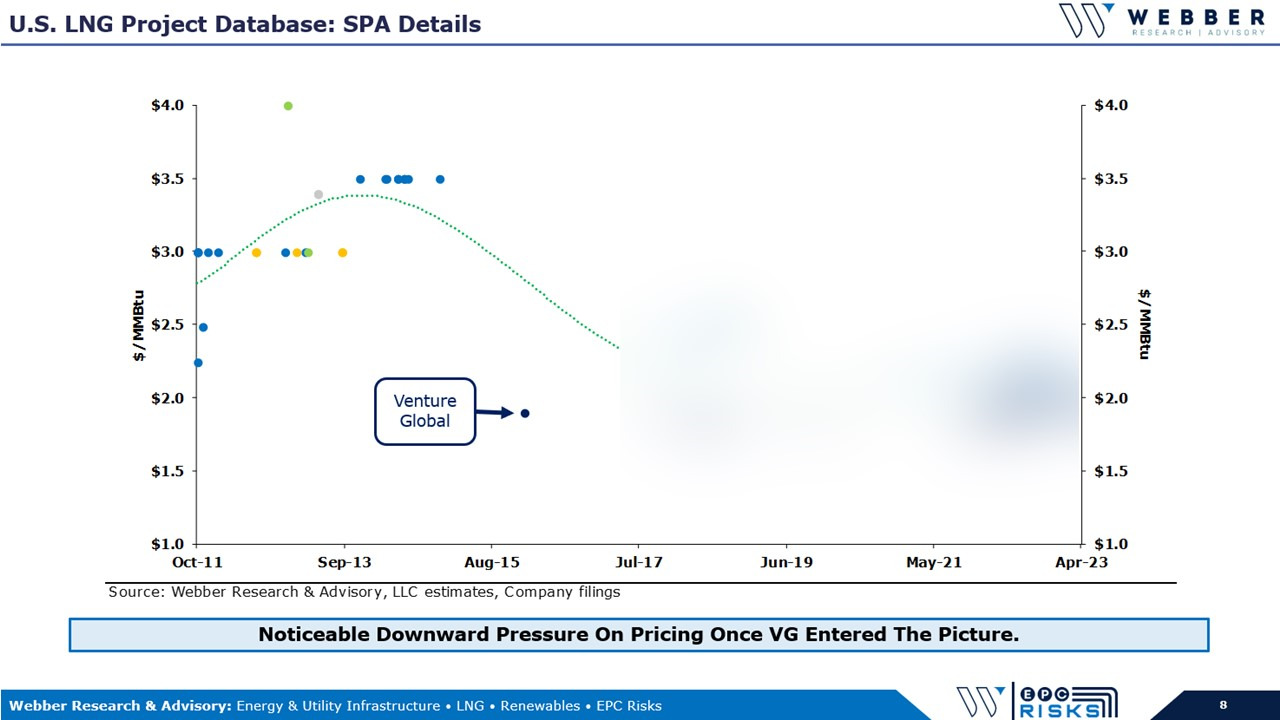
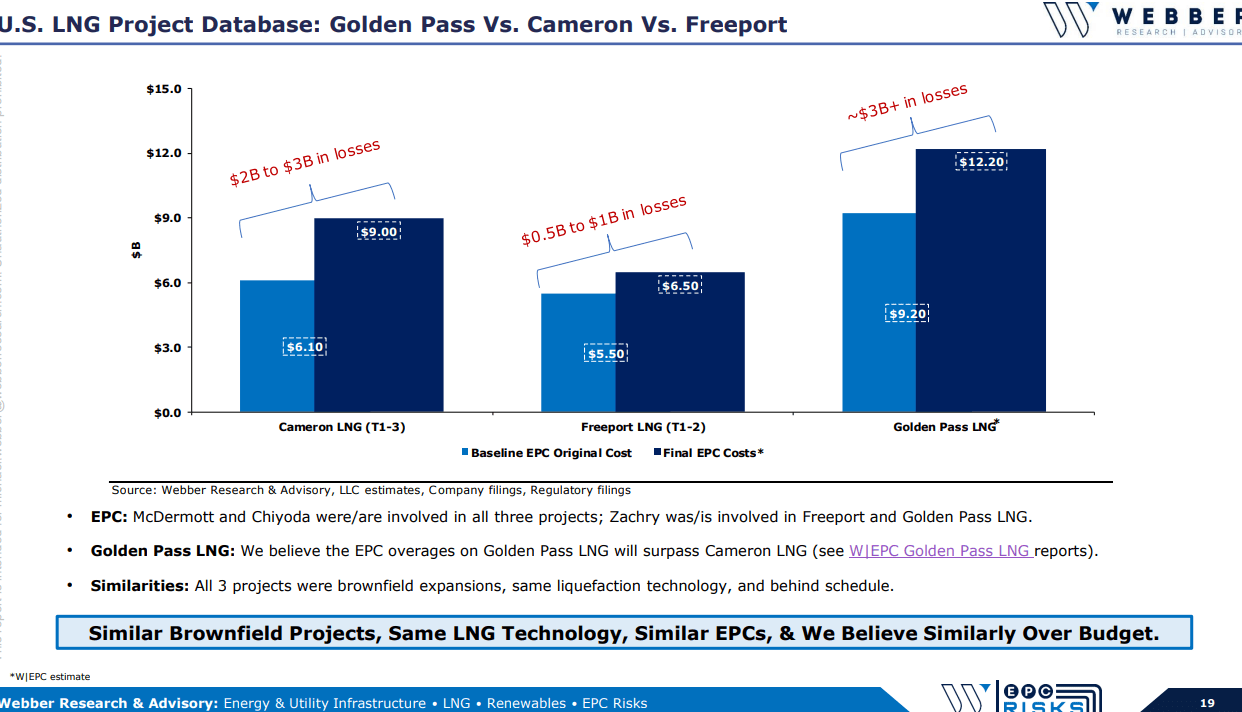
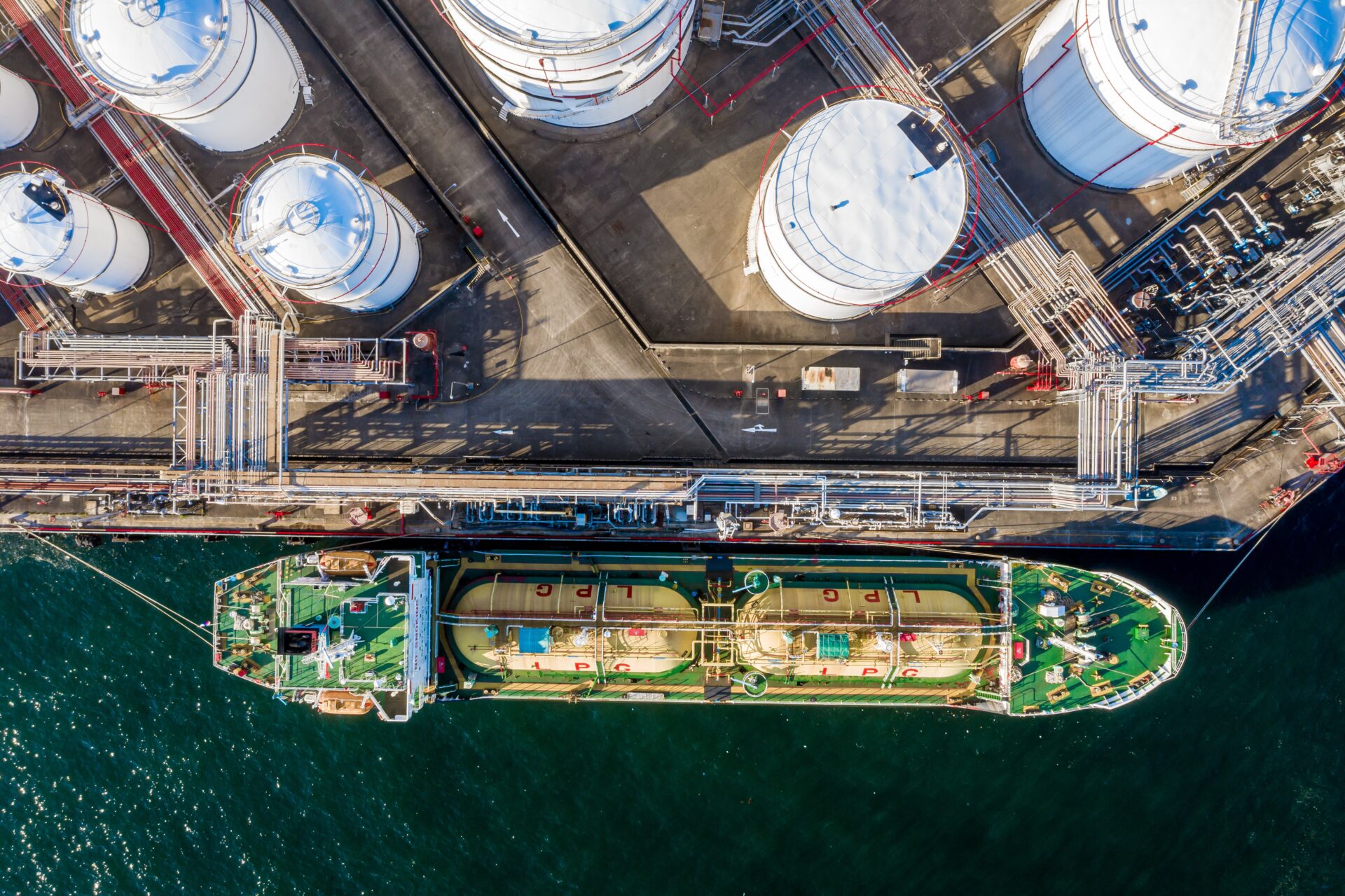
W|EPC: Golden Pass LNG – Project Timeline & Cost Estimates, Satellite Image Review – Q223
For access information, contact us at [email protected] or at [email protected]. To download this report, please click here.
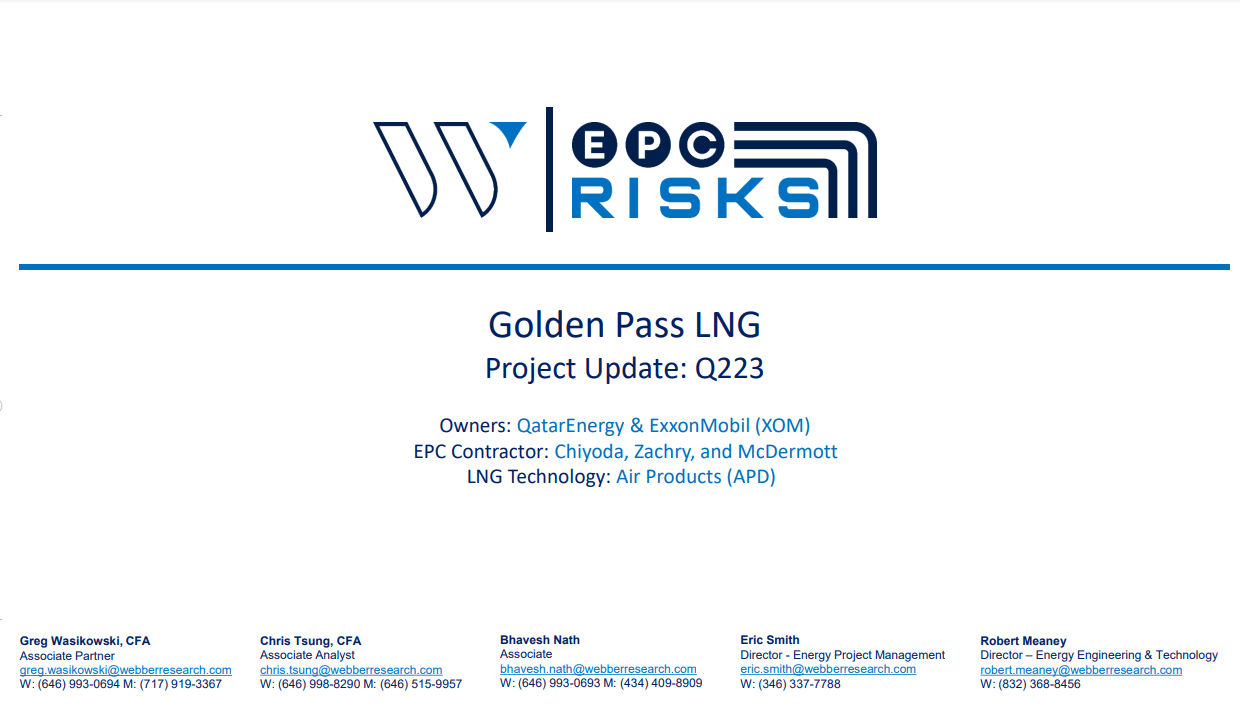



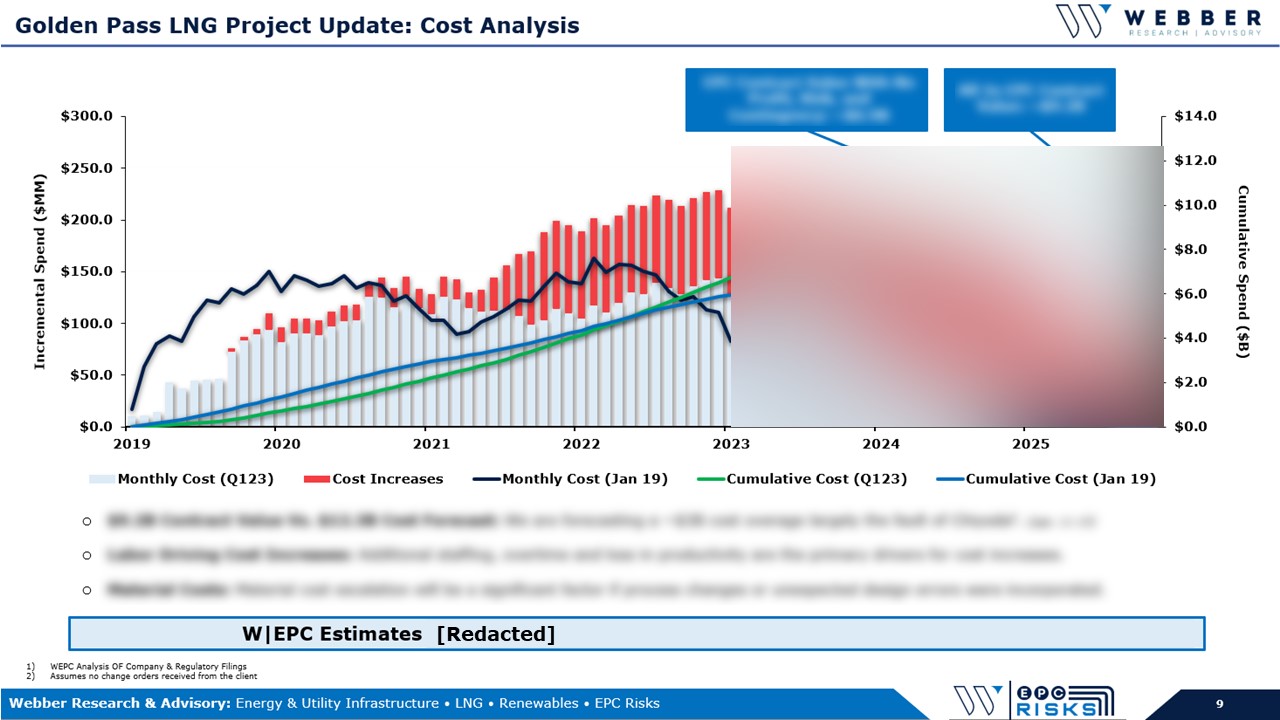
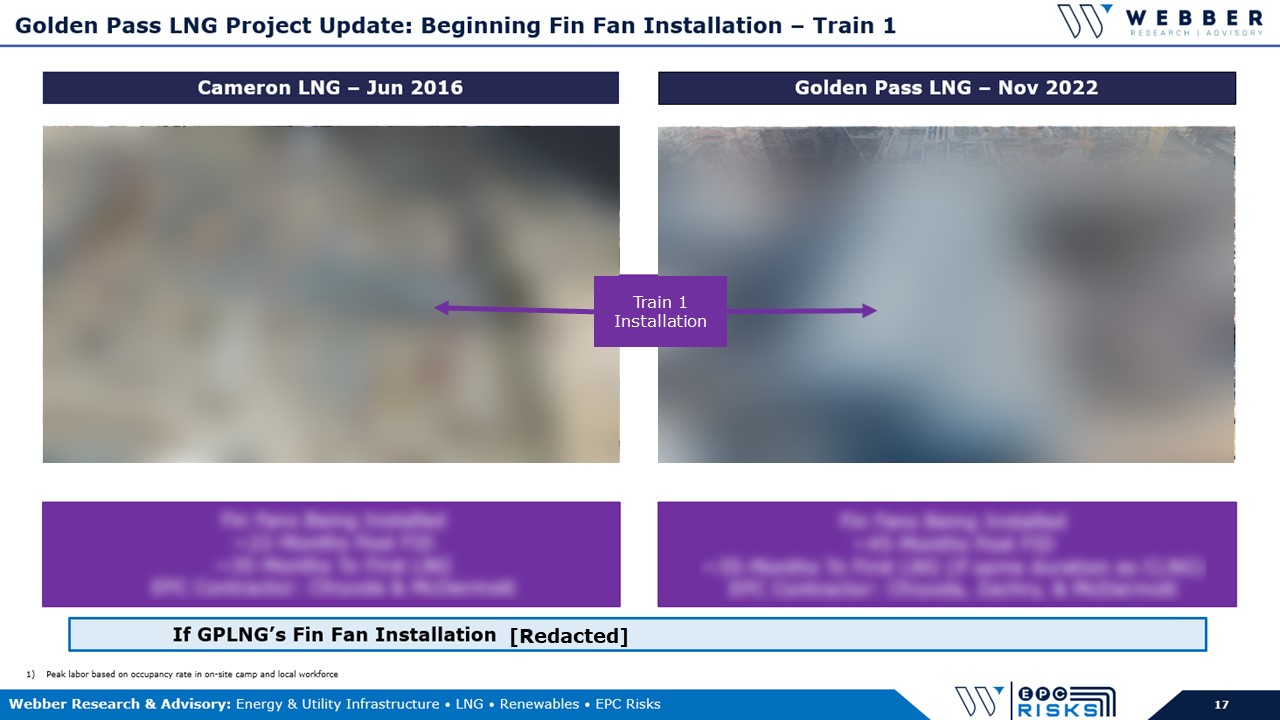

W|EPC: LNG Canada Project Update Q123 – Data & Satellite Image Review
For access information, contact us at [email protected] or at [email protected]. To download this report, please click here.
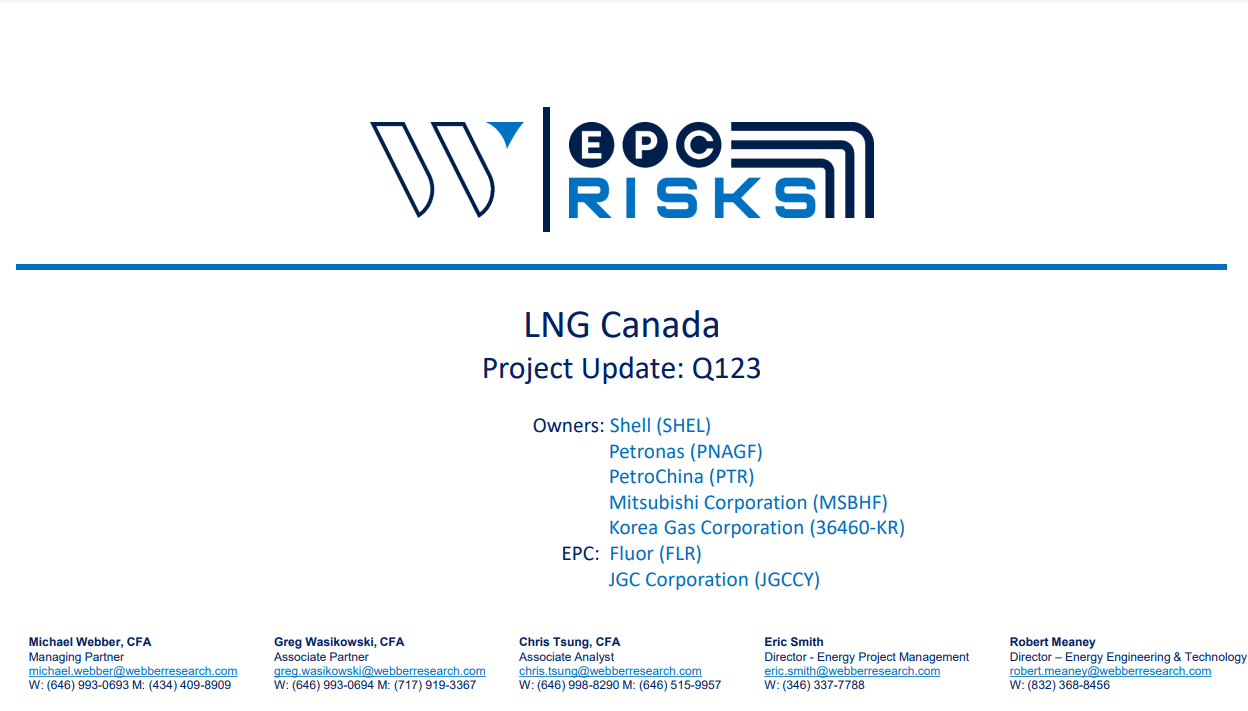


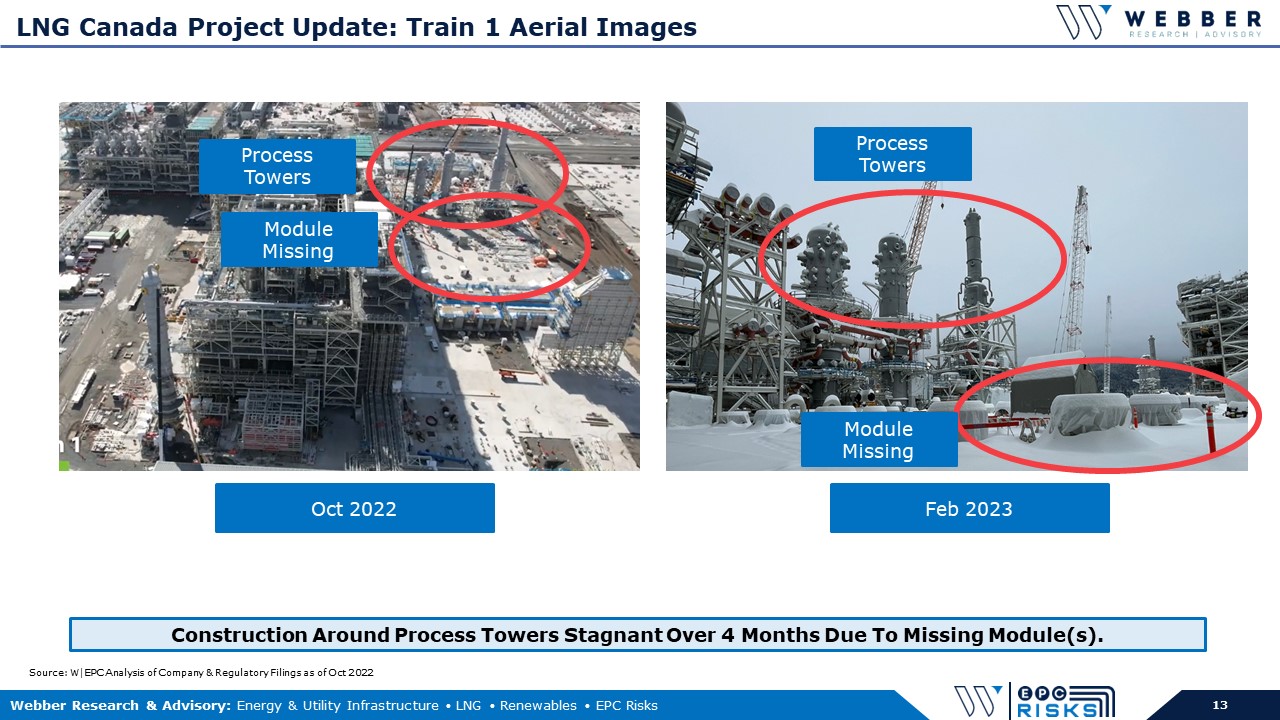

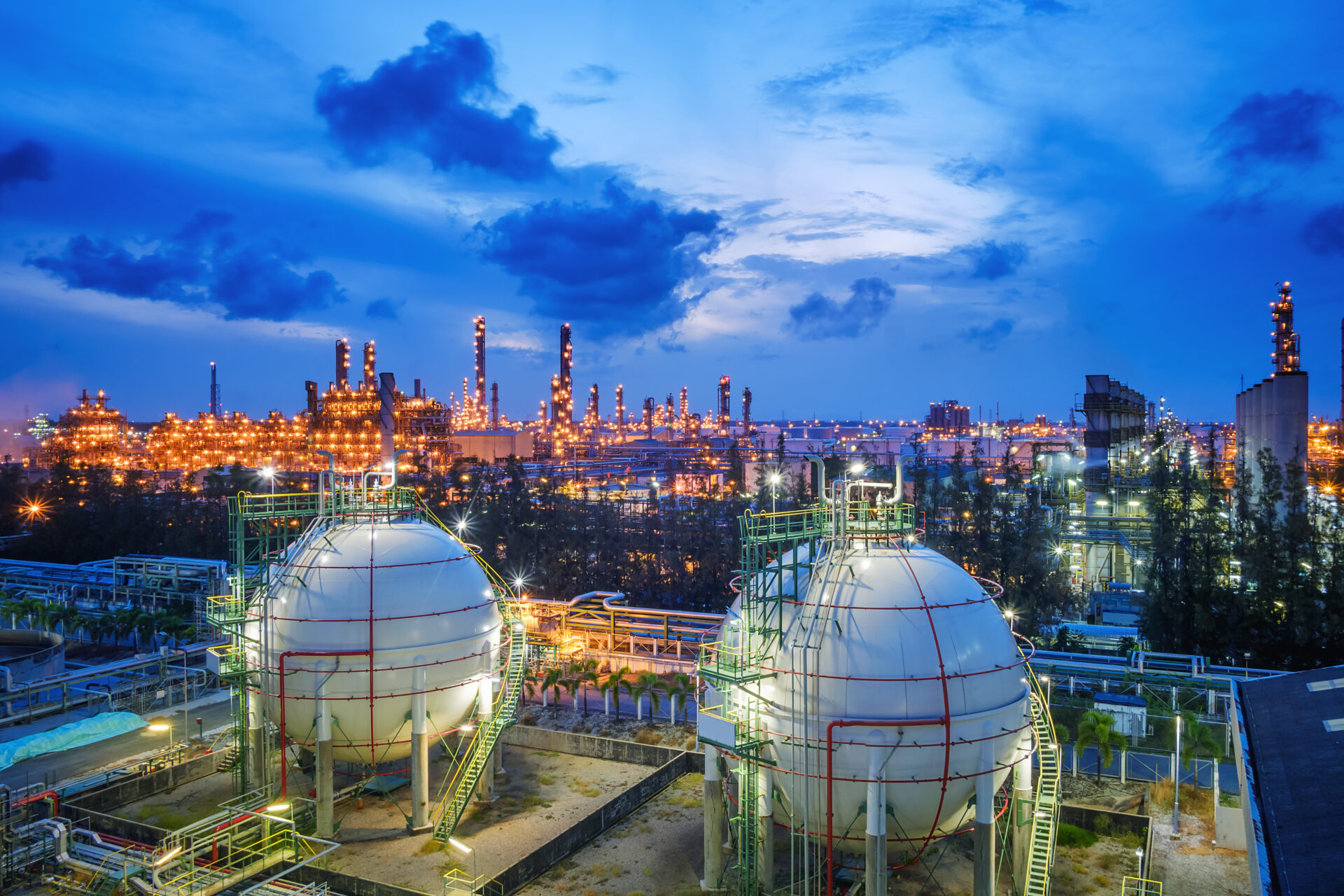
W|EPC: Freeport LNG Train 4 – Project Update Q123
For access and subscription information, please email us at [email protected], or at [email protected]. To download this report, click here.



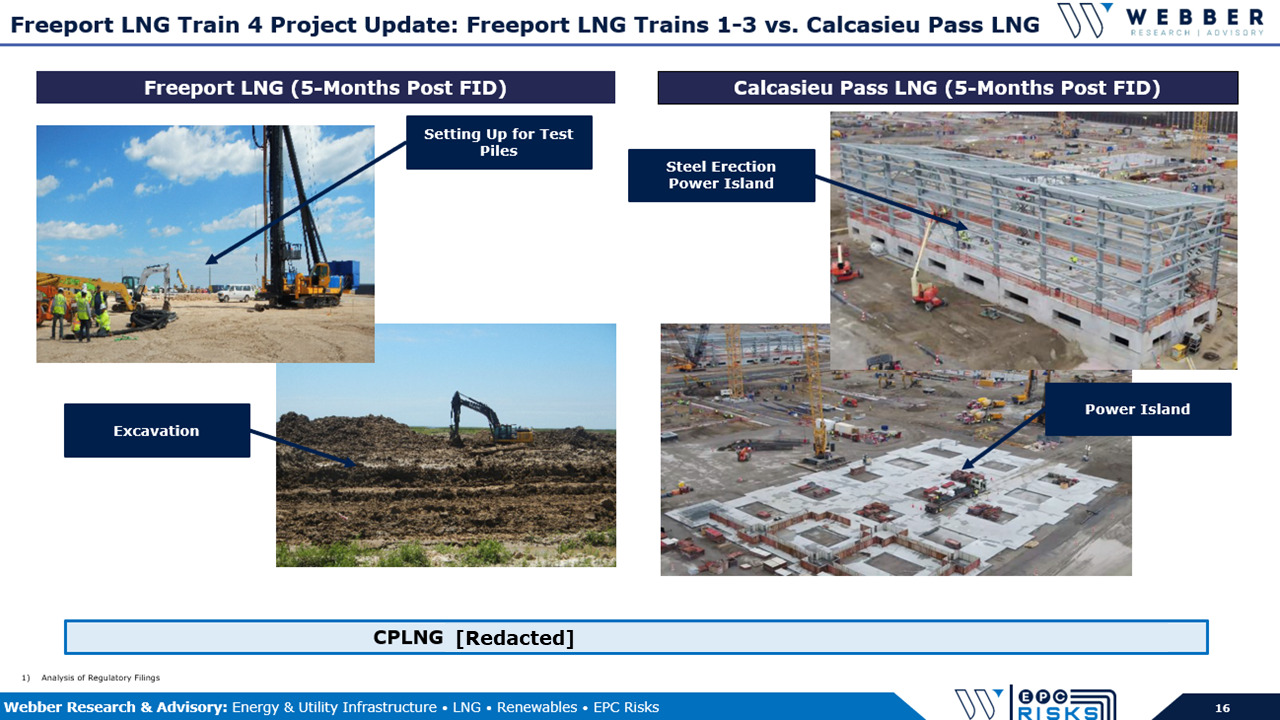

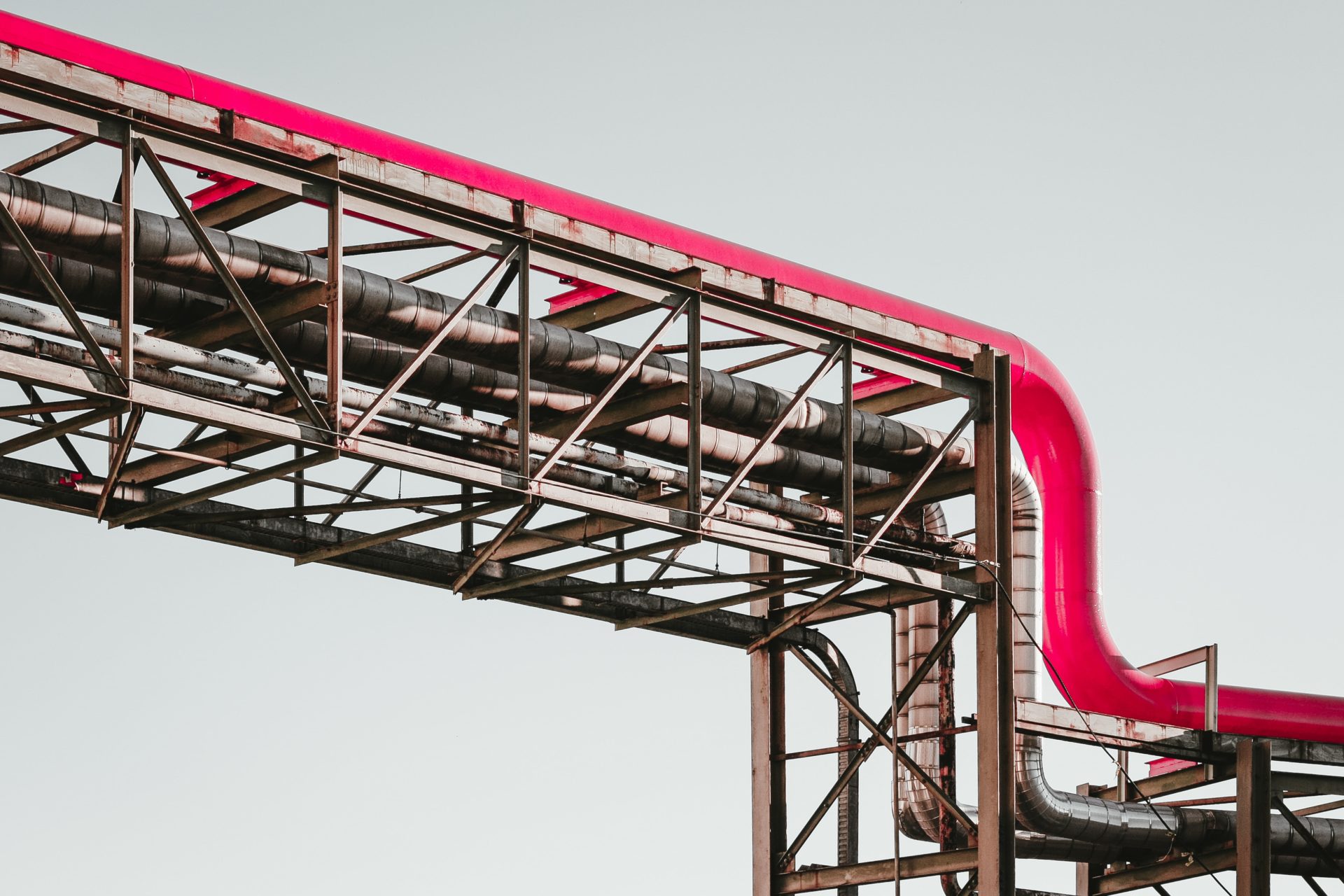
Webber Research: Freeport LNG Project Update – Restart Analysis & Review Q123
For access information, email us at [email protected], or at [email protected].If you’re already a Webber Research subscriber, click here.
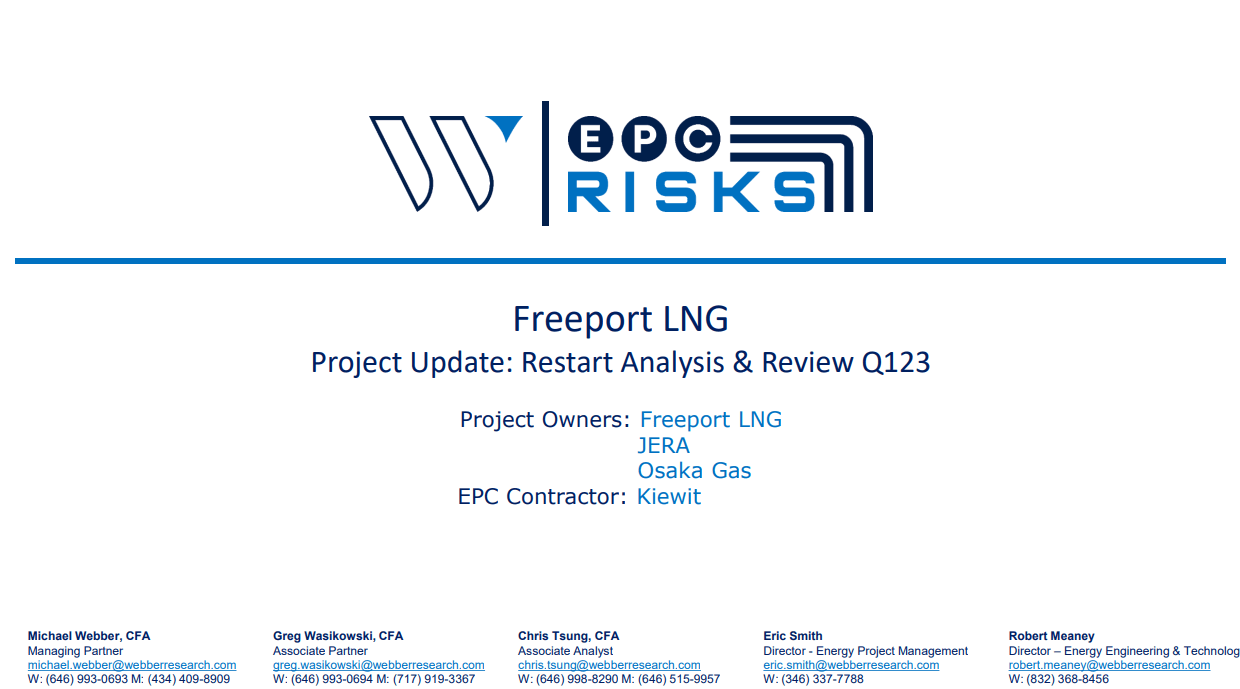


Pages: 1-8
Read More
Webber Research: Venture Global LNG – Plaquemines Parish Q422 Project Update
For access and subscription information, please email us at [email protected], or at [email protected]. To download this report, click here.




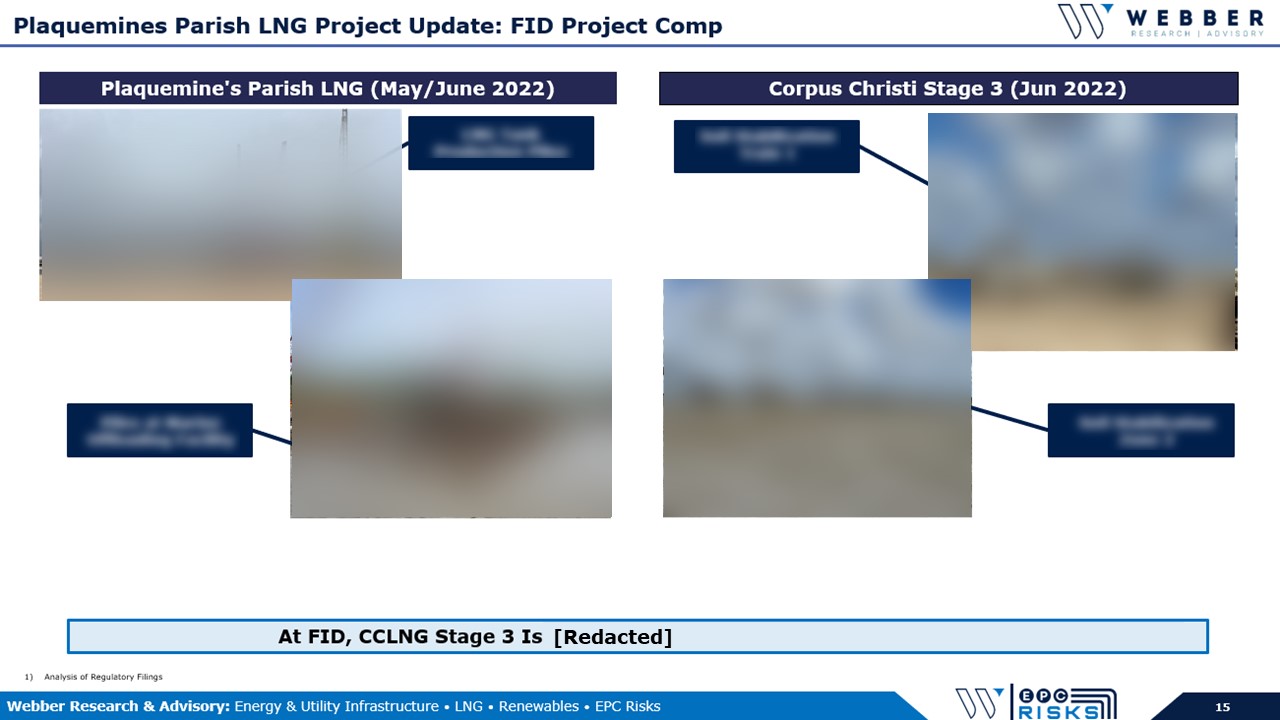
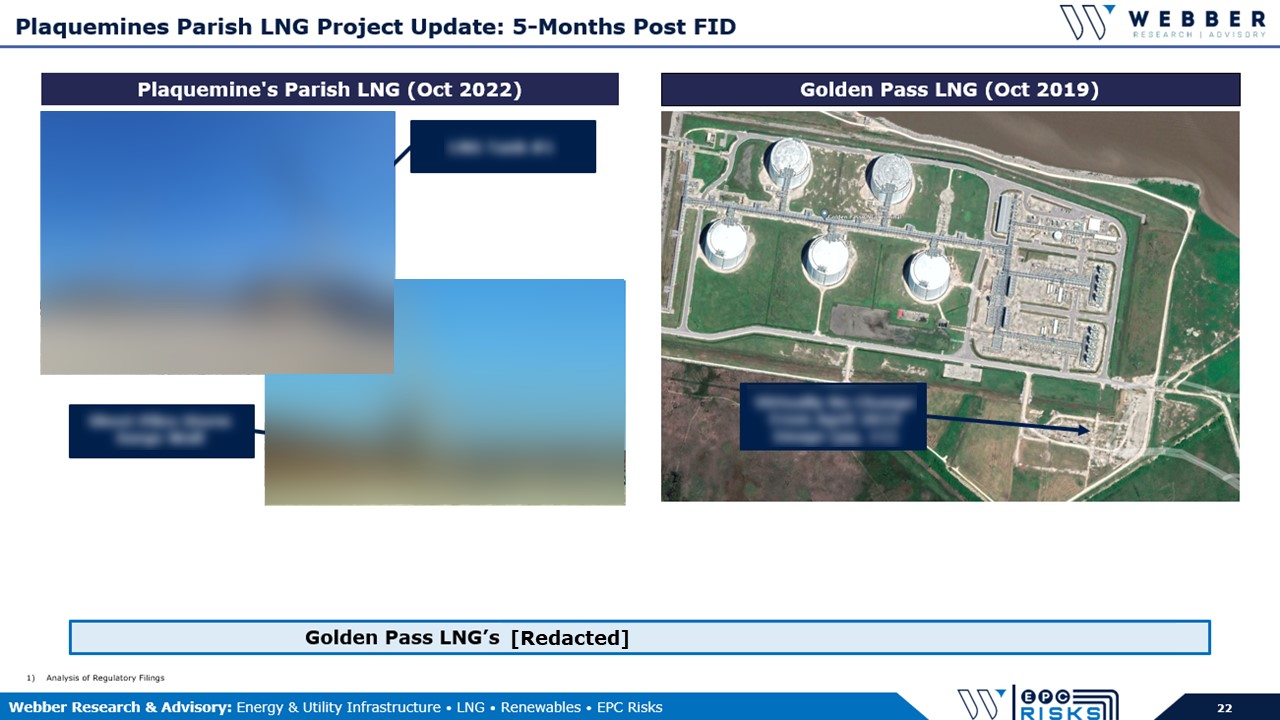
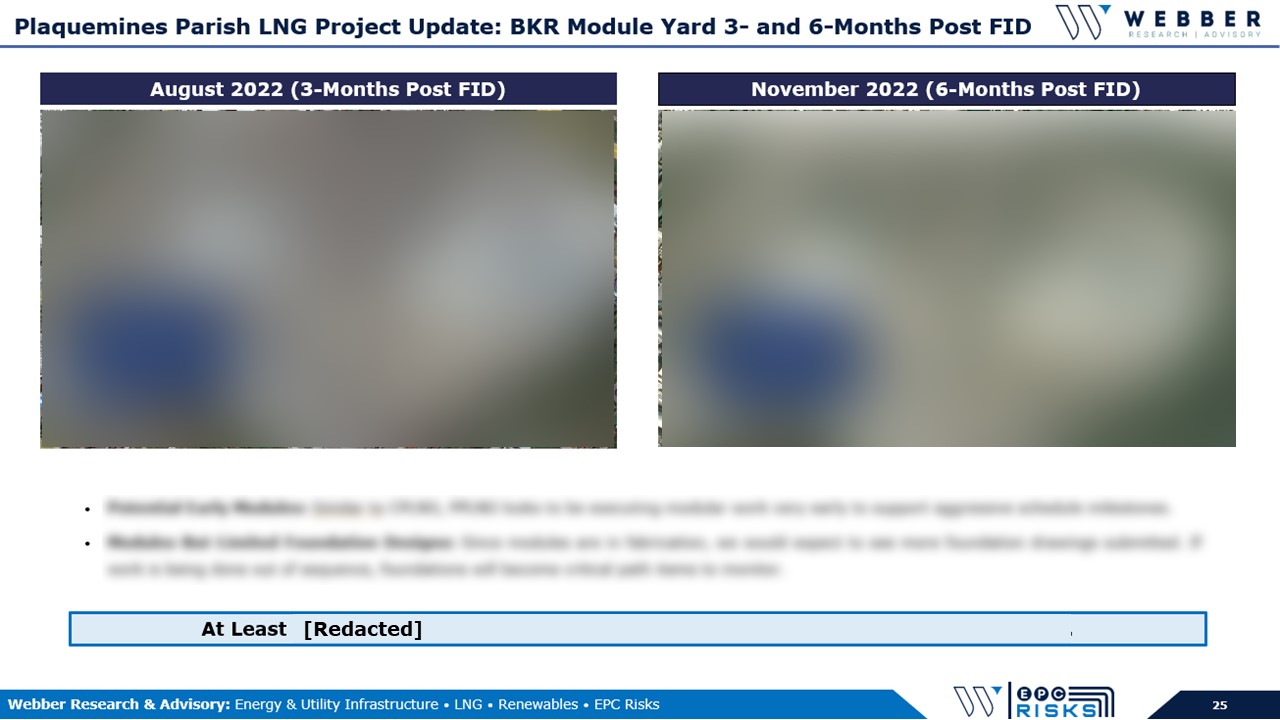

Webber Research: Golden Pass LNG Project Update Q422
To Download This Report, Click Here.
For subscription information, contact us at [email protected] or at [email protected]
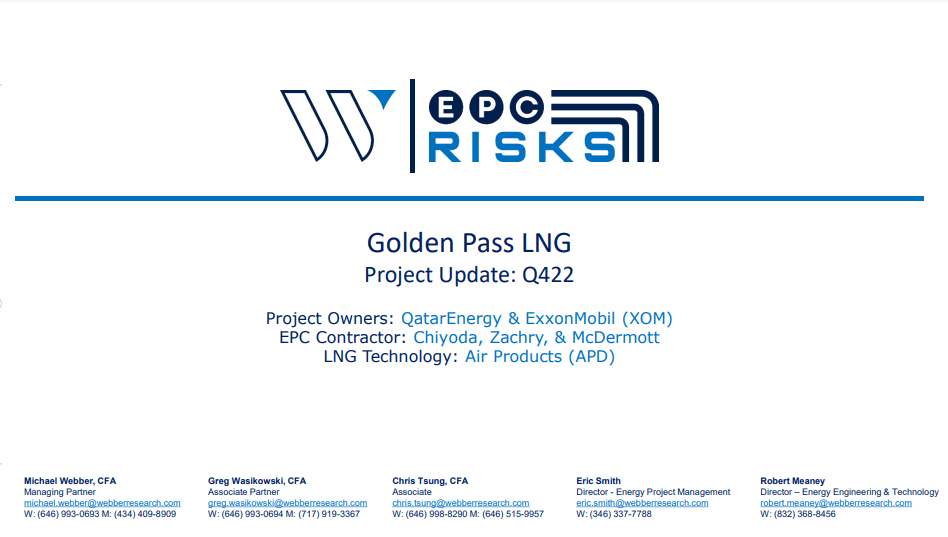
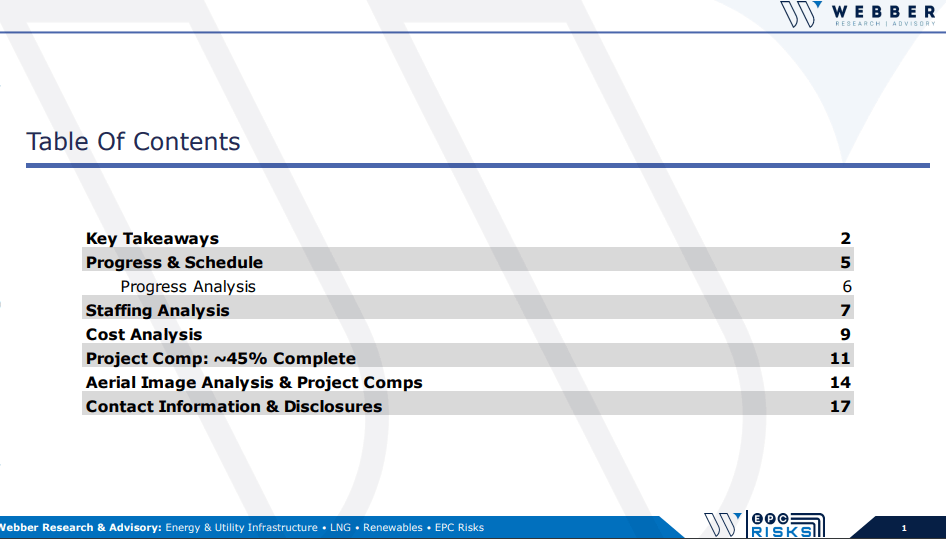


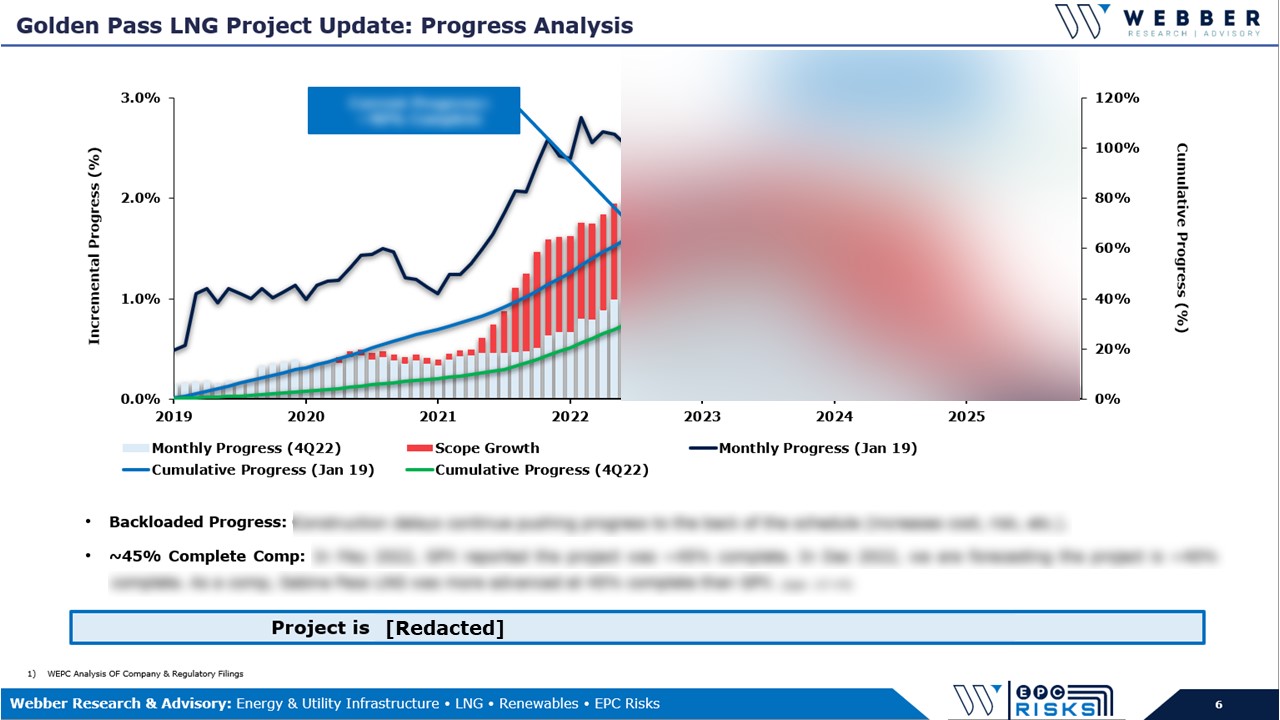

To Download This Report, Click Here.
For subscription information, contact us at [email protected] or at [email protected]
Read More

Webber Research: LNG Canada Q422 Project Update – Satellite Image Review, Revised Timeline, Cost Ests
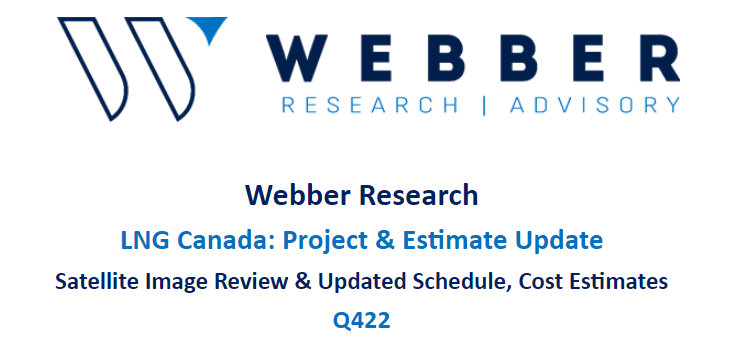
For access information please contact Walter Lobo at [email protected], or at [email protected]

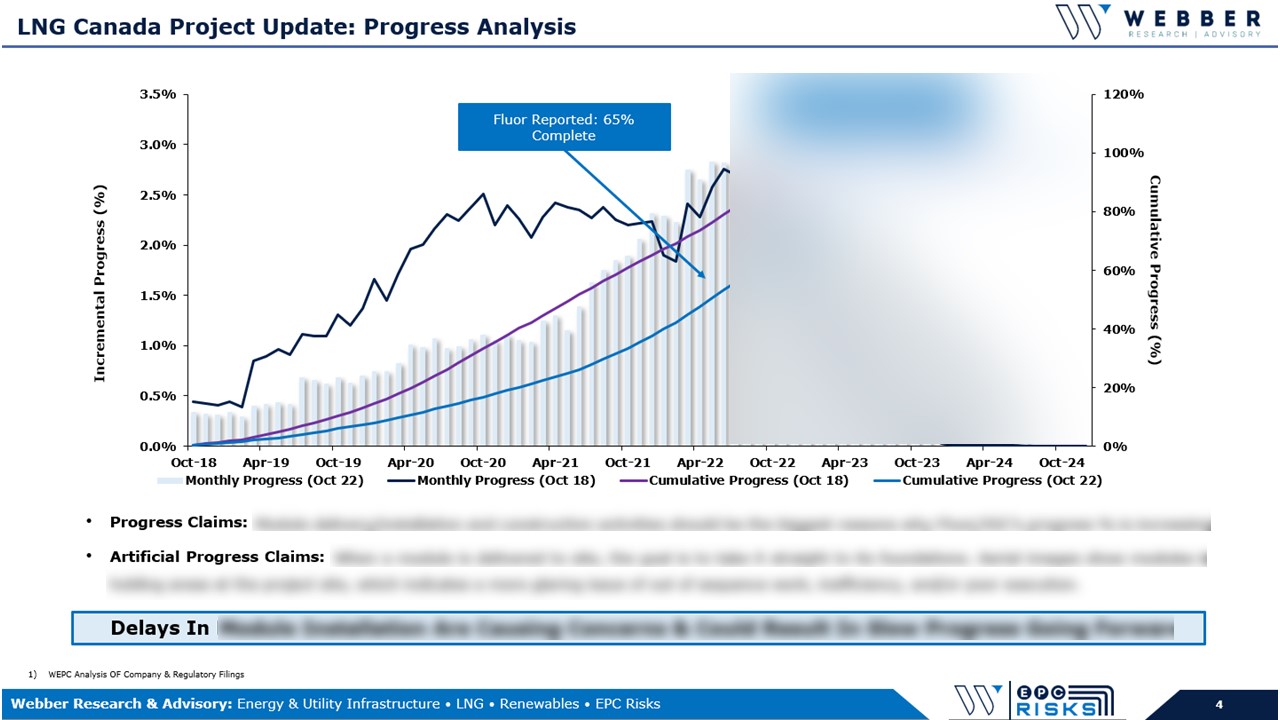
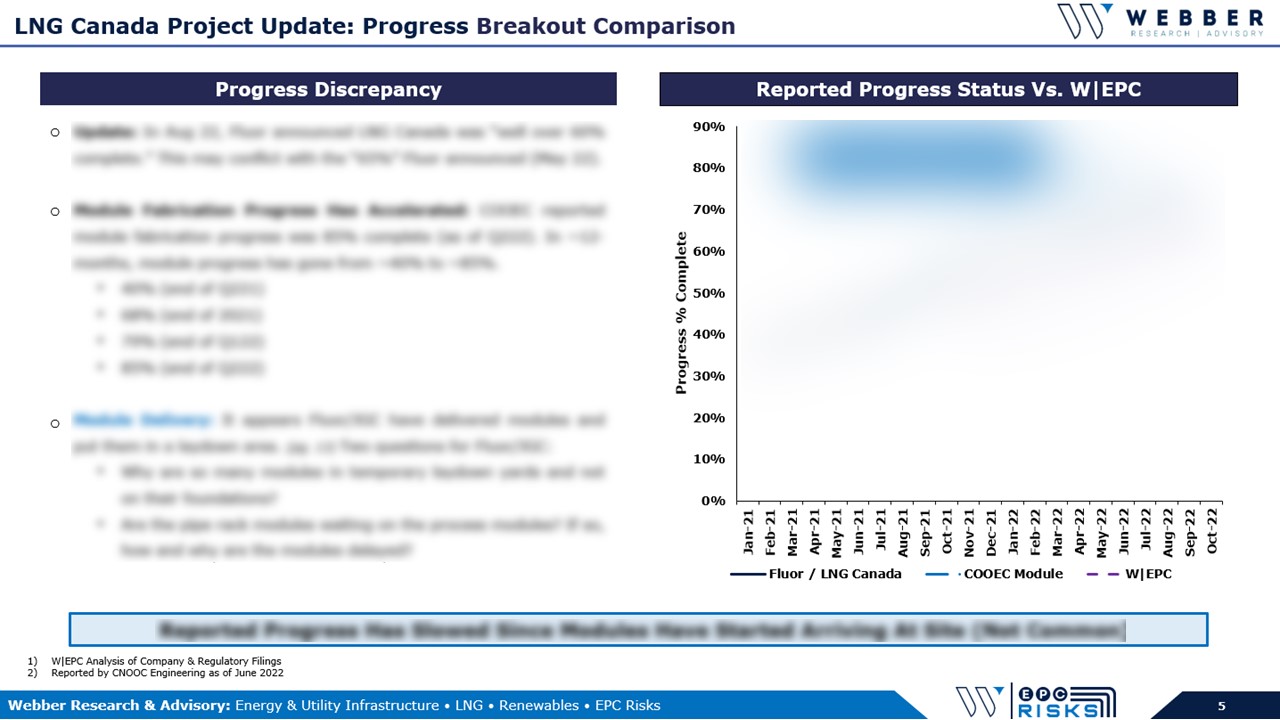
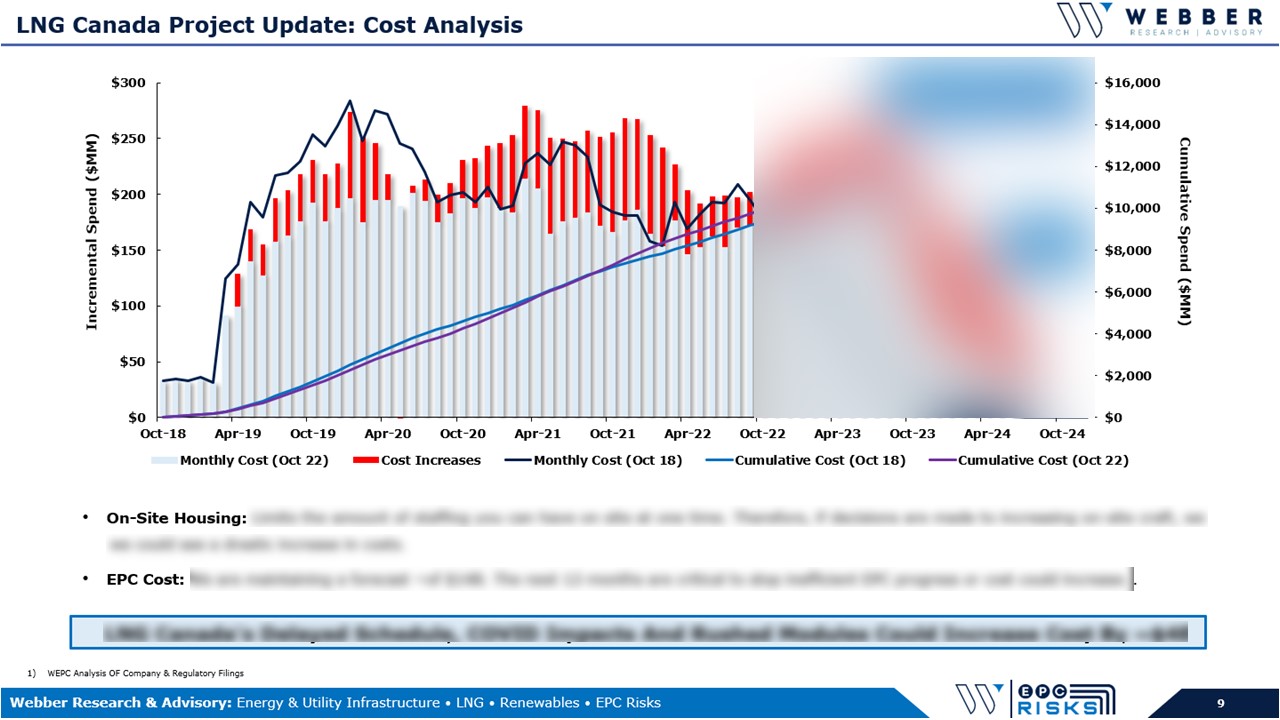
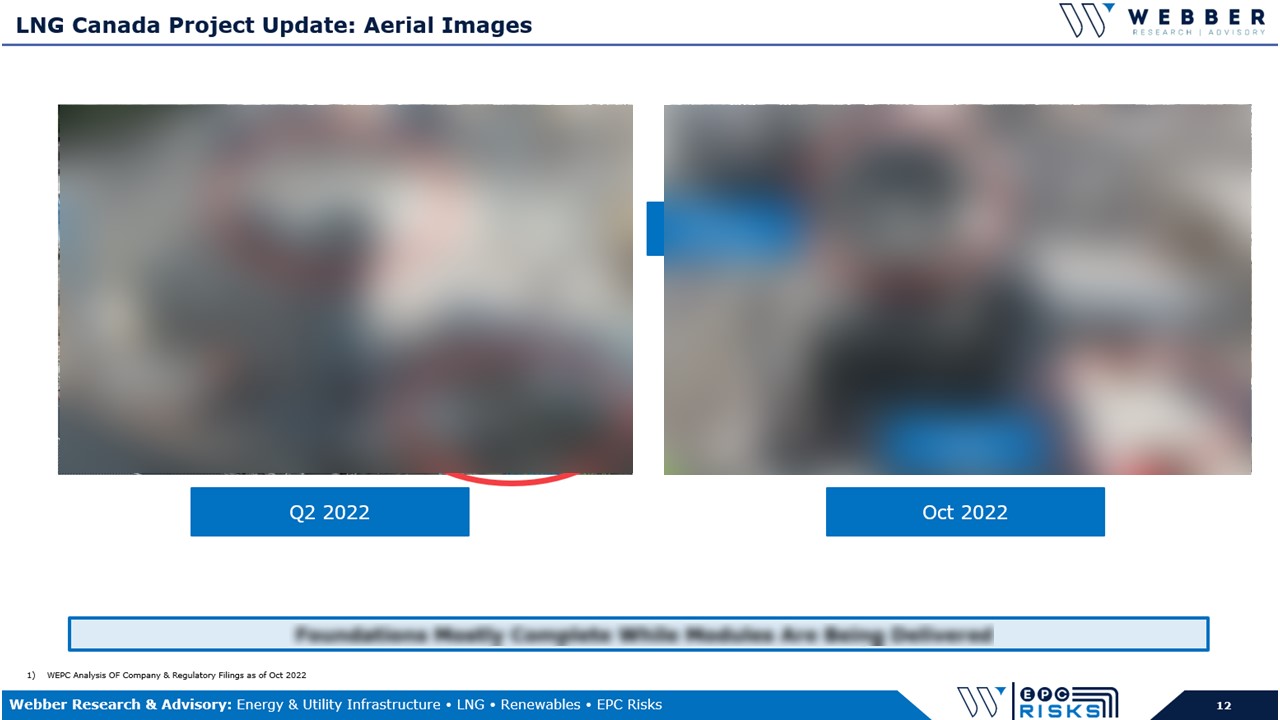
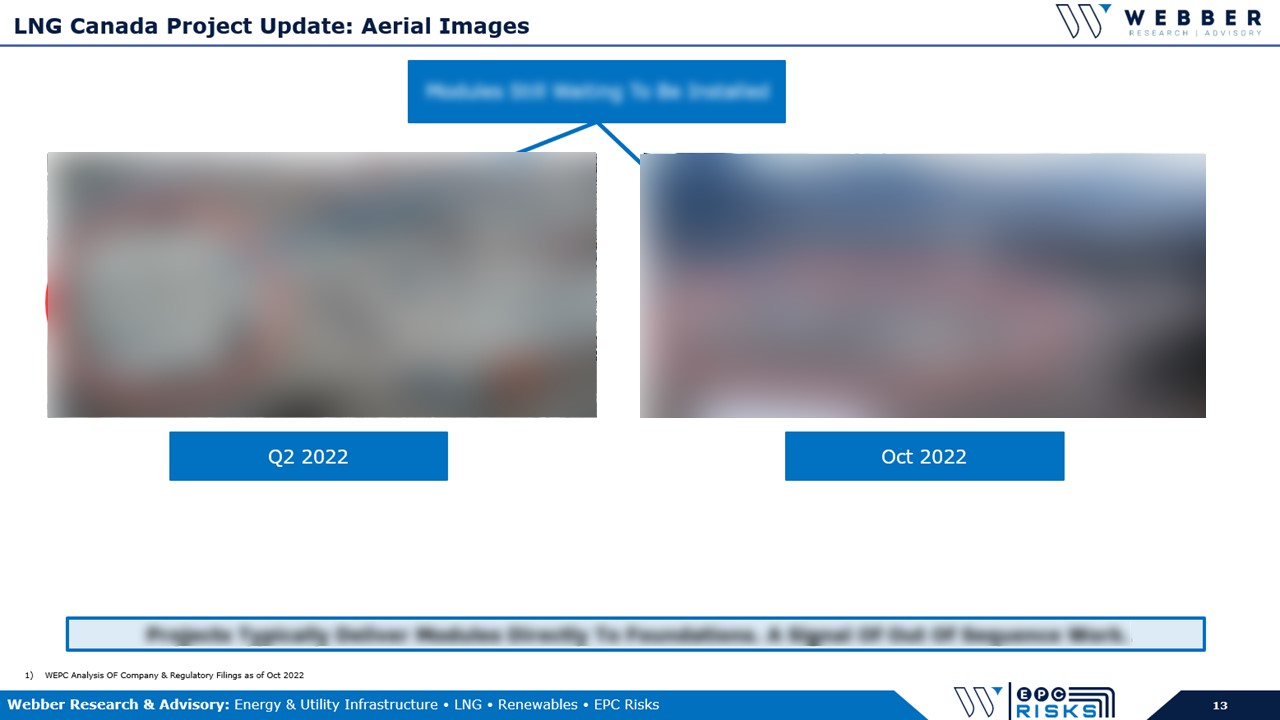

W|EPC: Energia Costa Azul (ECA) Phase 1 – Q422 Project Update
Access Full Report: Energia Costa Azul (ECA) Phase 1 – Q422 Update
For subscription information please contact Walter Lobo at [email protected], or you can reach us at [email protected]





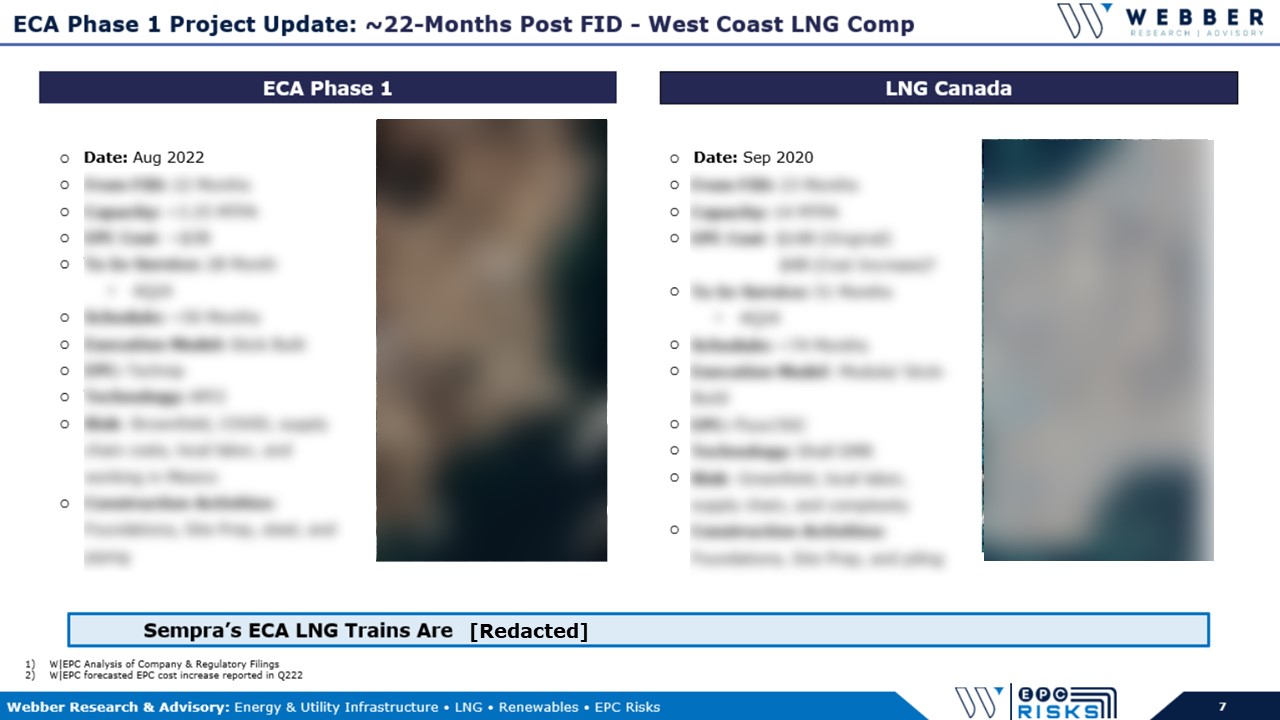

Read More

Webber Research: Qatar LNG NFE Expansion – Q322 Project Update


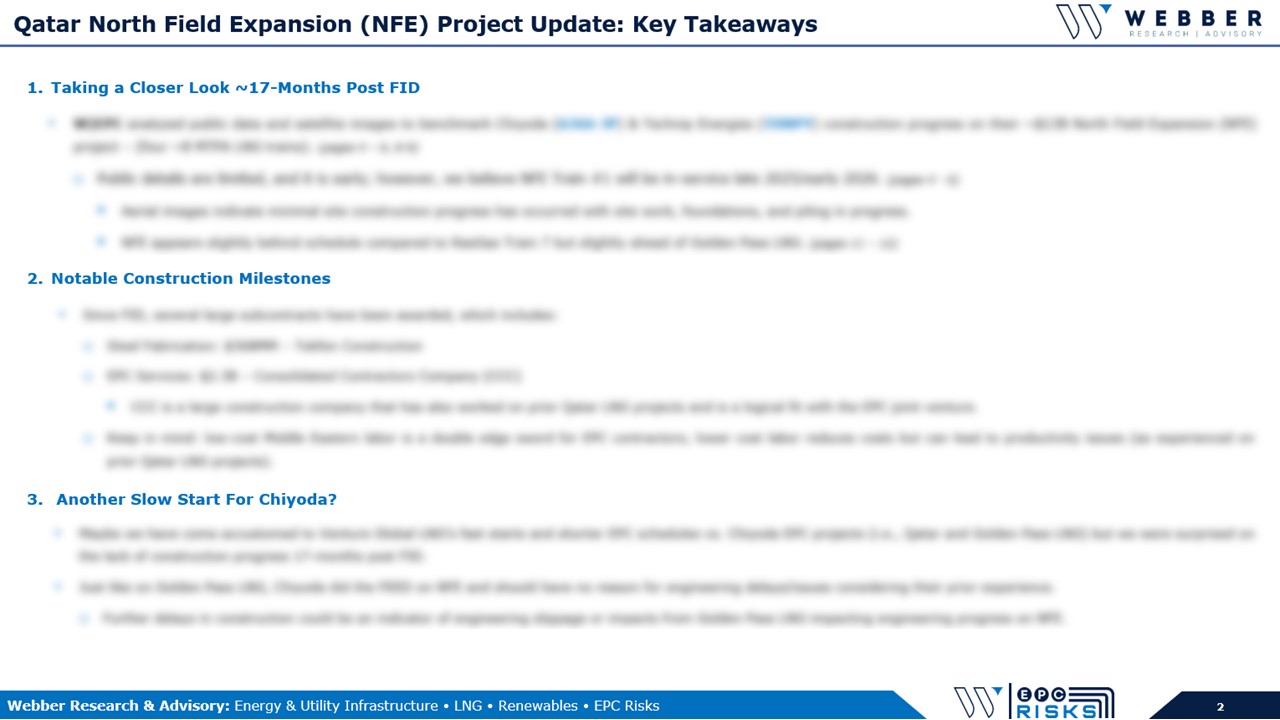




Access Full Report: Qatar LNG Q322 – Project Update
Read More

Webber Research: Golden Pass LNG (XOM, QP) Project Update & Cost Analysis – Q222

Please contact us at [email protected] or [email protected] for access information, or visit our Webstore.

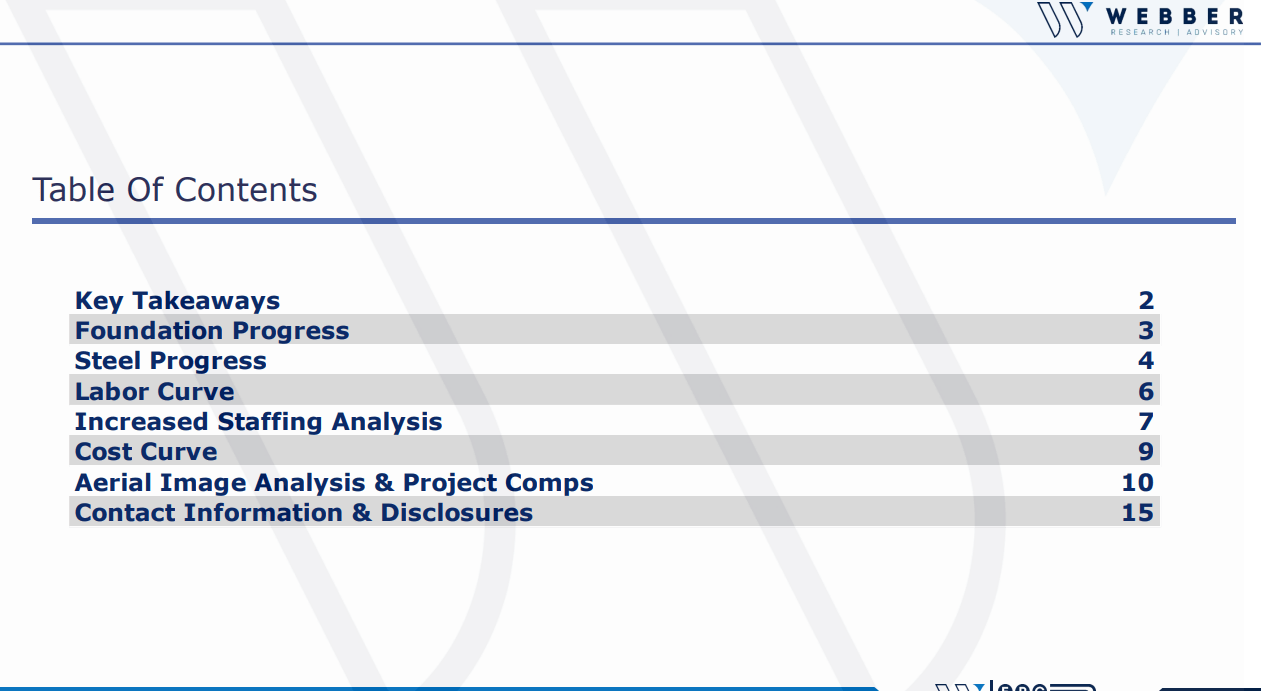
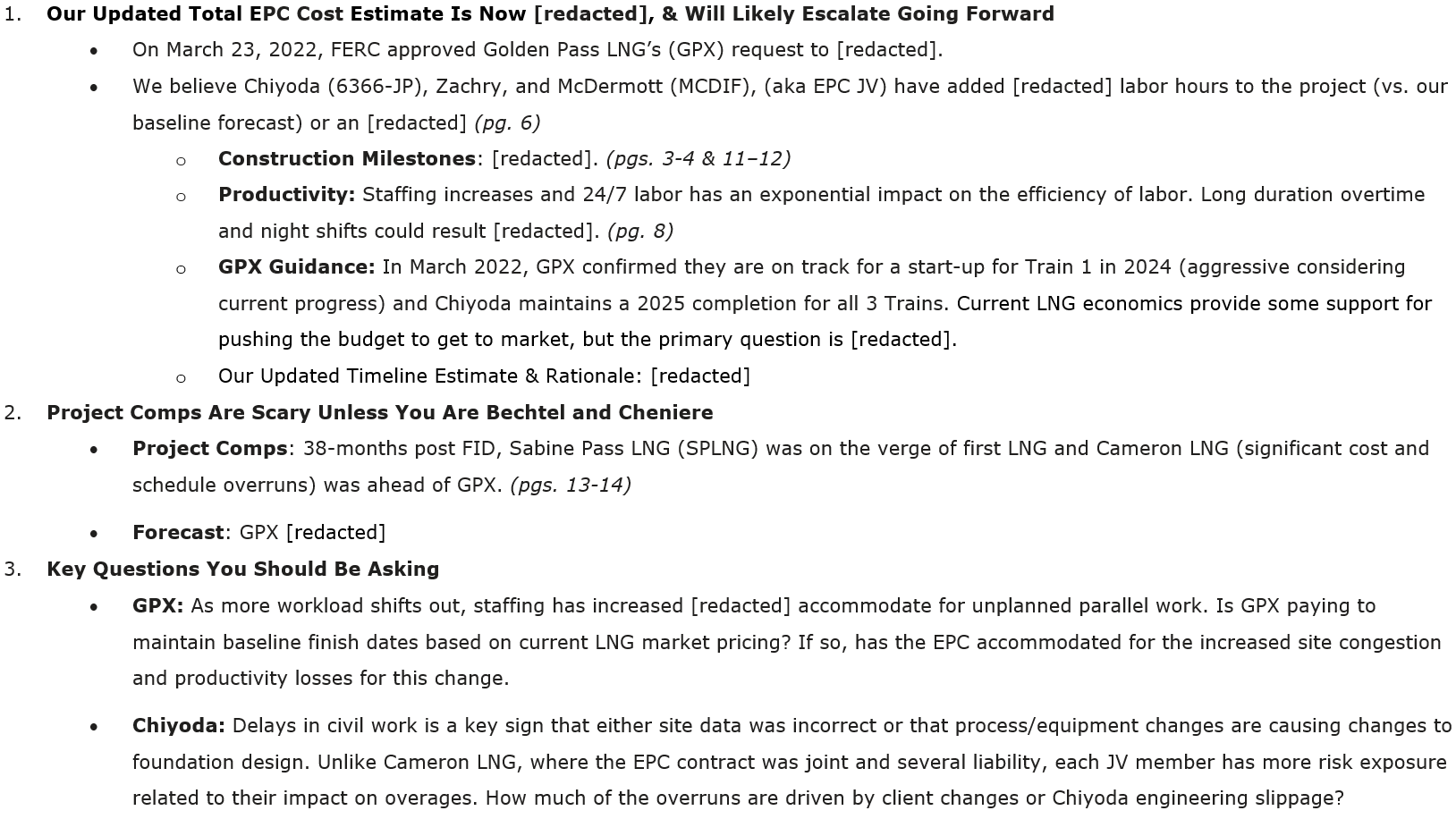

Read More
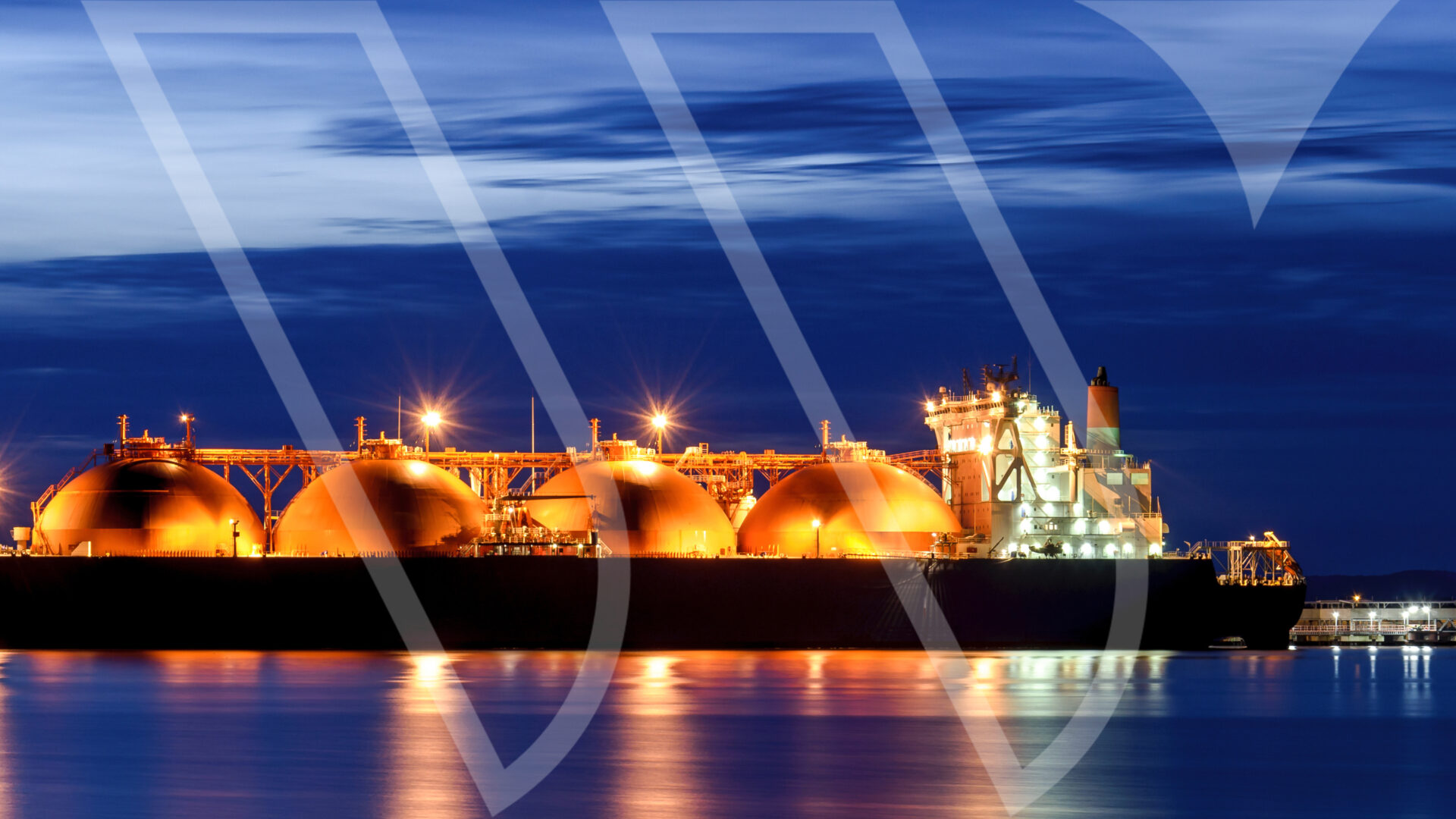
Webber Research: Venture Global Calcasieu Pass LNG & Implications For Plaquemines – Project Update (H122)
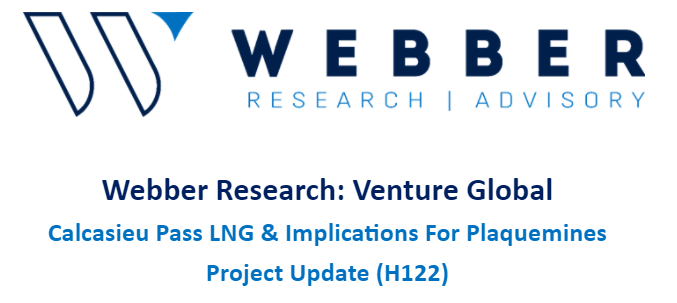
If you’re a current Webber Research subscriber, you can click here to access this presentation in our library. If you’re not yet a subscriber, please contact us at [email protected] for access information.



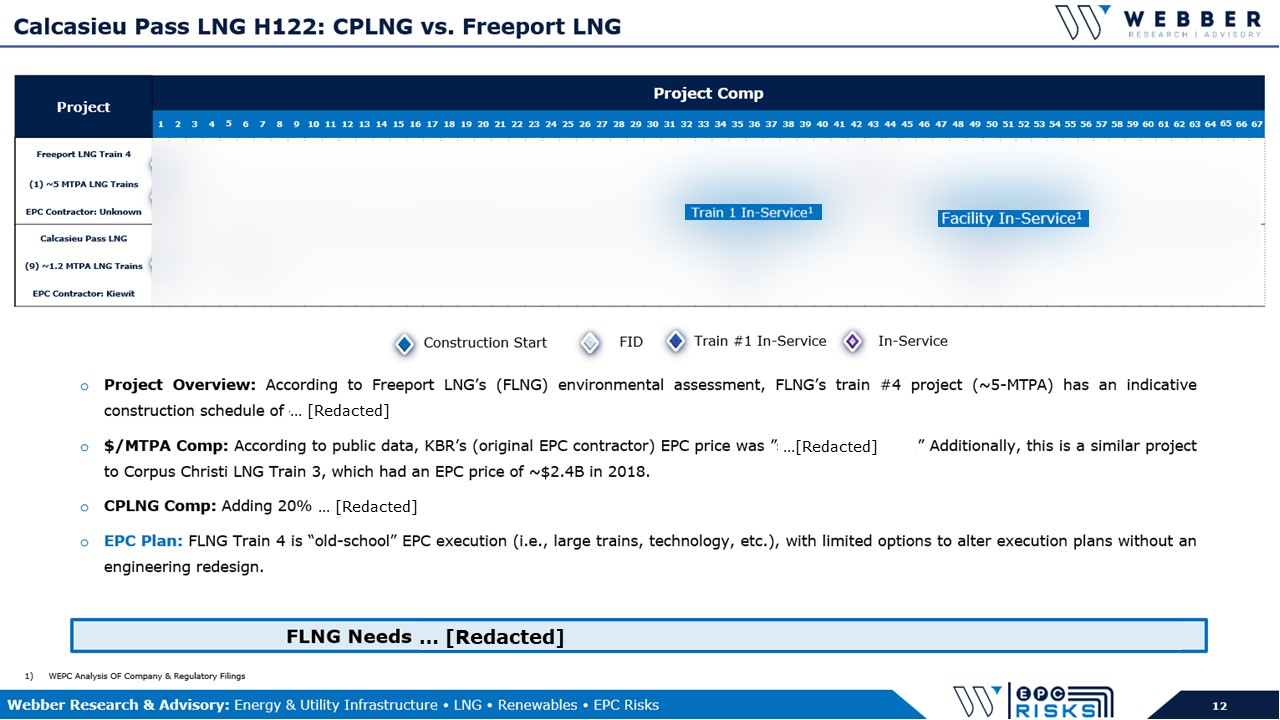

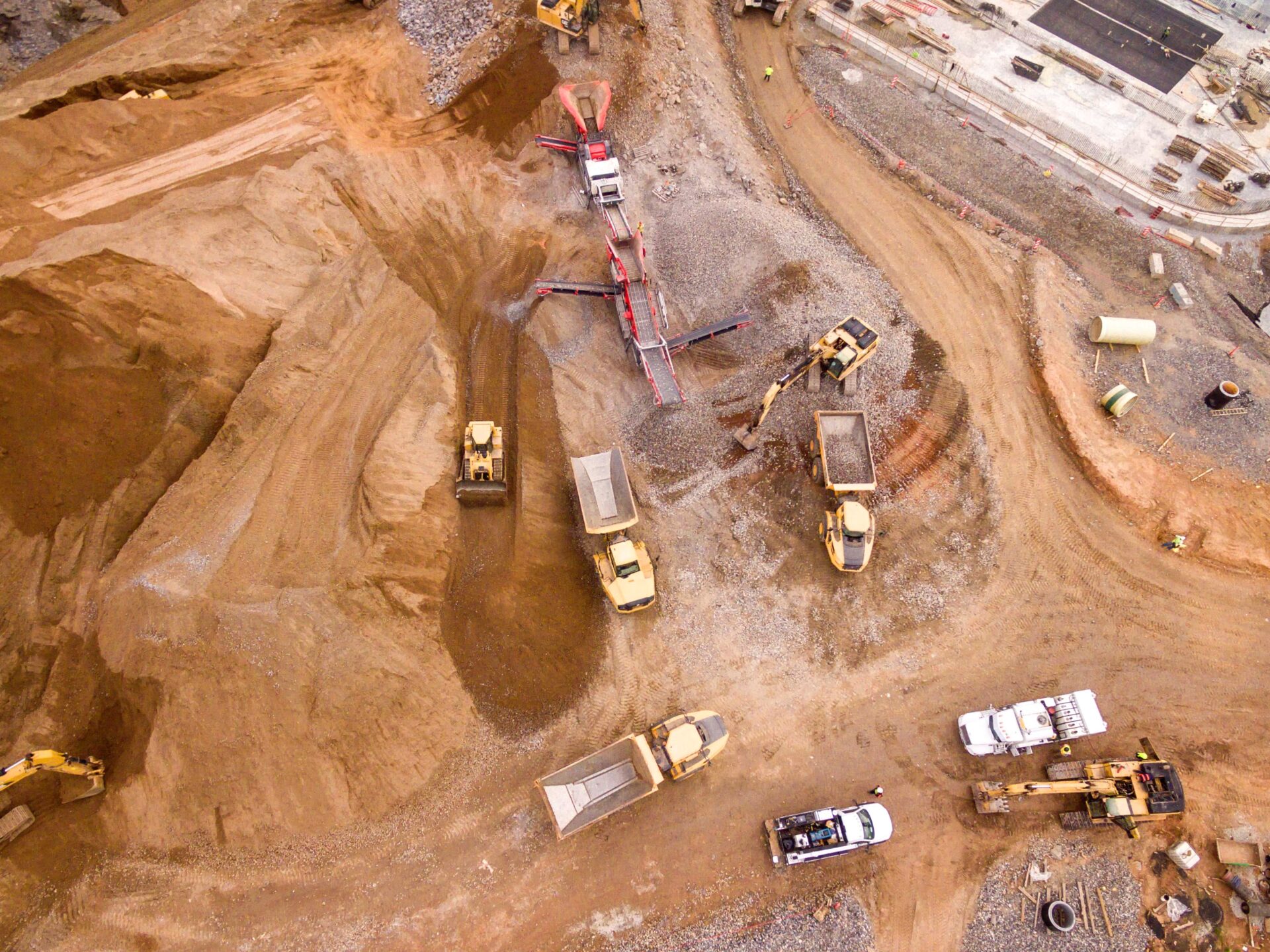


W|PEC: LNG Canada Q321 Project Update
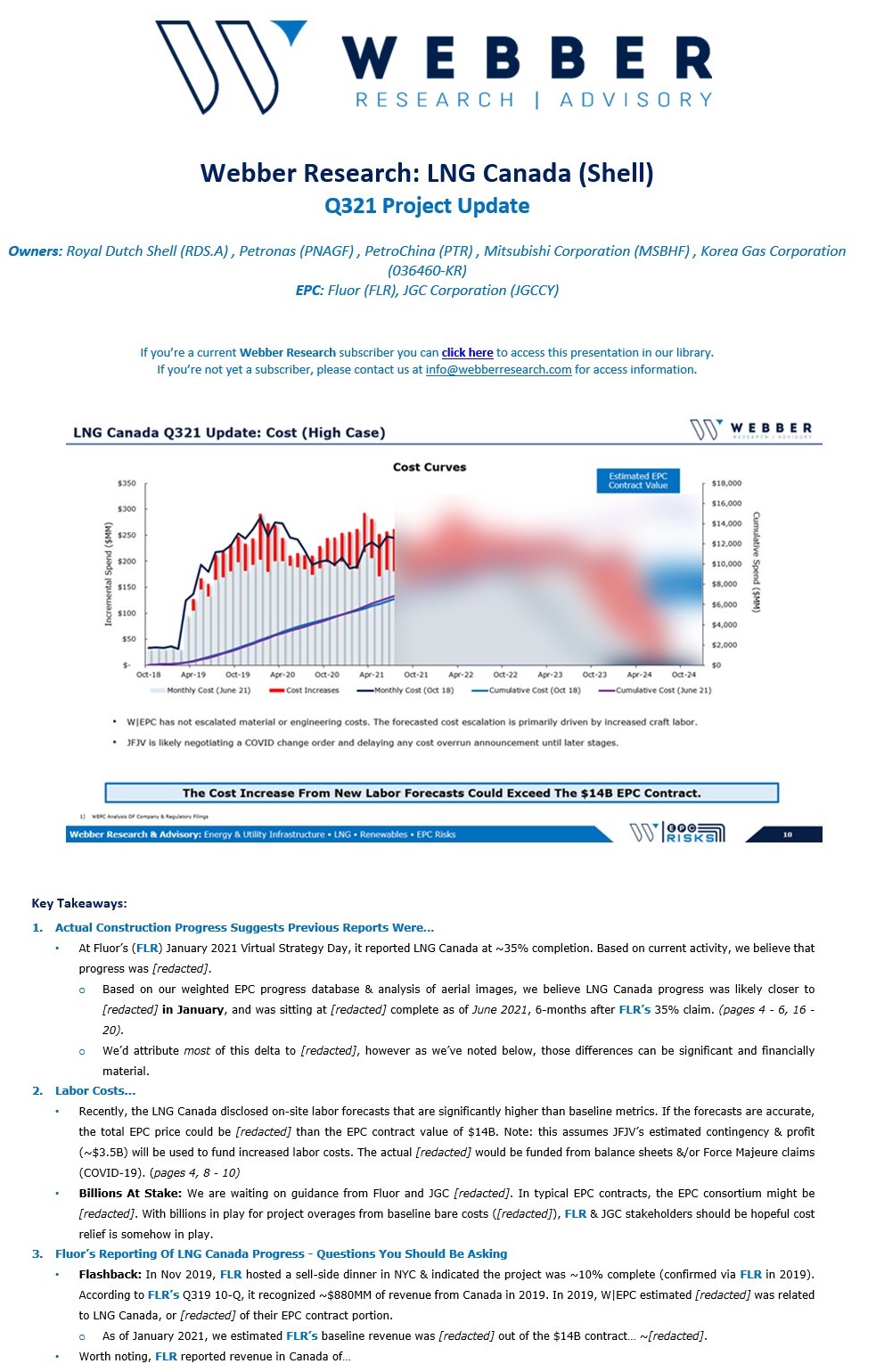
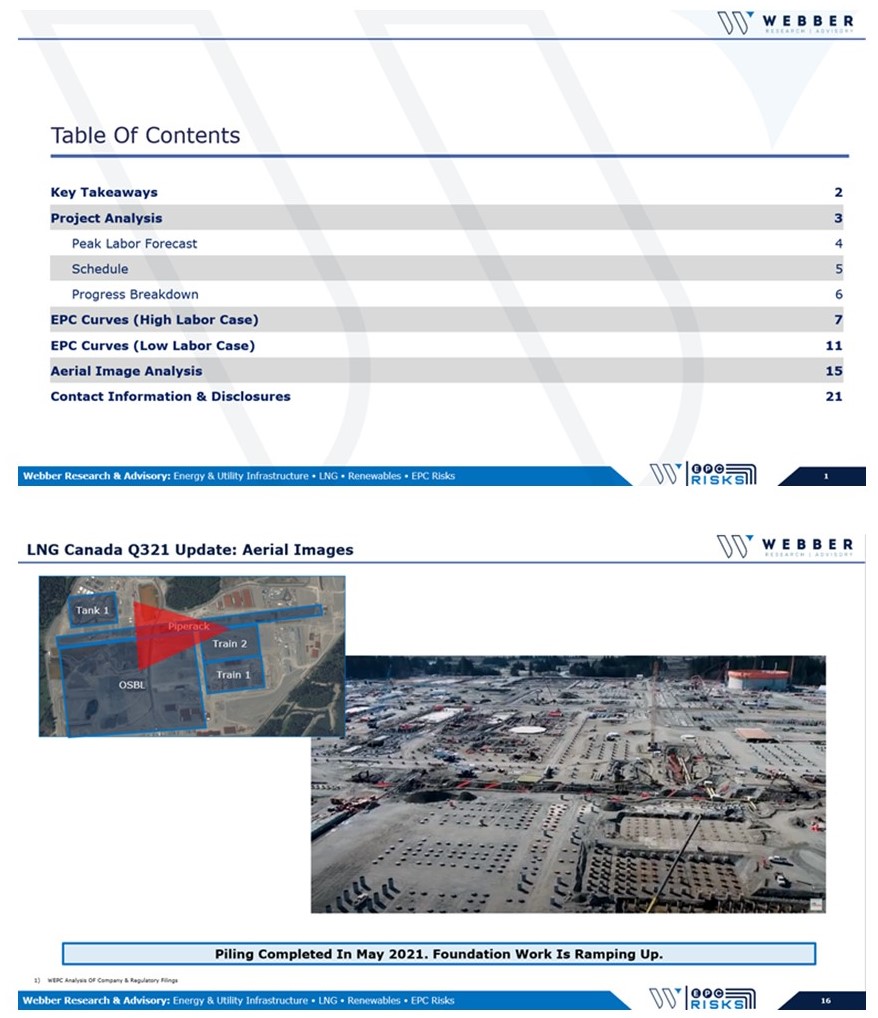
For access information, please email [email protected]
Read MoreW|EPC: LNG Canada – Q321 Timeline, Budget, & Progress Update

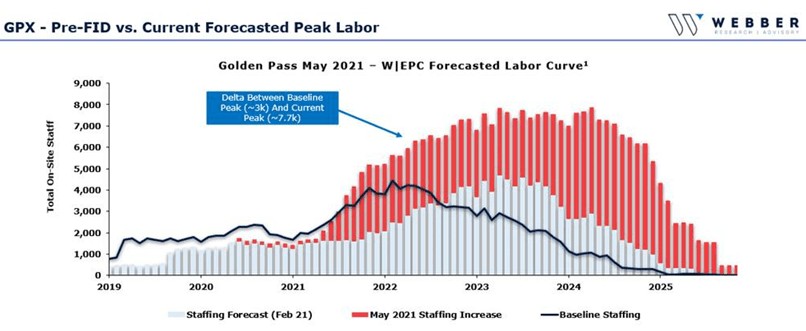

W|EPC: Qatar LNG North Field Expansion – Baseline Report Q221
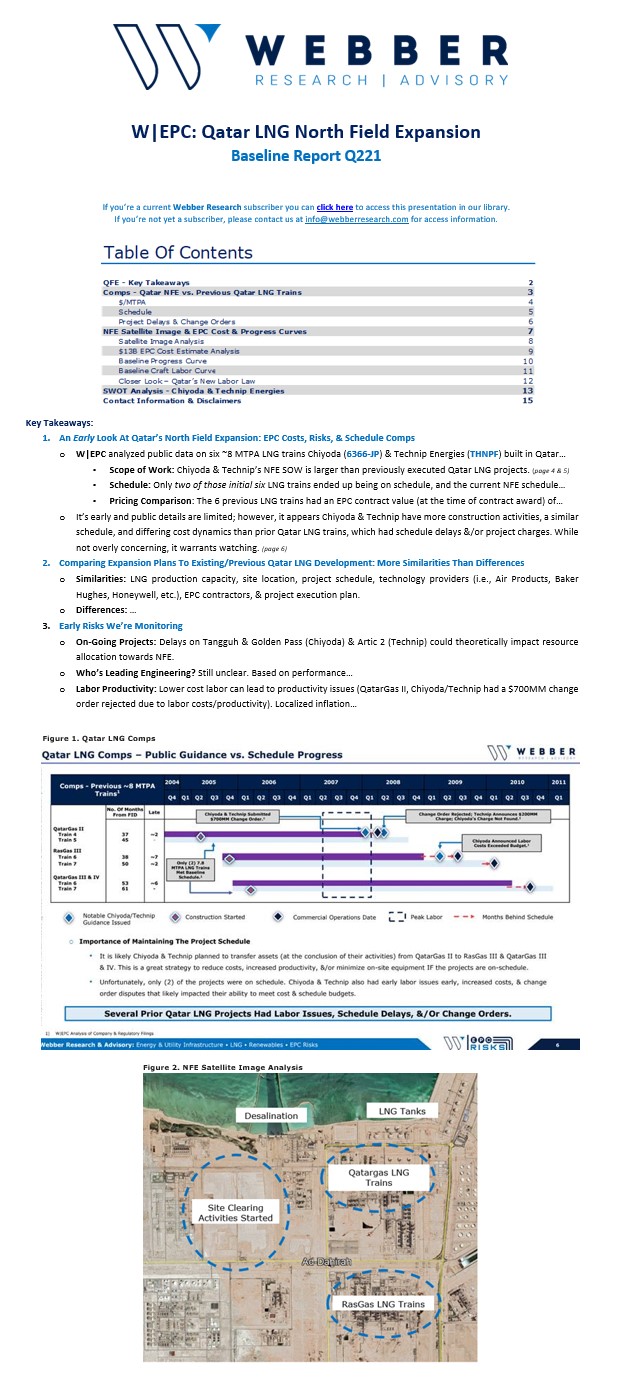
For access information, please email at [email protected], or reach out to [email protected]
Read More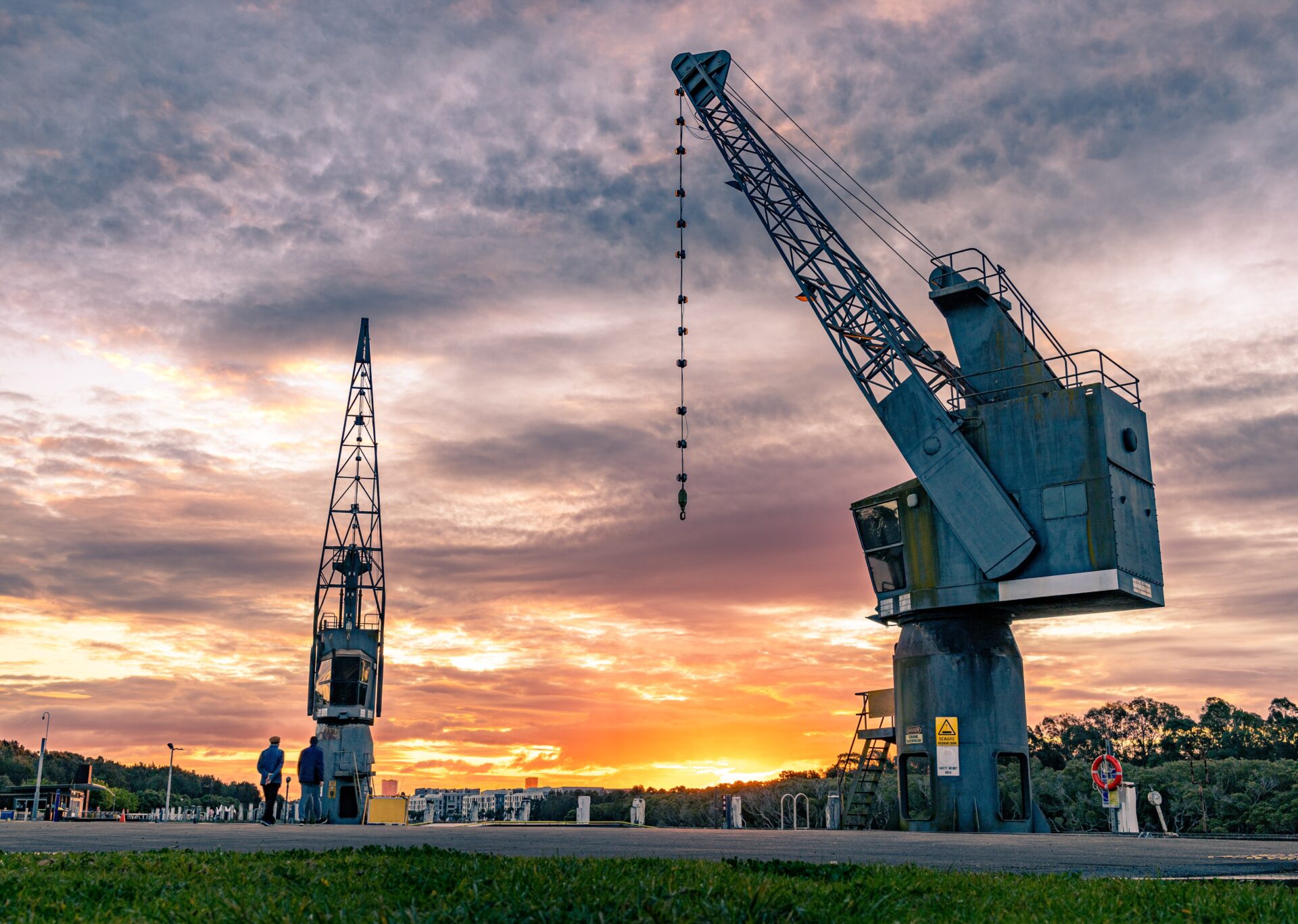
W|EPC: Golden Pass LNG – Q121 Update (XOM, QP)
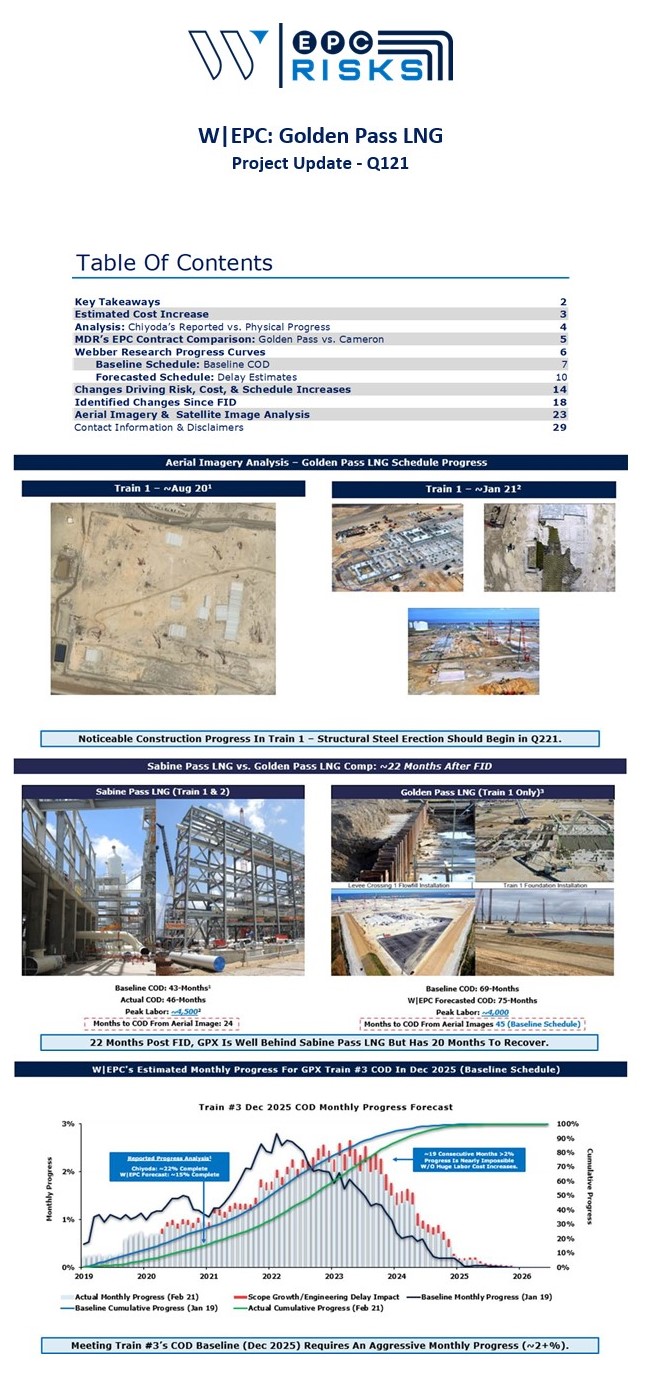
For access information, email us at [email protected], or at [email protected]
Read More
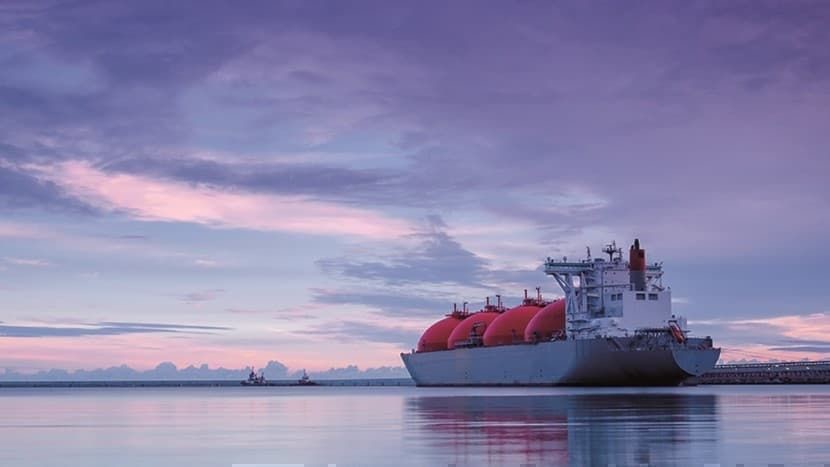
W|EPC: Commonwealth LNG Project Update, Comps, & Due Diligence Questions Q121
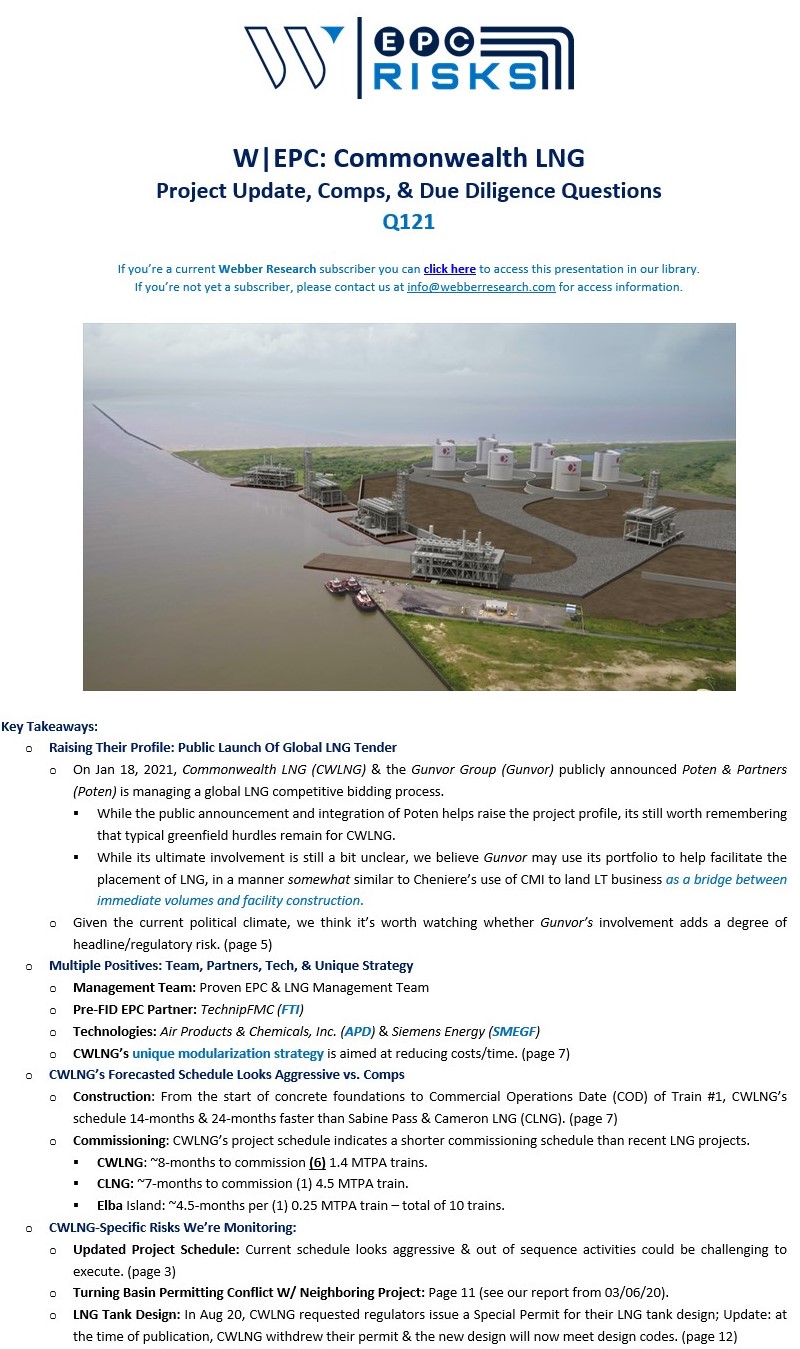
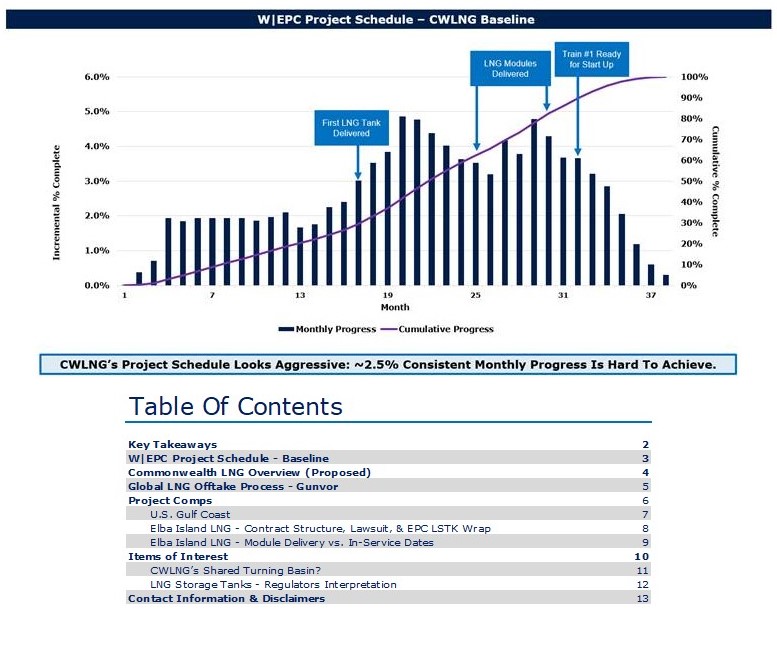
View This Report In Our Webstore
For access information please email us at [email protected]
Read More
W|EPC: Mozambique LNG – Baseline Report & On-Site Satellite Image Analysis (Q121)
Mozambique LNG – Q121
Baseline Report & On-Site Satellite Image Analysis
Project Owners: Total, Mitsui, ENH, PTT, etc.
LNG Buyers: Tokyo Gas, JERA, Centrica, Shell, CNOOC, EDF, etc
For access information please contact us at [email protected]
Key Takeaways:
Mozambique LNG (MZLNG): After A Sluggish Start…The Next 6 Months Are Critical.
• Q320 & Q420 satellite images indications… (pgs. 15-18)
• 17-months after FID, meaningful piling, concrete, &/or structural steel erection [redacted]…
• Recent security issues (increasingly localized terrorism) could further hamper staffing levels and complicate the path forward (while also potentially creating the pretense for Force Majeure relief).
Schedule Analysis & Estimates: W|EPC Estimate MZLNG is…
• Our proprietary risk model implies a probability of the project meeting its original cost/schedule metrics is [redacted] (page 5)
• EPC Contract Exposure: ~$8B LSTK contract, via a consortium comprised of Saipem (74.95%, SAPMF), McDermott (24.98), MDR) & Chiyoda (0.07%,)
• Note: a successful project would boost Saipem’s reputation, while also certainly meaningful for a restructured MDR ($560MM Raise on Jan 5, 2021).
Mozambique vs. LNG Canada
• MZLNG & LNG Canada share similar characteristics, specifically: a remote area, greenfield, man-camp, etc. (page 4)
• Key differences: MZLNG’s has lower-cost construction wages, shorter project schedule, but 300% more peak labor (~11k craft workers).
• Should MZLNG require even more labor given the circumstances described in pages that follow, it would likely require an even more significant pull from local labor (on-site housing can support ~9.5k workers).
• MZLNG is located in one of the least developed areas of Mozambique, which creates unique risks around that heavy lean on local labor, even before considering the uptick in localized terrorism. (page 12)
Mozambique LNG: Baseline Report Q121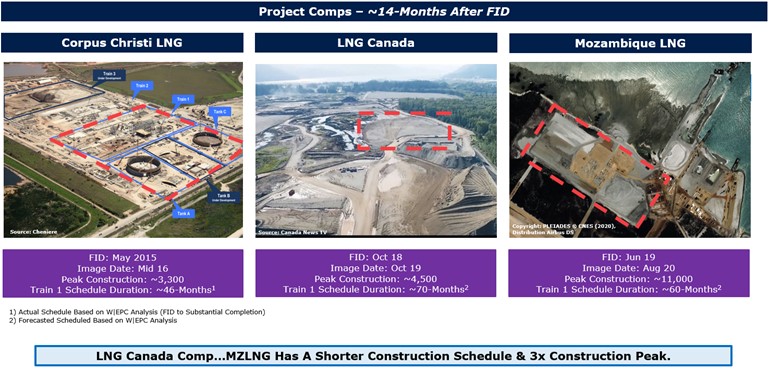
Mozambique LNG: Baseline Report Q121 (Page 15)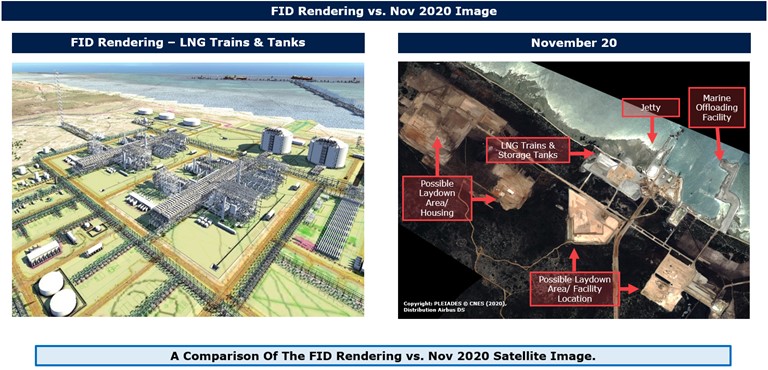
W|EPC: Mozambique LNG – Baseline Report & On-Site Satellite Image Analysis (Q121)
For access information, please email us at [email protected], or reach out to Webber Research Institutional Sales at [email protected]
Read More
W|EPC: Future Of Transportation – Ranking & Evaluating Alternative Fuels – H2 ∙ BEV ∙ Methanol ∙ CNG Hybrid ∙ Ethanol ∙ Ammonia ∙ Diesel ∙ Biofuels
If you’re a current Webber Research subscriber you access this presentation via our Client Login above. If you’re not yet a subscriber, please contact us at [email protected] for access information.
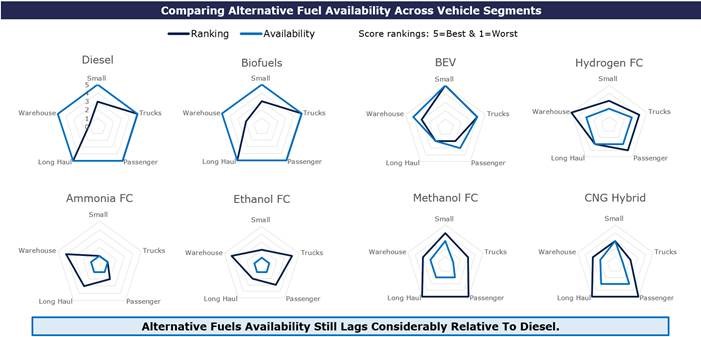
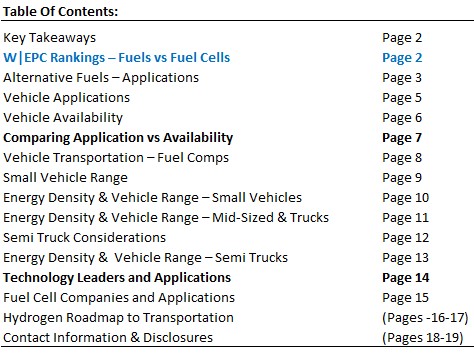
Alternative Fuel Analysis…Will History Repeat Itself?
In 1992 & 2005, the Department of Energy (DOE) created & amended the Energy Policy Act (EPA) that addressed fuel research and tax benefits for vehicle manufacturing.
Battery Electric Vehicles (BEV), Hydrogen (H2), Hybrids, Biofuels, Ethanol and Methanol were analyzed in 2005, but vehicle manufacturers supported gasoline hybrid vehicles due to technology and production constraints.
Since then, fuel cell technology and global, federal, & state emission guidelines have accelerated innovation and the market is now actively deciding transportation alternatives.
Small Vehicle Applications
BEV have taken a leading role in the small vehicle category with minimal competition from Hydrogen.
Hydrogen’s price, lack of infrastructure, and safety concerns highlight the risk associated with new fuel applications; however, Methanol may have an opportunity to fill this role.
The Roland Gumpert Nathalie markets an impressive range and methanol costs are comparative to BEV, but the $450k price tag limits it’s applications until manufacturing scales up to reduce cost.
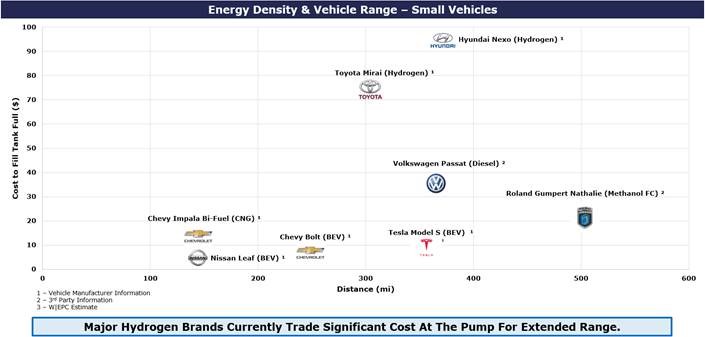 Mid-Sized Vehicles and Truck Applications
Mid-Sized Vehicles and Truck Applications
Fuel energy density becomes a larger role as the size of a vehicle increases.
Fuel storage capacity, energy density, and vehicle efficiency play a large role in the range and cost for a vehicle.
Semi-Truck Range Is A Gating Issue For Future Fuels
New Semi-Truck concepts are ranging from shorter applications (<300 miles) to the long-haul market (>600 mile/day).
Daimler eCascadia seems to make sense for shorter applications and Hyliion’s Compressed Natural Gas (CNG) hybrid semi will likely apply well to long haul trades, if the marketing is as good as advertised.
https://webberresearch.com/downloads/wepc-future-of-transportation-ranking-evaluating-alternative-fuels-h2-%e2%88%99-bev-%e2%88%99-methanol-%e2%88%99-cng-hybrid-%e2%88%99-ethanol-%e2%88%99-ammonia-%e2%88%99-diesel-%e2%88%99-biofu/
Check this: Sex Drive Boosters for Men: Energy, Enthusiasm, and Expertise
Read More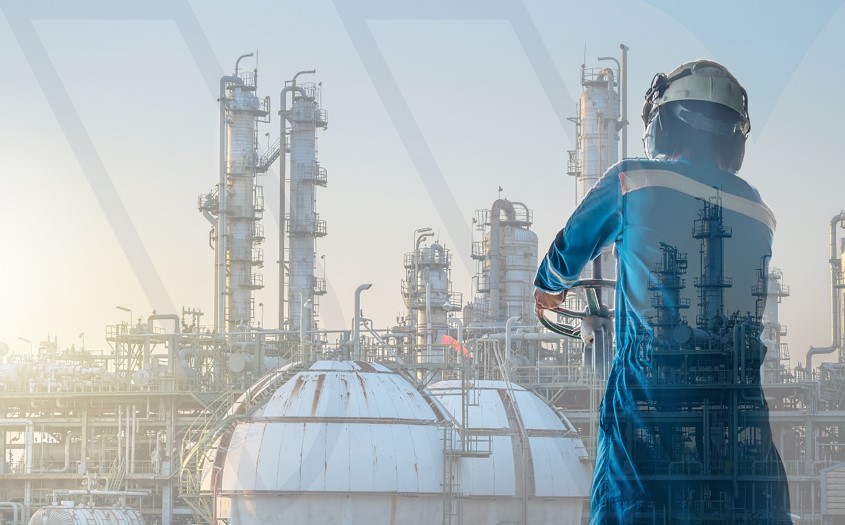
W|EPC: Analyzing Energy Project Contract Terms – Risks, Strategies & Comps
Analyzing Energy Project Contract Terms – Part 1 – Risks, Strategies & Comps Across Stakeholder Groups – Q420
Analyzing EPC Risk Avoidance: Comps & Techniques For Investors, Owners, & Contractors
W|EPC analyzed ~$20B of publicly available EPC lump sum turn-key (LSTK) contracts, focusing on sensitive or contentious terms used to allocate risk, manage performance expectations, & establish a framework for third-party indemnification and liquidated damages, etc. (Pages 3, 5-7, & 9-17). Specific points of emphasis:
- Investors: Leveraging a project’s future expansion plans to protect ROE and/ maximize options (ROFR) options. (Pages 5, 9-11)
- Owners: Finding & justifying onerous contract terms as market or on-the-run.
- Contractors: Avoiding those onerous contract terms.
Analyzing Notable Risks
- Liability & Indemnity: Existing Facilities can be problematic for Contractors & expose stakeholders. (Pages 5, 9-11)
- Performance Guarantees & Damages: Numerous performance guarantees were publicly disclosed (likely inadvertently) that illustrates risks & production, emissions, and/or power consumption liabilities. (Pages 6, 12-14)
- Technical Risk Allocation: One project’s subsurface provisions are tighter and limit change orders provisions for differences in soils data. (Pages 7, 15-17)
Distributing Project Risk Amid A Ramp In Renewables
- The steep ramp in renewables demand & project development could create an opportunity/leverage for participating EPC providers to ultimately own less project risk.
- Certain renewable projects could struggle getting an EPC LSTK contract (typically advantageous for the project owner, at the expense of the EPC provider). Dominion Energy (D), for instance, was unsuccessful in finding an EPC provider to provide a LSTK contract for their Coastal Virginia Offshore Wind (CVOW) project.
- EPC providers may have some leverage here, at least for now. W|EPC believes integrating EPC contract strategies/terms earlier than traditional projects (i.e. hydrocarbons) will improve risk/reward.
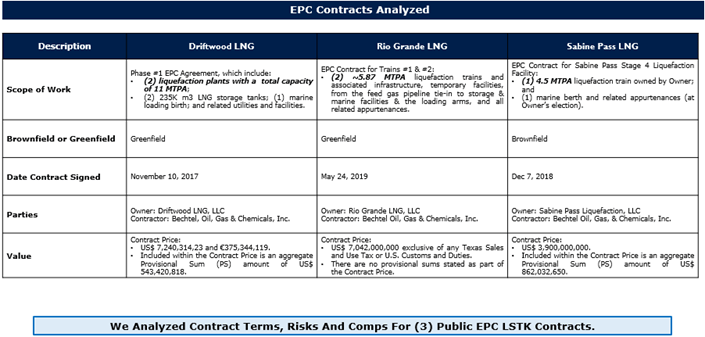
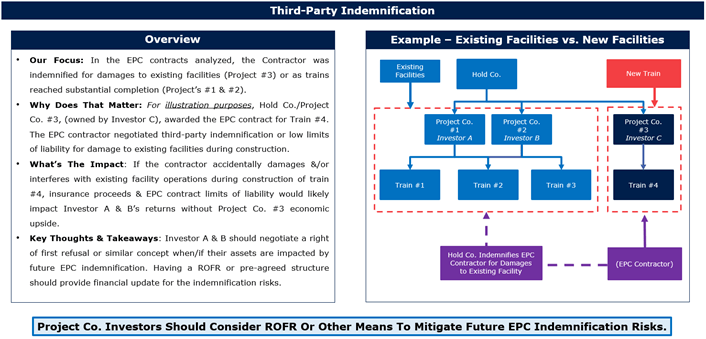
W|EPC: Analyzing Energy Project Contract Terms – Risks, Strategies & Comps
Table Of Contents:
- Key Takeaways – Page 2
- EPC Contracts Analyzed – Page 3
- Overview – Notable Risks for Any Projects – Page 4
- Third-Party Indemnification – Page 5
- Performance Guarantees – Page 6
- Rely-Upon Information – Page 7
- Contract Analysis, Significance, Negotiation Strategies, & Comps – Page 8
- Third-Party Indemnification – Page 9
- Performance Guarantees – Page 12
- Technical Risk Allocation – Page 15
For full access information, email us at [email protected], or at [email protected]
Read More
Webber Research: Reviewing California’s Rollout Plans For A Hydrogen Fueling Network
Webber Research: Reviewing California’s Rollout Plans For A Hydrogen Fueling Network Evaluating Safety, Cost, & Implementation Data
For full access information, email us at [email protected], or at [email protected]
In mid-November the California Air Resources Board (CARB) published initial plans detailing the development and implementation of a light-duty hydrogen fueling station networks, including a focus on financial self-sufficiency.
Specifically, CARB’s initial draft highlights:
1. Estimates around required state-support and eventual self-sufficiency
2. A comparison of existing market solutions, ongoing government research, and the latest awards in the Energy Commission’s Grant Funding program.
3. The economic sensitivity around FCEV deployment and the pace of network development.
4. Opportunities for cost reductions
5. Potential price reductions at the pump
6. Regional economic differences
Within the context of CARB’s report, we evaluated the economics and risks for deployment of Hydrogen fueling station options based on the following:
• Public Safety
• Climate Change and Air Quality – Tank to Wheel (TTW) – Well to Wheel (WTW)
• Gas Station Infrastructure Costs
• Hydrogen Costs at Pump for Consumer
W|EPC Takeaway: As highlighted below, if the primary goal of CARB is to reduce tailpipe emissions, we believe electric vehicles and hydrogen vehicles are the most viable options today. However, if the goal is to reduce total emissions and to implement hydrogen fueling as quickly, safely, and cost-effectively as possible, it opens the door for a mix of other fuel considerations – including biofuels, e-fuels, and other energy mediums to expedite the Hydrogen Economy. We believe how California ultimately balances those priorities will determine what it’s future fueling network looks like.
Climate Change & Air Quality
Air quality and the need for sustainable future fuels to reduce GHG emissions is driving alternative fuel technology development. CARB’s Low Carbon Fuel Credits (LCFC) are based on Well to Wheel Carbon Intensity Scores (CI) that identify upstream pollution caused by fuels.
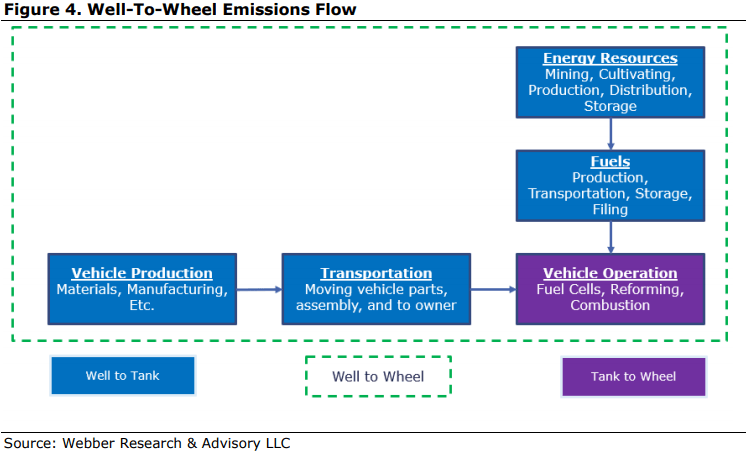
Gas Station Infrastructure Costs
Future fuels (i.e. H2, Ammonia, Methanol) will require new infrastructure in almost all cases to meet federal and state emission guidelines. The Implementation cost of these can vary from storage retrofitting, to +$1 million infrastructure upgrades. The costs could further increase based on the engineering design and blast radius study results.
Hydrogen gas station equipment could include:
• Compressors – 350 bar pressure
• Above Ground Storage
250 bar pressure
250 kg storage
• H2 Dispenser Larger corporate gas stations may have the financial means to implement the costly infrastructure upgrades especially if supported by fuel tax credits. However, smaller gas stations may face challenges investing in the capital costs & the ~$2K/month electricity bill to own & operate the equipment.
Cost comparisons vs the low-cost alternative for Methanol:
• Hydrogen – See Figure 6. Multiple scenarios based on CARB capital cost estimates
• Methanol to Hydrogen in Vehicle – ~$50,000 per gas station to upgrade storage
• Methanol to Hydrogen at Pump – ~$1 million per gas station (250kg H2 storage)
Hydrogen Costs at Pump for Consumer: ~$16/kg and by 2030 as Low as $8/kg?
At the pump, the H2 price begins to stack up due to CAPEX, maintenance, safety, and production costs. We have provided a few options that have been considered for comparisons sake below that could further drive down the cost of hydrogen.
• Centralized Electrolysis: ~$8/kg
• Centralized Reformer (No Carbon Capture): ~$2.50/kg
• Methanol Reforming at Pump: ~$5/kg
Includes 250kg hydrogen storage and compression
• Methanol Reforming in Vehicle: ~$3.50/kg
Gas Station infrastructure cost are relatively minimal
For a methanol reforming at pump scenario, storage-related infrastructure costs could be lighter as Methanol is a potential mid-stream solution for hydrogen, and is generally easier to store in large quantities – potentially pushing the hydrogen cost at the pump level below $10/kg in a shorter timeframe.
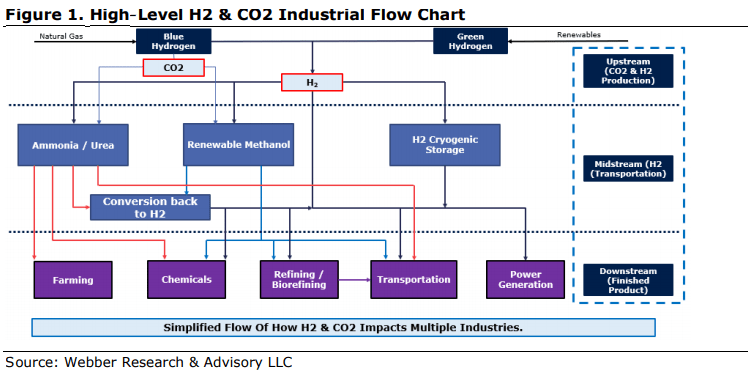
For full access information, email us at [email protected], or at [email protected]
Read More
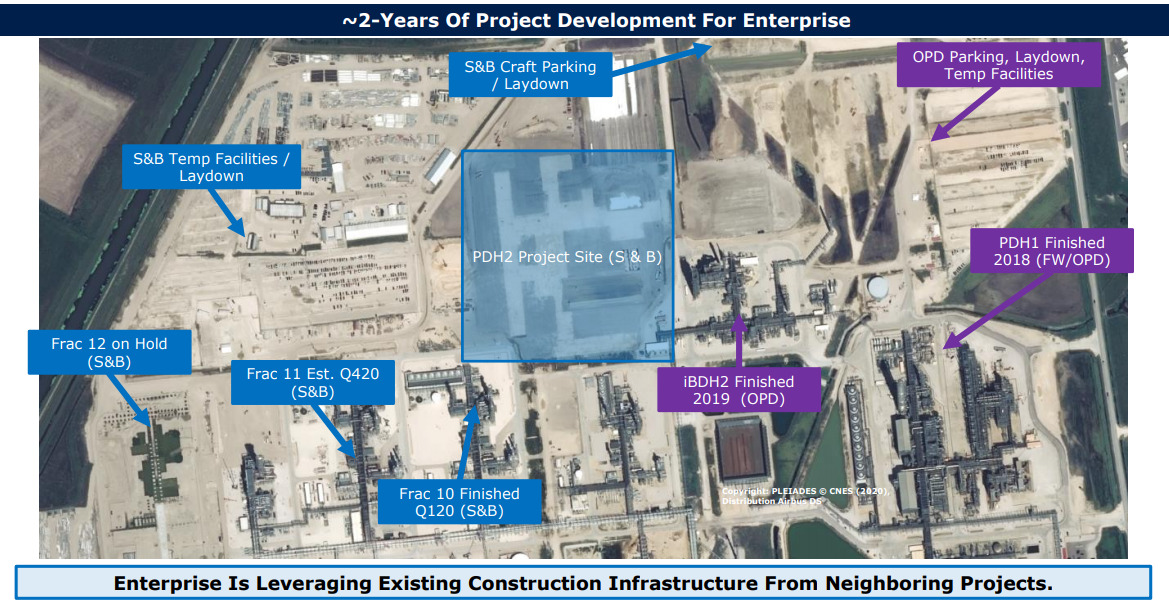
W|EPC: Enterprise (EPD) PDH-2 Q420 Project Monitor & Satellite Image Review
Key Takeaways: Enterprise (EPD) PDH-2 Q420 Project Monitor & Satellite Image Review
EPD PDH 2 – Project Delay Analysis. In Q220, EPD announced a 3-month schedule slip (from Q123 to Q223), potentially limiting future change orders (i.e. cost escalation) related to COVID impact (based on typical EPC contract FM concepts).To reduce the COVID delay to only 3 months, we believe EPD implemented a schedule recovery plan that accelerated/compressed back-end construction activities to meet a Q423 COD forecast. (pgs. 10 – 13). We’ve independently estimated PDH 2’s slippage based on Q420 aerial project site images, with details found within our note… (pages 4 – 7).
Enterprise’s First ESG Guidance… : On October 28, 2020, EPD released their approach to ESG. In the report, EPD touts they are the largest Midstream producer of Hydrogen. With the addition of PDH2, Enterprise would increase their Hydrogen production by 140k tons/year, and we estimate ~150MW of electricity by incorporating fuel cells in their Mont Belvieu, TX facility.
Companies like SK are working with fuel cell manufacturers to integrate high temperature Solid Oxide Fuel Cells (SOFC) into PDH units to use the hydrogen produced to reduce operating costs….this could help EPD’s ESG potential.
Project Timeline Catch Up – Risks & Benefits: A schedule recovery plan can be costly and is not guaranteed to succeed. PDH 2 schedule recovery risks/benefits include: Risks – An EPC lump sum contractor (S&B) compresses the schedule & may cause inefficient construction & cost escalation. Benefits – The COVID delay started before site prep and avoided a de-staffing of the project. Based on limited on-site progress, S&B likely hasn’t spent much of their field budget & may have available contingency to support acceleration costs/inefficiencies.
W|EPC’s estimated timeline shows site labor and progress can support pulling activities back to Q223 with a probability of success of…. (pgs. 10-13)

W|EPC: Enterprise (EPD) PDH-2 Q420 Project Monitor & Satellite Image Review
For access information, please email us at [email protected], or our institutional sales at [email protected]
Related post: Sex Drive Boosters for Men: Energy, Enthusiasm, and Expertise
Read More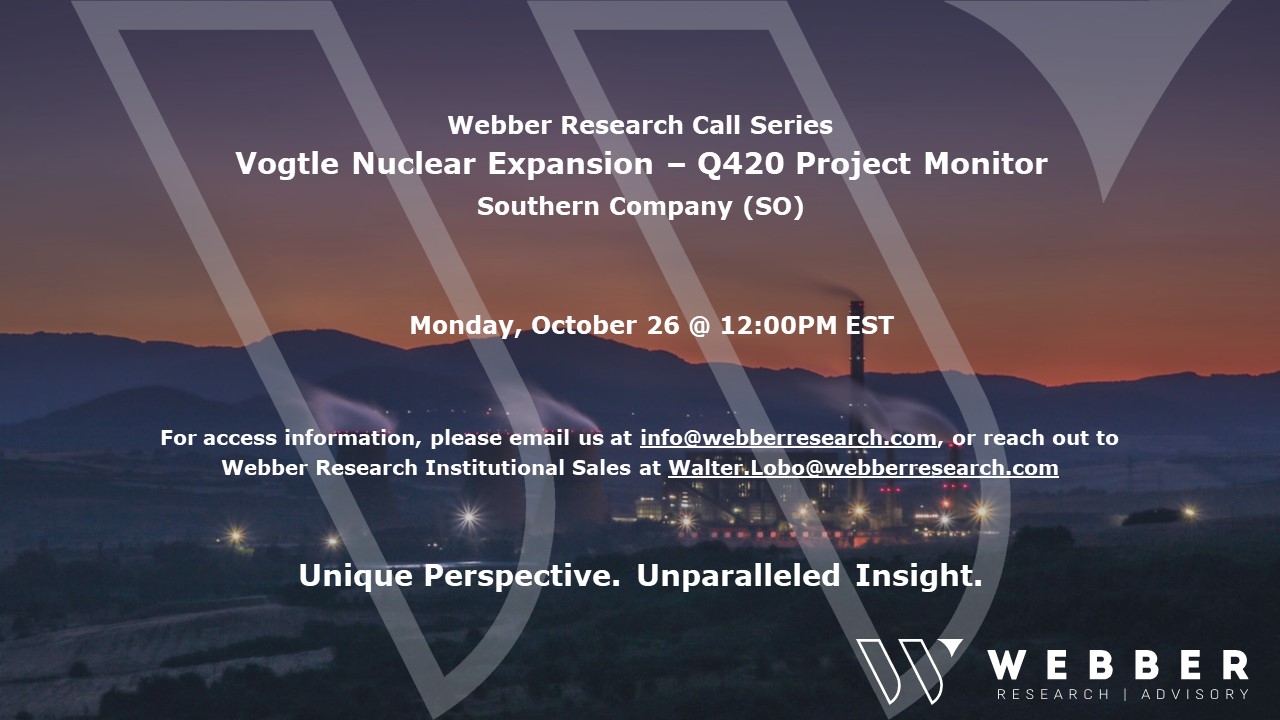
Webber Research Call Series – Monday, October 26th – Vogtle Nuclear Project Monitor – Key Decisions That Could Haunt Cost Prudency
Please join us for the latest Webber Research Client Call on Monday, 10/26 at 12PM, when we’ll discuss our latest deep dive into Southern Company’s Vogtle Nuclear expansion.
For access information, please contact us at [email protected], or our Institutional Sales Desk at [email protected]

W|EPC: Southern Company (SO) – Q420 Vogtle Project Monitor – Key Decisions That Could Haunt Cost PrudencyRead More
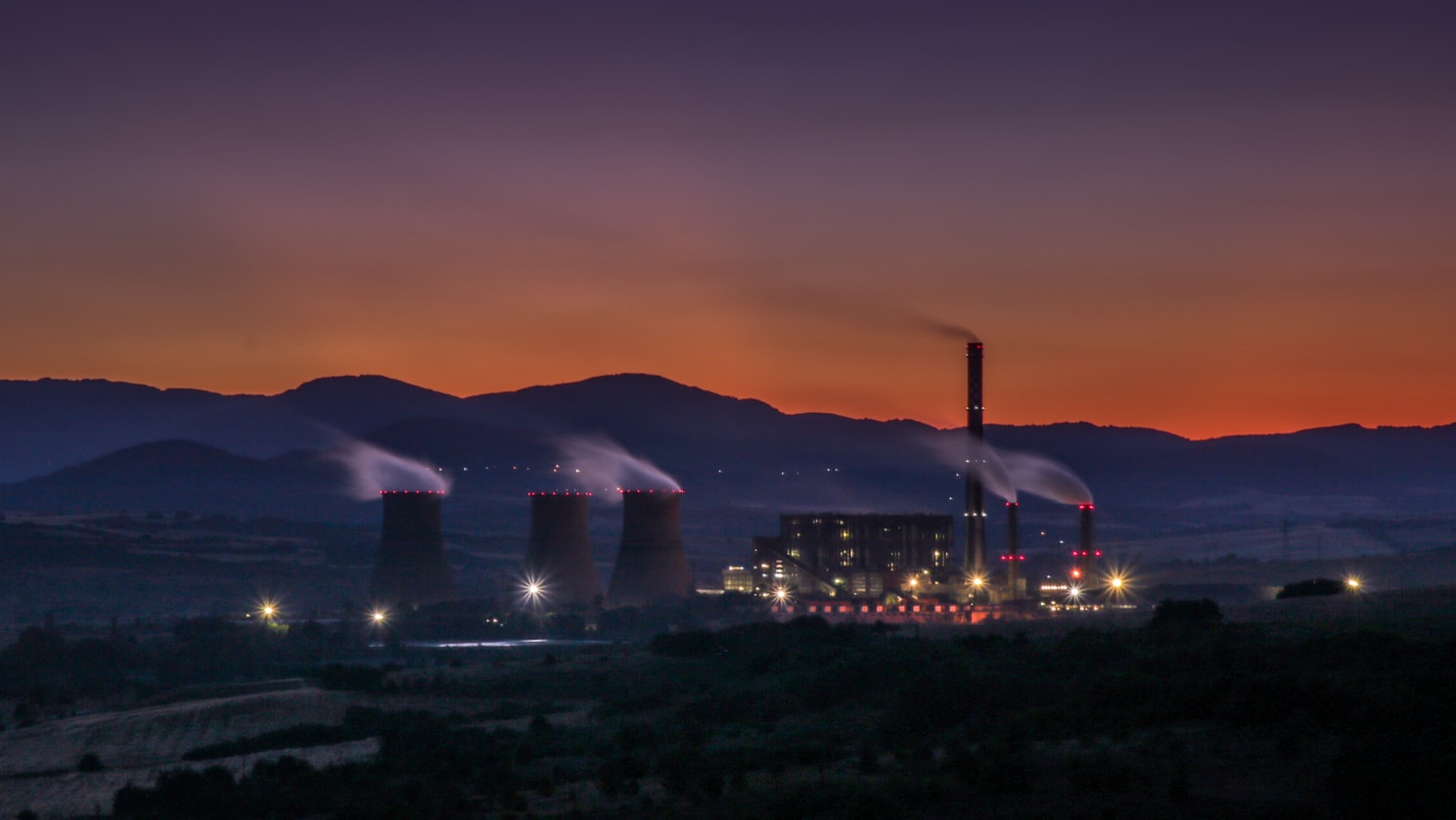
W|EPC: Southern Company (SO) – Q420 Vogtle Project Monitor – Key Decisions That Could Haunt Cost Prudency
Key Takeaways: Vogtle Q420 Monitor – Key Decisions That Could Haunt Cost Prudency
Who Will Be Getting Stuck With +$2.1B In Cost Overruns? Once Vogtle Unit 4 reaches “fuel load”, Georgia Power/Southern Company (GP/SO) can request a cost prudency determination to push their portion of cost overruns (~$2.1B) into recoverable utility rates. (Page 4)
Regulators will determine cost prudency based on project data, testimony, and a simple question: What should a reasonable manager have done at the time of the decision? (Page 5)
We expect that process to be heavily scrutinized considering the scale of the overruns, and, in our opinion, some questionable GP/SO decisions. (Pages 4-5)
Decisions That Could Haunt GP/SO’s Prudency. We believe there’s a case to be made that multiple GP/SO management decisions ran contrary to industry standards, potentially contributing to ($) billions in cost overruns, including
- A failure to either include or implement multiple EPC contract……(Page 7)
- For the first 4-years of the project, GP/SO used only…..(Page 23)
- In 2017, it appears GP/SO did not validate critical underlying EPC…..(Pages 9- 10)
Analyzing 12-Years Of GP & SO Testimony… (Pages 20 & 23)
Please join us for our next Client Call at 12pm EST on Monday 10/26, to review our Vogtle Project Monitor. Please reach out to us for access details.

Table Of Contents:
- Key Takeaways – Page 2
- Who Owns $2.1B In Cost Overruns? – Page 3
- Georgia Public Service Commission 2018 Order – Page 4
- Cost Prudency Definition & Process – Page 5
- Decisions That Could Haunt GP/SO
- LSTK Contract Mismanagement – Page 7
- Bankruptcy – Parent Company Guarantee Settlement – Page 8
- Estimate to Complete – Page 9
- Transition from EPC LSTK to T&M – Page 10
- QRA – Cost – Page 11
- QRA – Schedule – Page 12
- GP Testimony & W|EPC Analysis (2009 to 2017
- EPC Contract Overview – Page 14
- October 2009 – Page 15
- October 2010 – Page 16
- April 2011 – Page 17
- November 2012 – Page 18
- June 2013 – Page 19
- October 2014 – Page 20
- October 2015 – Page 21
- December 2015 – Settlement of LD’s – Page 22
- December 2015 – Revised EPC Contract – Page 23
- October 2016 – Page 25
- April 2017 – Page 26
For access information, please email us at [email protected], or our institutional sales at [email protected]
Read More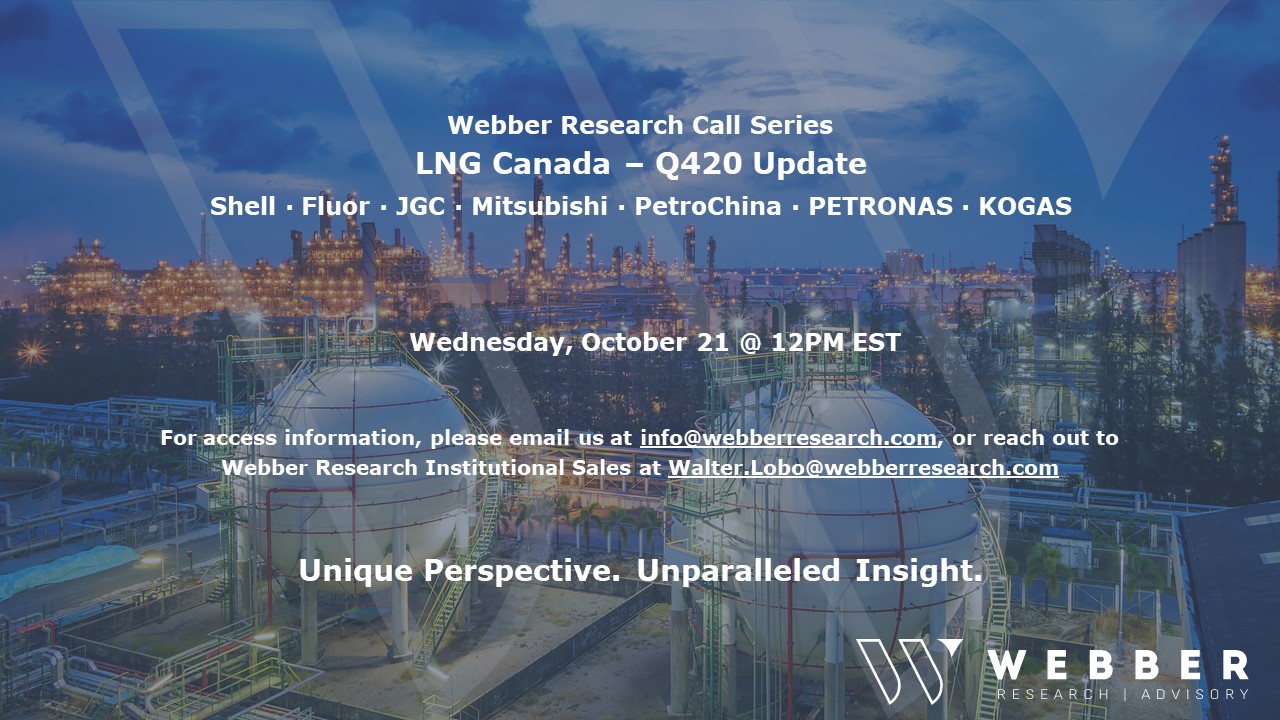
Webber Research: LNG Canada Q420 Update Call – Wednesday 10/21 at 12PM (EST)
Please join us for the latest Webber Research Client Call on Wednesday, 10/21 at 12PM, when we’ll discuss our latest thoughts on LNG Canada.
For access information, please contact us at [email protected], or our Institutional Sales Desk at [email protected]

W|EPC: LNG Canada – Updated Satellite Image Analysis & Construction Progress – Q420 Project MonitorRead More
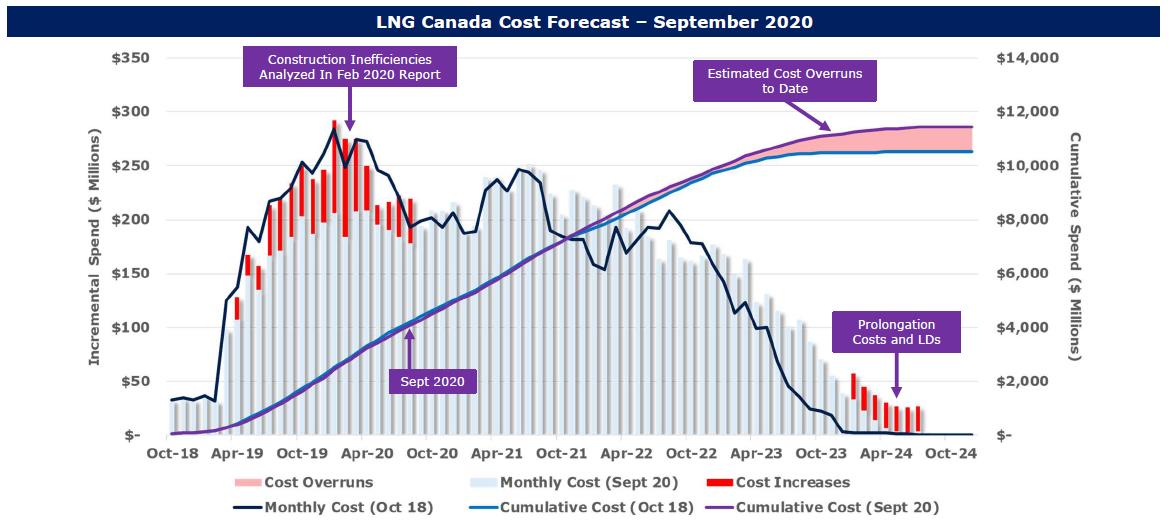
W|EPC: LNG Canada – Updated Satellite Image Analysis & Construction Progress – Q420 Project Monitor
Shell ∙ Fluor ∙ Mitsubishi ∙ PetroChina ∙ PETRONAS ∙ KOGAS
Table Of Contents:
- LNG Canada Q4 Monitor: Key Takeaways…………………………..….…Page 2
- LNG Canada Cost & Schedule Updates
- Updated Estimates…………………………..……………….….……..Page 4
- Project Milestones………………………………………………………Page 5
- Progress Analysis…………………………………………….….….….Page 6
- Analyzing Fluor’s 27.5% Reported Progress…….…………….……Page 7
- Project Staffing……………………………………………..……….….Page 8
- Satellite/Aerial Image Analysis
- July 2020 Overview………………….…………………….….………Page 10
- Sep 2020 Site Analysis……………………………………….………Page 11
- Jul vs. Sep 2020 – LNG Storage Tank…………………………..….Page 12
- Module Yard Analysis………………………………………………….Page 13
Key Takeaways:
- Delays At LNG Canada Continue to Build (Pages 4 – 7, 10 – 13)
- Fluor reported ~27.5% Engineering, Procurement, Fabrication, & Construction (EPFC) progress in September, vs our current estimate of…
- We believe Fluor’s 27.5% guidance implies module fabrication progress of ~45%, which is ~9x…
- Fluor also referenced COVID-related project delays (without getting specific)
- Our Current Delay Estimate:…..
- Estimated Probability Of Maintaining Schedule:…..
- Mind The Gap: There are several potential explanations for such a degree of progress variance…
- Examining Fluor’s Goal of 2,500 On-Site Workers By Dec-20 (Pages 4, 8, 10 – 13)
- Aerial images suggest meaningful concrete, structural steel, and significant construction activities have yet to start (beyond piling)…
- Pre-COVID, Fluor’s reported onsite labor was higher than the project’s publicly reported staffing levels, leading to cost overruns (Pages, 4, 8)
- Limited construction work fronts could constrain Flour’s ability to…
- Kicking The Can Down The Road… LNG Canada Starting to Resemble Another Fluor/JGC Project… (Pages 4, 8)
- In 3Q13, CPChem awarded Fluor & JGC a ~$6B EPC contract for an Ethylene Cracker in Texas. ~39-months later, Fluor/JGC announced the project would be over budget. The project was finished in mid-2018 (a year behind its baseline plan).
- ~23-months after FID, we believe the LNG Canada (JFJV) schedule is slipping and costs are…
W|EPC: LNG Canada – Updated Satellite Image Analysis & Construction Progress – Q420 Project Monitor
For access information, please email us at [email protected], or our institutional sales at [email protected]
Read More
Hydrogen (H2) – The Production Process Roadmap – Upstream, Midstream, & Downstream – Q420
Hydrogen ∙ Ammonia ∙ Methanol
Table Of Contents:
- Key Takeaways And Flow Of H2 & CO2………………………………………Page 2
- Hydrogen’s Upstream
- Electrolysis Technologies & Market Leaders…………………….…..…Page 6
- Blue Hydrogen CO2 Issue………………………………………….…….Page 7
- Hydrogen Is Getting Cheaper………………………………………….…Page 8
- Carbon Capture Systems & CO2’s Critical Role…………..………..…Page 9
- Hydrogen’s Midstream – Transportation
- Ammonia Transportation – Green Hydrogen………………..….…….Page 12
- Methanol Transportation – Blue & Green Hydrogen……………..….Page 14
- Cryogenic Hydrogen Energy Loss Concern…………………….……Page 16
- Closer Look – Ammonia vs Methanol
- Hydrogen Comparison…………………………………………………Page 18
- Example Product Comparison…………………………………………Page 19
- Converting Back To H2…………………………………………………Page 20
- Ammonia & Methanol Co-Production Facilities………..….………..Page 21
- Marine and Fuel Cell Comps
- Industry Impact – H2 Transportation…………………………………Page 23
- IMO Driving LNG, Ammonia Or Methanol Fuel For Ships….……..Page 24
- Carbon Neutral Marine Fuels – IMO 2050………………………….Page 25
- Ammonia & Methanol Co-Production Facilities…………………….Page 26
- Technology Leaders and Applications
- H2 – Industry Technology Leaders………………………………….Page 28
- Applying Technology In The EPC Process…………….………..…Page 29
- Technology Packaging & Trends…………………………….….….Page 30
Key Takeaways:
Upstream Sources Of Hydrogen – Blue & Green (Pages 4 – 9)
>95% of Hydrogen (H2) is produced using Steam Methane Reformer (SMR) technology that produces 7 units of CO2/unit of H2 (on average)
SMR w/ a carbon capture system (Blue H2) is the preferred option to environmentally manage excess CO2. (page 7)
Green H2 provides minimal CO2 but current technology limits Green H2’s cost competitiveness. (Page 6)
H2’s Sprint To Market Share… Current Leaders (Pages 17 – 21, 27 – 30)
We analyzed 13 Technology Companies spanning 12 Process industries, including ThyssenKrupp, Air Products, Air Liquide, & KBR/Johnson Matthey…the clear technology leaders include…
Frozen Industries – Marine, Automotive, & H2 Transport (Pages 22 – 26)
Outside factors (i.e. carbon neutral fuels, fuel cells, regulations, safety, & other downstream applications) will play a large role in selecting the midstream transportation choice for H2.
International Maritime Organization’s (IMO) mandates for reduced emissions has many ship builders looking at LNG, Ammonia, and/or Methanol; without a clear long-term winner (yet), many shipbuilders are frozen.
Fuel pumps (gas stations) must receive H2 from high-pressure storage vehicles, pipelines, or by converting Methanol or Ammonia to H2 at the fuel pump, with a number of implications.…(page 20)
Midstream For Hydrogen – H2 Transportation Options (Pages 10 – 16)
Ammonia, Methanol, and Cryogenic H2 are used to transport H2 long-distances.
Ammonia is the clear favorite to…
Methanol is the best option for…
Cryogenic H2 technology/costs…
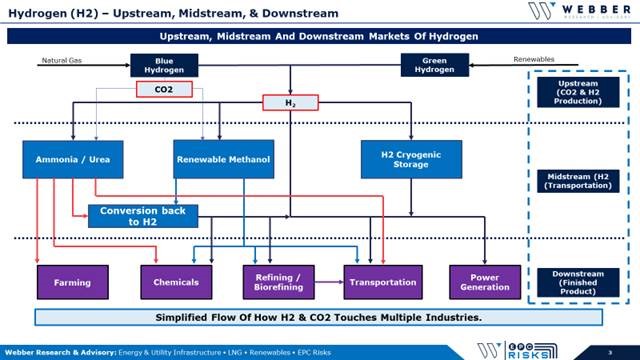
For access information, please email us at [email protected], or our institutional sales at [email protected]
Read More
LNG Canada construction delay creates cost uncertainty, clouds world supply
Read More
Webber Research: Technical & Commercial Project Consulting
Webber Research: Technical & Commercial Project Consulting Overview
We’re very pleased to share our most recent Webber Research Technical & Commercial Project Consulting Overview – detailing our expertise across a wide variety capabilities, services and experience. If you’re a project stakeholder, developer, creditor, or operator, we’re here to add value and minimize risk for your process.
Webber Research: Technical & Commercial Project Consulting Overview
Our Focus: LNG, Biofuels, Renewables, Petrochemicals, and broader Energy Infrastructure
Key Experience, Capabilities & Services:
• Proprietary Project Database: Includes schedules, satellite & drone images, & benchmarks
• Lenders/Stakeholder’s Independent Engineer: $50B+ of global project’s executed
• Commercial & Contracts Negotiations: Negotiated ~$30B in EPC proposals/contracts
• Government/Regulatory Liaison: FERC, U.S. Army Corps of Engineers, etc.
• Project Due Diligence: ~$1.5B investment that grew to ~$7B in ~8 years
• Validate Schedule/Progress Reporting: Helping independent stakeholders can avoid surprises
• Litigation Consulting/Claims: Supporting more than $1B in litigation, depositions, and expert witness
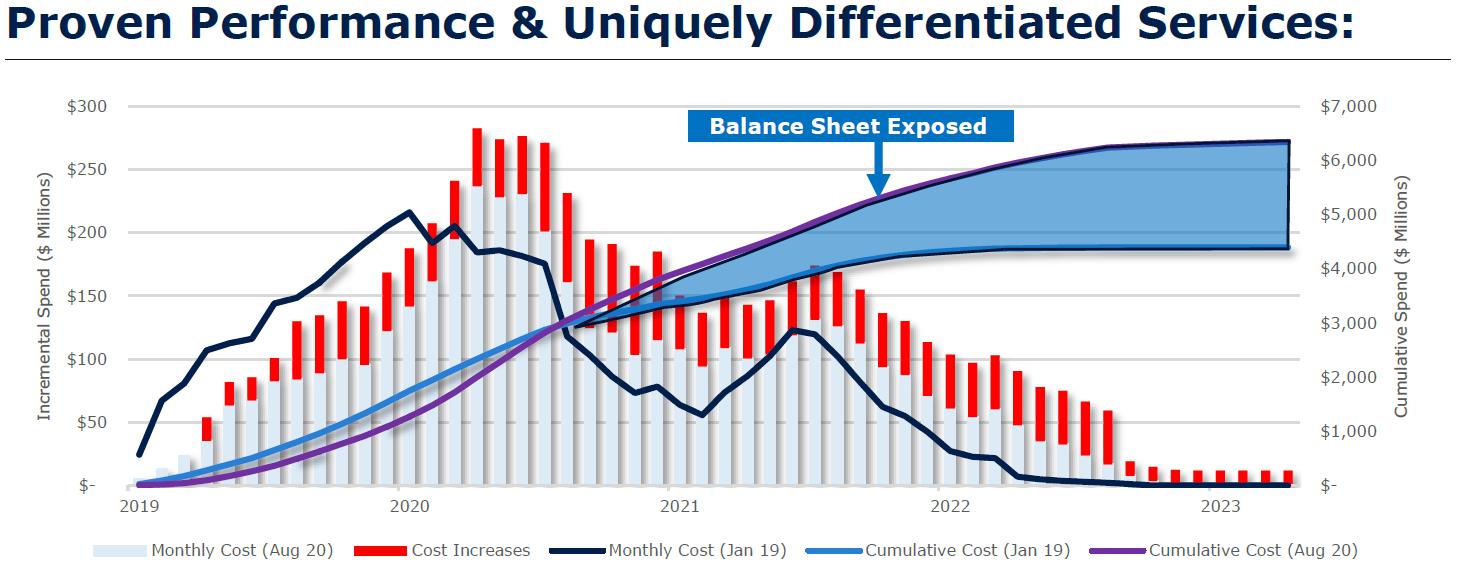
Unmatched Process. Industry Changing Results.
Read More
Webber Research: Renewable Biofuels – Refinery Conversions, Crack Spreads, & Risks Q420
Renewable Biofuels – Refinery Conversions, Crack Spreads, & Risks Q420
- Key Takeaways (page 2)
- Biofuels – Costs, Risks, & Incentives (page 3)
- Renewable Fuels vs. Traditional Refining Economics (page 4)
- Crack Spread Analysis – Ratios Matter (page 5)
- The California Renewable Fuel Rush (page 6
- Biofuels & Soybean Oil Supply/Demand (page 7
- Biofuels Project Tracker (page 8)
- Hydrogen’s Increased Demand in Biorefining (page 9)
- HVO vs FAME Biofuel (page 10)
- PSX’s Rodeo Refinery Conversion (page 11)
- Rodeo Refinery Conversion Overview (page 12)
- PSX Project Comp – WA vs. CA (page 13)
- EPC Dynamics (page 14)
- EPC Contractor Rankings (page 15)
Key Takeaways:
- Renewable Fuel Production… Just in Time or Too Late? (Pages 4 – 8)
- California & Oregon have mandated Carbon Intensity (CI) reductions in transportation fuels, which could increase demand by ~350%, from ~400MM gallons/year to 1,400MM by 2025. Ten other states are evaluating similar LCFS programs, which could potentially push U.S. demand toward 2,400MM gallons/year, up ~600%…
- Refinery Conversions: FAME vs. HVO (Page 10)
- Emerging trend in Biofuels: a transition from Fatty Acid Methyl Ester (FAME) to Hydrotreated Vegetable Oil (HVO), which provides biofuels a longer storage life & can be used in colder climates.
- FAME & HVO biofuels are produced using a refinery’s hydrotreater & isomerization, or a hydrocracking unit with a steady supply of hydrogen. HVO economics are dependent on hydrogen prices & feedstock ratios.
- Hydrogen’s Increased Demand in Biorefining (Page 10)
- As of early 2020, traditional oil refining consumed ~1/3 of the global Hydrogen demand.
- FAME biorefining requires similar Hydrogen consumption relative to traditional refining, but HVO biorefining uses significantly more Hydrogen depending on the process units…
- Speed To Market Matters: Owners, Operators, & Contractors (Pages 12, 13, 15)
- ~10 years ago, companies were chasing another speed to market trend, NGL production and fractionation. Flexible and decisive companies (e.g. EPD, ET, etc.) quickly capitalized on this opportunity and captured market share.
- Large Energy companies (e.g. Exxon, Shell, etc.) are not typically structured to move quickly refining industry (VLO, PSX, MPC) and take on the speed to market risk..
W|EPC: Renewable Biofuel Analysis Refinery Conversions, Crack Spreads, & Risks Q420
For access information, please email us at [email protected] or visit our website at webberresearch.com
Read More
W|EPC: Renewable Methanol & Hydrogen – Analyzing Methanex’s (MEOH) Geismar Facilities
Renewable Methanol & Hydrogen – Analyzing Methanex’s (MEOH) Geismar Facilities – September 2020
- Methanex & Renewable Methanol – Key Takeaways (page 2)
- Renewable Methanol (page 3)
- Methanol Feedstock & Applications (page 4)
- Hydrogen is Getting Cheaper (page 5)
- Renewable Methanol Facilities (page 6)
- Geismar Methanol Facilities (page 7)
- Methanex Overview (page 8)
- History – Geismar Units 1 & 2 (page 9)
- Geismar Unit 3 Comps (page 10)
- GU3 Cost Overview (page 11)
- Schedule – Key Milestones & Impact (page 12)
- Monthly Progress Curves (page 13)
- EPC Dynamics – So Long KBR, Next Up?(page 14)
- Disclosures (page 15)
Lower-Cost Hydrogen Will Produce Cost Competitive Renewable Methanol: Pipe Dream or Reality? Global methanol demand sits near ~75 MTPA; with demand expected to ramp amid new EU and U.S. environmental mandates. Renewable Methanol (RM) is produced using Hydrogen (H2) from solar/wind and carbon dioxide (CO2) as compared to traditional methanol produced from fossil fuels (i.e. coal & natural gas). (Page 4)
Cost-competitive RM would open the door to green plastics and support various marine, fuel, & vehicle clean energy mandates but, costs are not competitive based on current technology. (Pages 4 – 5) Limited project economics hasn’t stopped ~10 commercial scale renewable methanol facilities in various stages of development around the world. As these projects develop, lower costs and improved technology would be a game changer for the methanol industry while providing H2 more downstream applications. (Page 6)
Tracking the 800 lbs. Methanol Gorilla…Methanex (MEOH). (Pages 8 – 9)
Geismar Unit 3 – Positioning vs. Competition. (Pages 10 – 13)
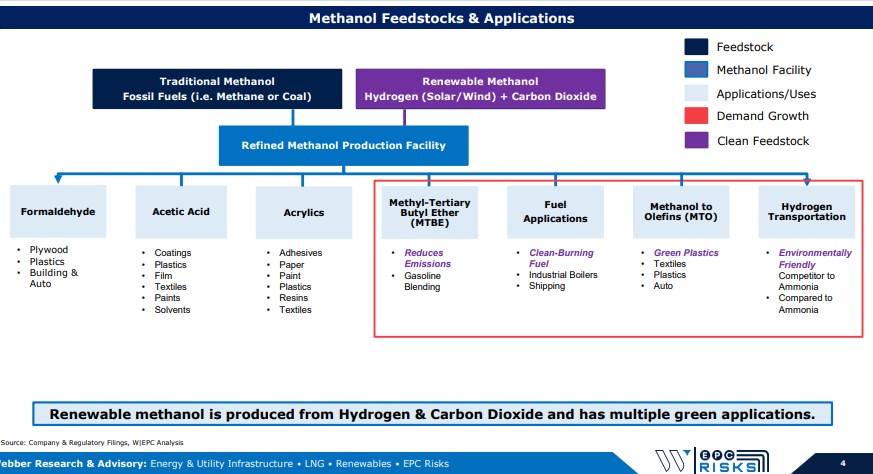
For access information, please email us at [email protected] or visit us at webberresearch.com
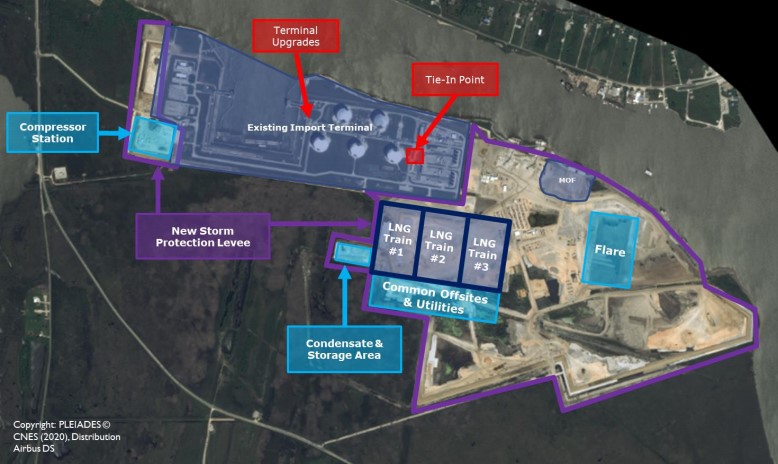
W|EPC: Golden Pass LNG (XOM, QP) – Project Update & On-Site Satellite Image Analysis – Q320
Golden Pass LNG: Our Delay & Contingency Fund Estimates Continue to Ramp
Key Takeaways:
• Chiyoda’s Engineering Delays Continue. We believe engineering delays have eroded a significant portion of the EPC risk, contingency, and profit, with the likelihood of ramping balance sheet exposure. (Pages 4 & 11)
• Our updated project timeline (delay) and contingency fund estimates are now material, sitting at….(continued)
• Our estimates point to Golden Pass project progress sitting closer to ~10% vs Chyioda’s report figure of 16% (Q2) based on both our satellite image review and….(continued)
• Sabine Pass Comparison. 18-Months after FID Sabine Pass LNG Trains 1 & 2 were 57.1% complete, vs our estimated range for Golden Pass LNG (~10-16%). (Page 8)
Table Of Contents
- Golden Pass Q320 Update – Key Takeaways (page 2)
- Revised Cost & Schedule Forecasts (page 3)
- Cost Forecast (page 4)
- Project Milestones (page 5)
- Progress Analysis (page 6)
- Analysis – Chiyoda’s 16% Reported Progress (page 7)
- Putting It All Together – W|EPC Updated Contingency fund and project delay estimates
- 18-Months After FID, Sabine Pass vs. Golden Pass LNG (page 8)
- Joint Venture Analysis (page 9)
- Change Order Analysis vs. JV Structure (page 10)
- Possible Impacts to Chiyoda (page 11)
- Satellite Image Analysis (page 12)
- Disclosures (page 17)
Golden Pass LNG Satellite Image Overview (page 13)
For access information please email us at [email protected]
W|EPC: Golden Pass LNG – Delay & Contingency Fund Estimates Continue To Ramp – Updated Project & Satellite Image ReviewRead More

W|EPC: Assessing Force Majeure Impact on Calcasieu (Venture Global), Golden Pass (Exxon, QP) & Sabine (Cheniere)
Webber Research – Energy EPC
Marco & Laura Impact Could Last 7 to 14 Days…Depending on Damage & Craft Labor Retention
EPC contractors receive schedule relief for Force Majeure (FM) events (i.e. named storms such as Marco & Laura) in industry standard EPC contracts, which typically provides EPC contractors schedule relief but not cost relief.
EPC contractor FM claims on Calcasieu Pass, Golden Pass, and Sabine Pass LNG likely started yesterday August 24th, 2020 (due to mandatory evacuations & closures).
Something to watch…construction workers tend to scatter and chase higher paying (wages & per-diem) jobs post hurricanes/natural disasters, which creates headaches for on-going/planned projects and complicates FM claims.
Based on current Marco & Laura forecasts and expected rain/storm surge, we are forecasting a 7 to 14-day construction schedule delay on Calcasieu Pass LNG (CPLNG), Golden Pass LNG, & Sabine Pass LNG Train #6 (SPLNG6).
Impact & Timeline Implications
Often, impacts due to hurricanes occur well beyond the actual storm itself due to lost productivity and challenges restarting/staffing the project.
Flooding – enough drainage pumps installed and site drainage working sufficient to mitigate additional rain fall.
Storm Surge – levees/walls high enough to protect rising levels and all equipment moved to the highest elevation on the site (if practical).
Wind – cranes must be placed horizontally and structures secured to reduce/prevent damage.
Temporary Construction Facilities – if levees and/or drainage are not in place at temporary construction facilities, equipment and material stored in laydown yards/facilities could be damaged by water and cause unplanned long-term issues.
EPC contractors have a reputation for trying to use FM impacts to absorb existing self-inflicted schedule delays. Based on the current/expected forecast, we believe the following FM timeline is realistic.
Prep time for storms – 1 to 3 days
Marco & Laura storm duration – 2 to 4 days
Restart & productivity losses – 4 to 7 days
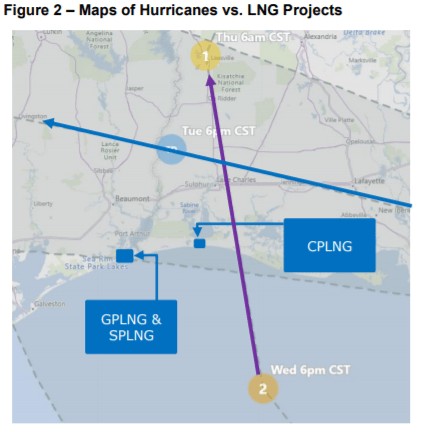
Our specific estimates and thoughts on individual projects in the pages that follow:
For subscription information, email us at [email protected]. For more information on this note, please visit our online store at webberresearch.com/downloads
Read More
W|EPC: Gorgon LNG – Operational Breakdown Could Have Contributed To Kettle Cracks – Mid-October A More Likely Restart Timeline
W|EPC: Gorgon LNG – Operational Breakdown Could Have Contributed To Kettle Cracks
Mid-October May Be A More Likely Restart Timeline
Key Takeaways:
Pump The Brakes: While potential fabrication errors have been the primary narrative around the Propane Kettle cracks that shut down Gorgon LNG, it’s feasible that operational issues (and one in particular) may have contributed or even partially caused the cracks on Train-2’s kettles, which could have significant and more complex implications.
- The propane kettle cracks were noticed ~3-years after the kettles were placed in-service (likely beyond any warranty period), potentially shifting costs to Chevron.
- According to our in-house engineers, a breakdown in the propane vapor transfer step could subject the propane kettles to temperatures significantly below the minimum design metal temperature; creating stress on the metal and an optimum environment to cause cracks.
- If the root cause involved an operational issue, it would require not just replacement or repairs, but more robust inspections, testing, and training, which would add to the out-of-service timeline (below).
- If a breakdown in the propane vapor transfer step did contribute to the cracks, it would have likely needed to be repeated routinely to cause the visible cracks on Train-2, increasing the likelihood that such an error would have been repeated on Trains 1 and 3 as well, given the likelihood of crew rotation.
Timeline Implications
According to recent press reports, Chevron has suggested an early September restart for Train 2 and provided train 1 & 3 inspection time-frames.
- Train 2 – Currently Down since July, Online Sep 20
- Train 1 – Shutdown Early Oct 20, Online Nov 20 to Jan 21
- Train 3 – Shutdown Jan 21, Online Mar 21 to Apr 21
- We think mid-October for Train 2 may be more realistic. While the repairs themselves may fit within a mid-September target, we believe a thorough assessment of the route problems, inspections, training, etc., likely push out the downtime. We don’t know yet what approvals and 3rd party reviews will be necessary to confirm the repairs were made in a satisfactory way, but this could impact the timelines given as well. Continued…
For access information please email us at [email protected]
Read More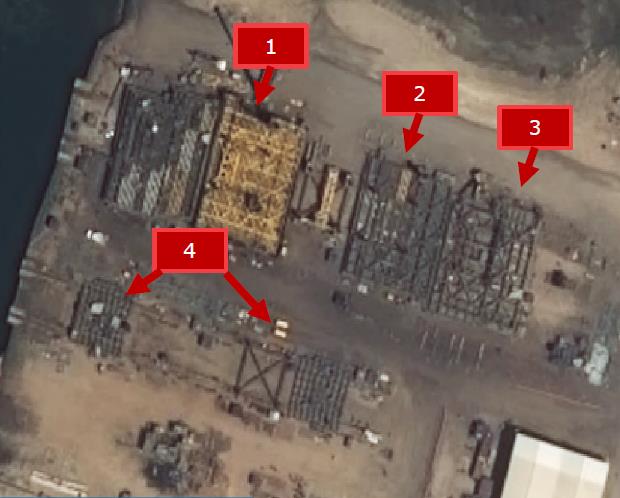
W|EPC: Venture Global LNG – August 2020 Update
W|EPC: Venture Global & Calcasieu Pass LNG – Satellite Image Review (ICA & Fluor) & More Engineering Changes.
Key Points:
- Calcasieu Pass Revises Key Engineering Documents (Again). Over the past two weeks Calcasieu Pass (CPLNG) submitted engineering updates to FERC, most of which are marked as confidential. While the substance of the updates and revisions are unknown, the types of documents that were filed indicate possible changes to structural steel design & calculations, equipment flow rates, and the project’s mechanical equipment list. (Page 4)
-
Q2 Progress: Pre-Treatment Unit Module Fabrication – ICA Fluor & the Tampico, Mexico fabrication yard. As previously noted, we believe ICA Fluor is fabricating the CPLNG Pre-Treatment Unit (PTU) Modules in their Tampico, Mexico fab yard. Satellite images show
-
Pre-FID Feedstock Specs Or Assumptions May Have Changed…
Calcasieu Pass LNG August Update – Key Takeaways.- Page 2
More Engineering Adjustments – Page 4
Changes To Feedstock Assumptions?- Page 4
Satellite Image Analysis – ICA Fluor (Tampico, Mexico) – Page 5
Pre-Treatment Unit Module Overview – Page 6
March vs. July 2020 – ICA Fluor Satellite Image Comparison – Page 7
Closer Look – March 2020 – Page 8
Closer Look – July 2020 – Page 9
Disclosures – Page 10
Previous ICA Fluor Satellite Image
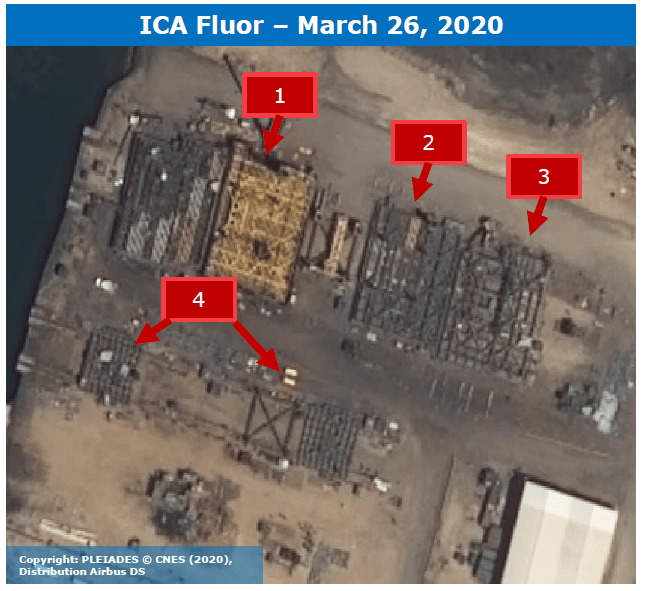
W|EPC: Venture Global LNG: August 2020 Update
For access information, email us at [email protected], or visit our online store at webberresearch.com/downloads
Take a look at this: Sex Drive Boosters for Men: Energy, Enthusiasm, and Expertise
Read More
W|EPC: LNG Canada Q320 Monitor – Labor Dynamics & Baseline Satellite Image Review
LNG Canada Q320 Monitor – Labor Dynamics & Baseline Satellite Image Review
Shell • Petrochina • Mitsubishi • Kogas • Petronas
1) Union Craft Avg. Wage Rate Escalators & Impact On JGC/Fluor, and broader project cost…
What’s Happened/Changed: Part of our current focus is on LNG Canada’s wage rate escalation and union labor agreements post-2023.
Why Does That Matter: EPC lump sum proposals generally include labor escalation between 1-3% per annum (rates vary based on geography/availability). Labor agreements supporting LNG Canada and other B.C. projects expire in 2023 and have a relatively advantageous average labor escalation rate of…..continued.
For context, union labor strikes, renegotiated agreements, and significant wage rate escalation supported Gorgon LNG coming in $20B+ over budget.
What’s The Impact:…..continued (Page 3)
2) Taking A Look At JFJV’s Longer-Term Labor Inflation Risk (Page 5)
3) JFJV’s Construction Activity – What does it tell us about the project timeline? (Page 8)
4) Satellite Image Analysis Baseline – Benchmarks for Remainder of the Project…. (Pages 9-17)
W|EPC: LNG Canada Q320 Monitor – Labor Dynamics & Baseline Satellite Image Review
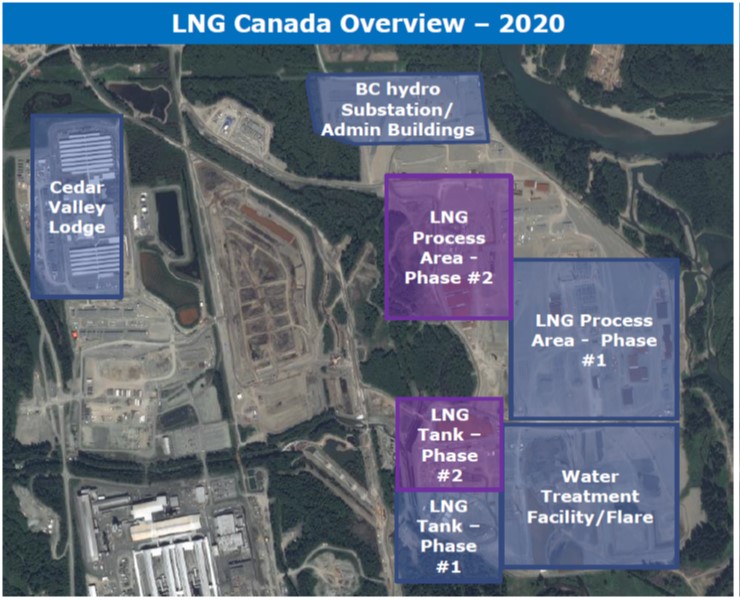
For access information please email us at [email protected]
Read More
W|EPC: Gorgon LNG’s Propane Kettle Cracks – Early Read
Overview:
On July 23, 2020, Reuters reported Australia’s Department of Mines, Industry Regulation & Safety (DMIRS) said “it plans to inspect Chevron’s Gorgon LNG plant as soon as possible following calls by a trade union to shut the plant.”
1. During routine maintenance, Chevron Australia discovered issues with the propane kettles on Train #2.
2. “The Australian Manufacturing Workers’ Union (AMWU) has called for Chevron to shut down the Gorgon plant for immediate safety inspections by a gov. regulator and for a report to be made public.”
3. Specifically, cracks up to 1 meter long and 30 millimeters deep were discovered by the non-destructive testing team (per AMWU). On July 28, 2020, a Chevron company spokesman said, “Chevron expected to restart Train #2 of its Gorgon LNG plant in early September after completing repairs.” Chevron said during routine maintenance that began on May 23rd and was scheduled to be completed by July 11, 2020, weld quality issues were discovered on 8 propane heat exchangers. Gorgon LNG Trains 1 & 3 are producing. On 07/29/20, inspectors from DMIRS were due on site to inspect the cracks after AMWUraised issues about the conditions of the South Korean-made kettles.
Key Takeaways:
• Inspectors from Western Australia’s “safety watchdog” were scheduled to inspect propane kettle cracks on Chevron’s Gorgon LNG Train-2 on 7/29
• Labor unions continue pushing back, requesting a full shut down of all three LNG trains for inspection.
• Publicly available technical details are limited, even for the folks who built Gorgon LNG (who we spoke with); however, we believe the 3-month estimated down time for repairs is….continued
• Primary rationale for a Train-1 and Train-3 inspection shut down would be…continued
W|EPC Thoughts & Observations
The publicly available technical details are limited, even for our contacts involved in building Gorgon LNG. However, we are watching the following:…continued
Concluding Thoughts…
Key Questions…
For access information please email us at [email protected]
Read More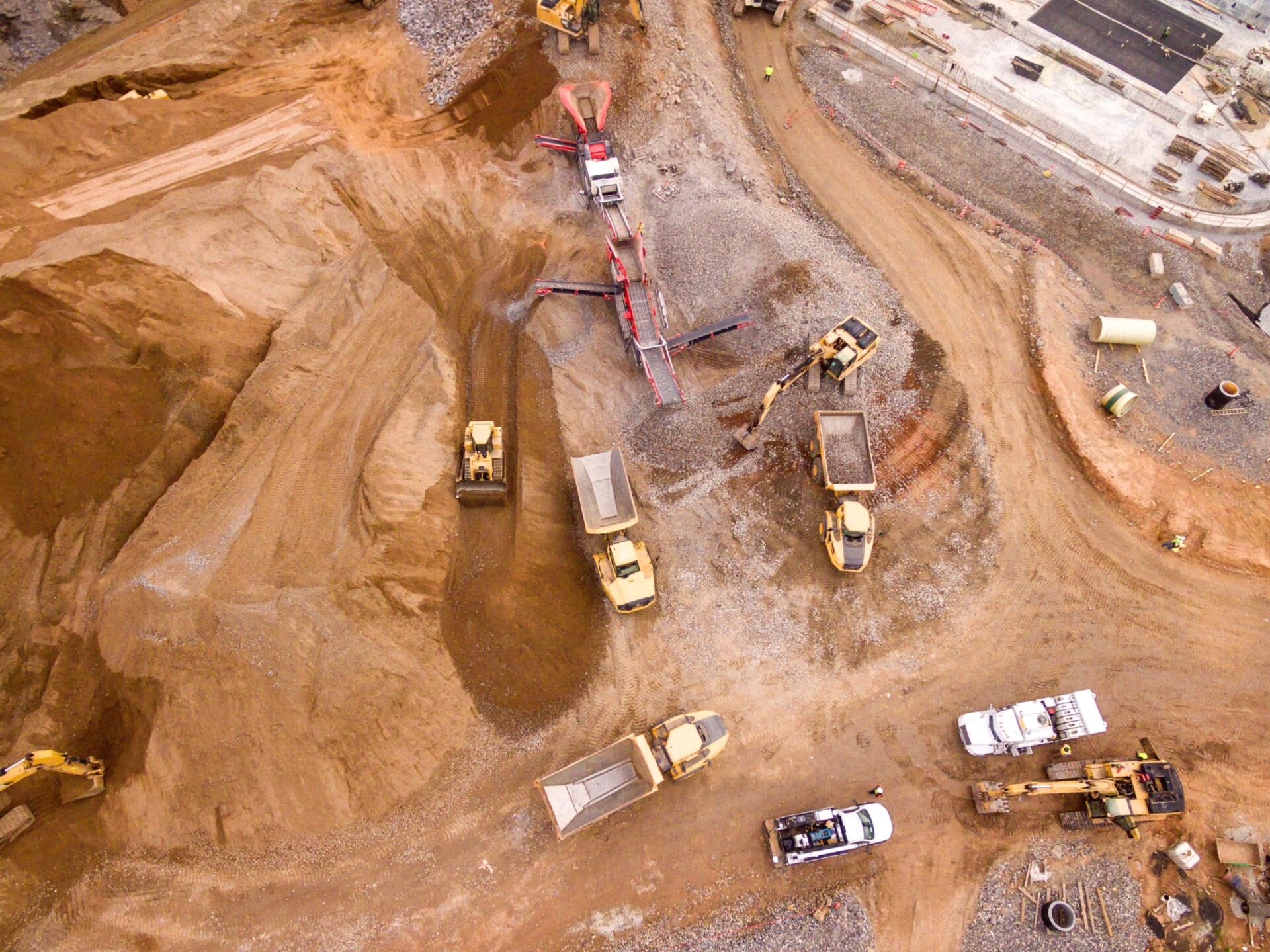
W|EPC: Venture Global & The Approach Nexus – Drone & Satellite Image Analysis, Engineering Changes Q320
W|EPC: Venture Global – Nexus Approaching Drone &Satellite Image Analysis, Engineering Changes Q320
For access information, visit our New Online Store, or email us at [email protected]
• Calcasieu Pass Update – Key Takeaways (slide 2)
• Calcasieu Pass LNG Module Overview (slide 3)
• Importance Of Notification Window (slide 4)
• Engineering Changes: Pre-Treatment Modules (slide 5)
• Engineering Changes: Liquefaction Modules (slide 7)
• Technical Analysis: Changes & Impact? (slide 9)
• Satellite Image Analysis – Baker Hughes Module Yard (slide 13)
• Drone Image Analysis – Site Prep Update (slide 18)
• Remaining Questions (slide 23)
• Scenario Analysis & Predictions – Rubber Starting To Meet The Road? (slide 25)
• Disclosures (slide 27)
Key Highlights:
• Venture Global: The Looming EPC Nexus…
• Drone Image Analysis:
• Calcasieu Pass Outlook
• Consequential Damages, Predictions & Conclusions
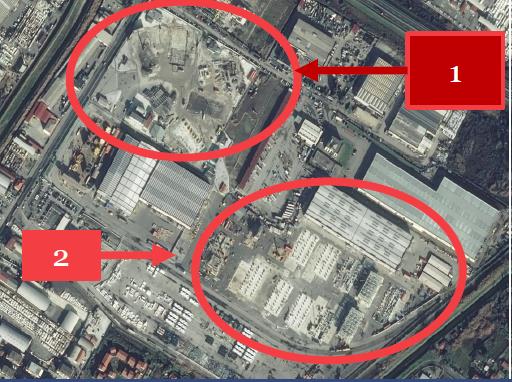
Copyright: PLEIADES © CNES (2020), Distribution Airbus DS & W|EPC Analysis
For access information, email us at [email protected]
Check this: Sex Drive Boosters for Men: Energy, Enthusiasm, and Expertise
Read More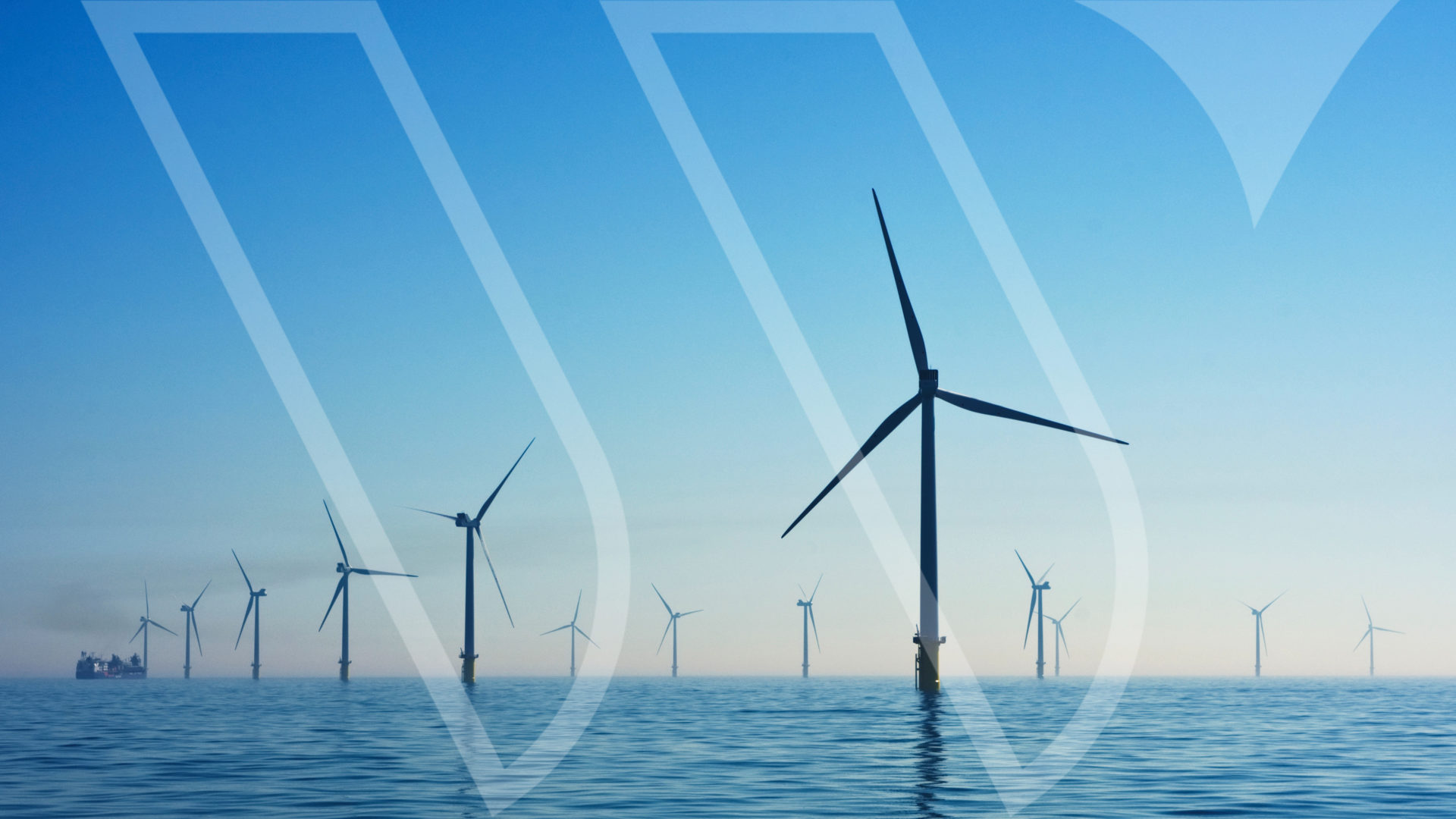
W|EPC: Dominion Energy (D) – Offshore Wind Project Monitor Q320
W|EPC: Dominion Energy (D) – Q320 Offshore Wind Project Monitor
- Dominion Energy (D) Q320 Capital Project Monitor: Key Takeaways (slide 2)
- Virginia Clean Energy Act – Why Should You Care? (slide 3)
- Energy Costs vs. Benefits (slide 4)
- Coastal Virginia Offshore Wind (CVOW) Project Overview (slide 5)
- Phase #1: A Closer Look At The Pilot Project (slide 7)
- Regulatory Approval Timeline
- EPC Contractor – Ørsted
- Cost & Schedule Analysis
- Phase #2: The $8B Main Course (slide 13)
- Overview & Status
- How big Are 12MW Offshore Turbines?
- Offshore Wind: Construction, Risk, & Insurances Overview (slide 16)
- Conclusions: Thank A Rate Payer (slide 20)
Key Highlights:
• Offshore Wind… An Awesome Opportunity for Dominion, Right?
• Phase #1 Demonstrator Costs Ballooned By ~73%…
• Phase #2 (2.6GW) Is The Real Prize – But Definitely Worth Keeping An Eye On Costs…
For access information please email us at [email protected]
Read More client log-in
client log-in
